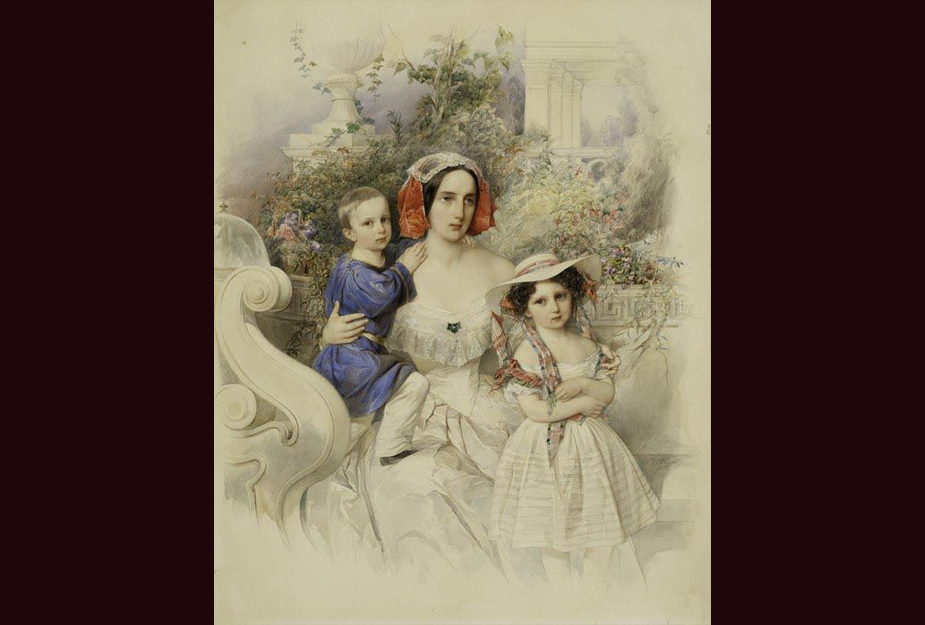
A Story of France
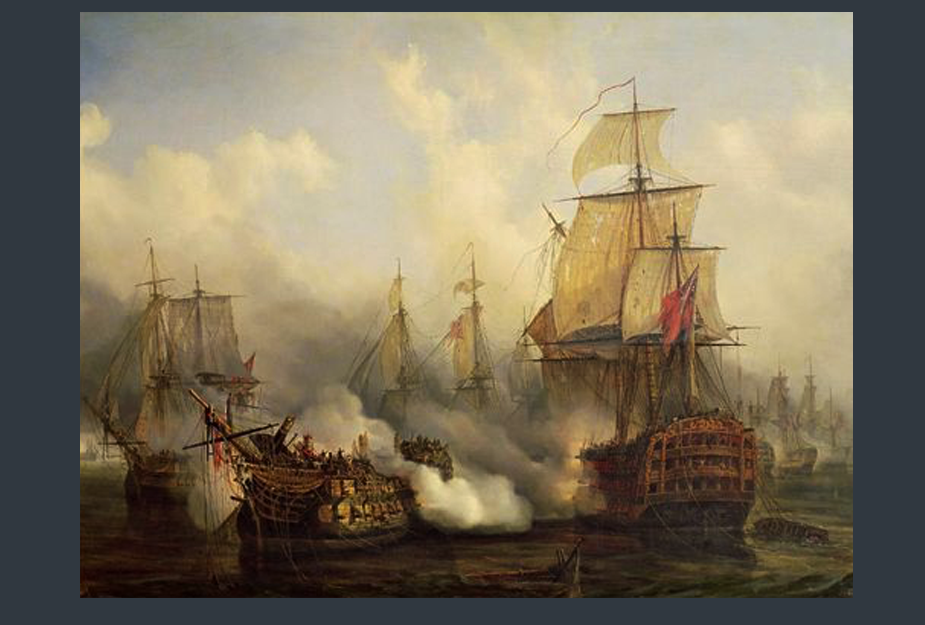
REGENCY is the era… …of Jane Austin’s “Pride & Prejudice”, and most likely will be depicted by storytellers and literary re-enactors, as it was not as well embraced in the US as it was in Europe due to practicality (they got cold!). Out of this era came many great “little red riding hood” cloaks and jackets for that reason.
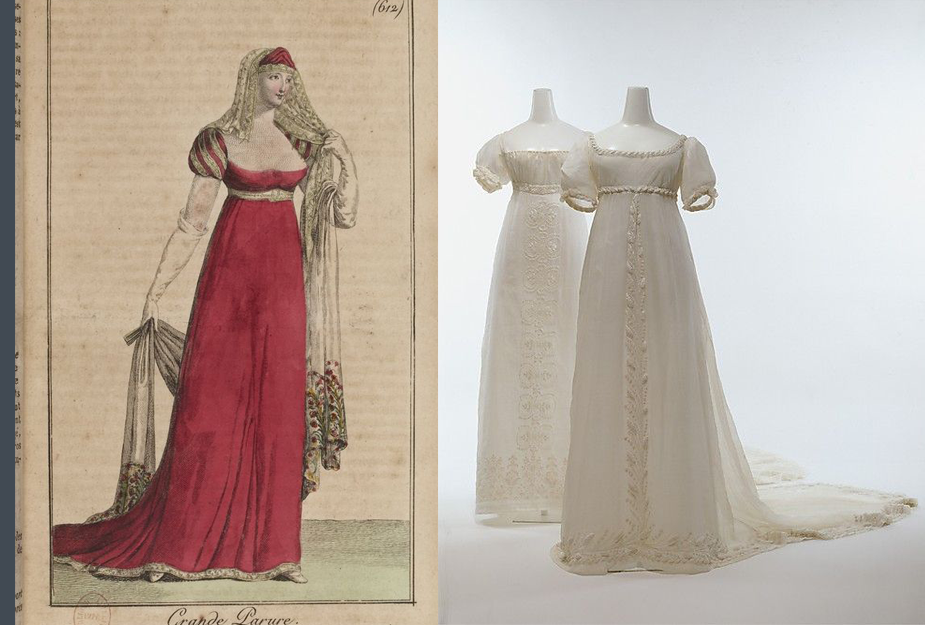
1800 to 1827 was a “crossover”… …between “Georgian” and “Regency” fashion eras because King George III was technically still ruling, although he was in an insane asylum while his son, also named George, was ruling as a Regent. Historical fashion took cues from political and geographical sources.


From 1790 to 1810… …while waists were high in women’s fashion, and fabrics flimsy and light, women wore a “Spencer” outdoors, or a “Canezou” indoors as you would a sweatshirt or cardigan today. One can especially appreciate this as heat was provided by fireplaces, and light by candle.
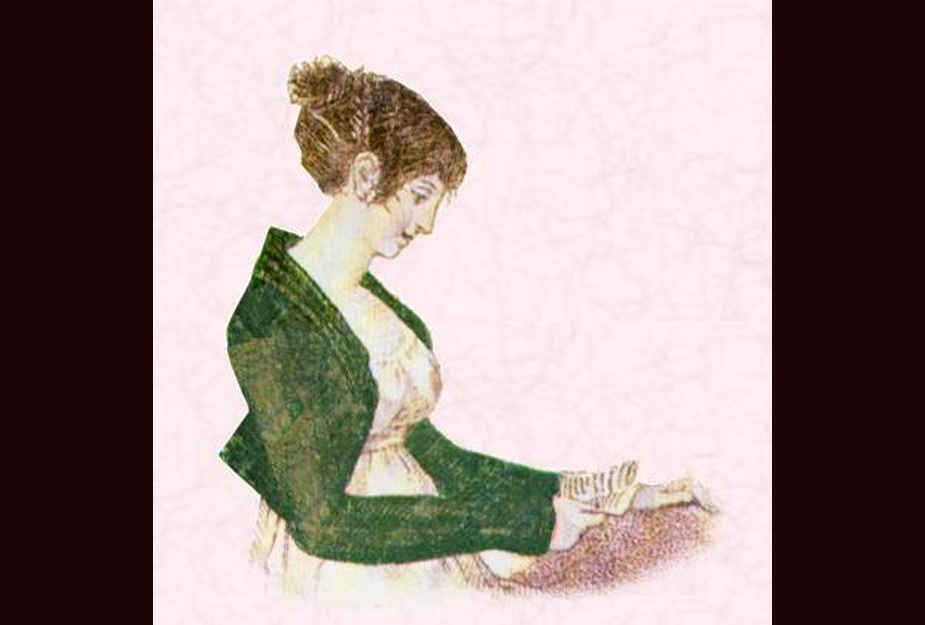
We’re starting History with 1800 because… …it’s close to midpoint for the costumes we make (1740-1900), and because it was kind of a “resting time” for women wearing complex & structured undergarments – compared to 8 decades before or after. Would love to have the next consignment from this era!
(photo: 1800 to 1870’s.. you can see women’s fashion starts simply and gets simply crazy!)
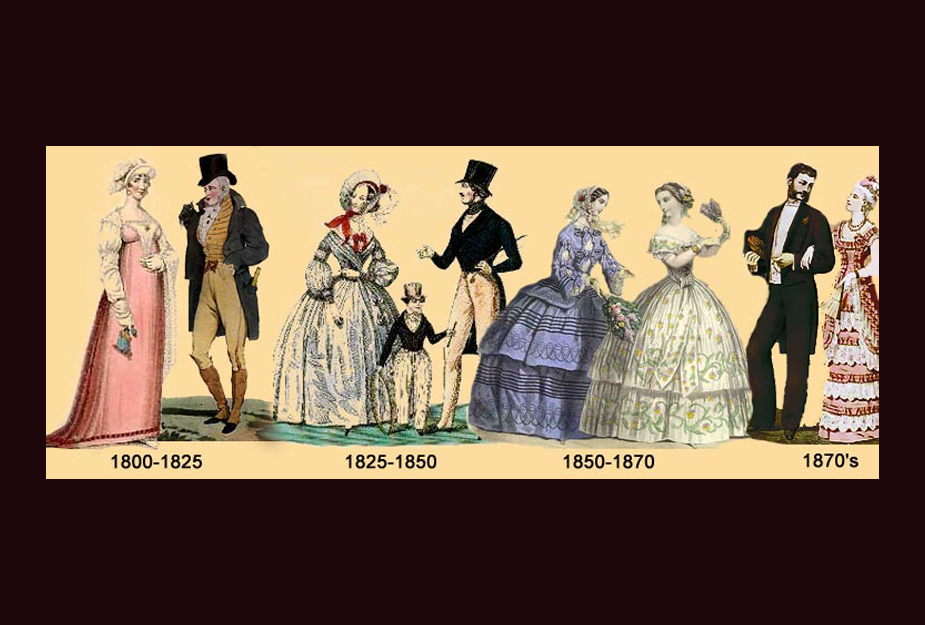
Fashion followed politics… … (who was in control & setting trends), function (why could men ride a horse comfortably?), ideologue (Marie Antoinette HAD it with tight dresses so made up some loose ones), & technologyl leads.
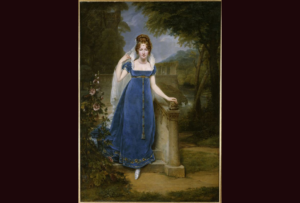
In 1800, all these were big influences, beginning with an industrial revolution in Europe due to improved fabric making & energy resources.
(photo: Newcomen’s steam engine invented in 1711, improved for use in fabric production by 1781).
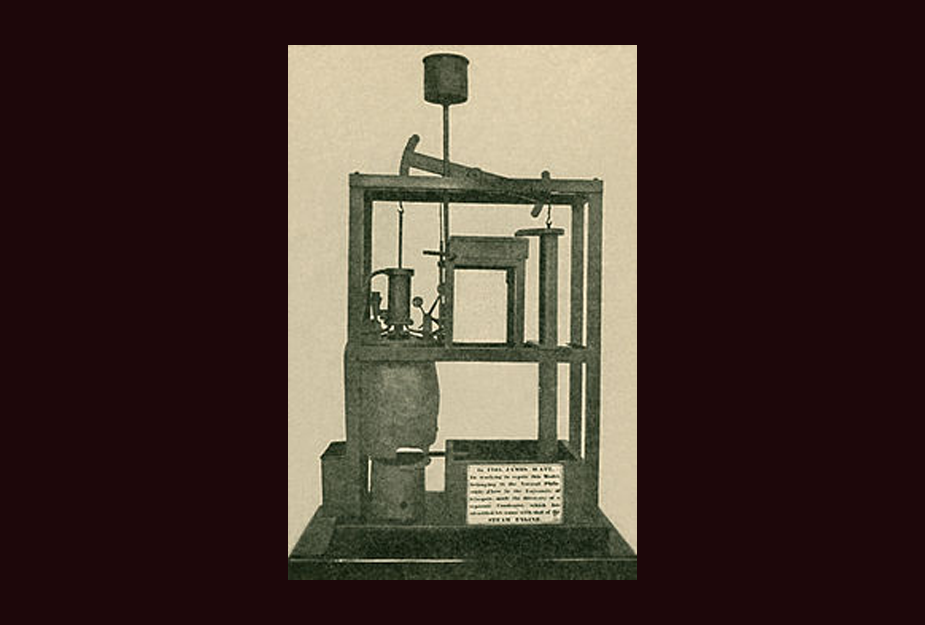
Many new patents… … like this for the cotton gin, relating to textile and materials industries led to availability in fabrics in particular.
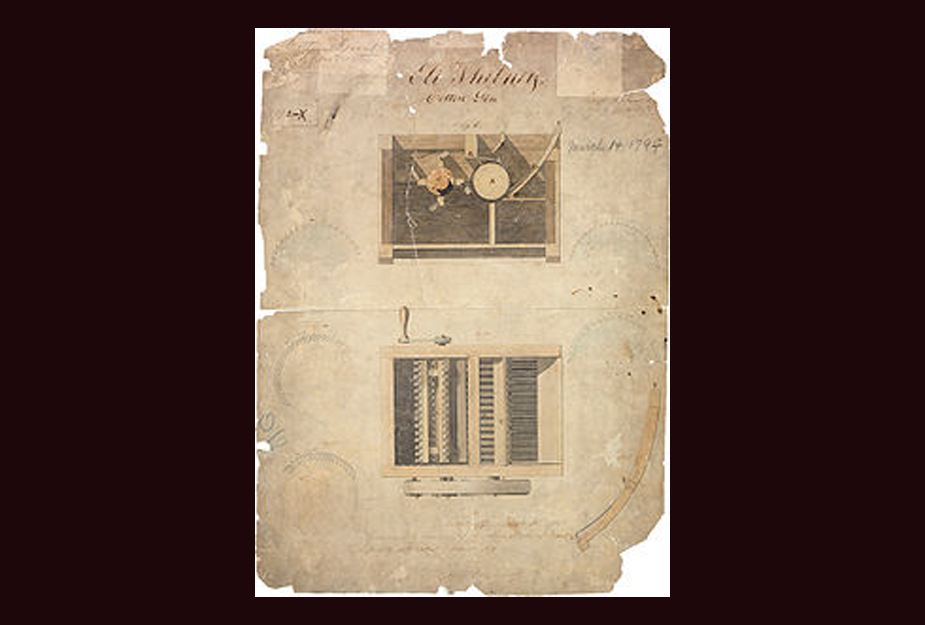
Here’s the Early REGENCY SILHOUETTE… …(“Georgian, Colonial”) we are discussing. It had a very high (“under the bust”) waistline, with narrow, lightweight, flowing skirt. Sleeves were little “puffs” or past the elbow, & there were intricate & unique embroideries & accessories used.
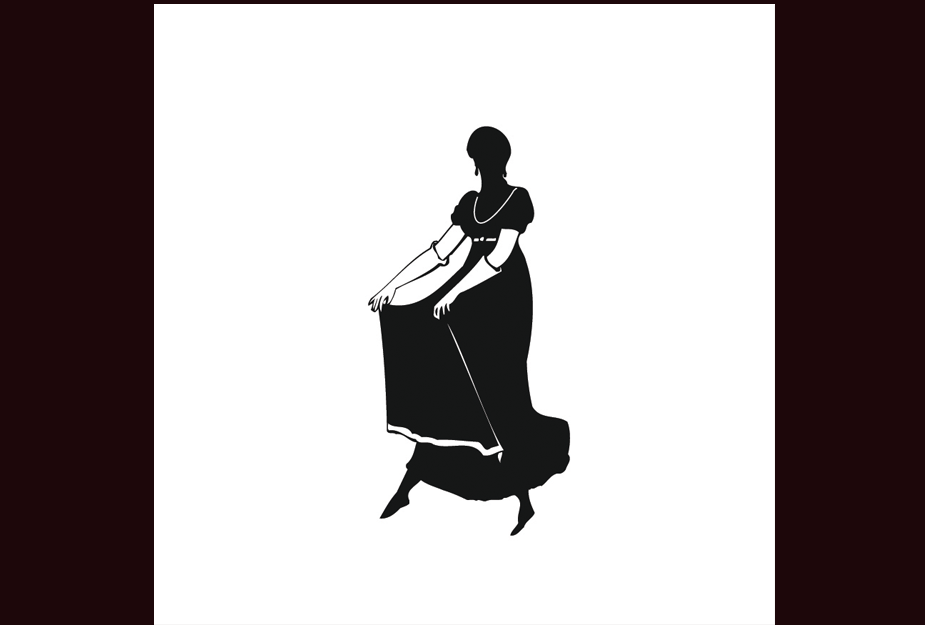
Here are 3 Fashionable “Georges”… …for whom fashion was named: King George III (white hair)(“Georgian 1760-1829”), his son King George IV (dark hair)(“Regency 1800-1837”), & George Washington (seated w/tents in back)(“Colonial 1740+-1800+”). “Colonial” because it was the King Georges America fought in the Revolutionary War.
America didn’t want any reminders of those fancy Georges, even though Americans still followed English & French fashion. We’ll get to Washington’s blue jacket later…
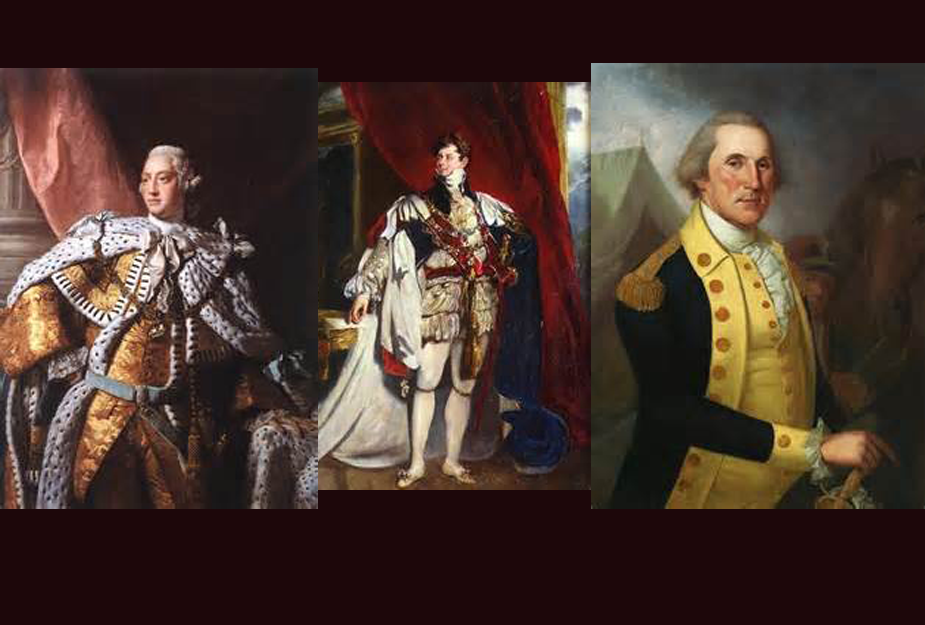
A Big Fashion Influence in Regency… …Regency/Colonial/Georgian eras was new technology in spinning & weaving fabrics. The “Spinning Jenny”, invented in 1764, & its continued improvement, allowed faster & mass production of natural threads – cotton and wool in particular.
(photo: “Spinning Jenny” in England, 1764 – well, it’s in a museum now..)
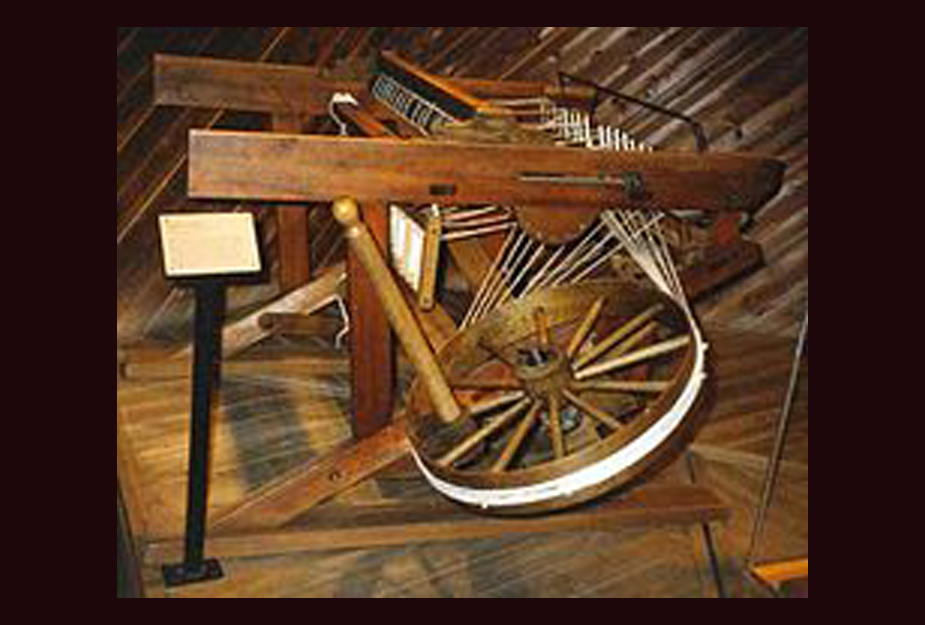
England was the leader of wool & cotton… …sales in 1800. Production had moved from a “cottage industry” (small shops with each step being separated & run by different people) to “mass production” (where a man & his son could run all operations under one roof). Invention of mass production looms allowed for mass production export & trade of fabrics.. especially to the fledgling United States.
(photo: Northrop High Production Loom in the Draper Corporation in Massachusetts, USA.) Draper, by the way, is still in business! It is where Silhouettes gets many of our historic materials for constructing costumes).
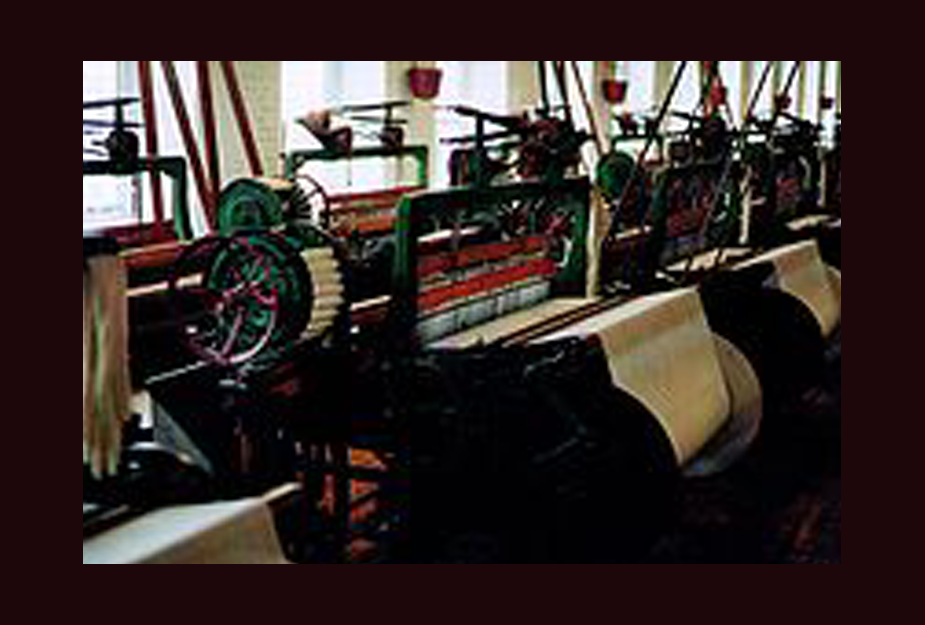
England’s big product was broadcloth… …or “Kerseymere”, and extremely heavy wool used worldwide, especially for military coats. It was solid, weatherproof, and breathable, perfect for a “Red Coat”.
(photos: British “Red Coat” uniforms of “Kerseymere” 1750-1835. Authentic British uniform from the Revolutionary War, now in an American museum.)
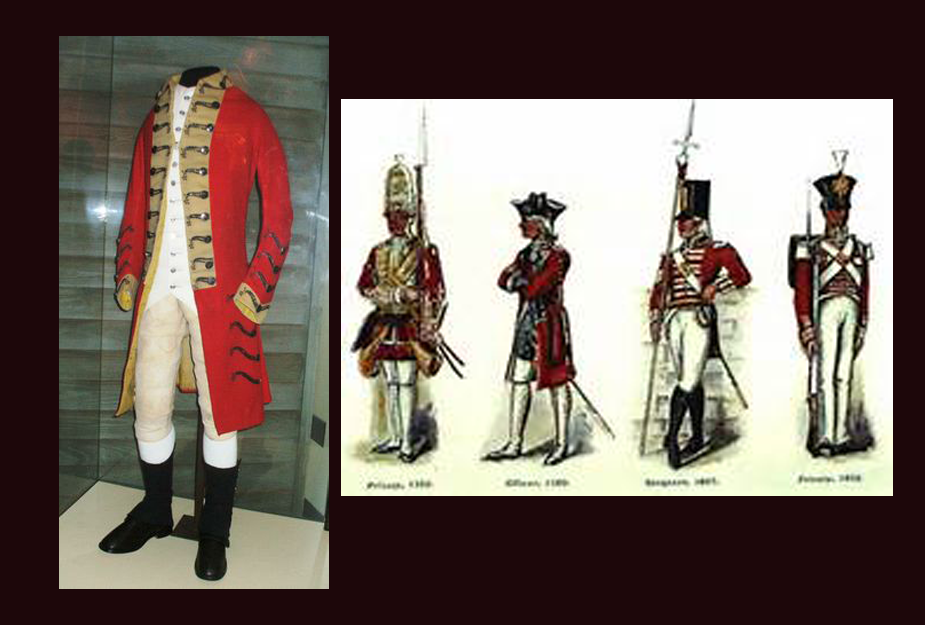
The Patriots wore English cloth to fight them Ironically, it was most likely imported English “Kerseymere” or Broadcloth the American Revolutionary patriot officers were wearing to fight the English.
(photos: Battle of Bunker Hill, Massachusetts, during the American Revolution 1775, where the “Red Coats” fought the Patriot “blue coats”.. mostly made of the same fabric)
(1 American side; 2 Americans on “Breeds Hill”; 3 “Death of General Warren”)
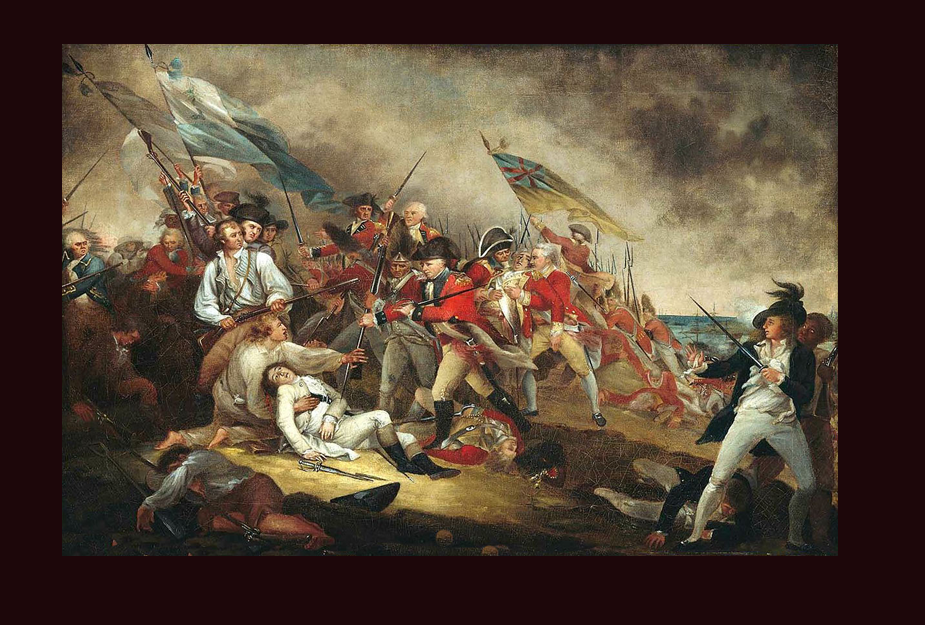
The Revolutionary War was fought in English fabric Wool and cotton broadcloth.. both sides – the red coats and the blue coats.. wore English goods.
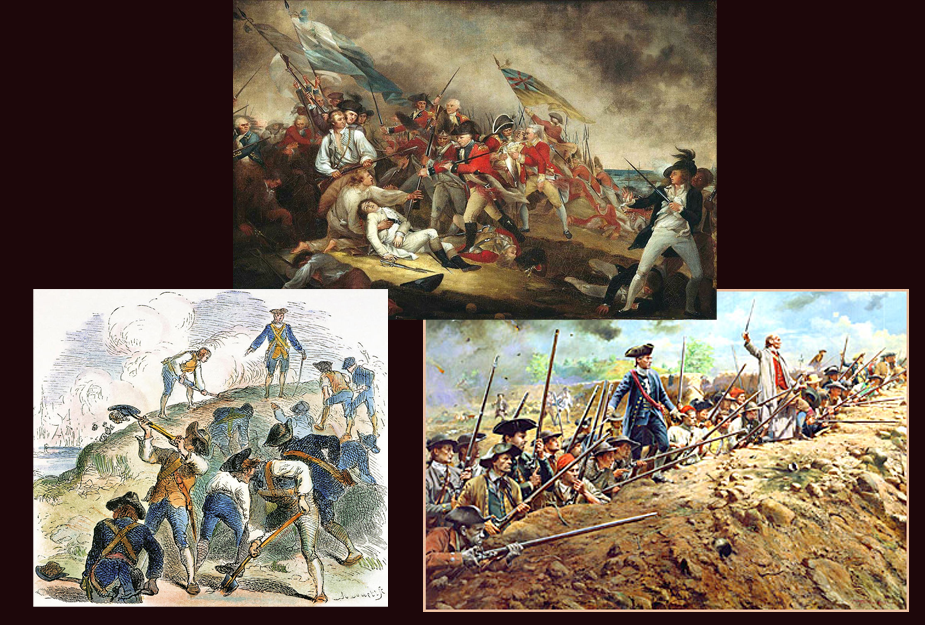
An Englishman named Earl Spencer… … it is said in about 1790, singed his fashionable military coat tails by standing too close to the fire, thus setting a fashion trend called a “Spencer”: a military coat with “frogging” (braid & decoration) but no “tails”.
(photo: A man’s “Spencer” coat of 1800 – this one cut REALLY shorter than practical for a military man out in the cold, but very popular with the ladies.. or is this a woman?)
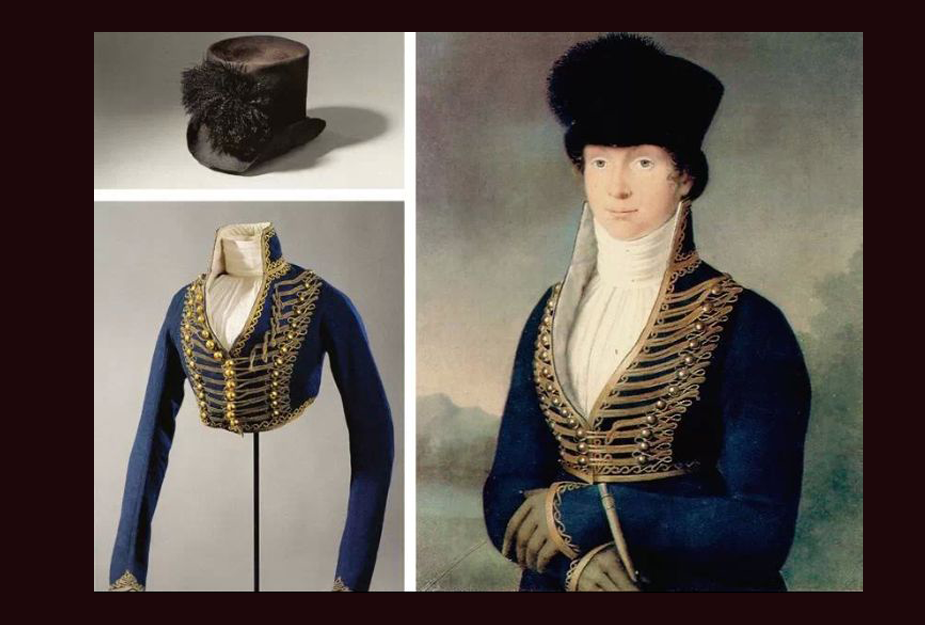
Women LOVED the man’s military look… …in the 1800-1818 period. They wanted the “freedom to ride (a horse)” that men had, & some even dared wear boots (only when riding)! One wonders though why they kept those darn skirts…
(photos: Marie Antoinette, Queen of France 1776 (setting the military trend BEFORE it hit in the 1800’s), and a couple of museum piece 1800 Spencer jackets “a la militaire” “sans corps” (without a body))
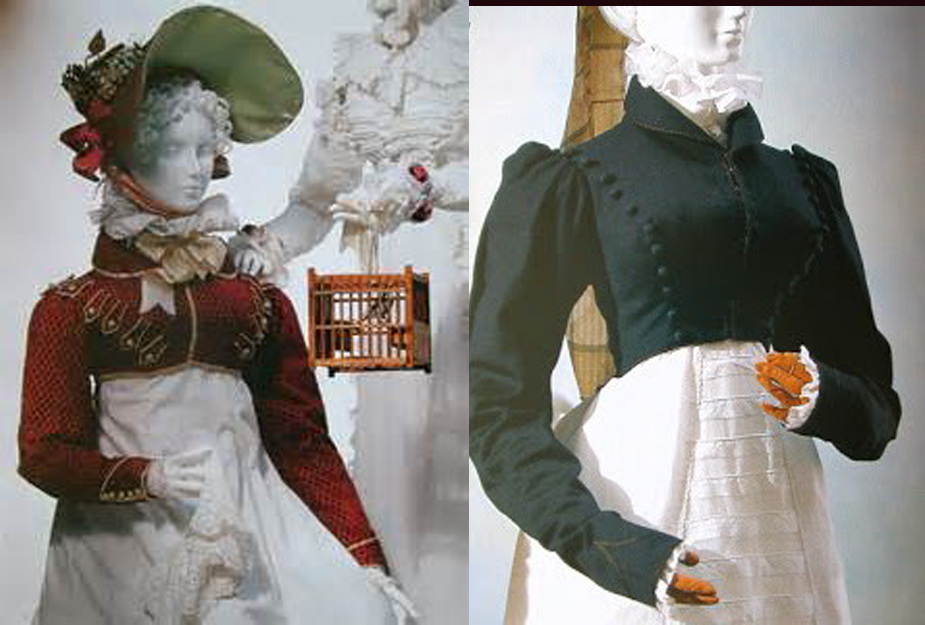
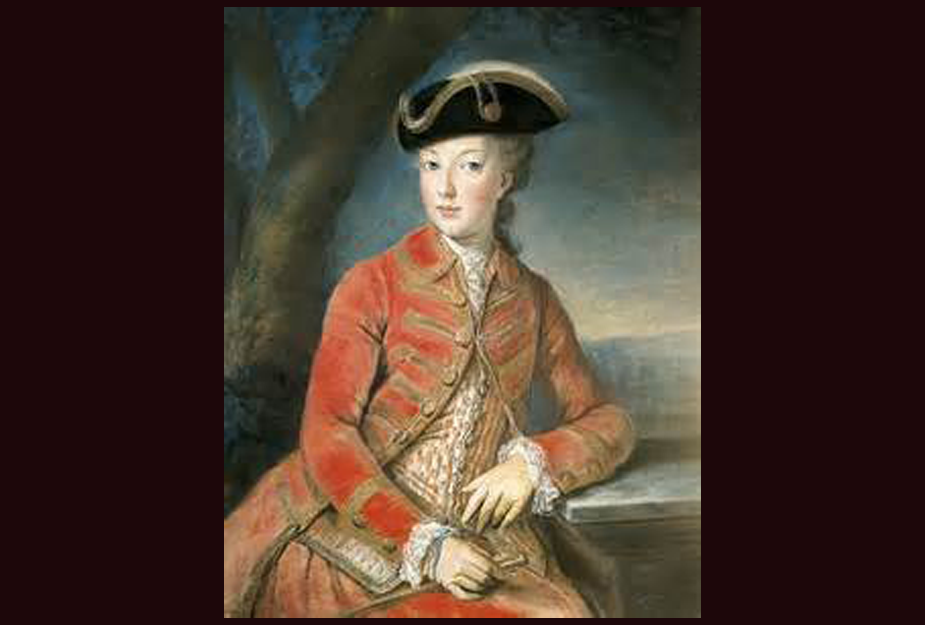
Here are more military inspired… …Regency (1800-1820) fashions.
(photos: Regency men with their women in coordinated “couple ensembles” from England and the US.)
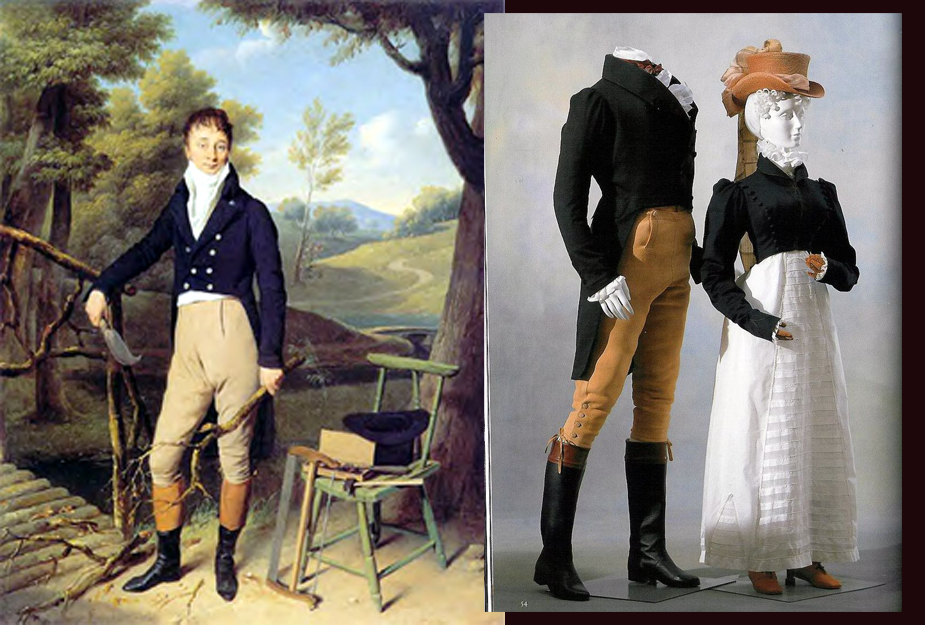
More Happy Regency couples.. are merrily coordinated in 1800-1820).
Notice – regardless of decoration or accessory, the dress is always of very thin white cotton with a high waist (we’ll talk about that later).
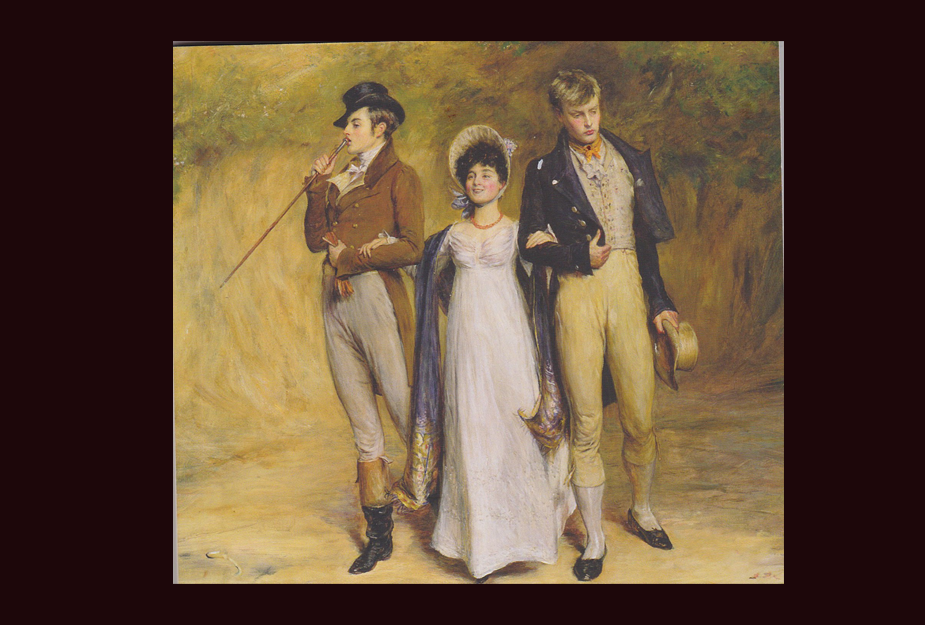
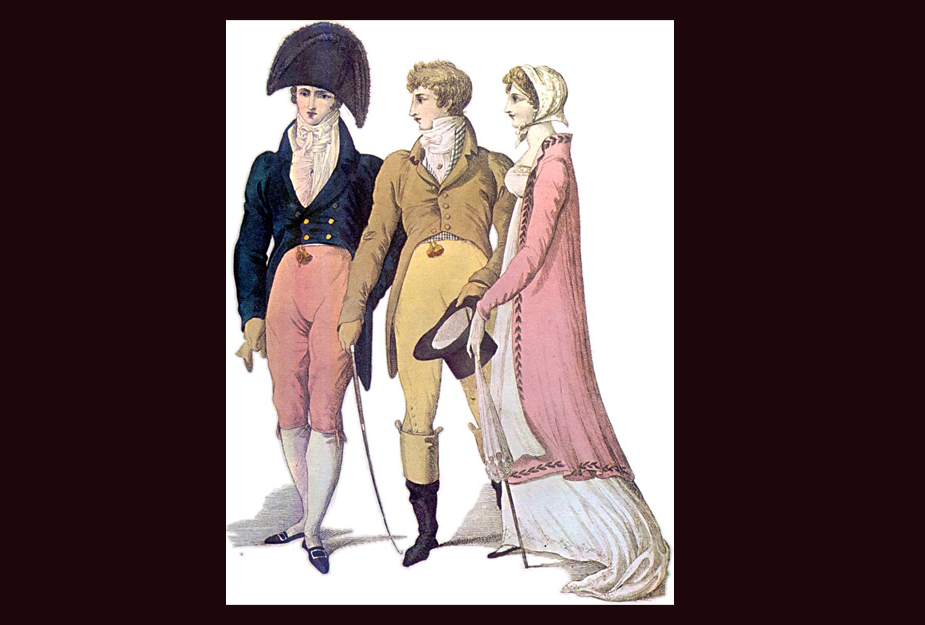
These are the SILHOUETTES we are discussing… Free from tight corsets for this brief time in women’s fashion, the Regency Era got a “wild” reputation.
You’ll see why, as we discuss what was going on in the world at the time in upcoming posts.
(photos: 1790-1800 Regency still had traces of Georgian/Colonial restraint, but by 1805 (right), they were getting a bit rowdy)
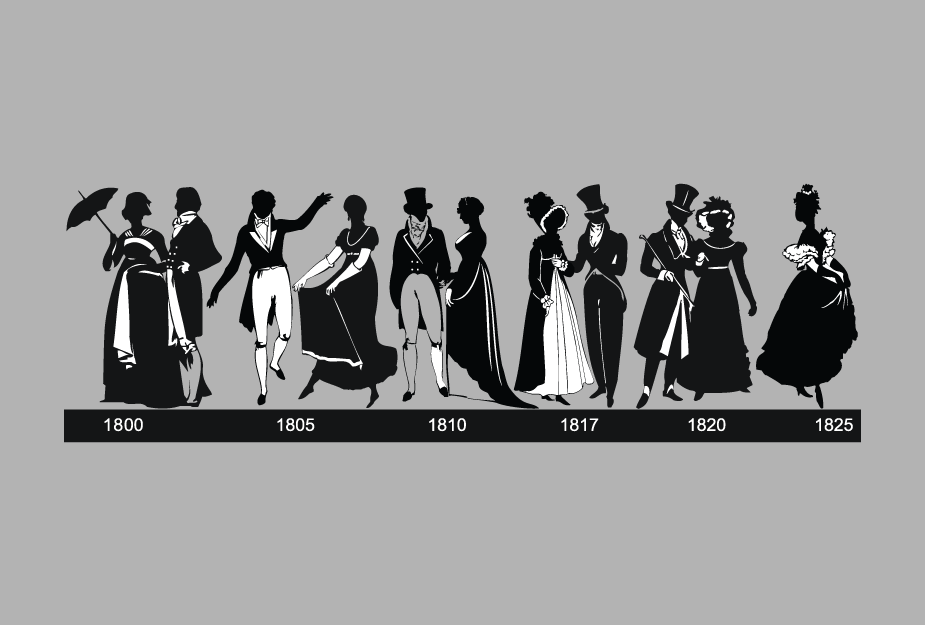
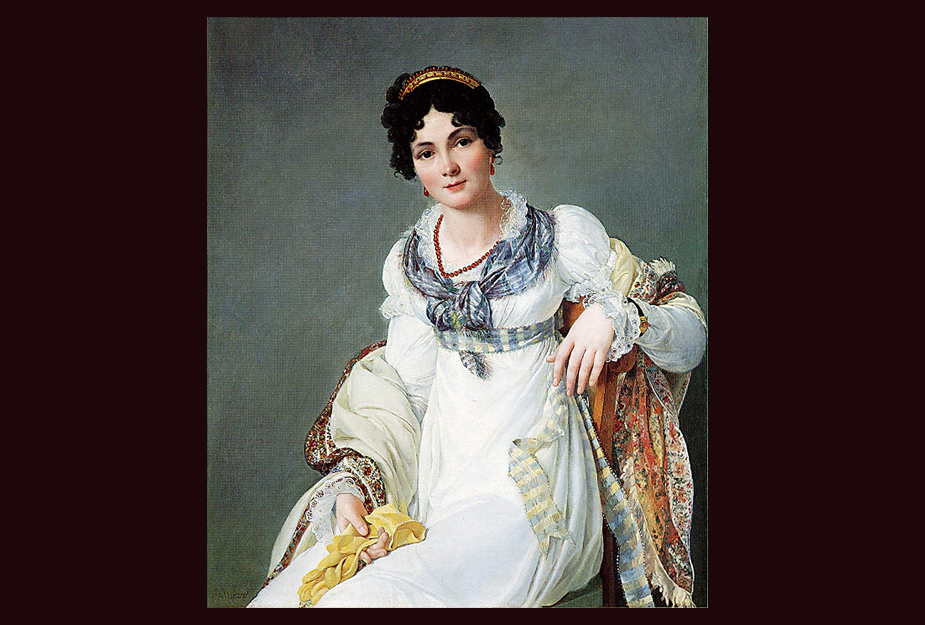
Cotton was a big influence… ..on Regency fashion. Prior to 1800, most cotton used by Europe & the new United States came from England.
Development of the cotton gin in the U.S. in 1794 plus new spinning methods changed the whole balance of trade, and therefore fashion, worldwide.
(photo: Eli Whitney’s cotton gin in a factory, & the original unit. This machine removed the seeds from the fluffy white parts of the plant, speeding up the process beyond anything imaginable at that time.)
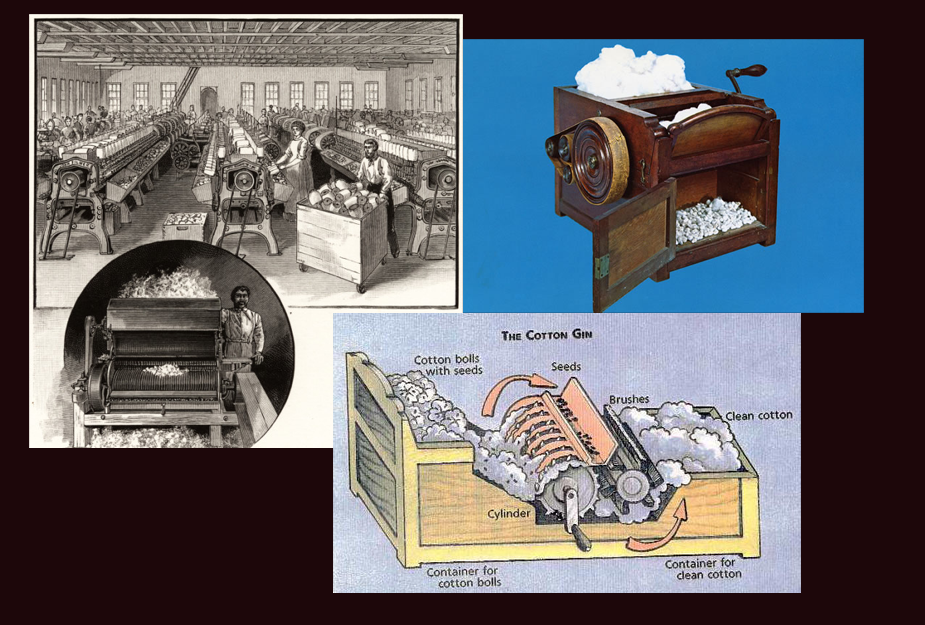
Cotton was King in 1800… …around the world, but the King of England was worried. With fast ships & improved communication, cotton from India was undercutting the market for English cottons & fabrics.
The King imposed an 85% tariff in 1819 (85 cents out of every dollar!) on all cotton imported from India, & hired the East Indian Trading Company to manipulate the import/exports of goods. It didn’t work.
(photos: East Indie company logo still makes some Englishmen mad; an English cotton ship brought rough cotton and finished goods from India in 1800)
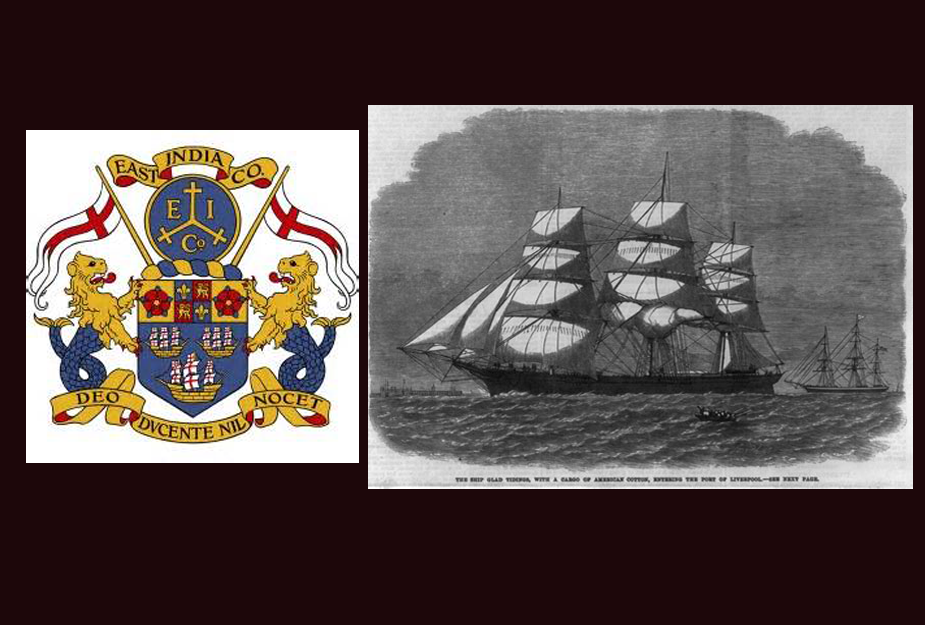
Everyone wanted cotton from India… … worldwide in late Georgian & Regency fashion eras (1790-1820), because Indian cotton was beautifully dyed, of high quality, & was inexpensive.
(photo: Lovely 1817 Indian print cotton Regency gown)
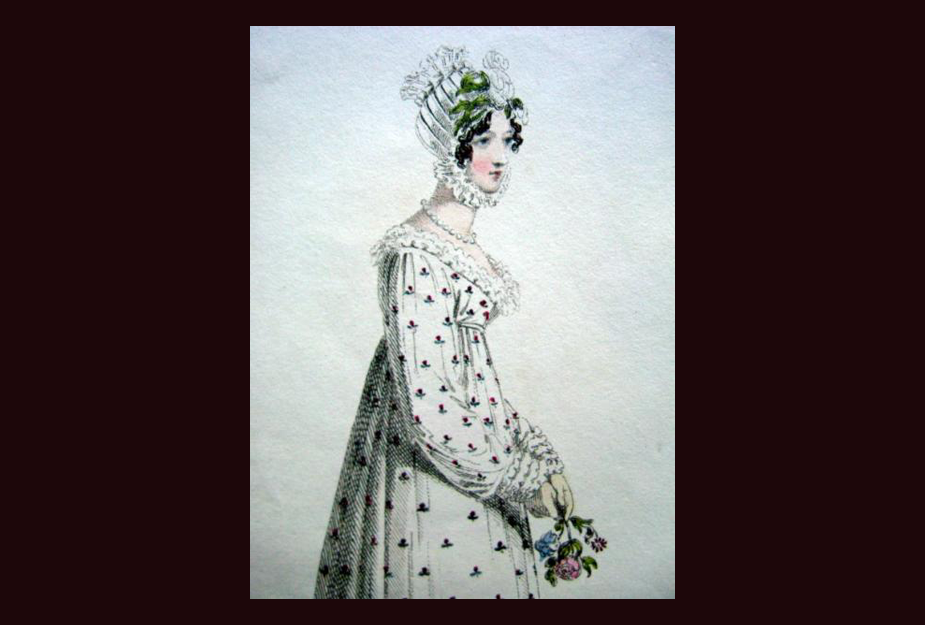
Cotton from India changed fashion worldwide… … in the Regency Era.
Indian words related to fabrics: calico, pajama, gingham, dungaree, chintz, & khaki – are still used with original meanings.
(photo: a village cotton harvest in modern India. Note the gorgeous dyed fabrics the women are wearing that caught the world market in the 18th century, & continue to dominate today)
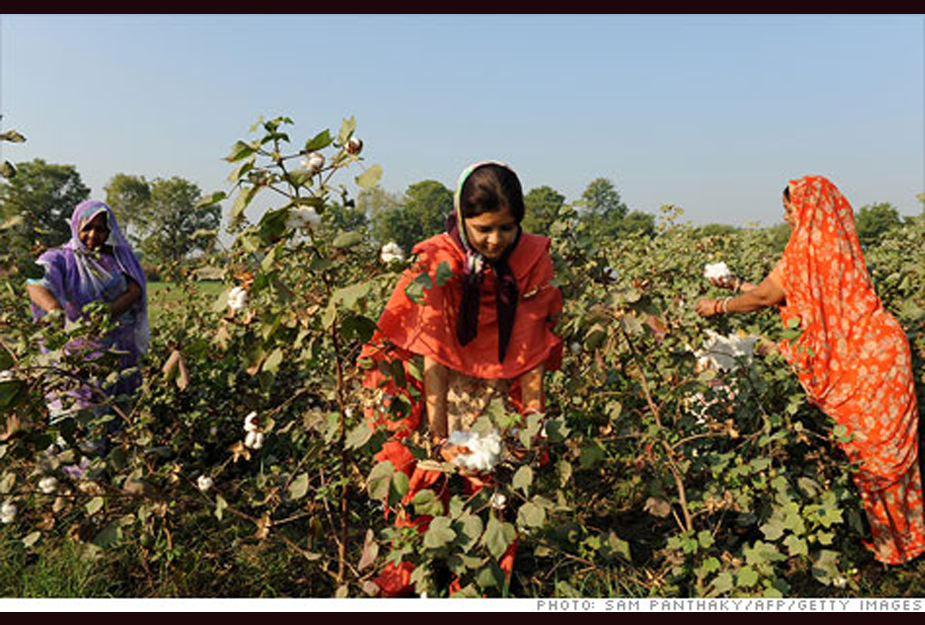
Cotton! Cotton from India directed fashion… …worldwide during the Regency, Georgian, & Colonial eras (1760-1820)
(photo: Indian TOILE cotton with gorgeous dye processes; 1770’s gown detail & 18th century authentic dyed cottons)
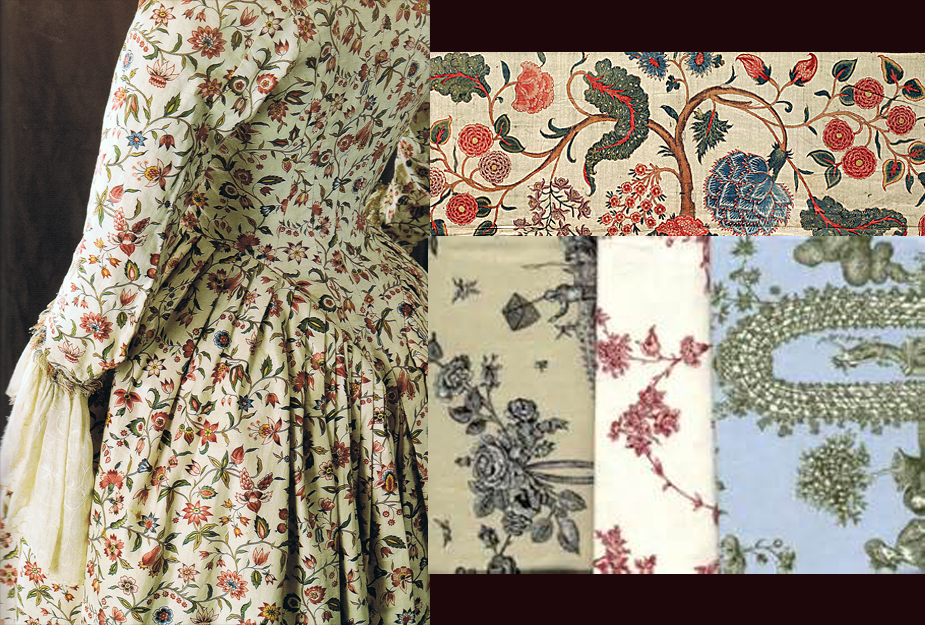
BATIK is a “resistance dying” process… …from India that was one of the reasons Indian cotton was so popular, especially in France in the 18th & 19th centuries.
(photos: 1760-1770 museum displays of French gowns made of India cotton with resistance dye process)
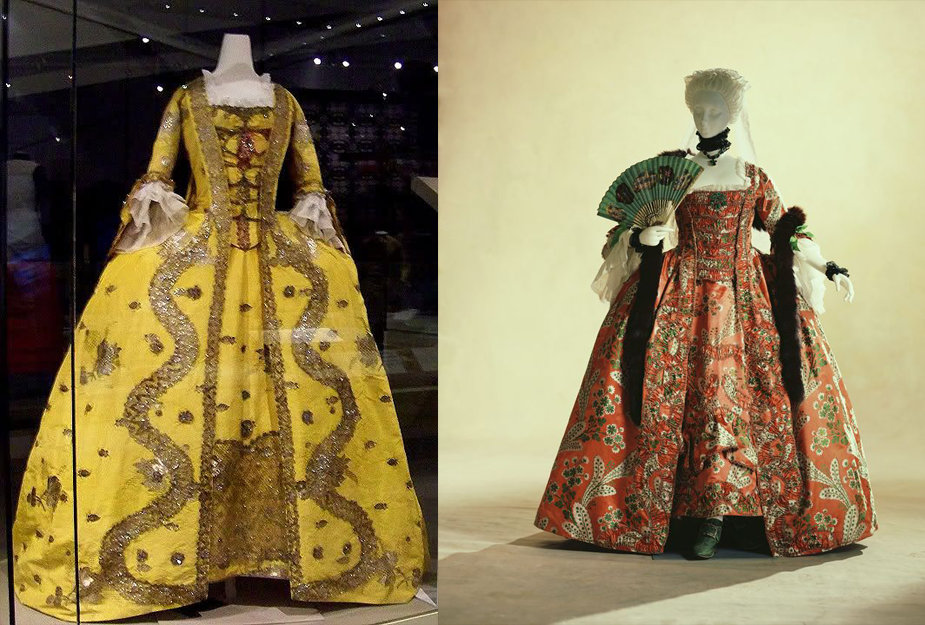
Calico is an Indian word… … for the type of dyes used in multiple colored prints on cotton.
(photos: authentic 18th century calico, and modern day replicas. Can you tell which is which?)
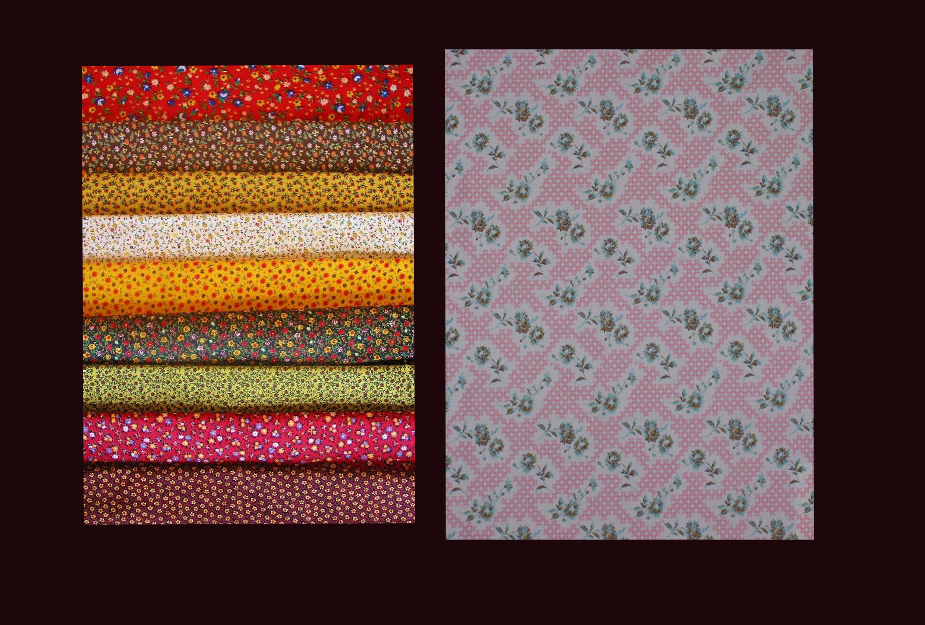
Thin little Regency dresses got COLD.. … so Indian cotton was really important during the Regency era. Women invented all sorts of lovely wraps and shawls to keep warm.
(photo: Regency shawls of Indian cottons with many dye techniques and embellishments)
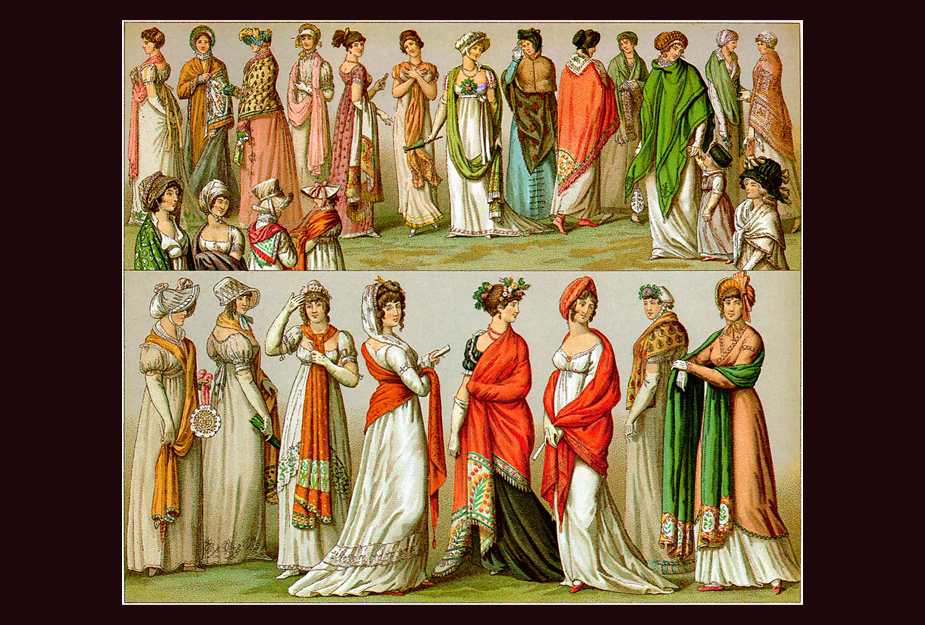
BROCADE is another Indian word… …and cotton fabric India gave to Europe & Colonial America in the Regency Era (1770-1810).
(photos: 1770 French gown with “panniers” of Indian brocade fabric)
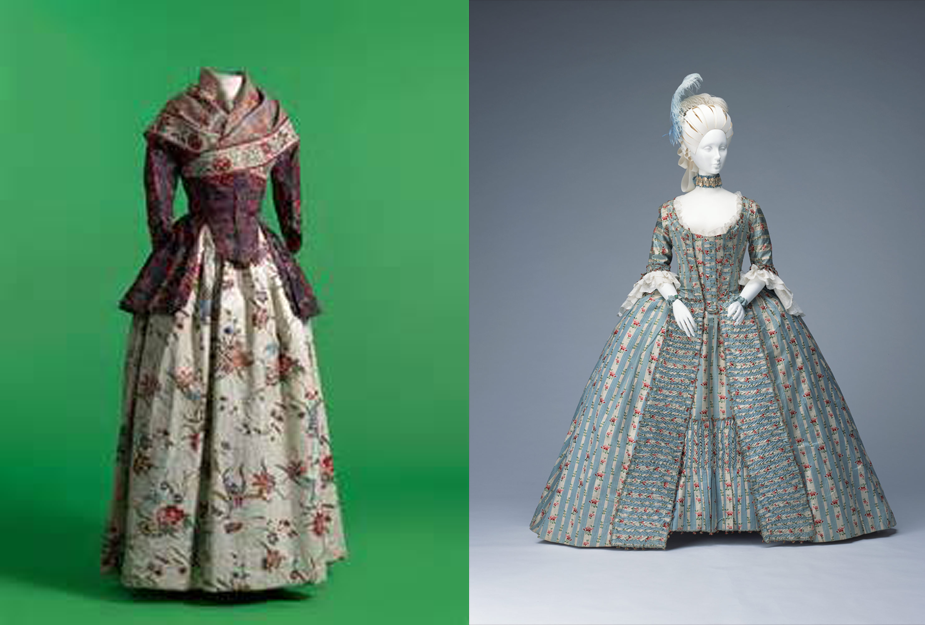
More India dyed & brocade samples… 1770 to 1820, cotton from India was famous for dyes. Different colors came from different regions: indigo blue from plants that grew in special places, yellow from turmeric & saffron, red from plants & trees with the chemical, alizarin.
(photos: 1770’s every day dresses from cotton dyed in India, bringng COLOR to the Regency & Colonial eras not possible before)
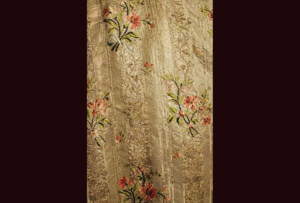
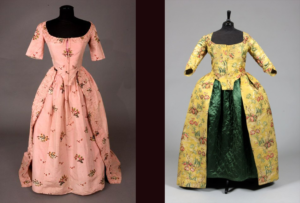
More lovely brocades… … from the Regency era, courtesy of Indian fabrics.
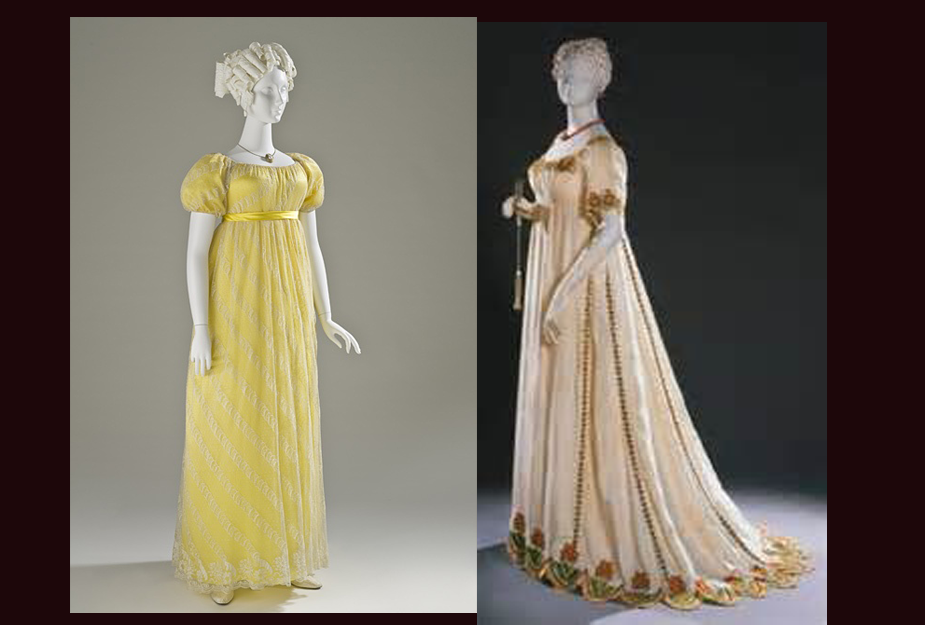
Pink stays… … (with green trim typically) were the number one choice of women in the late 18th Century (1780’s-1800).
(photos: 1770’s reproduction stays, & museum displayed 1770’s pink stays)
NOTE: We know this is a re-enacter, because no respectable 18th century woman would be caught dead outside in her underwear!.. although in all fairness, stays were sometimes worn outside the petticoat..
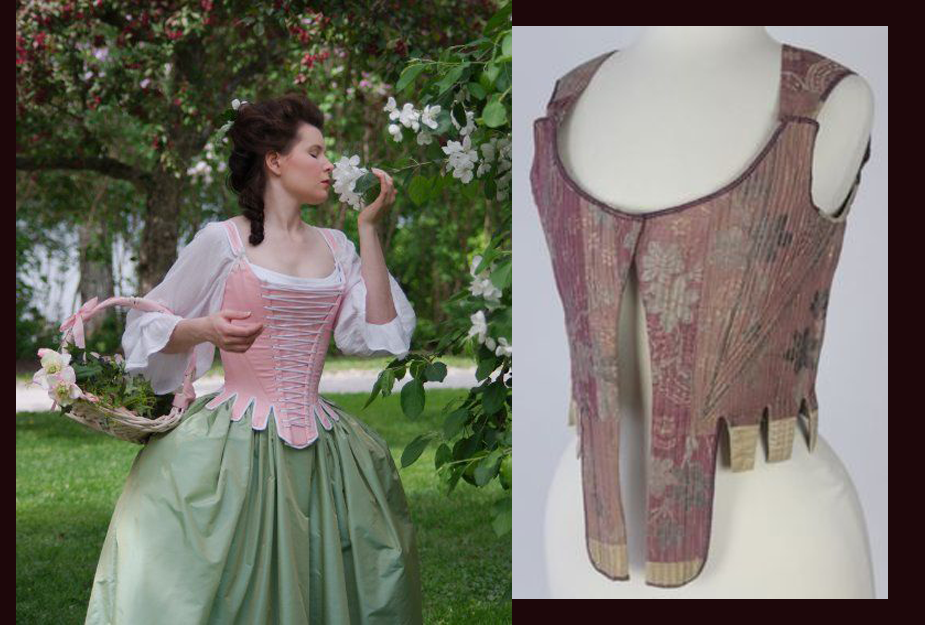
Meanwhile, there were wild silk moths… … which were/are native to parts of India, yielding gorgeous organic dyed silk fabrics exported to Europe & the American Colonies.
(photos: late Regency era silk ball gown)
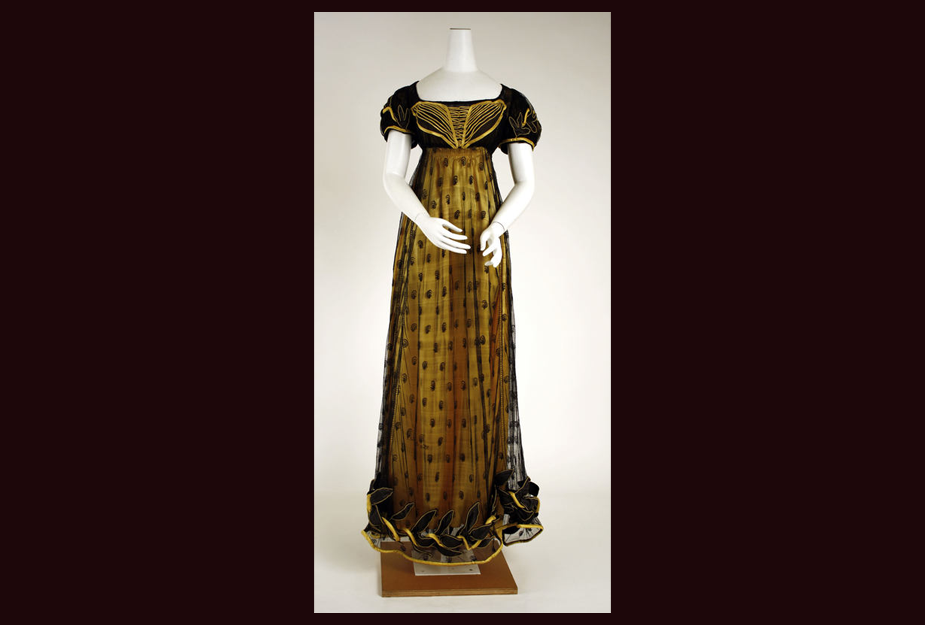
Because of WAR… … (between France & England, & the aftermath of the American Revolution) cotton from India started to become hard to obtain. By 1820, Americans, forced to provide for themselves, had become the #1 producer of cotton.
(photo: illustration of cotton picking in Colonial America in the 1800’s)
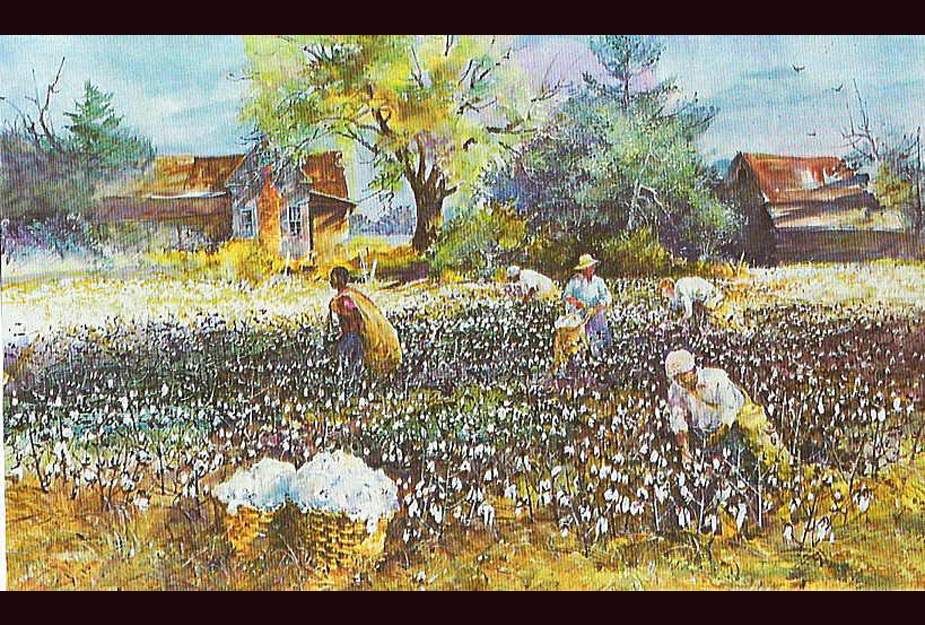
If you look up “Anglo-French” War… … you’ll find pages & pages of many conflicts just between France & England in the Regency/Georgian era we are discussing. For our discussion, there are 2 main periods: 1792-1799 “Revolutionary Wars”, 1799-1815 “Napoleonic Wars”, because of the French vs English influences on world fashion.
(photo: French Revolution timeline shows fashion coincided with what was going on in the world).
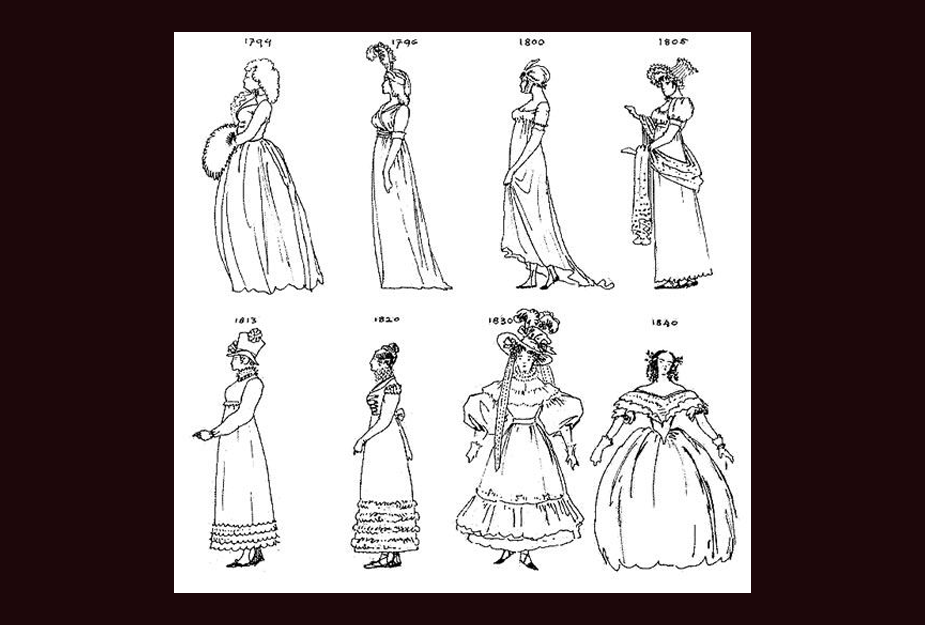
Jane Austen wrote in “Pride & Prejudice”… …about the year 1818 in the book, which was the height of Regency fashion. You see in the 2005 movie how Colonial/Georgian fashion of 1790 crosses over into Regency of 1800-1825.
The Mom still wears her “out of style” Colonial/Georgian fancy dress that has her busts spilling out, while each daughter goes ‘so far’ as per personality, into the flimsy cotton dresses that were the current fashion of Regency.
In the script, the mom mentions how London was responsible for bringing the long sleeves into style, & how proud she is her daughters could be the first to premier it.
In reality, the costume designer chose a rather odd and rare lower waist of the late 18th century, and blended it with the high lines of the Regency. we note the elder daughter is in the height of correct Regency fashion for the date, whereas the others date backwards towards the stays and lower waisted bodices of late Georgian style.
(photo: 2005 movie characters in costume for Austen’s “Pride & Prejudice”)
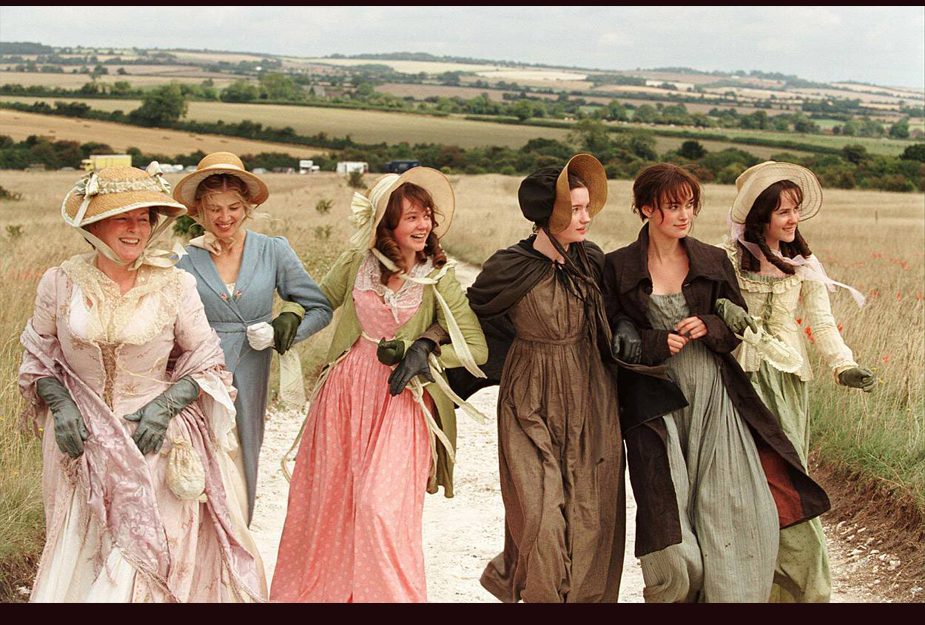
Key People & Ideas
Marie Antoinette
Marie Antionette, Queen of France… …was a huge influence on Regency fashion from about 1780 to 1820.
Improved trade between countries meant improved communication. Women all over the world wanted to follow France’s fashion lead, & Marie set the trends.
(photo: In 1776, Marie was wearing the *conical stays, spilling breasts, & huge skirts with panniers of the Georgian period in court).
*See Colonial Specific and the 1776 Section for more about the 1700’s and Marie Antoinette
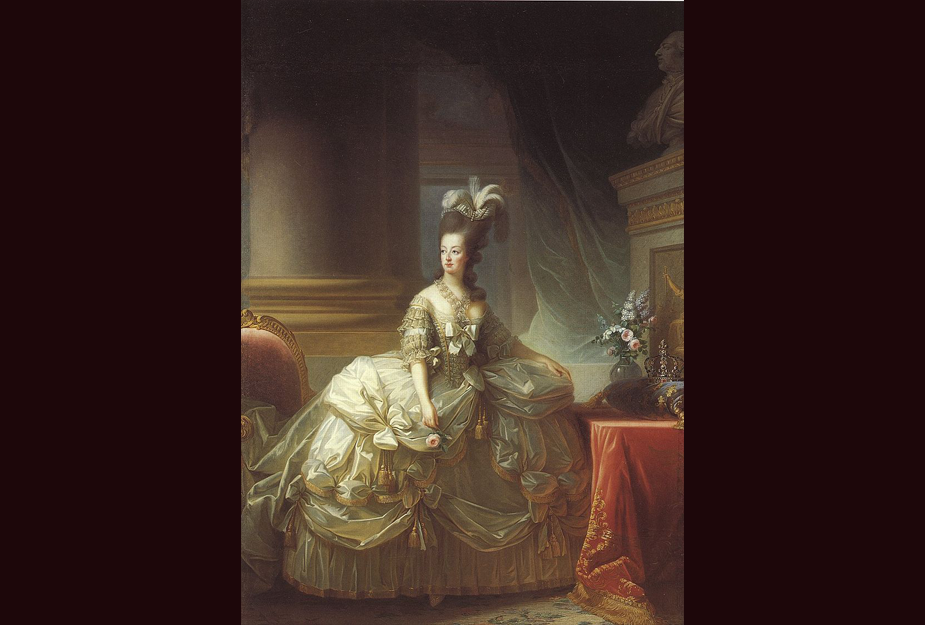
Marie Antoinette Queen of France, was THE biggest influence… …on fashion in the world during England’s Georgian and into Regency eras.
In the beginning of her reign, voluminous skirts, elaborate decoration, stays that squeezed the bust high, & almost “house-like” under structures were the marks of the 1770-1780’s in French court dress.
Women throughout the world copied her as best they could.
(photos: portrait of the Queen of France in full “robe de court” about 1778, and a working woman’s version of it at about the same time & place)
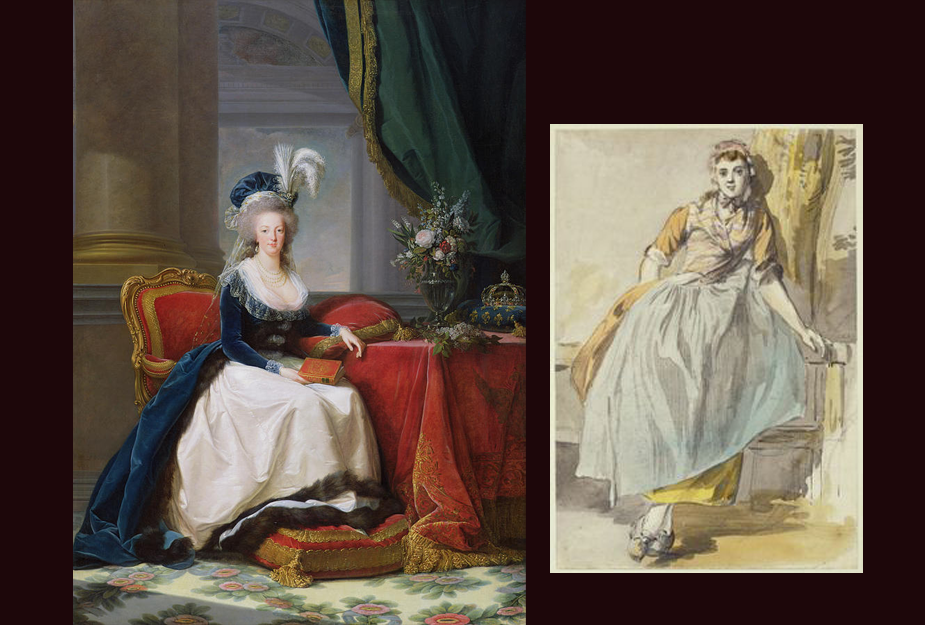
Because women copied her, Marie Antoinette …Queen of France, was required by her husband, King Louis, to wear complex under structures, voluminous fabric, & French-made “fancy work” (silk, lace, etc.) to promote the french textile industry that was lagging behind England & India.
Even at leisure, Marie wore the finest fabrics & most complex fashions of the Georgian “pre-Regency” era.
(photo: Marie Antoinette 1785 leading fashion that would be called “Georgian” or “Colonial” style in the history books).
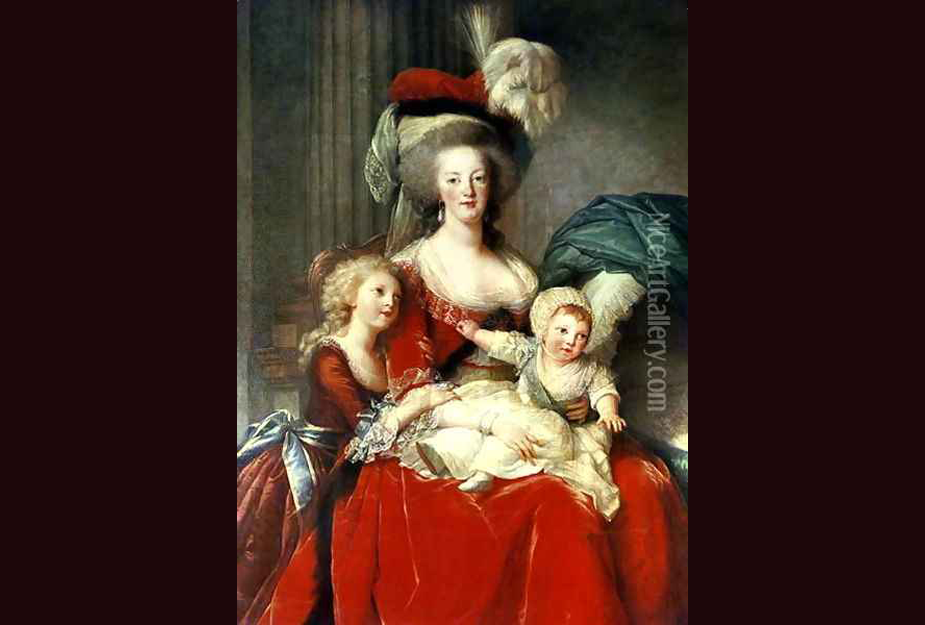
Instead of using patterns, King Louis …of France sent DOLLS wearing the latest fashion to women of nobility, so they would know what to wear to court. The French textile AND doll industries did well into the late 1800’s because of the dolls.
(photos: left: French court model late 1800’s doll; modern reproduction of a late 1700’s “King Louis Fashion Doll”; 19th century fashion pattern doll)
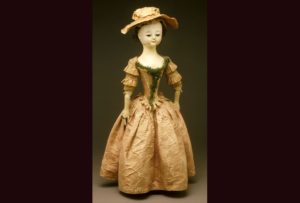
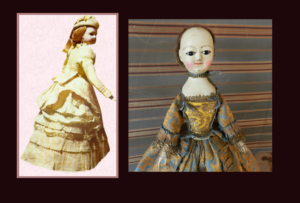
French women used King Louis’ dolls… …as patterns to create the huge & complex court ensembles of the 1780’s.
It kept the French textile industry in business in spite of the superior English manufacturing methods, and dyed cotton from India that were readily available at the time.
America, not yet able to manufacture their own textiles to meet their needs, was importing ideas and materials from all of them.
(photo: 1780 Marie Antionette “wanna be’s” wearing complex costumes to the French court as required by King Louis.)
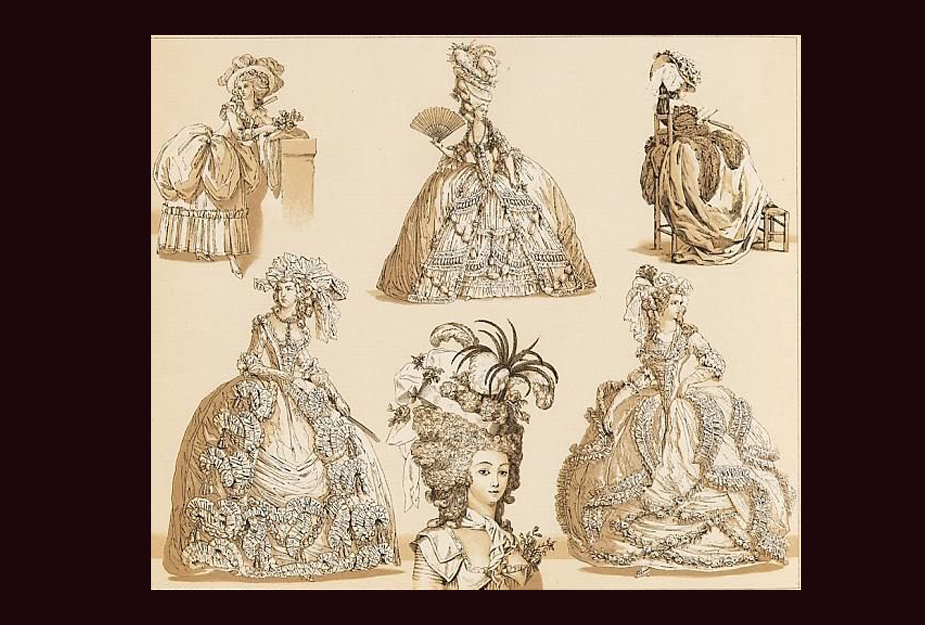
Women around the world wore simpler versions… …of French court dress, because they wanted to be fashionable.
The basic shape with the low front bodice, wide hips, and large skirt was still there even for the working woman, although missing were extravagant decoration. Skirt length varied from 1770 to 1790 depending on what Marie Antoinette was doing in France.
(photos: “Working women” 1770 (Netherlands) and 1785 (America) emulating French fashion as best they could)
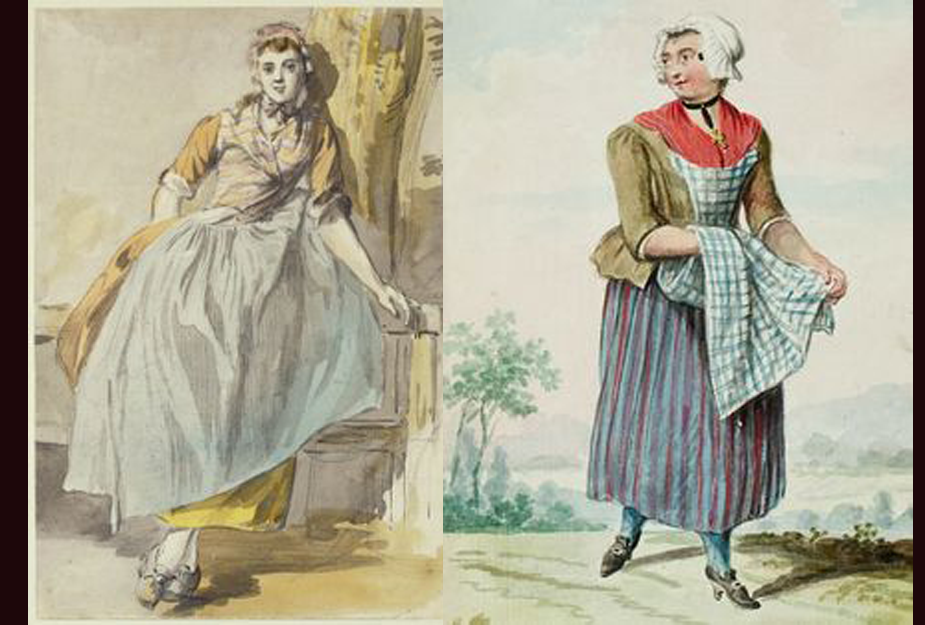
Women became shepherdesses in the city… …because in the late 1770’s women interpreted Marie Antoinette’s court dress, and added a “pastoral” element. They brought sheep into the city, and pretended to be shepherdesses.
(photo: 1780’s English “shepherdess” complete with sheep and crook)
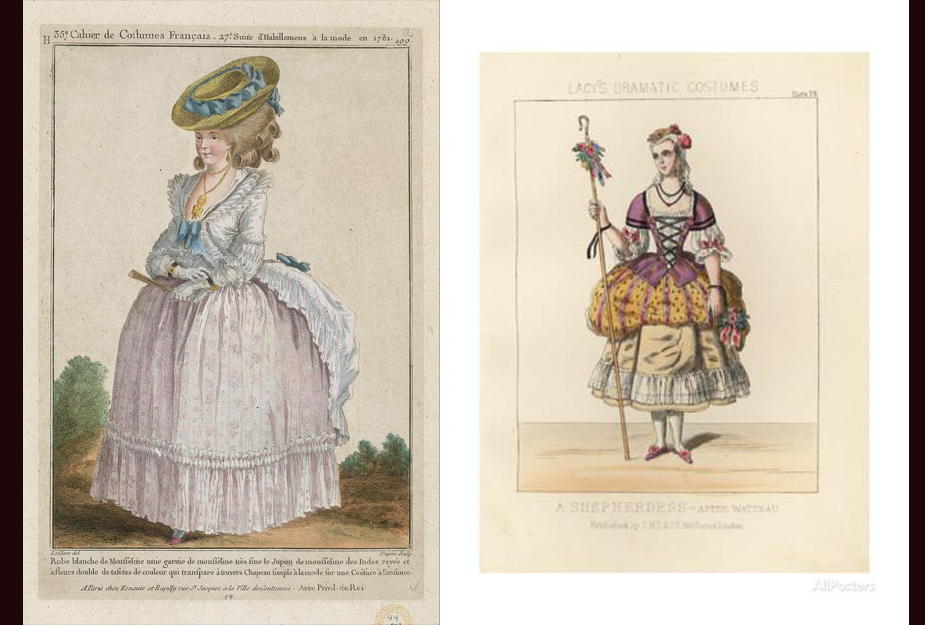
The Queen of France wore just her underwear… because she was tired of being “stuffed & trussed” in Court costume. Marie Antoinette escaped to her “Petit Hameau” (little farm) at Versailles, were she wore her white muslin undergarment called “chemise a la reine” (underwear of the queen).
(photos: “Petit Hameau” and Marie Antoinette in about 1790 wearing a “dressed up” version of her undergarments.)
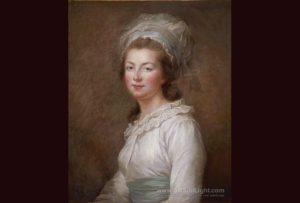
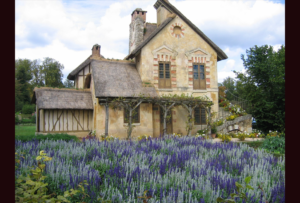
Marie Antoinette posed for a daring portrait… …by a famous female painter, Le Brun, in her “Chemise a la Reine” (“Queen in Underwear”). She was already unpopular with French women, & this tipped the gossip scales against her.
They didn’t like this new “Gaulle” style of dress, because there was no “pomp or monarchy” – YET – women around the world started to copy this no frills, comfortable style themselves.
(photos: 1) original painting of Marie Antionette “en gaulle” by Le Brun; 2) the replacement painting the public thought more socially appropriate)
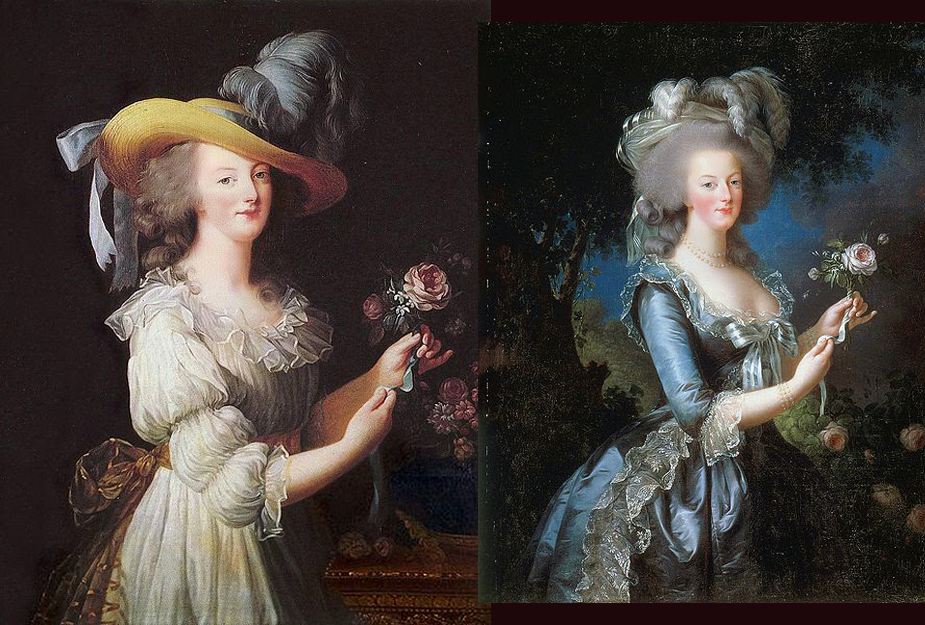
Marie Antionette’s 1775 actual day dress.. pretty fancy even when she was being casual..
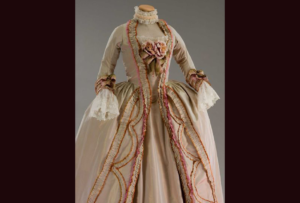
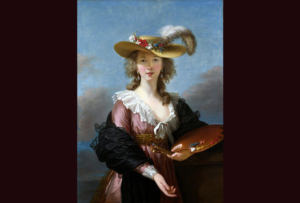
The French queen’s simple, white cotton.. …comfortable, inexpensive “Chemise a la Reine” or “Gaulle” style became wildly popular around the world in about 1790.
THEN… the imaginations of women took off in a direction never seen before in the history of women’s fashion…
(portraits: Marie Antionette bravely painted “en Gaulle”… and an artist’s version as the style “took off” into the world of fantasy…)
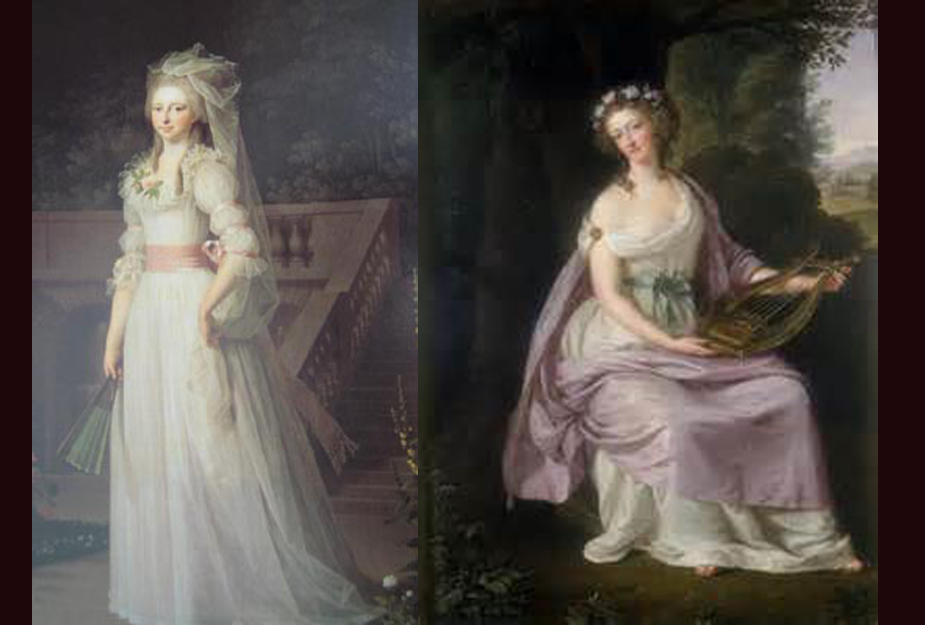
Regency Fashion Specifics out of Marie Antionette’s reign
The “Chemise a la Reine”… …invented by Marie Antionette, became the new “Little White Dress”.
In the beginning, about 1794, it was made of plain, white, thin muslin (cotton), and a notably high – under the bust – waistline. This was exactly opposite of the politically correct fashion, as it had no structure and few undergarments.
(sketches: the new and daring “Little White Dress” of 1794)
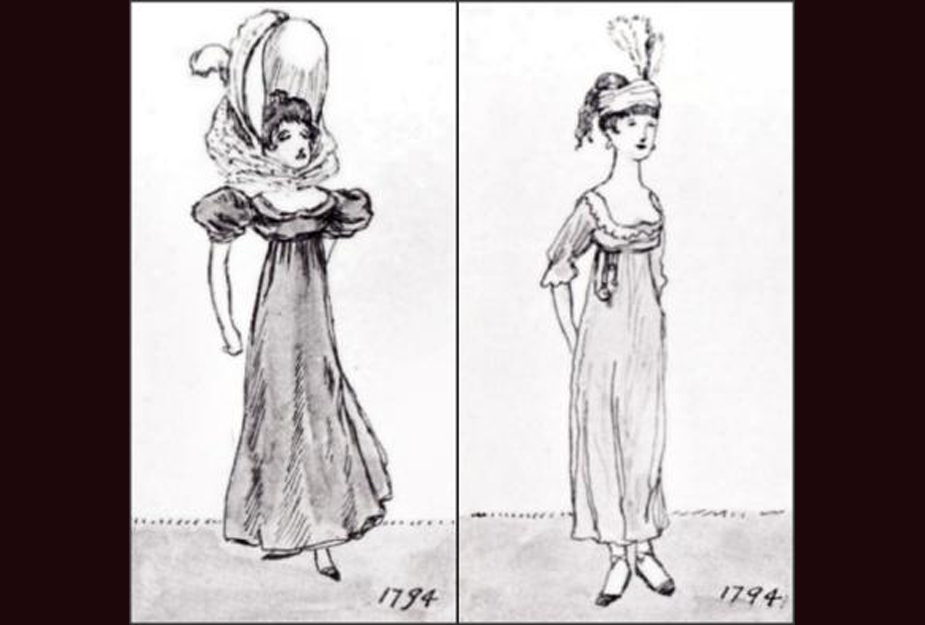
We are talking about the “Regency” style… …in America which crossed fashion eras on either side of 1790 to 1825.
A Regency costume is one of the least expensive we can make you, for the same reasons it was popular back then – there’s only a tiny bit of inexpensive fabric, short stays (corset), and not a whole lot that is worn underneath.
(photo: Party like it’s 1818! BBC made a version of Jane Austen’s “Pride and Prejudice”. Here is a scene from “Netherfield’s Ball”)
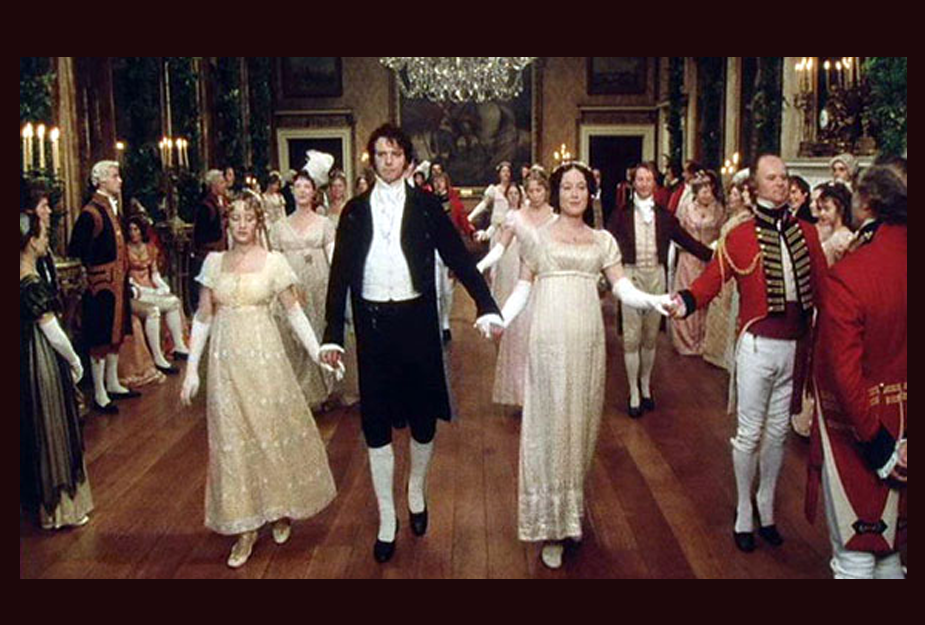
It wasn’t “does this make my bum look big”… …but rather “does this make my bum look BIG ENOUGH?” in the 18th century.
(photo: as seen in this servant’s ensemble, in 1790 the fashion goal was to have your breasts s pilling out over the bodice, and your “bum” look gargantuan)
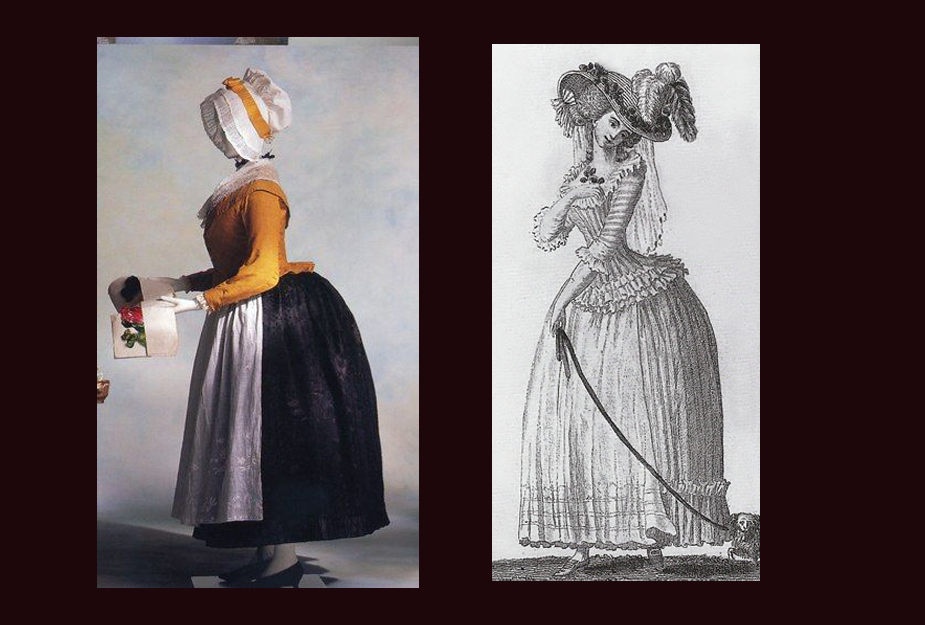
The basic “Little White Dress”… …of the Regency fashion era (1790 to 1825 ish) was of un-dyed and unadorned white cotton.
The waist rose from where it had been in the previous Georgian/Colonial period at the natural waist line – up, up, up – to just under the bust. This was called “Empire Waistline” in reference to the french queen who started the trend.
(sketches: the basic Regency dress was of plain white cotton with short sleeves. Later additions were sleeves and printed cotton)
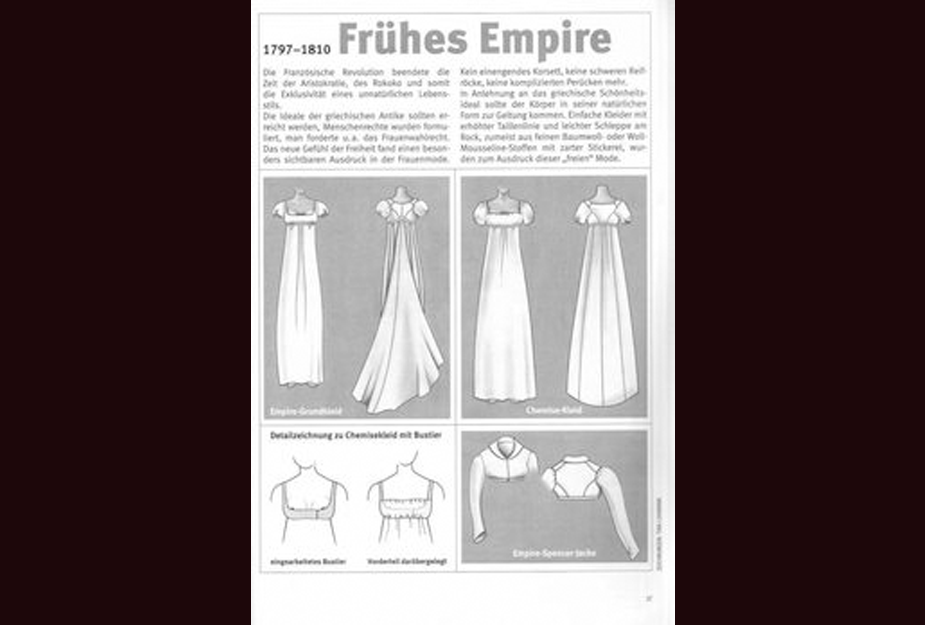
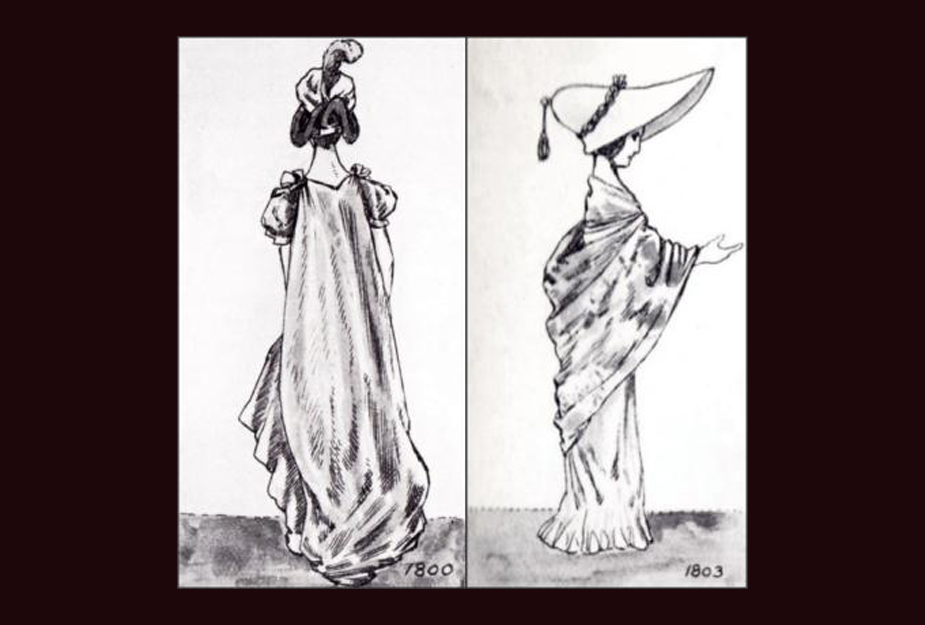
To wear the thin, sheer, and flimsy cotton… … “Little White Dress” of the Regency fashion era, undergarments had to be minimal.
(photos: modern model shows left: Regency “chemise” with the empire waistline; right: “inside petticoat”. Shy women wore a full body, knit stocking in white or flesh color, which the model is probably wearing)
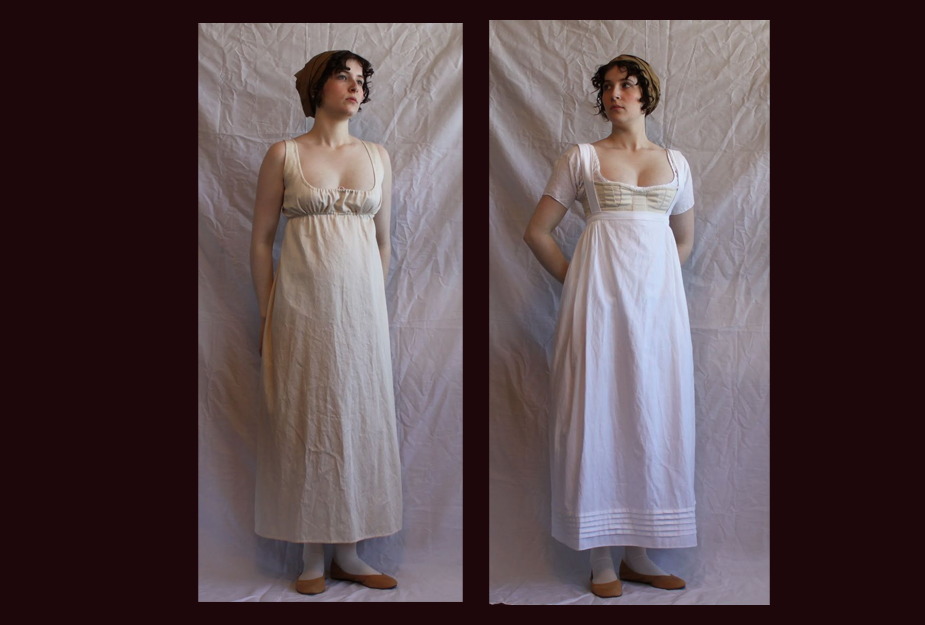
Shorter stays were needed… …to wear the high-waisted Regency “Little White Dress”. Stays (in the next century called “corsets”) were shorter than previous years, and had little structure. Older or larger women still wore the older styles.
(photos: actual Regency stays now displayed in museums. Notice they have very little structure, but are more like little “jackets”)
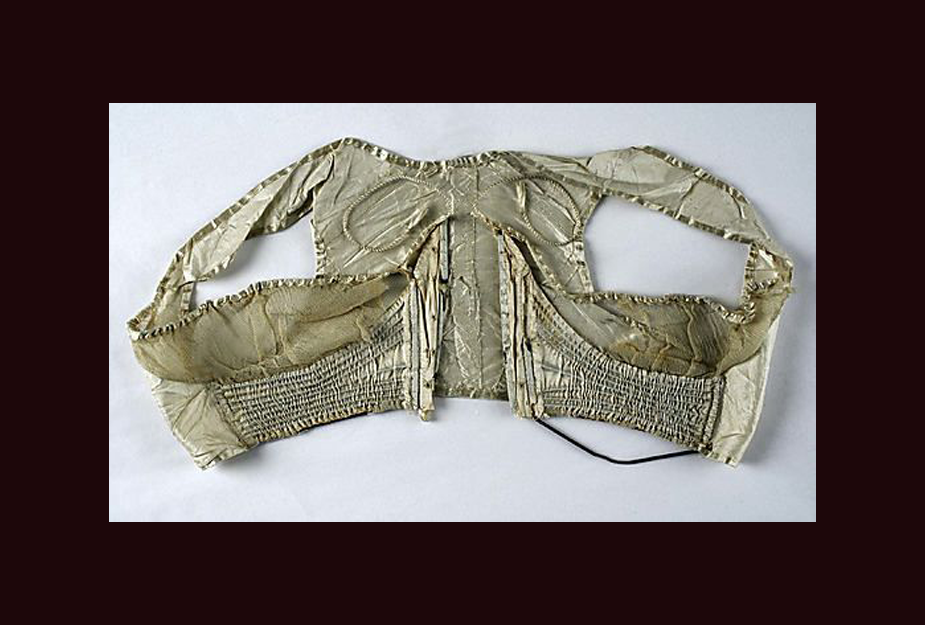
Long stays were still worn… … as figure shapers for those who were not naturally slim and waiflike as per the fashion plates.
(photo: gorgeous modern corded stays for Regency re-enactment. See the History of Stays & Corsets for more detail on these)
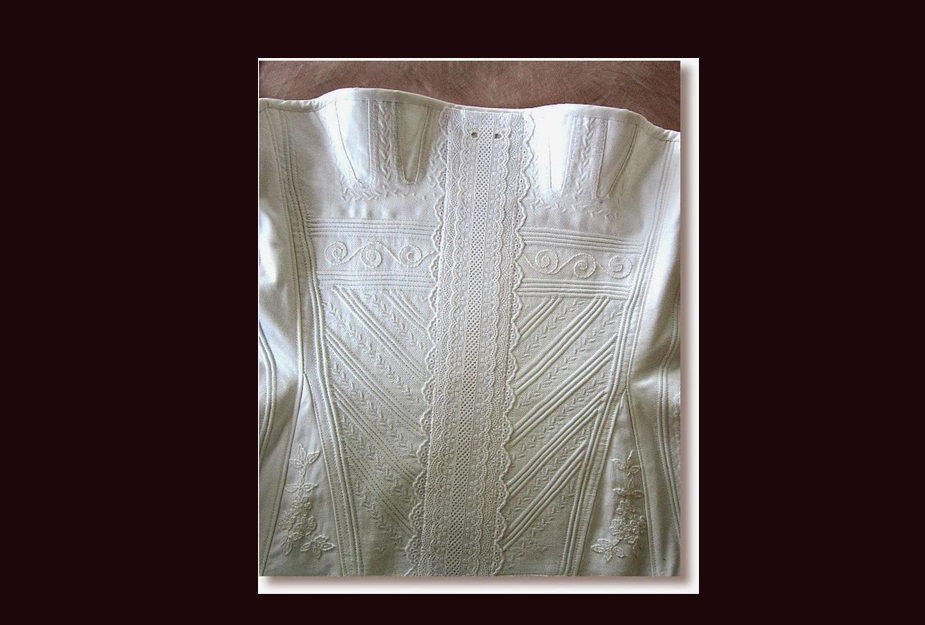
If you want to immerse yourself in Regency style… …ask us to build you a costume for a “Jane Austen Festival”! Held annually in Australia, and Kentucky, re-enacters enjoy living history in bonnets and “Little White Dresses”.
(photo: Jane Austen festival Kentucky and below: Australia).
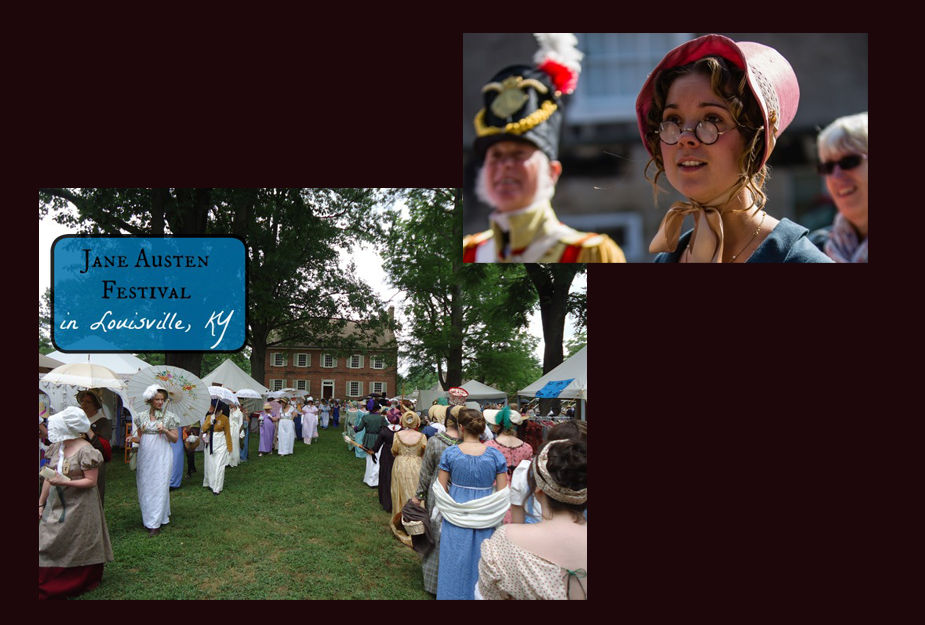
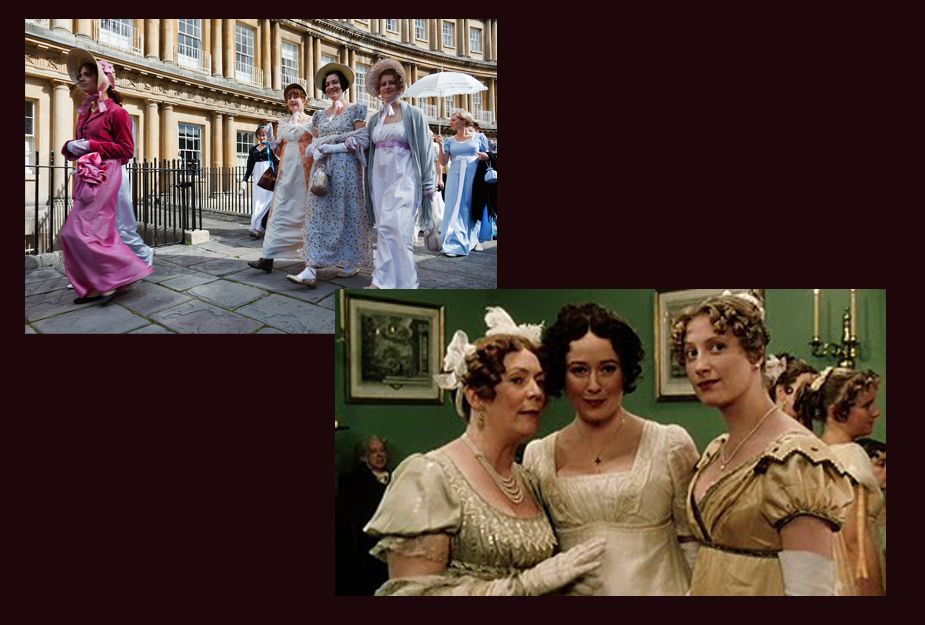
Here are SILHOUETTES starting with 1800… …Regency fashion. The “Little White Dress” is going to get fancier as time moves forward.
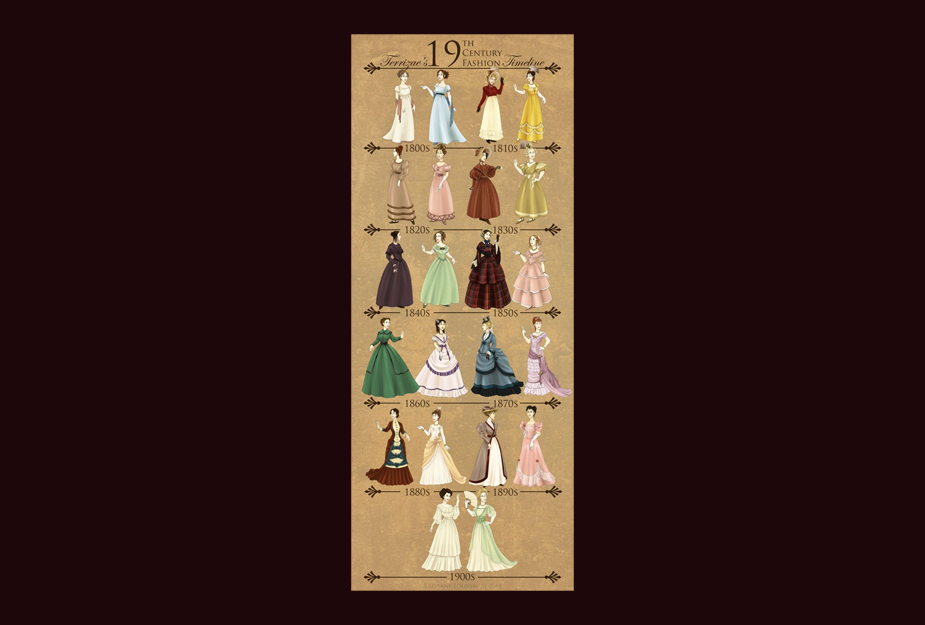
At the start of the Regency Fashion Era… … (1790-1805) the “Little White Dress” was for evening wear.
(photos: evening gowns with accessories and trim for evening)
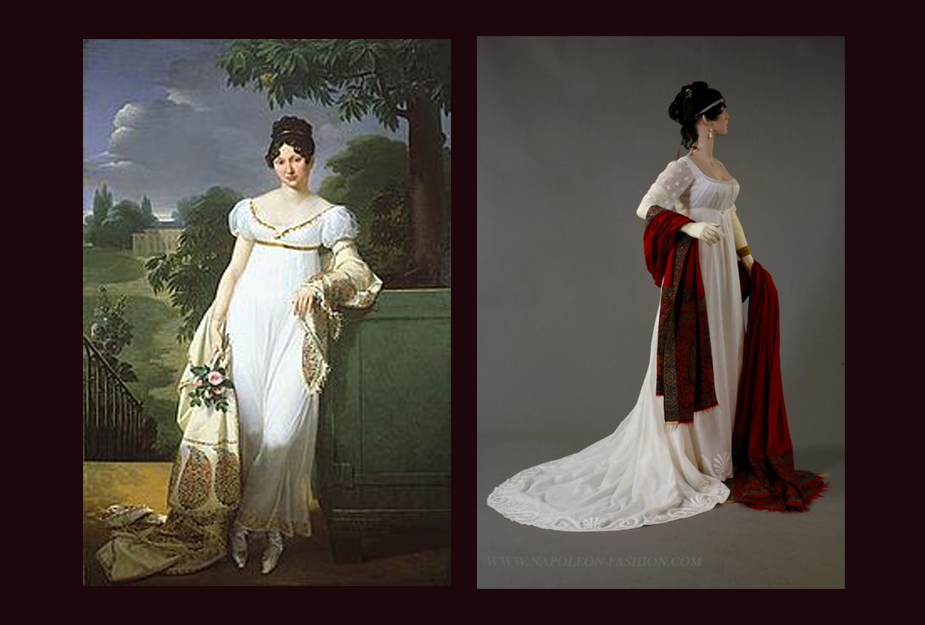
Pastels were for daily wear… …in the Regency era.
(photos: 1805 “daytime dresses” of cotton print, India dyed)
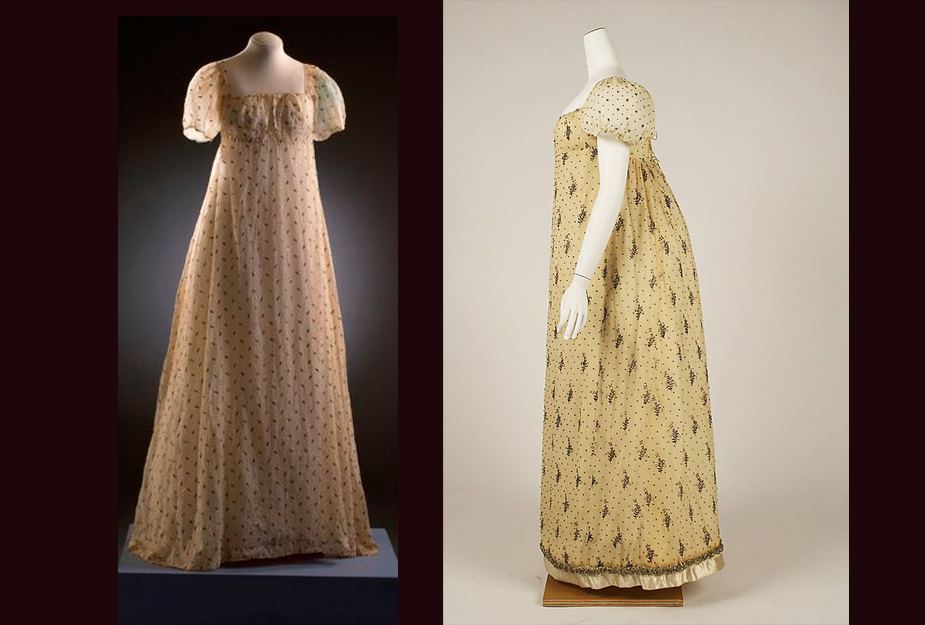
Regency gowns used many strings… … to tie them on. In the late 1700’s, while there were buttons, metal hooks/eyes, zippers, and other ways of attaching clothing hadn’t been invented yet.
(photo: 1805 gowns on the inside, showing how creative women were by using strings to keep that high waistline up high)
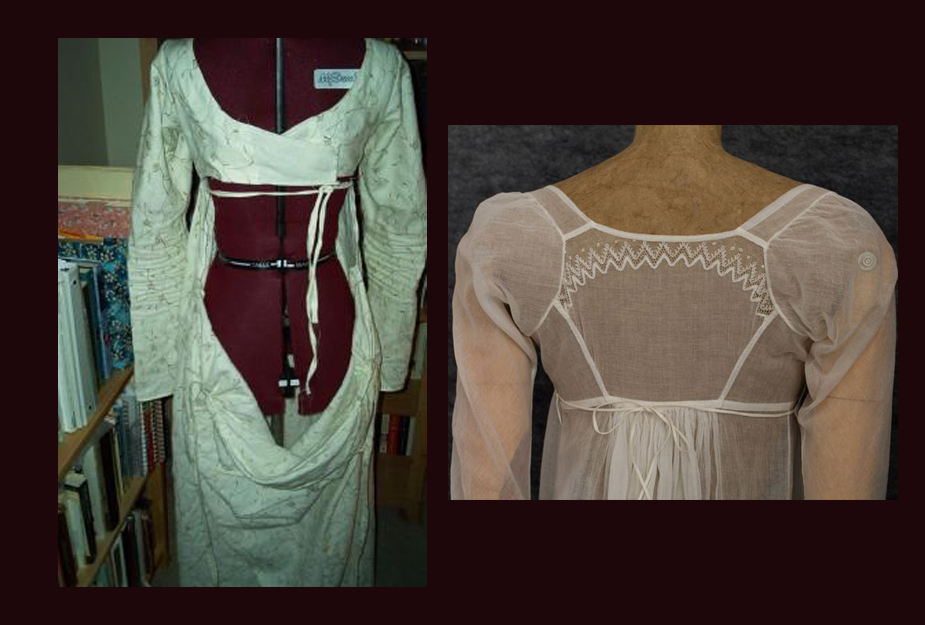
Heavier, darker fabrics were for formal… … wear. Wool, velvet, & heavy cottons were favorites in cooler climates too. Towards 1810, more decoration was added.
(photo: Regency Formal attire)
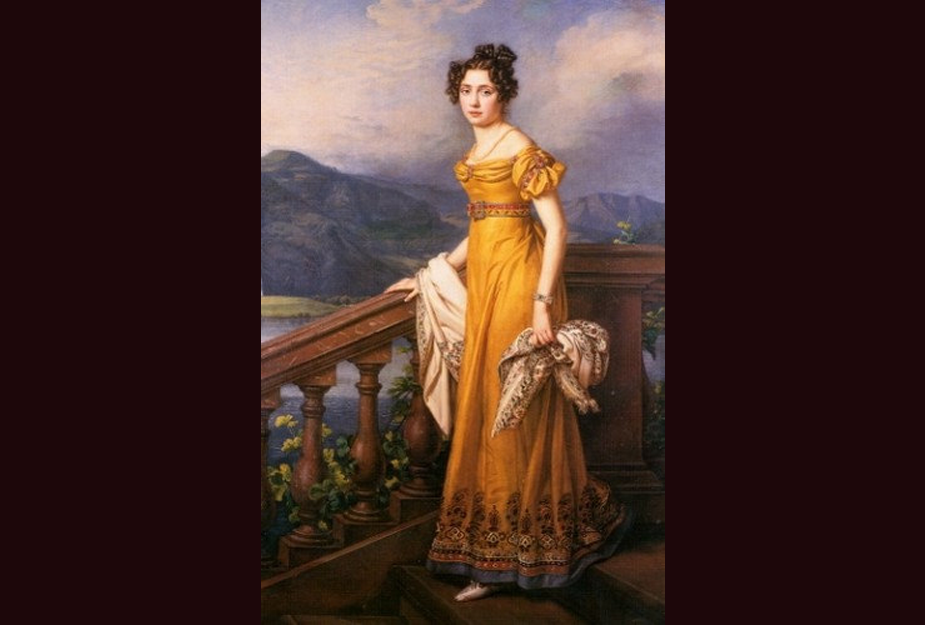
Improved communication in the world… … of the newly founded United States and Europe during the 1790 to 1800 era, opened up the eyes of women worldwide.
Fast ships (thanks to the improvement of the steam engine), mass produced printed news (thanks to improvement of the printing press), and more and more travelers going outside their own country (thanks to excess in productivity that allowed more persons leisure time) meant more information was being exchanged between people worldwide.
Women in England were talking about what the Greeks and Egyptians were wearing.
(sketch: a busy London harbor in about 1800)
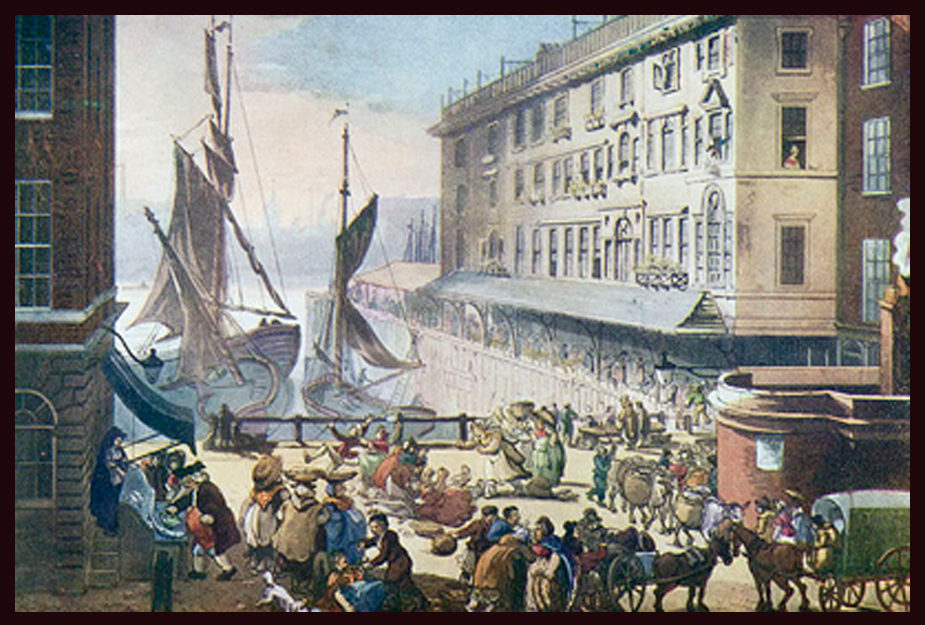
Hanging out in coffee houses… … was a big way to share fashion news from around the world… if you were a man in the late 18th century.
(sketch: English 1800 coffee house)
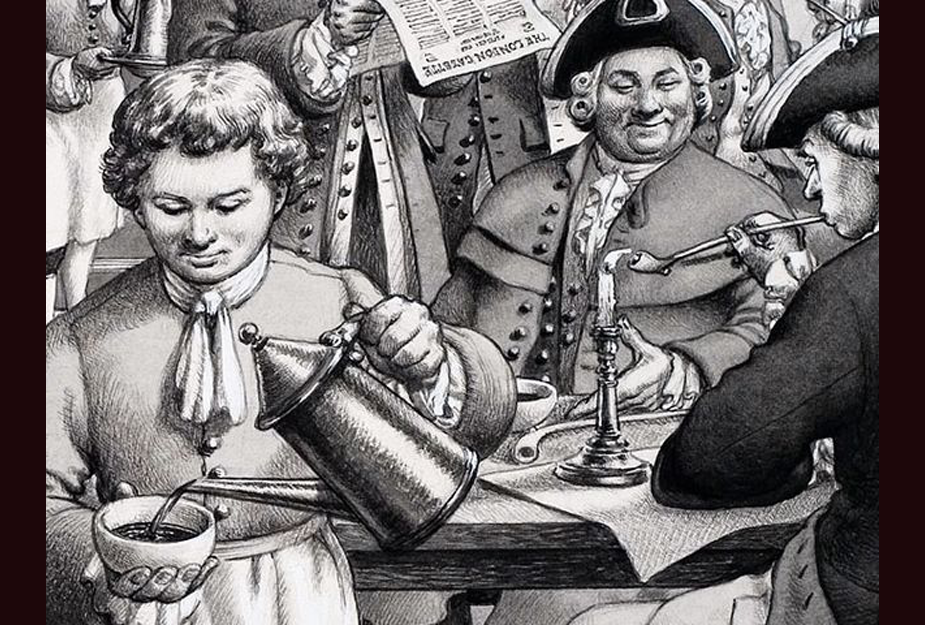
Women also traveled… … in coaches to make extended visits to friends to gossip about the latest news around the world. Word of mouth was a key way for information to spread in the Regency era.
(photo: 1800’s English news flyer advertising coach services for hire. A sign of wealth was to own your own “coach and 4” – meaning your own 4 horses to pull the coach and liveried (in costume) footmen, coachmen, and drivers)
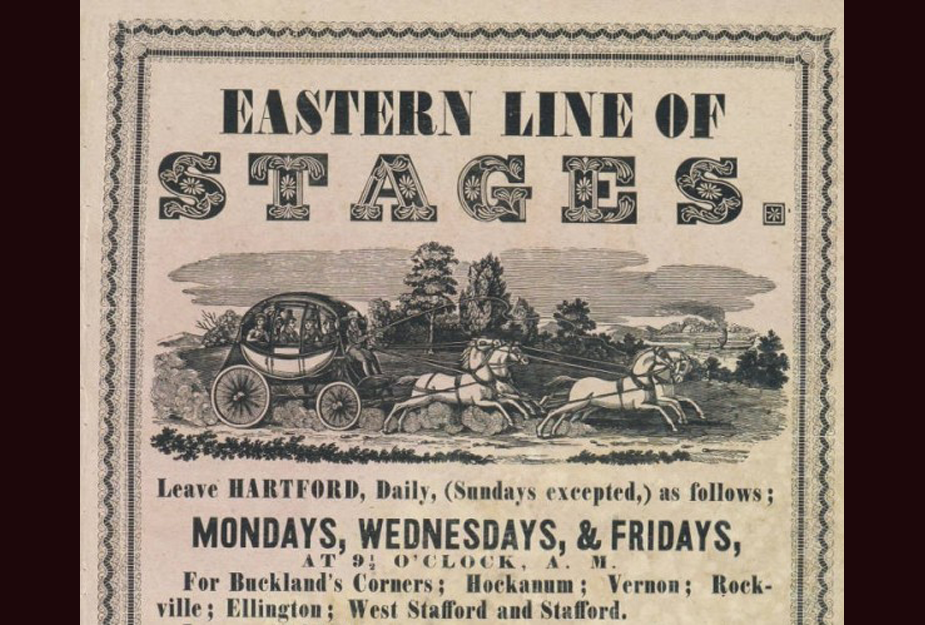
Carnival! Every February & March in many places in the world, “Carnival” takes place. This is the season before the Christian season of Lent. Rio de Janeiro & Reufe, Brazil, Venice, Italy, and Columbia hold the largest celebrations.
Wearing costumes, historically the festival was to express social unity. Masks hid the identity & social class of the wearer, so that for a brief time, everyone was equal.
(photos: Carnival 18th century (right), and today (left))
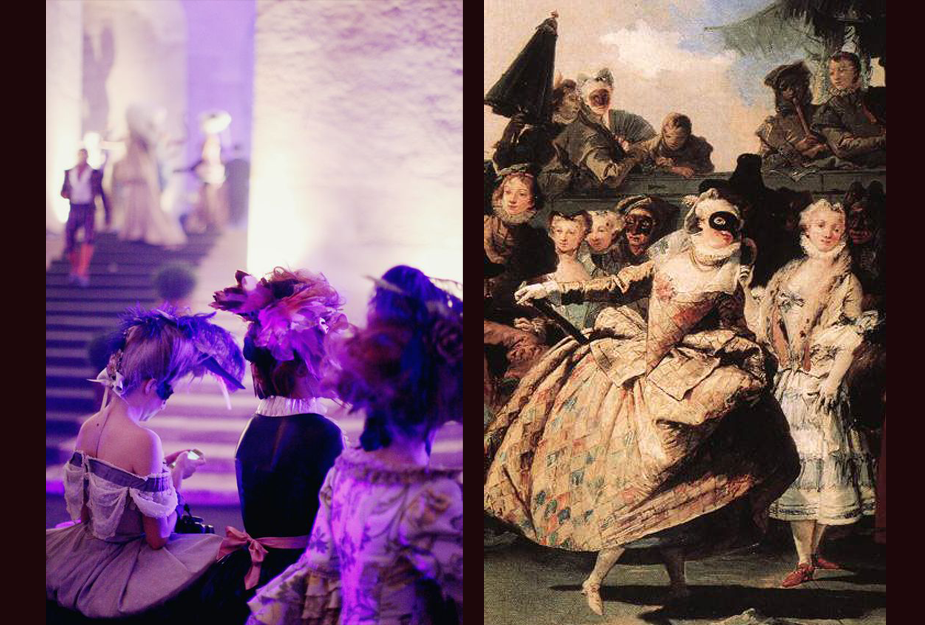
More Carnival! Carnival is celebrated by many in consuming alcohol & food. Grotesque costumes emphasize the body in a way that “reverse” the “rules” of every day living.
Villas & estates are rented out for huge, elaborate parties & balls. If you travel to
Venice at this time, you are expected to wear some sort of costume or mask. Even the police wear costumes with their uniforms.
Carnival is a costume designer’s dream.
(photos: Store window in Venice selling Carnival apparel; modern day Carnival parade of costumes)
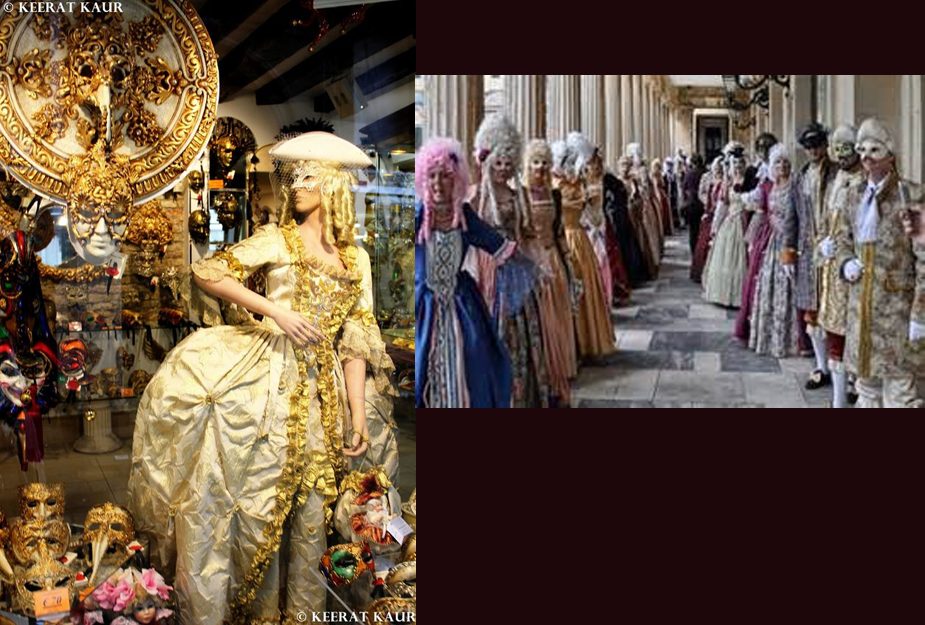
And… More Carnival! Notice how similar these costumes are to our authentic reproduction garments. Many seem to represent the most dramatic part of the Georgian/Colonial era of the 18th century (1740-1770) – with huge paniers, elaborate decoration, & headpieces.
(photo: modern feature costume based on 18th century fashion (left); sketch of 18th century revelry (right))
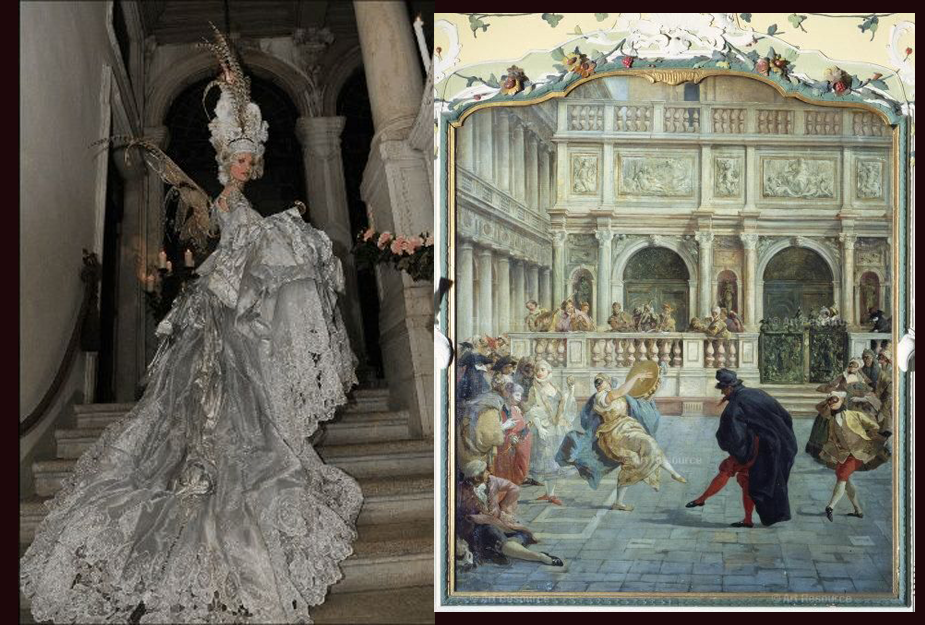
Yet MORE Carnival (can you really get enough?) Like all eras we discuss, what was going on in the world affected even the fashion of Carnival. Carnival was affected by politics & conquer – it started & stopped depending on who was in charge of a country; e.g. Germany had a huge Carnival celebration in Cologne, but when France had control of Germany in the early 1800’s, the french king cancelled it.
In other countries, since it was largely based on Catholic traditions, the rise & fall of Catholicism was also the rise & fall of Carnival, although this was not a firm rule, as many Protestant countries historically & currently held/hold the festival.
(photo: A modern Venetian Carnival Ball held in a rented private estate. Note how the costumes are contemporary versions of historical mid-1700’s ensembles – the difference being largely methods & materials used in construction.)
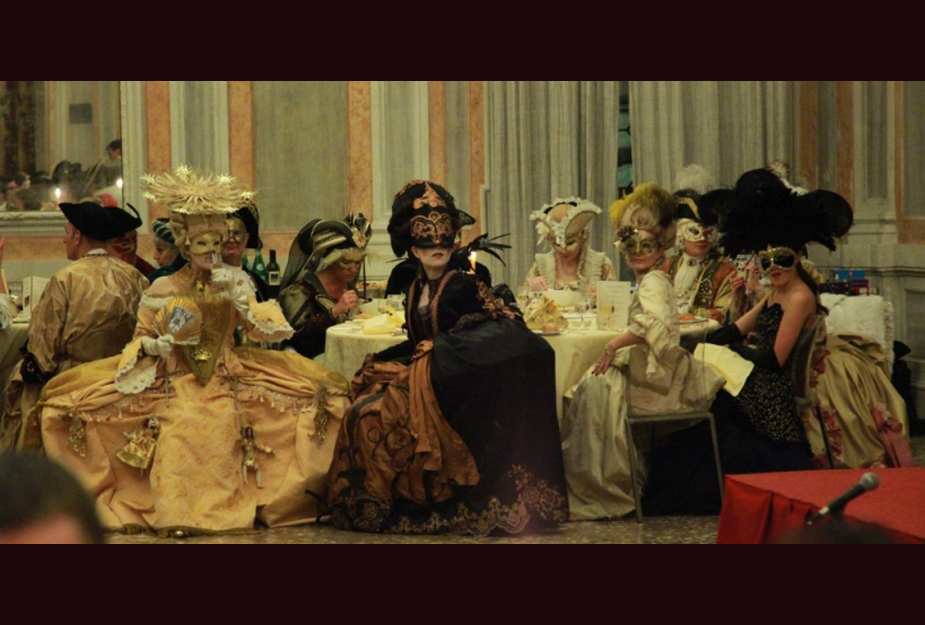
Scientific discoveries influenced Regency fashion In 1748, excavation of the ruins of Pompeii, Italy began. With improved communication worldwide due to fast ships, the ability to travel, & printed news, women embraced new discoveries.
From 1790 to 1815, this thirst for knowledge about countries such as India, Greece, Italy, & Egypt in particular, had the women of France & England – leaders of American fashion – copying ideas from these ancient & modern cultures.
(sketch: Pompeii excavation begins.. some sources say 1738; others 1748.)
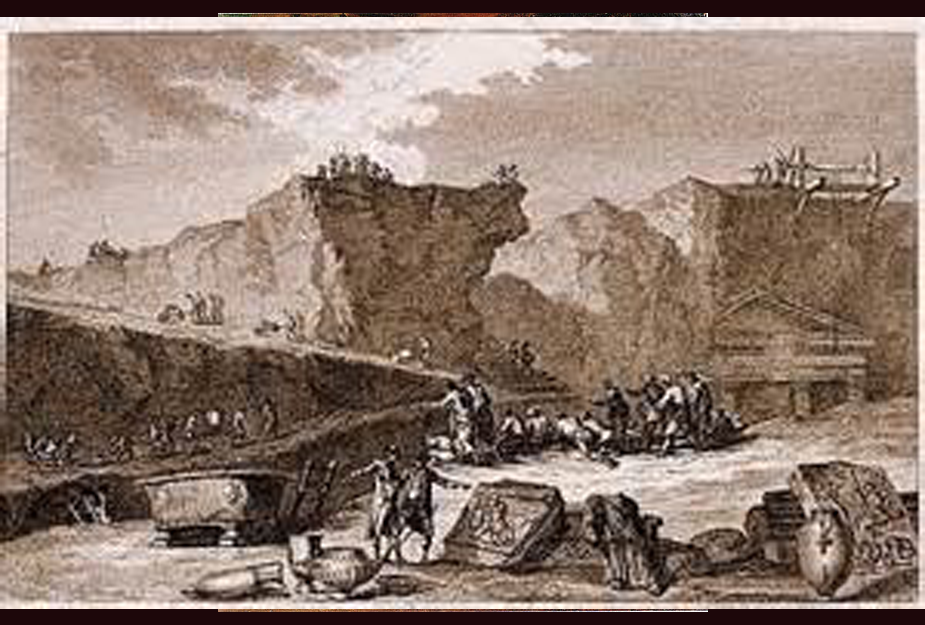
Archaelogy affected 1800’s Fashion Here is a photo of a Pompeii, Italy street after excavation & renovation. Women of the Regency era were intrigued by ancient civilizations & their fashions & details.
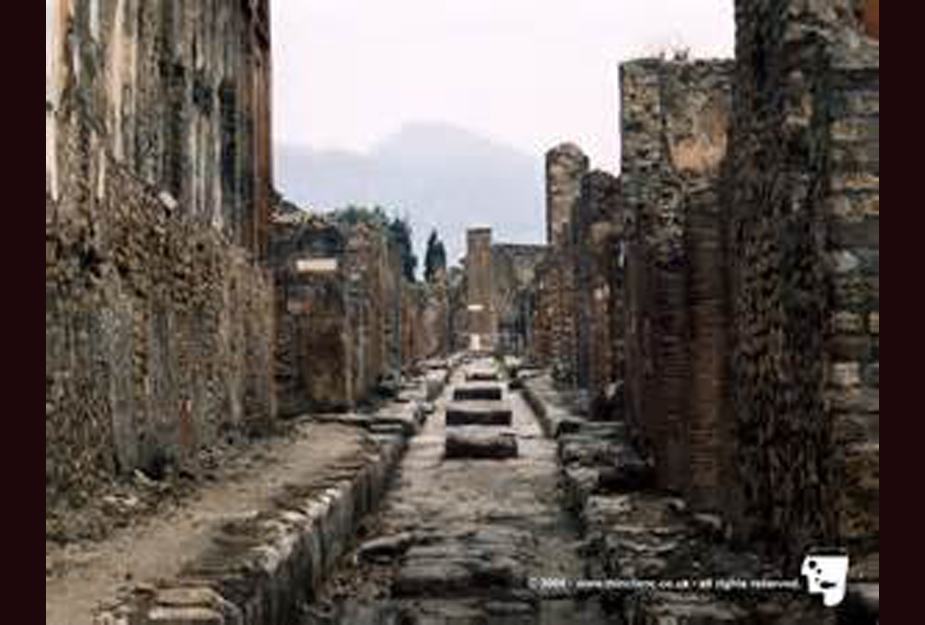
Women in 1800 were obsessed with Greek Fashion The loose, draped style depicted in ancient Roman and Greek artifacts, sculpture, & architecture was perfect to adapt to the “Gaulle” (loosely draped chemise-like dress) Marie Antoinette had introduced about 10 years earlier.
(photo & sketch: ancient Greek styles, one of many caryatids on a Greek building)
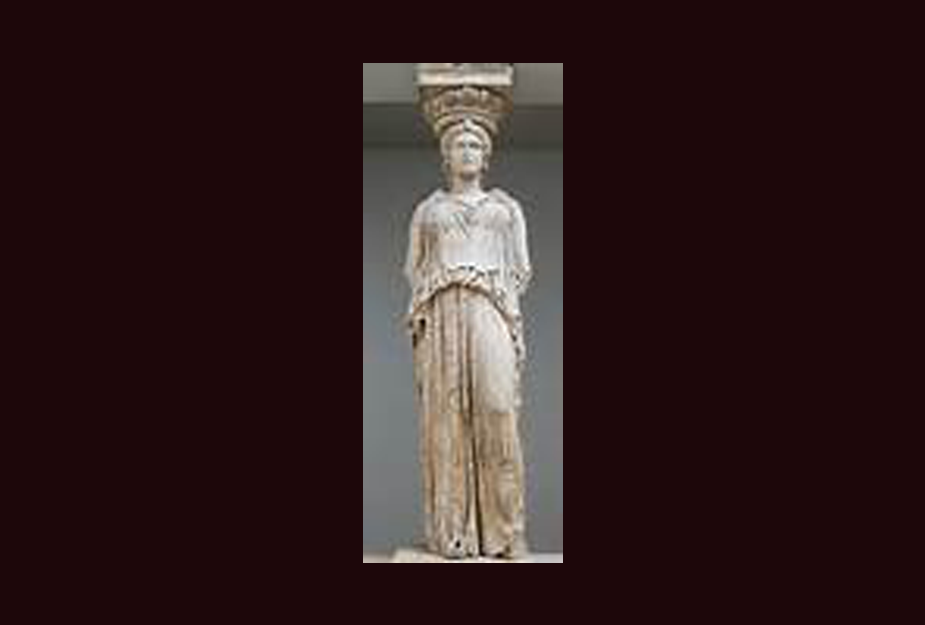
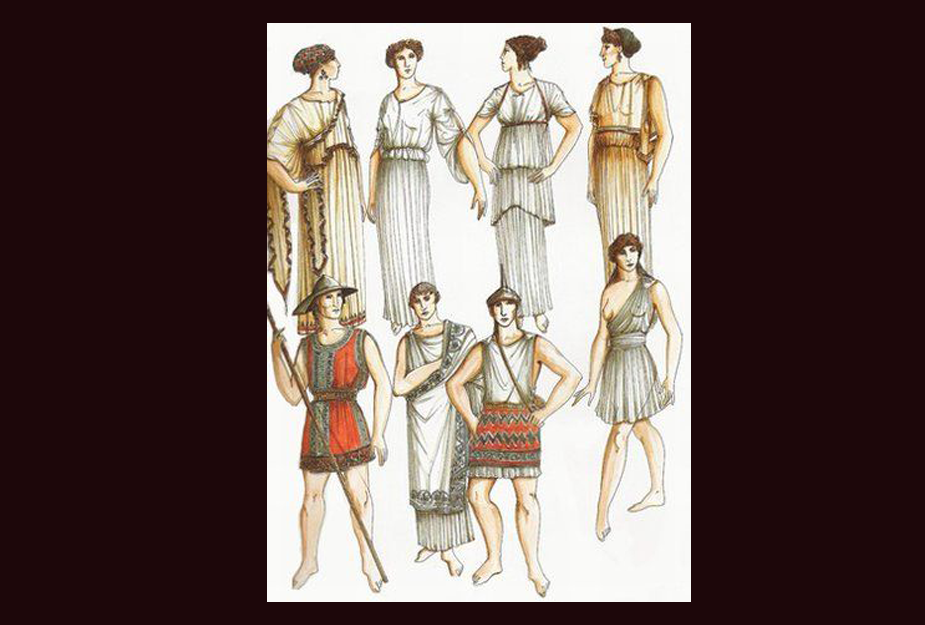
Regency fashion “Goes Greek” The earliest Regency fashion era (1800-1803) was based on Greece. The very lightweight, white, muslin dress was almost an exact replica of statuary & iconic images of the ancient Greeks & Romans.
(photo: (left) ancient Greek statue; (center) 1799 Greek influence Regency fashion plate; (right) Greek Caryatid from ancient architecture)
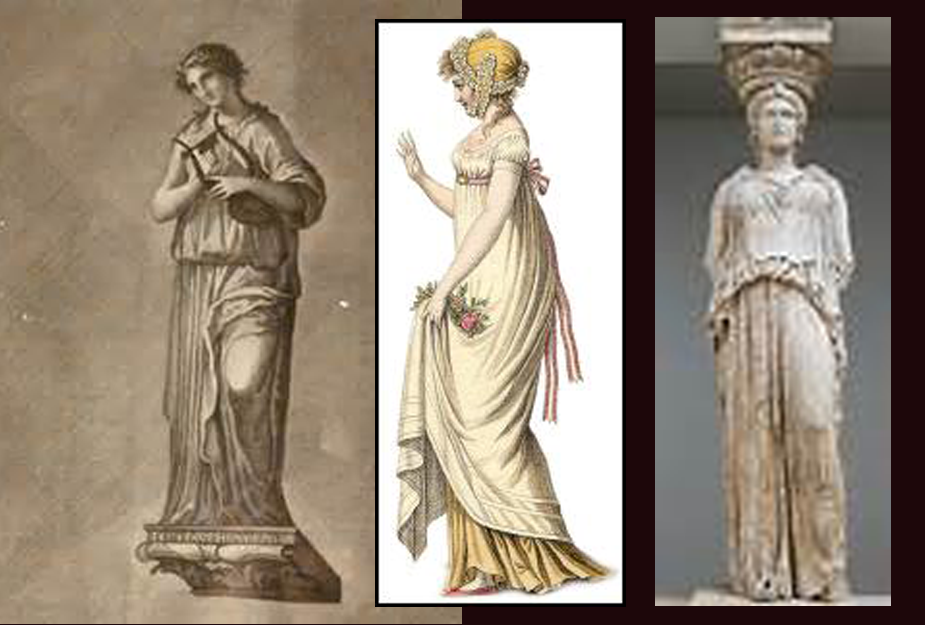
Greek & Roman Style Reigns in 1800 The “First Era” of Regency, technically 1794-1804 (although there were “crossovers” from earlier & later styles), emphasized ancient Greek & Roman fashion.
This incorporated the “Little White Dress” of the draped statues, “Chemise a la Reine” that Marie Antionette had introduced when she escaped to her “Petit Hameau” to wear what was basically her underwear, & the ideas brought from Indian and West Indies fashion by Parisiennes living abroad.
Combined with the availability of the white muslin fabric, new rinses for keeping white clean, & the influence of ideas regarding simplicity & the “country life”.. women around the world embraced the style…
… until it got a little chilly..
(sketch: 1st Regency Era women dress as early Greeks & Romans at home & at formal occasions)
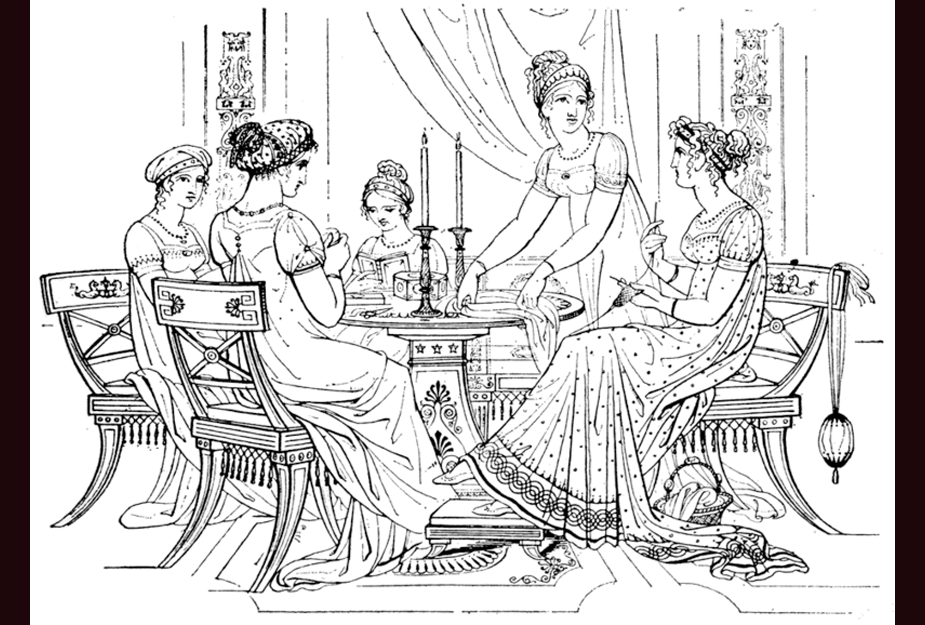
(feature photo: Technology of the early 1800’s: frogs’ legs; below: Le Corbusier’s steam engines)
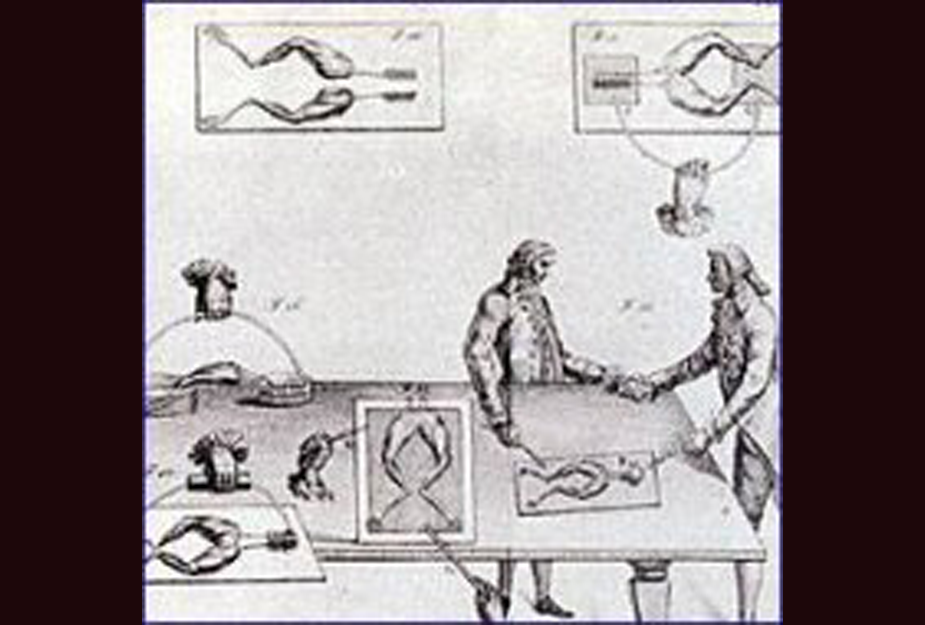
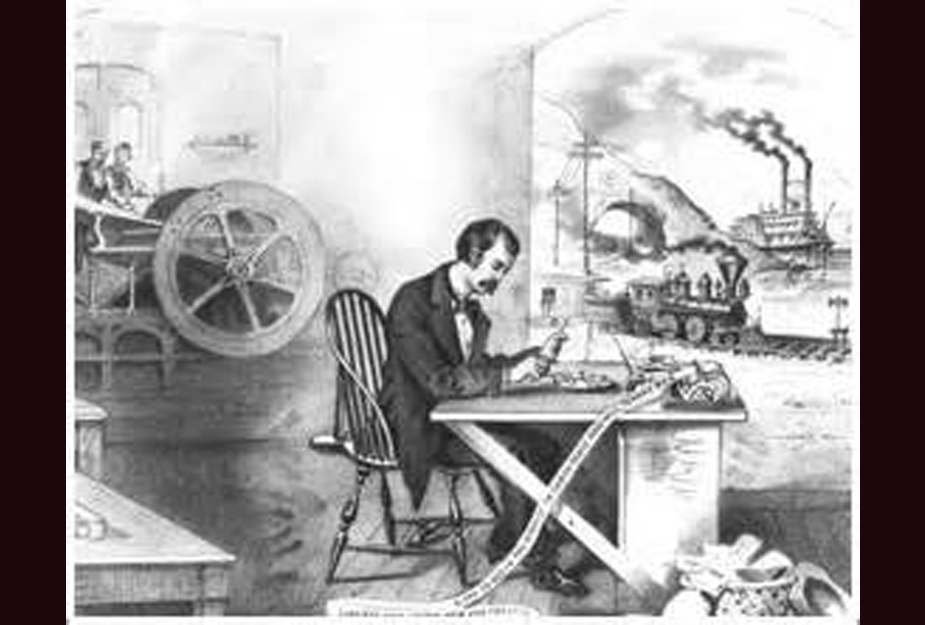
Here are some 1st Era Regency “Romans”… Notice the white draping, overlay, hair, headpieces, & footwear were like the early Greeks & Romans.
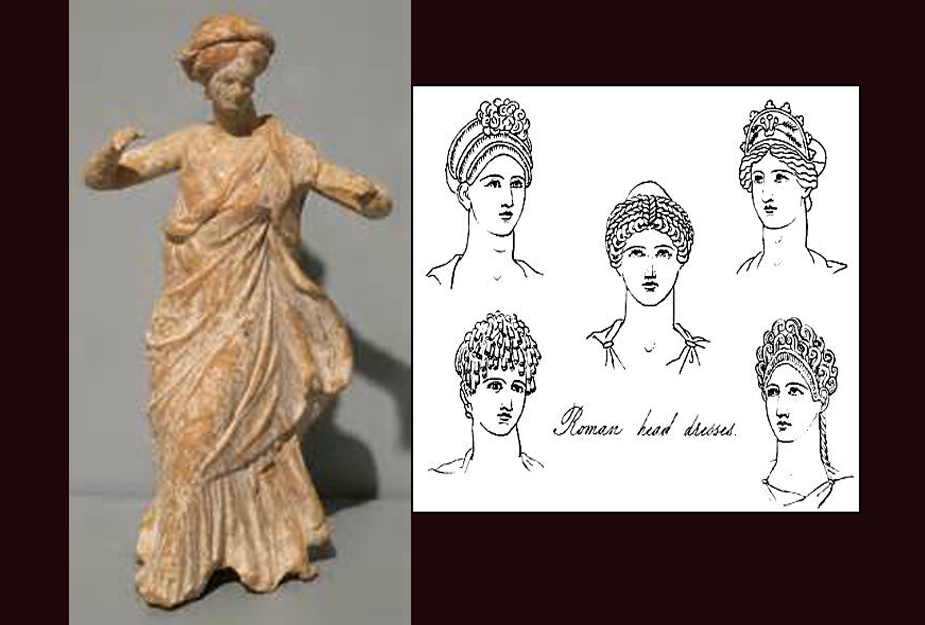
They went a little “Too Greek”… After decades of layers & layers of clothing, women seemed to be almost naked in the thin, white muslin dresses of Regency. Although many women wore full, flesh colored leggings and long stays underneath, many were actually – almost naked.
There are many cartoons & bawdy jokes about the early Regency Era starting in 1793 when the fashion was first (pardon our pun) – REVEALED.
(Sketch: from the first Regency Era, showing women who were copying the Greek style.. a little too closely according to the cartoonist, Venus de Milo in Italy, another source of inspiration in 1800, sporting similar fashion)
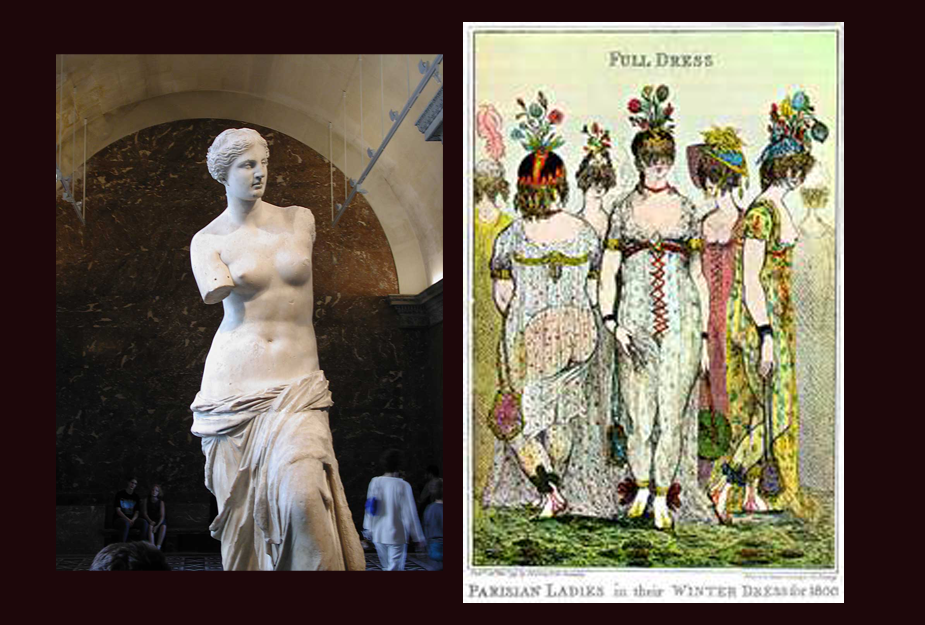
Greek influenced Regency fashion examples… … Even those well covered up during the 1st Regency Era, got a bit silly and chilly.
(portrait: 1804)
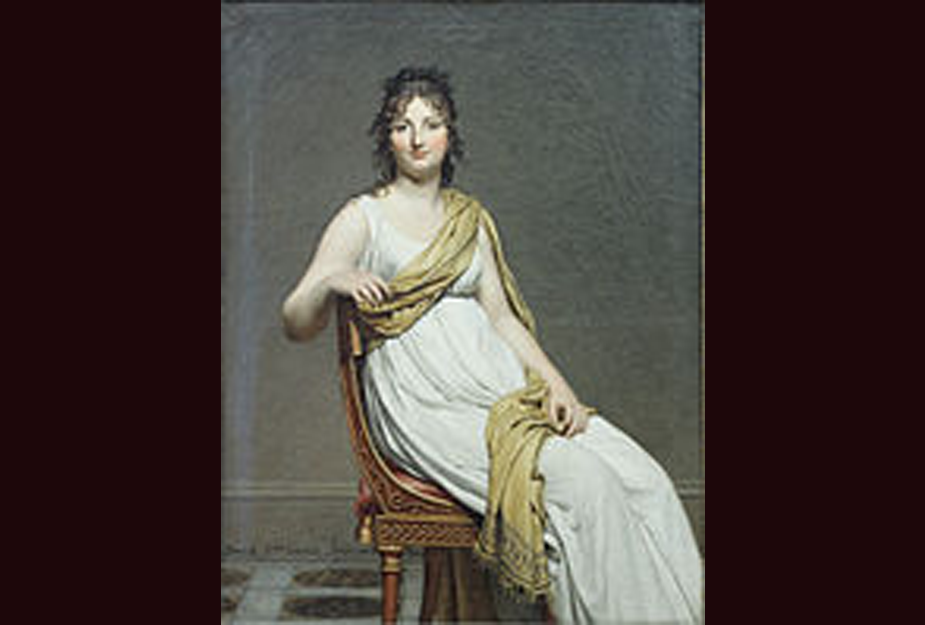
More Greek Influence An English woman from 1802. One wonders why she thinks the Greeks wore plants on their heads.
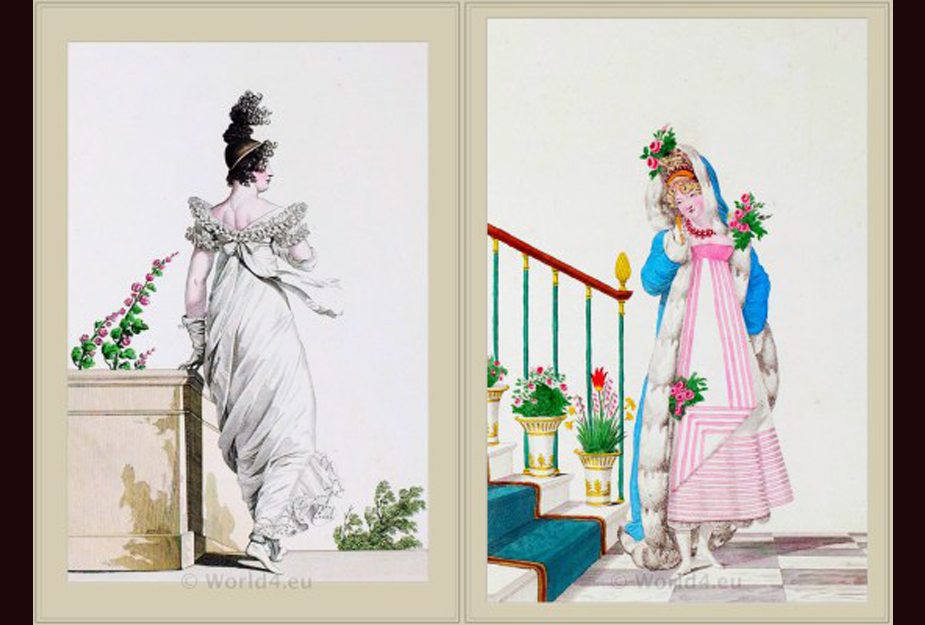
Most Women were pretty normal… … during the 1st era of Regency in 1800 Europe & United States. They got chilly in their thin cotton dresses when the wind blew, & they didn’t want to run around in public nearly naked.
These women invented the “chemisette”, or an insert to cover their bosoms for warmth & privacy.
(photos: Greek inspired 1st Era gown with chemisette; 2 oft-found chemisette designs. You can see they are still not much more than wearing a neck tie).
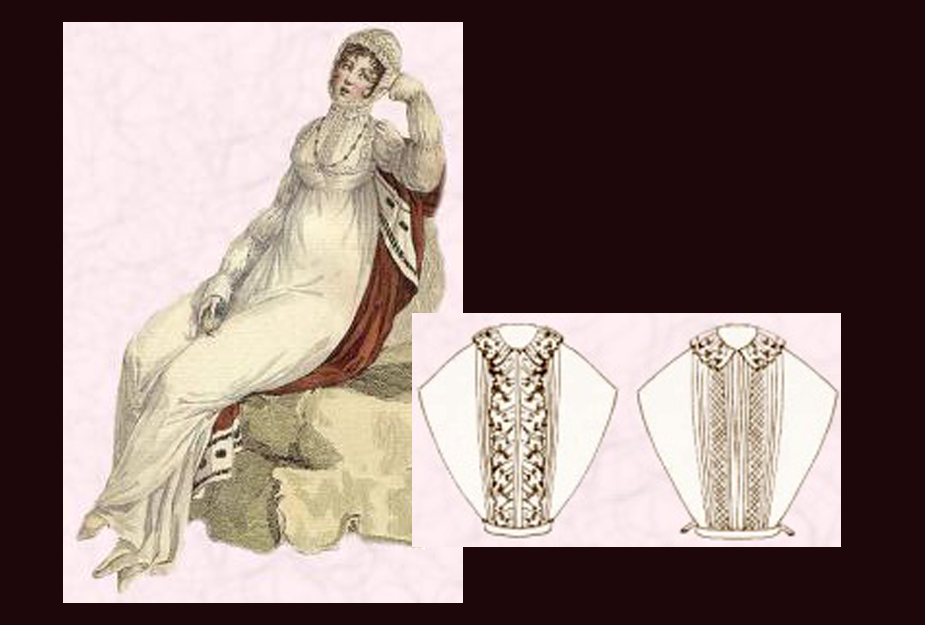
3/10/17 Revolution changes everything… … France, the fashion leader of the world in the late 1700’s, was headed for war. In the wake of the storming of the Bastille by Paris mobs, the overthrow of the National Assembly, & the Reign of Terror that sends even suspected traitors to the guillotine, French fashion, and so world fashion, would change nearly overnight.
(photo: 1793 “Reign of Terror” precedes the French Revolution. Below: Revolution begins “for real” in 1798)
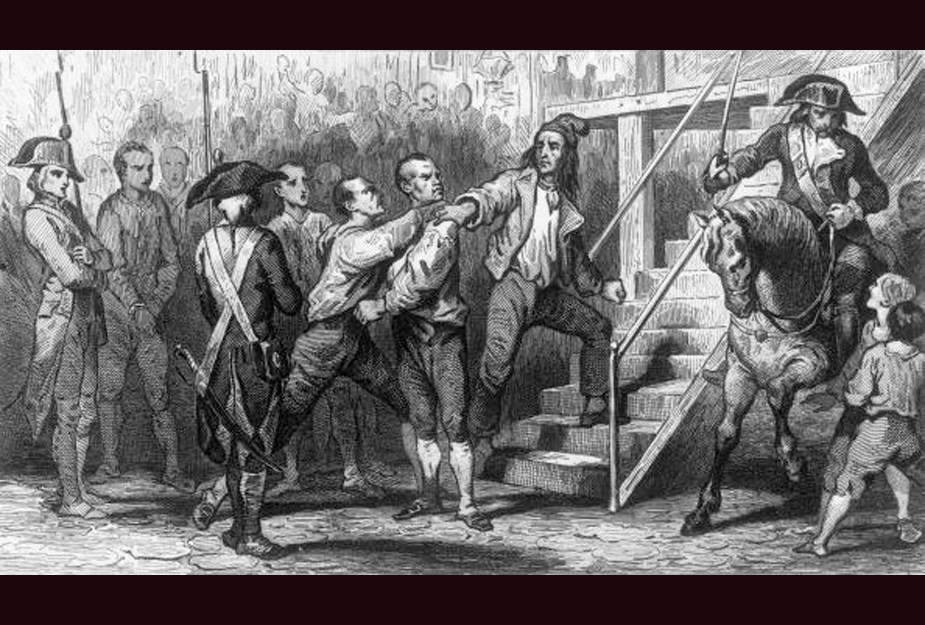
The French “Reign of Terror”.. …abruptly caused change in fashion. New ideals of free thought, influence of Marie Antoinette’s “chemise en gaulle” relaxed country style, along with ideas brought from around the world, came to a crossroads in France.
In 1793, the common populace was rising up against the monarchy. They stormed the bastille (prison), and overthrew the National Assembly (governing power). The authorities responded by putting anyone and everyone of any suspicion to death by guillotine.
People on all sides of the issue were killed by guillotine, including King Louis X!V and his wife, Marie Antoinette. Marie was only 37 years old.
(photo: The French Revolution in 1789)
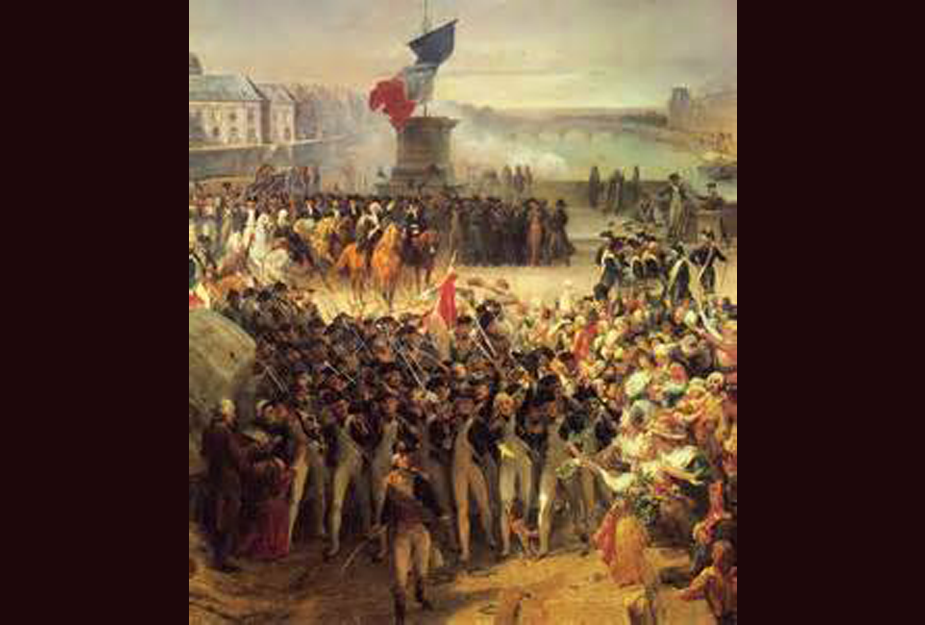
Marie Antoinette was Beheaded There are many stories & paintings of the beheading of the Queen of France in 1793. The favorite is that she wore her purple slippers to the guillotine, and accidentally stepped on the toes of the executioner, for which she profusely apologized.
(2 paintings of Marie Antoinette’s death. Below: she was only 37 at her death)
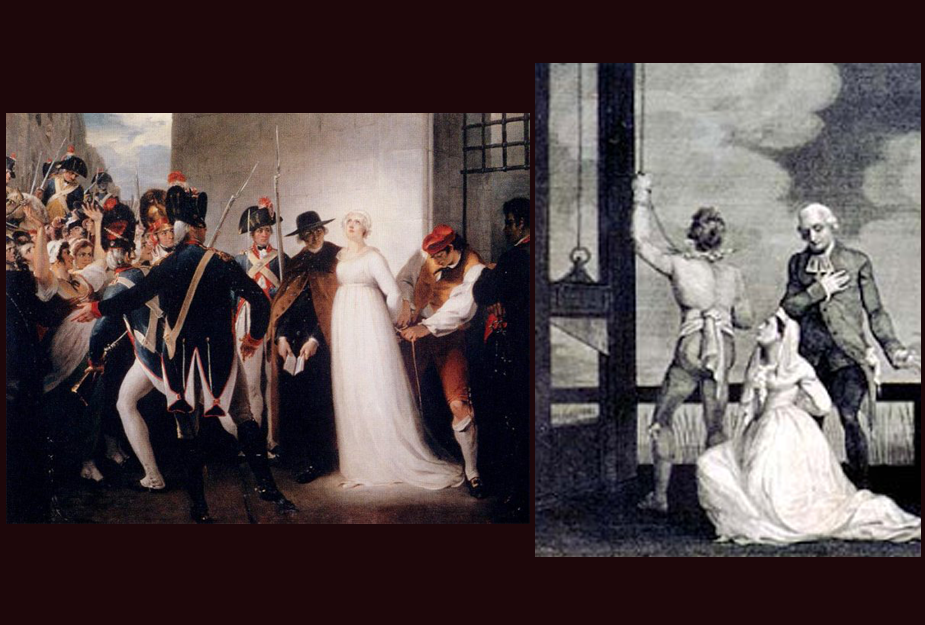
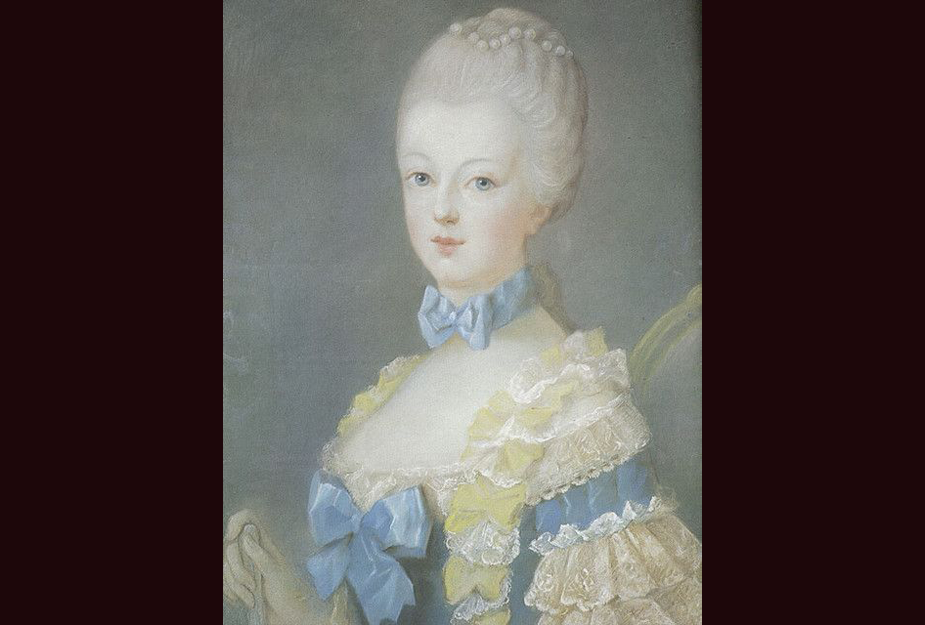
Key People & Events Forming Fashion
Reign of Terror makes the Marveilleuse
The children of nobility in France in 1794, in a manner “protesting” the conflict, created “Les Incroyables et Marveilleuses”, extreme behavior and fashion to make a political statement to their families.
(photo: the classic depiction of an “Incroyable (male) et Marveilleuse (female)”)
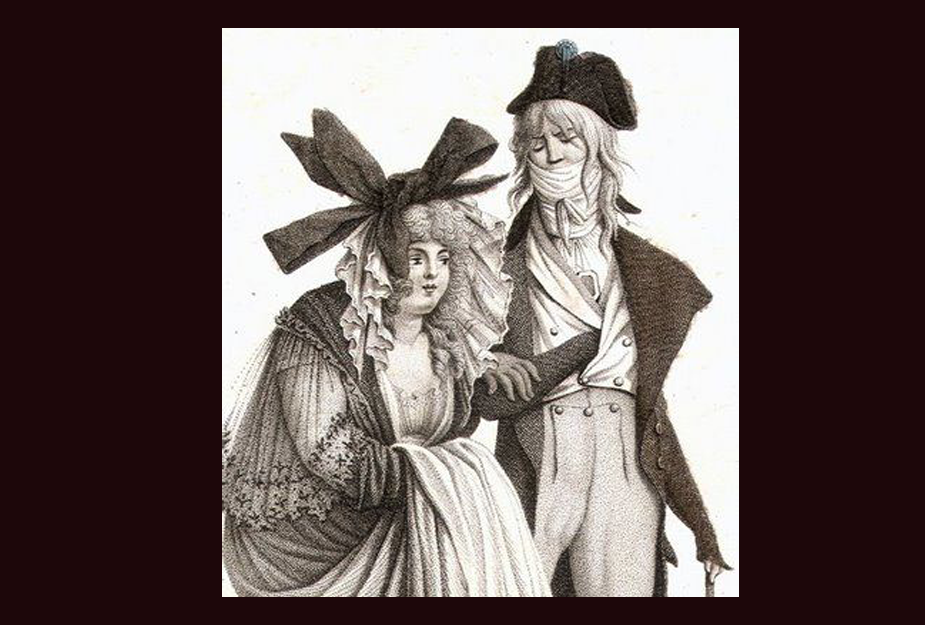
The Incroyables et Merveilleuses were an Aristocratic Subculture … in Paris during the French Directoire (1795-1799), which followed the Reign of Terror, & and entered the French Revolution.
Merveilleuses meant “marvelous women”; roughly “fabulous divas”. Possibly as a need to reconnect with survivors of those guillotined, or perhaps as a catharsis after the Terror, these young and energetic children of French aristocrats greeted the new regime with an outbreak of luxury, decadence, and silliness.
They held hundreds of “bals”, & started fashion trends in clothing with mannerisms that were exaggerated, affected, and considered “effete” (decadent & self indulgent).
(portrait: favorite depiction of typical Marveilleuse (left) and Incroyable (right) of 1795. These two are rather sedate compared to most at the time)
![]()
They avoided “R”.. .. Merveilleuses and Incroyables often removed the “R” to become “Meveilleuse et Incoyable” because they wanted to “get the R (Revolution) out of their lives”.
(painting: “Merveilleuse avec Nymphs” Daily life for a Meveilleuse was almost as crazy as their parties.)
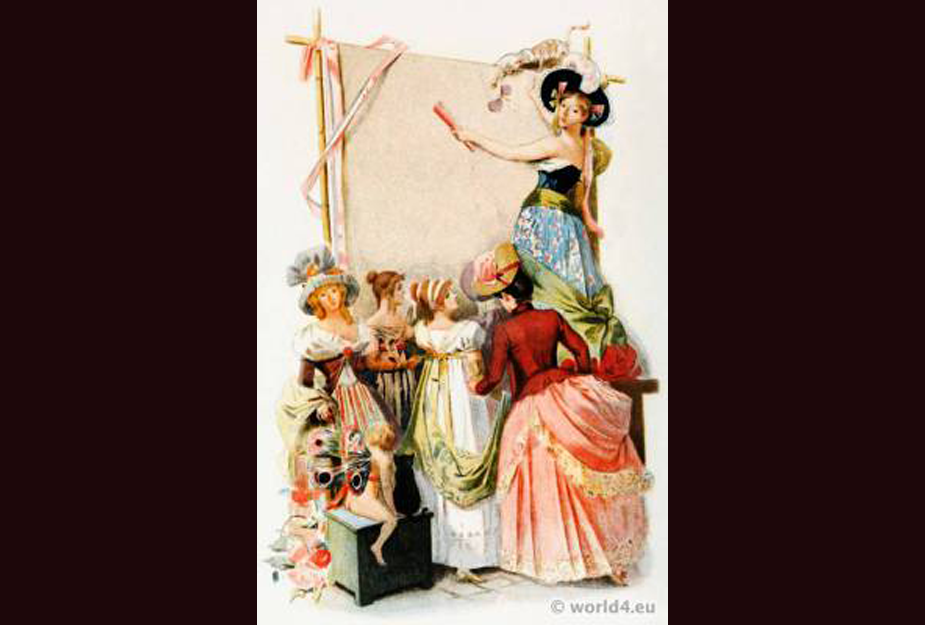
“Bals des victimes” were given by Incroyables… … the young “Merveilleuse et Incroyables” gave lavish balls and parties for the public. They greeted each other doing violent movements of the head as if it was being decapitated, & danced in mourning dress, or wore black armbands.
A ball held at the Hotel Thellusson in Paris, restricted the guest list to the grown children of those who had been guillotined.
(sketch: typical dress to go to “le bal des victimes”. Note the significant red detail which was common on the women representing dripping blood, and the high collars and cravats on the men to “hide their necks”)
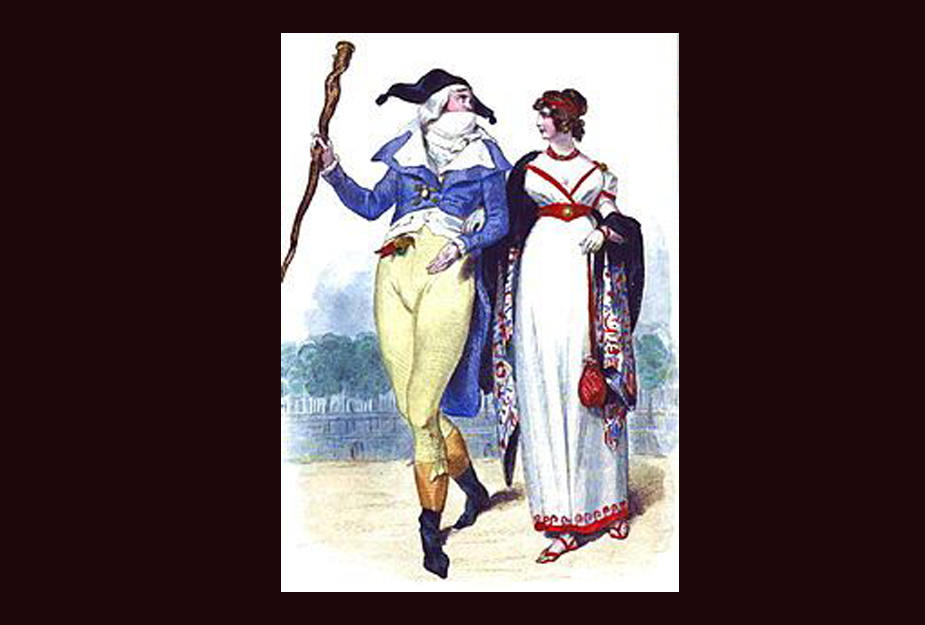
Paris erupted in a furor of pleasure-seeking… .. & entertainment, the day after Robespierre, a leader of a faction of conflict causing the Reign of Terror was executed.
Ornate carriages appeared on the streets, & there were masters & servants in France again. Theaters thrived, & popular music satirized the excesses of the Revolution. One popular song called on people to “share my horror” & send “these drinkers of human blood” back amongst the monsters. Its lyrics rejoiced that “your tormentors finally grow pale at the tardy dawn of vengeance”.
(sketch: “Living With Jane”, Incroyables wearing their weird fashions, harrass women (Merveilleuses) on the streets of Paris)
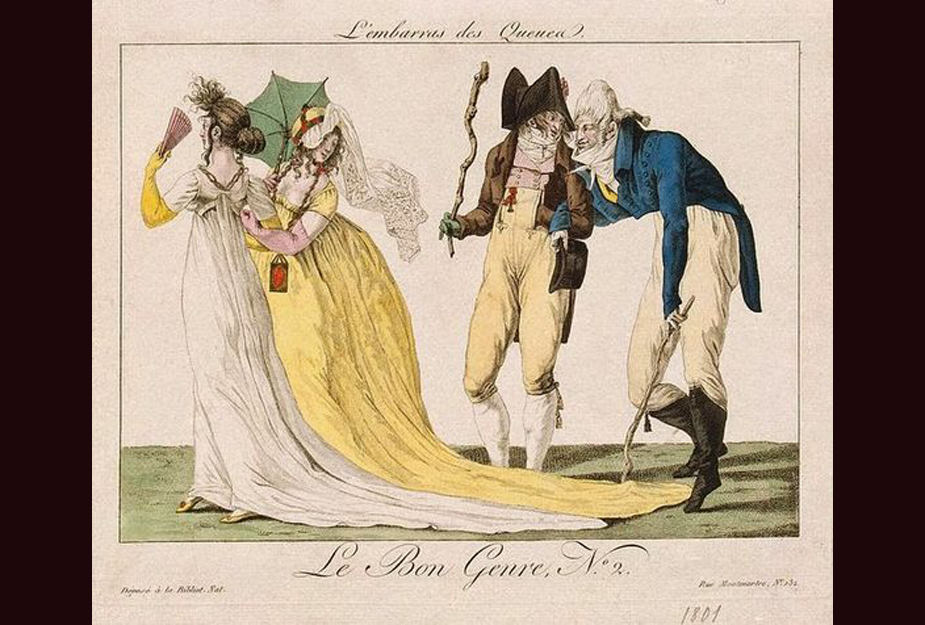
With dresses & tunics so revealing they were termed “woven air”… .. the Merveilleuses scandalized Paris as they modeled themselves after the ancient Greeks and Romans. Gowns displayed deep cleavage, & were too tight for pockets. To carry a handkerchief, the ladies carried small bags called “reticules”.
(painting: Calling themselves the “Princesses”, a clique-ish group considered themselves the leader of the Merveilleuse movement, and would languish in splendor between “bals” and their parading in the streets)
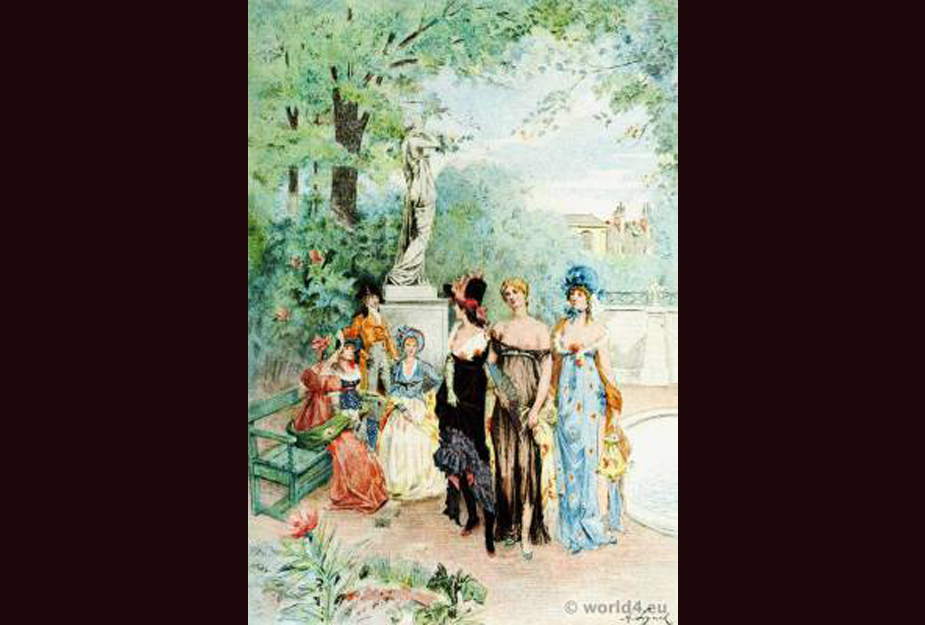
Blonde Wigs were a favorite of the Merveilleuses… .. because the Paris Commune during the Reign of Terror preceding the French Revolution had banned them. They also wore wigs in black, blue, and green.
(sketch: “Little Miss Prattle talks to Doctor Double Fee about her hair”)
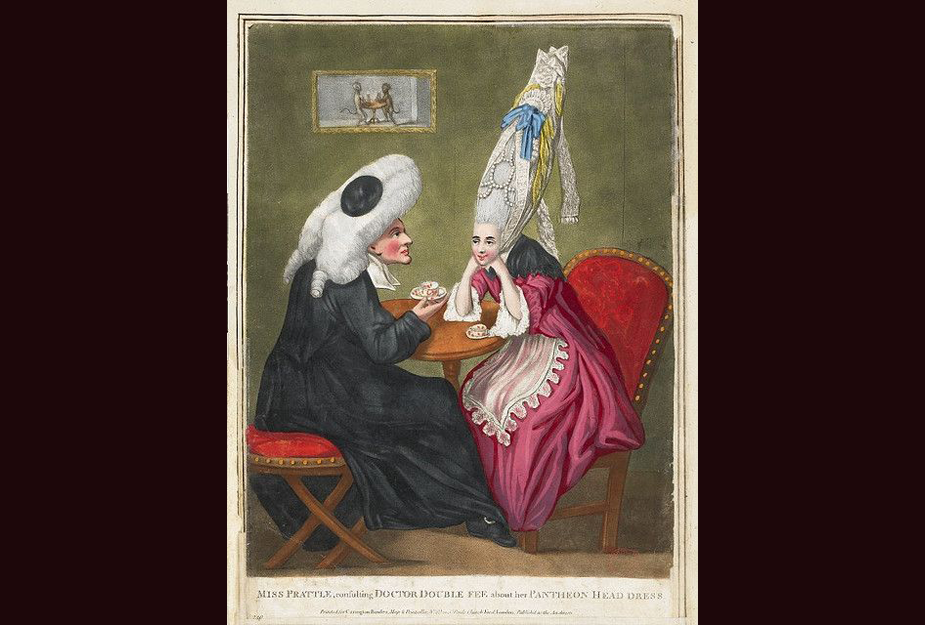
With expensive rings on the toes of her bare feet… .. one of the head “goddesses” of the Merveilleuses was Theresa Tallien, known as “Our Lady of Thermidor”.
Other famous leaders included Jeanne Francoise Julie Adelaide Recamier, & two very popular Creoles: Fortunee Hamelin and Hortense de Beauharnais.
Hortense, a daughter of the Empress Josephine, married Louis Bonaparte (Napoleon’s son), & became the mother of Napoleon III, who would rule France in the 2nd Regime.
Fortunee was not born rich. She became famous for owning “salons”, and having a string of prominent lovers.
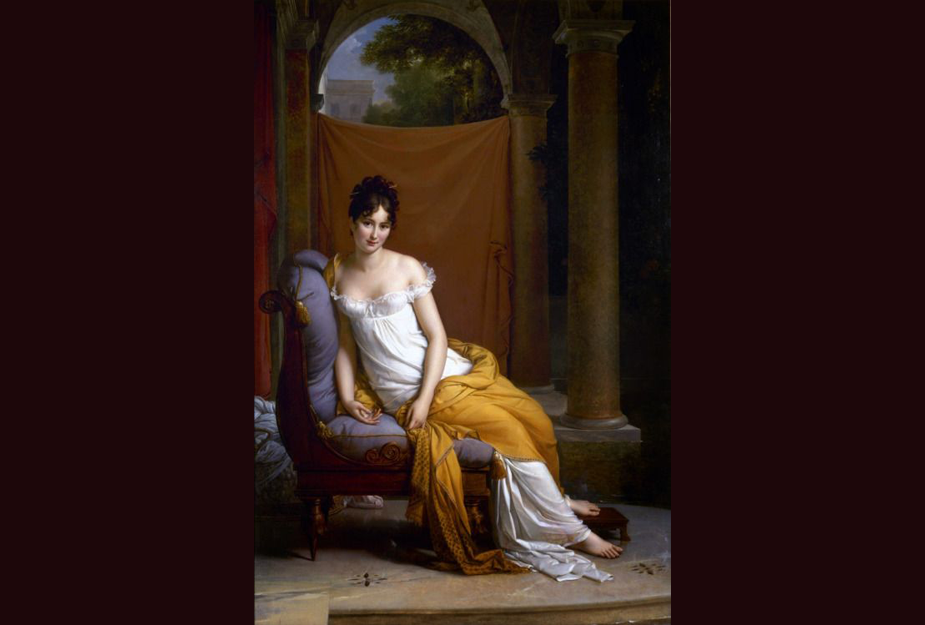
Enormous Hats, Curls… … and Greek-style sandals were all the rage for “Les Meivelleuses”. Sandals were tied above the ankle with crossed ribbons or strings of pearls.
Exotic & expensive scents fabricated by houses like “Parfums Lubin” were worn as indicators of social station.
(paintings: Merveilleuses in public late in the era)
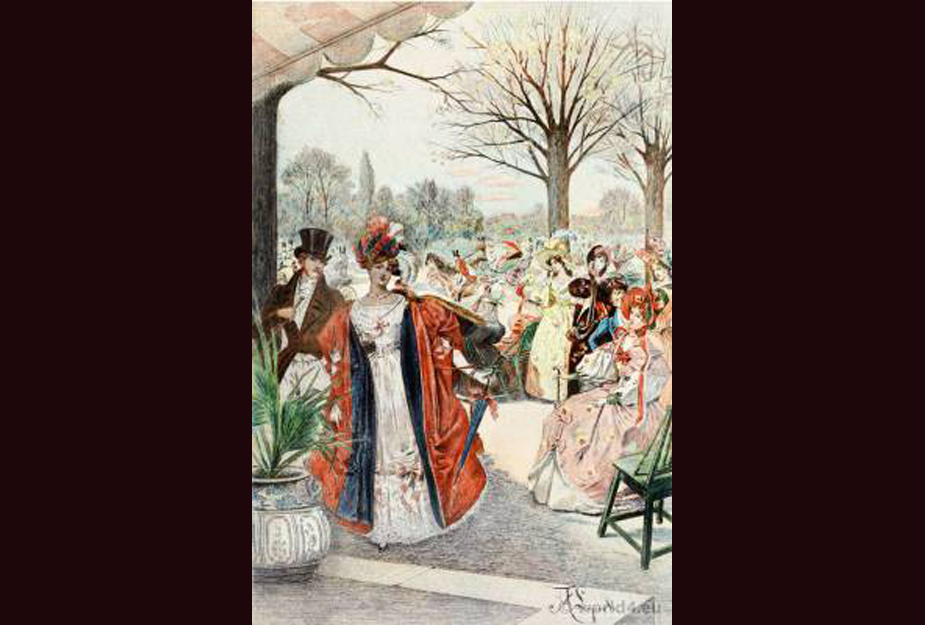
erveilleuse dresses were called Flora & Diana… .. after the Roman deities: tunics were styled a la Ceres or Minerva.
(sketch: “Mocking the New Regime”; new fashion meets what they considered “old fashioned” in Paris 1794)
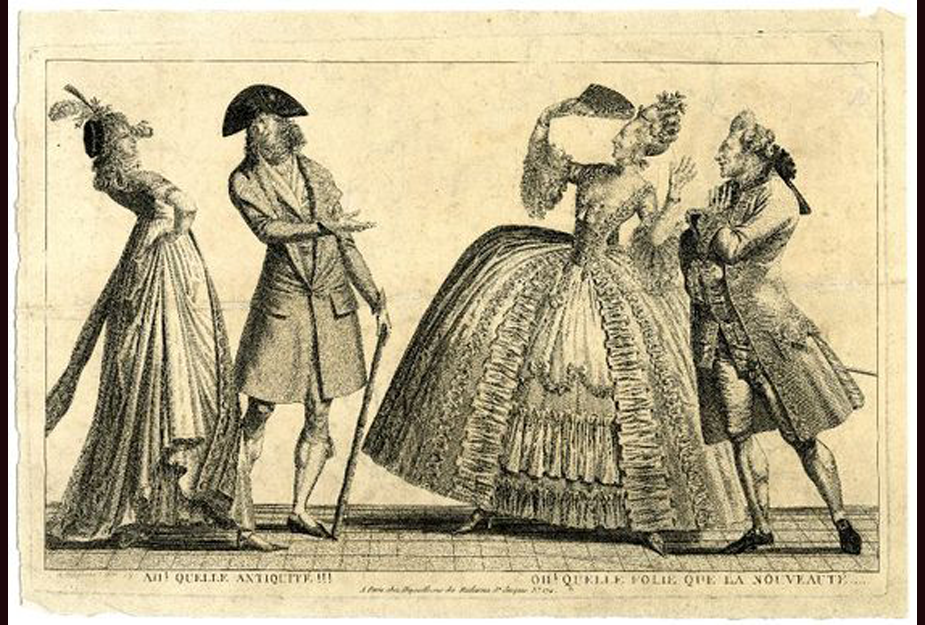
Incroyables, the male counterpart, wore eccentric outfits… .. large earrings, green jackets, wide trousers, huge neckties, thick glasses, & hats topped by “dog ears” with their hair falling over their ears. Sometimes they pulled their hair up in back using a comb to imitate the hairstyles of the condemned. Some sported large monocles, & they frequently affected a lisp and stooped over like hunchbacks.
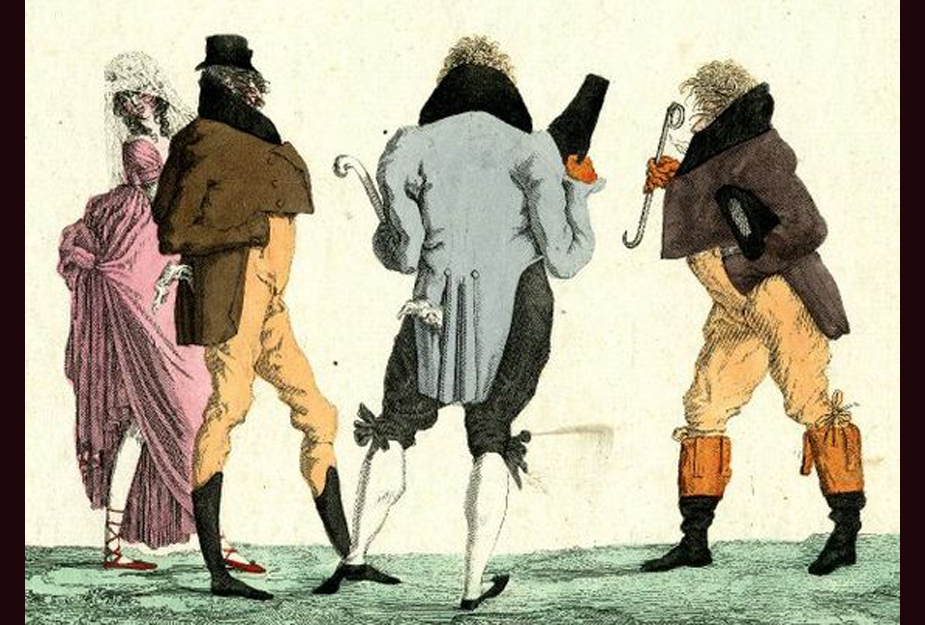
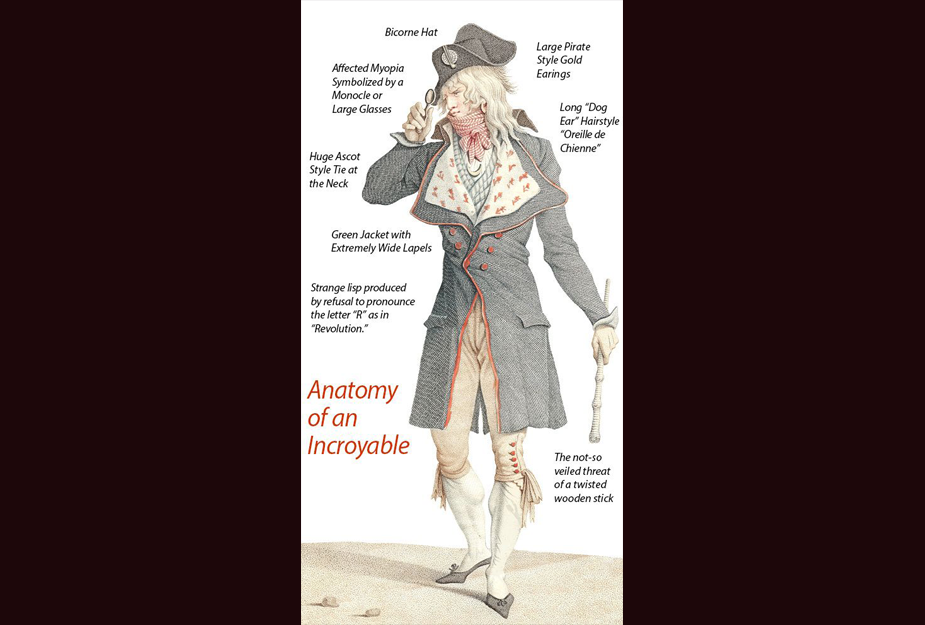
The musk fragrances of the Incroyables… …earned them the derogatory name “Muscadins” among the lower classes – a name already applied to a wide group of anti-jacobins.
They wore bicorne hats and carried bludgeons, which they referred to as their “executive power”.
(painting: Muscadins on the streets of Paris in about 1794)
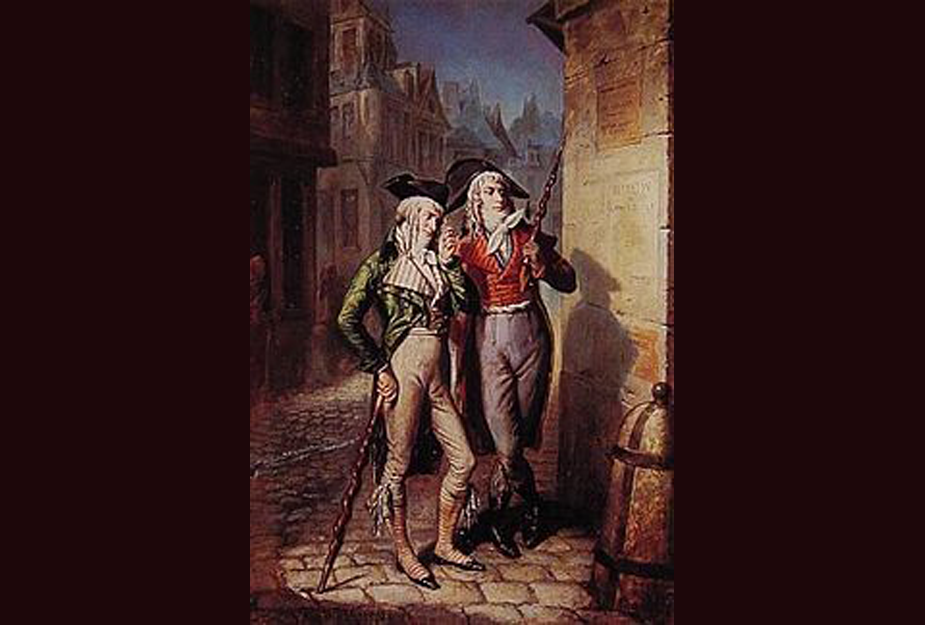
Juliet Recamier was a Merveilleuse.. .. or “Marvelous Woman”, who ruled the live fast, die young social whirlwind that took over the salons of Paris after The Terror.
Juliet, Theresa Cabarrus Fontenay Tallien, & Josephine de Beauharnais (later Empress of France), barely survived the Jacobin regime. It was partly on Thersa’s behalf, with whome Tallien had been conducting a torrid affair, tha he spearheaded the take down of Robespierre which ended The Terror.
The a la Grecque style which typified the group had them allegorically leaving the painter’s studio in dresses dampened to enhance their cling, and without petticoats.
“Il n’est pas possible de s’exposer plus somptueuesement!” wrote Charles Talleyrand (“It is not possible to exhibit oneself more sumptuously!”)
(portrait: Jeanne Francoise Julie Adelaide Recamier.. again.. this time known as “Juliet”)
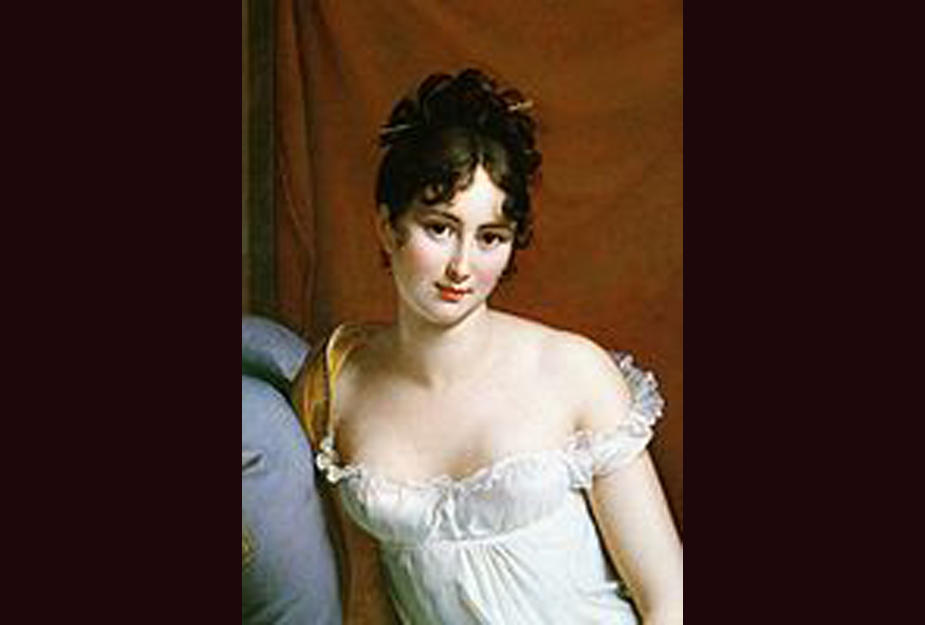
Muscadin was the derogatory name the lower classes gave… .. the Incroyables, young bourgeouis men & women who dressed up in protest of the French Reign of Terror.
The English counterpart, & having its root in the 1770’s, at the time America was in its Revolution were the “Dandies”
(sketch: “Blinded by Buttons”, 1775 joke about Dandies)
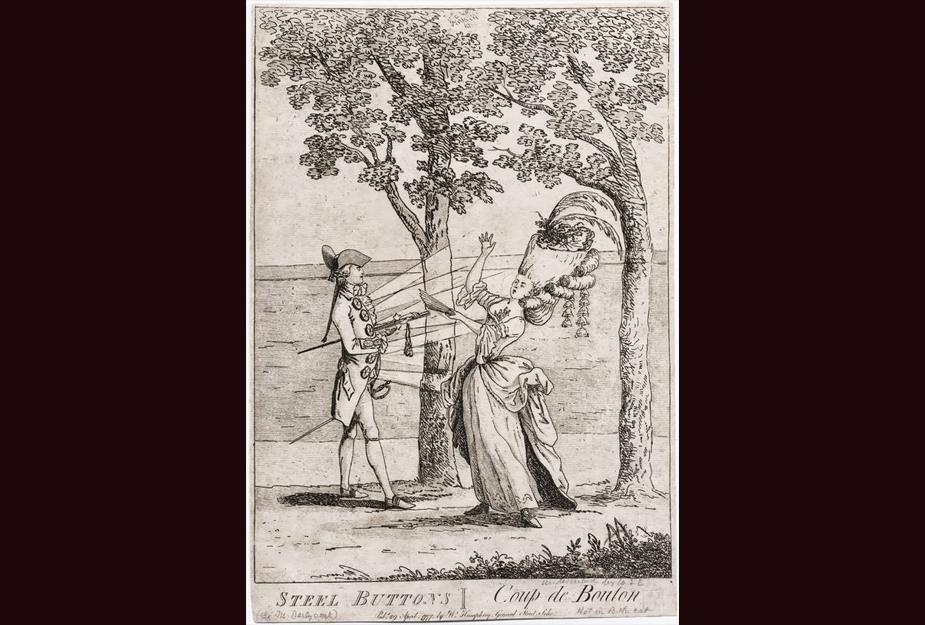
Muscadins were also called Macarons… … the original being street “dandyish” street gangs roaming Paris. They became known as the “White Terror”, a backlash against jacobin oppression.
They roamed the streets drinking, toasting the monarchy, & lashing out at patriots with sticks AND THEY LOOKED FABULOUS DOING IT.
(painting: a “Dandy”)
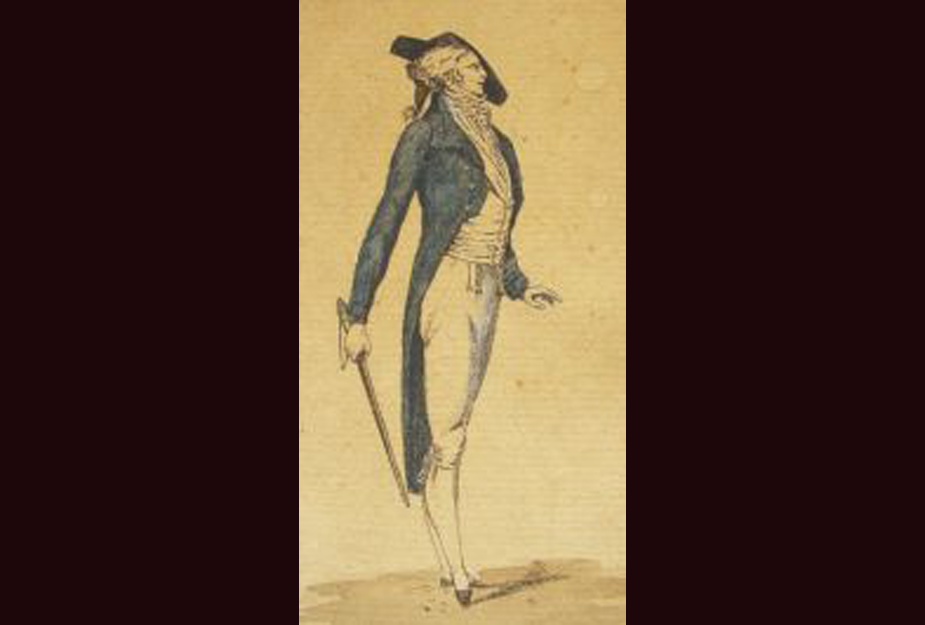
While back in fledgling America, there were Dandies too… … young men & women were imitating the English & French “Dandies” in defiance of the political situation of the American Revolution.
It is not known if the American Dandy had a political statement to make, or if they just liked the freedom to wander about in weird costumes, hitting people with sticks.
(Cartoons featured & below: Women’s hair of 1776 reached ridiculous heights, & was a source of humor for many, although the jokes were not too far from the truth, as women did install miniature ships & full vases of flowers in their hair)
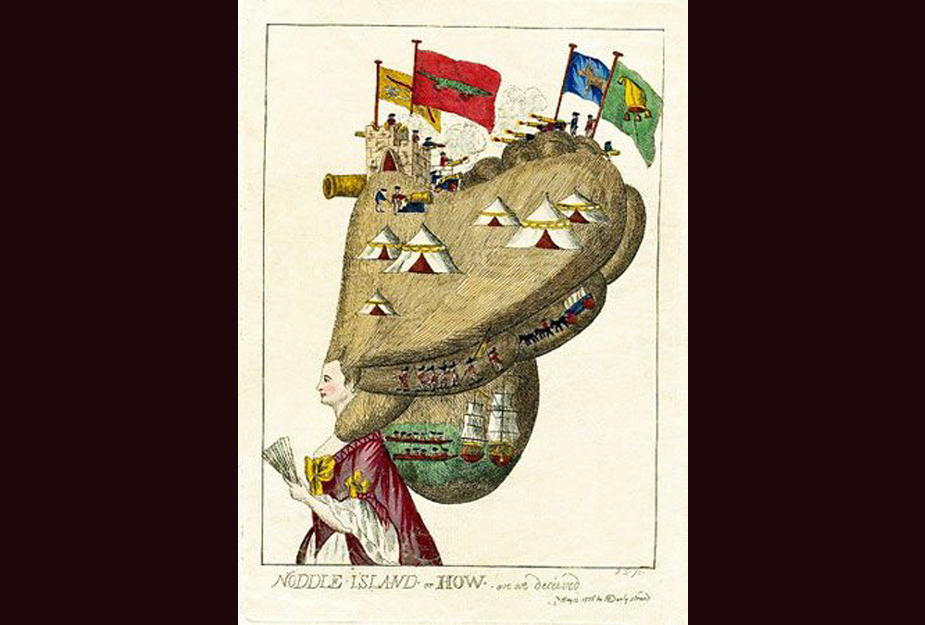
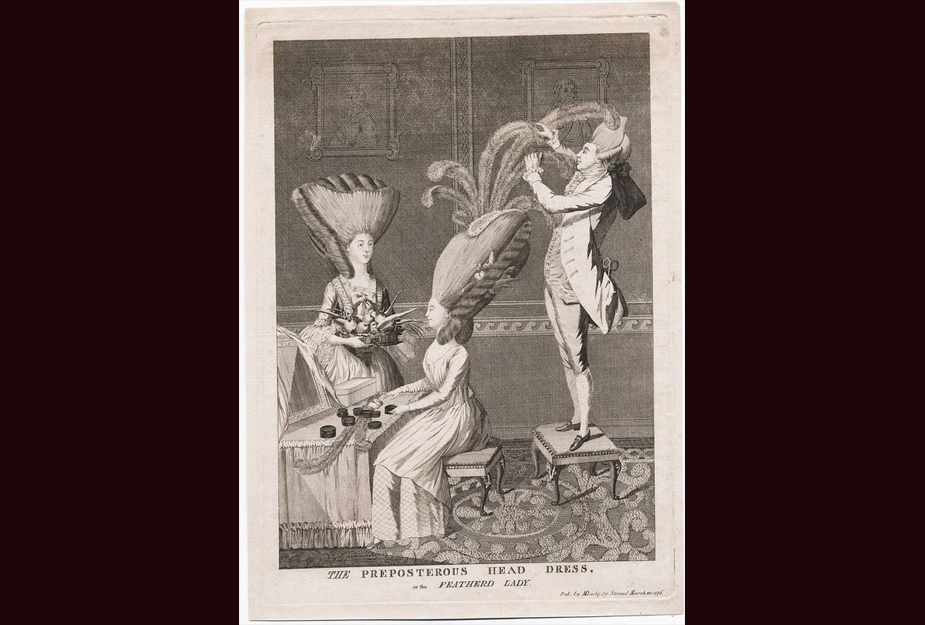
While Dandies played at politics, Yankee Doodle stuck a feather in his cap.. … “and called it Macaroni”… American patriots were making fun of the British by referring to the British sub-culture of the Macarons & Muscadins when they sang “Yankee Doodle” & mimicked the aristocratic aires of the British nobility.
(photos: “Yankee Doodle” sheet music of the 1770’s with a picture of Beau Brummel, English Dandy & fashion icon of the day)
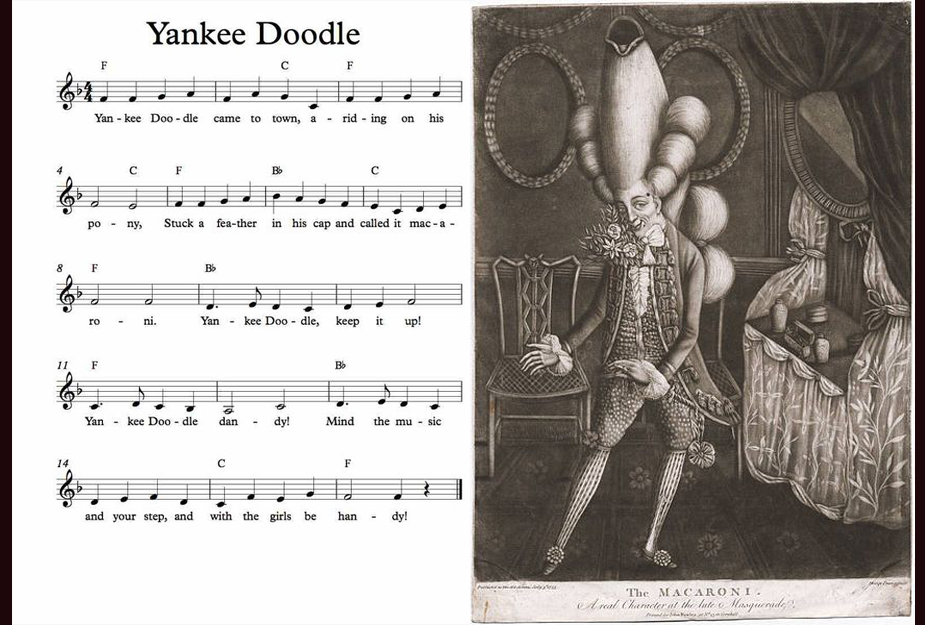
And Beau Brummel polished his boots with champagne.. George Bryan “Beau” Brummel was an iconic figure in Regency England, & a friend of the Prince Regent (the future King George IV). He was the 1775 founder of the “Dandies”, who established the mode of dress for men that rejected overly ornate fashions to one of perfectly fitted & tailored “bespoke” garments.
The look was based on dark coats, full length trousers instead of the knee breeches & stockings that dominated the day’s fashions, above all, an immaculate shirt linen with an elaborately knotted cravat (tie), which took 5 hours a day to get dressed in.
Beau is attributed with the introduction of the modern men’s suit worn with a necktie.
(feature: Beau Brummel in 1778 wearing his “cravat”; painting below: Jean Lerome, a later 1790 Muscadin, or Dandy, took fashion to a different level in introducing the long jacket & top hat. Combined with Brummel’s suit & tie, this concept would become the standard somber formal non-military “dress uniform” of men for decades to come)
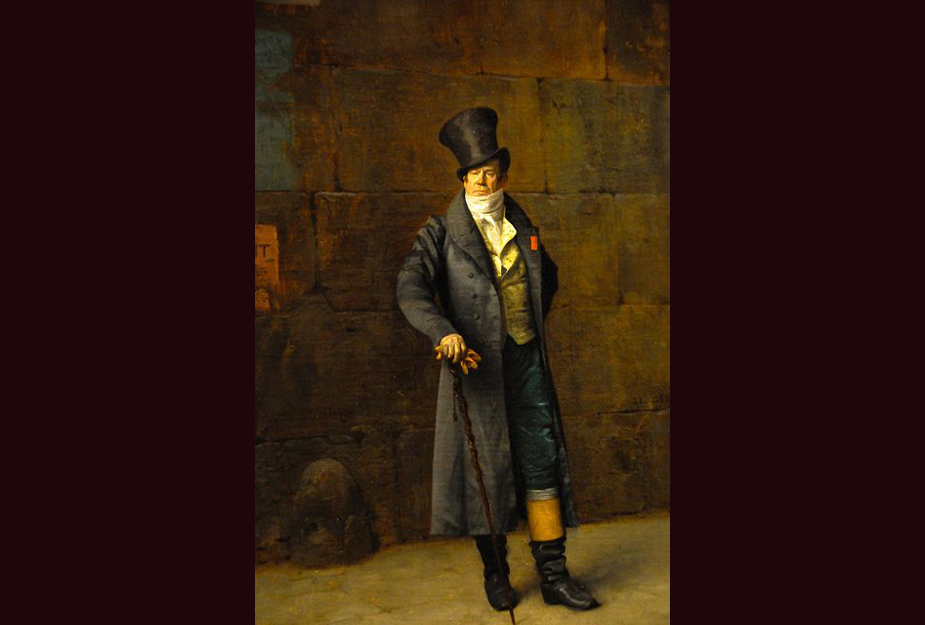
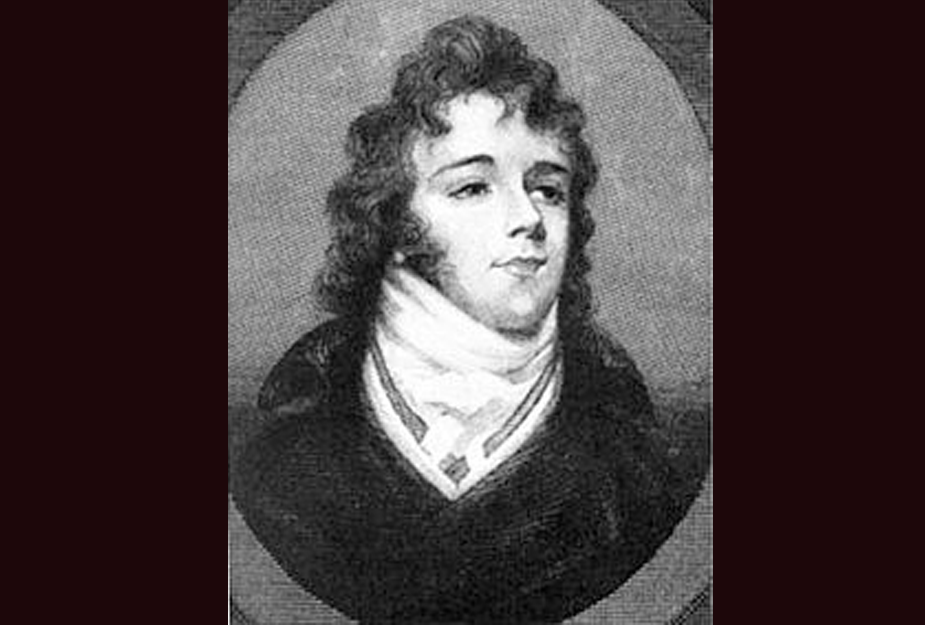
Why do we care about French & American Revolutionaries..? The French Revolution was important to fashion, because what France did; everyone else did (include war, conflict, & Court intrigue).
France ruled American fashion from the early 1700’s & through both Revolutions until France’s reign ended with the flashy “Belle Epoque” era at World War I.
France ruled fashion because:
1) England followed France, & America followed England;
2) Trade & communication with other parts of the world was limited; e.g. Japan was an isolationist country until the end of the Shogun era;
3) France made great fabrics, laces, notions, & designs
4) The French, uninhibited compared to everyone else of Western society, went naked in public
(painting: French painter Delacroix’s Romantic Era depiction of the French Revolution)
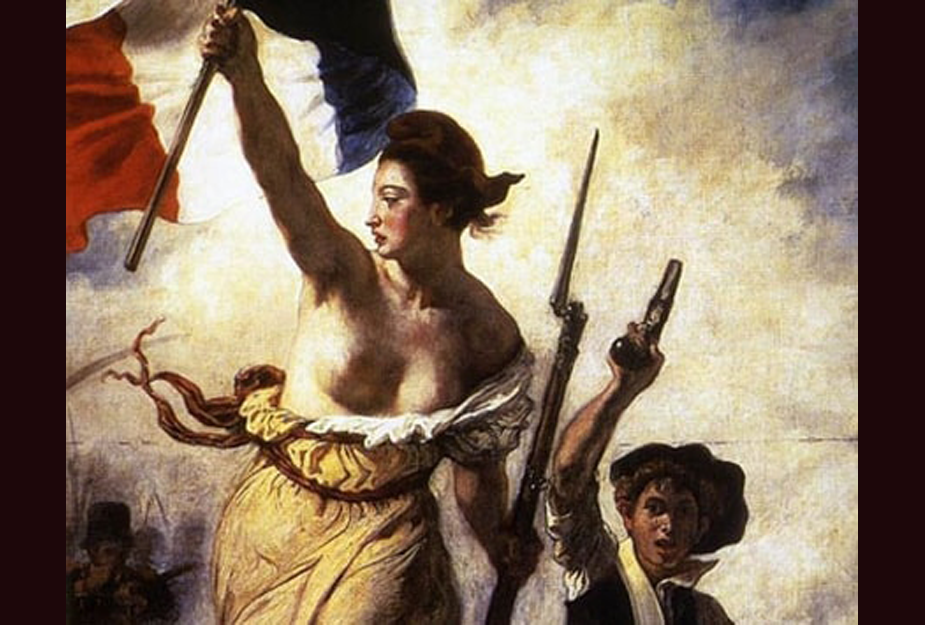
Real Royalty – Rise of the Bonapartes
You need to know French nobility.. .. to understand fashion from the 1770’s to the 1870’s. FRANCE led American & English fashion despite the eras being named for the ENGLISH: “Georgian” (after 3 English kings named George), “Regency” (referring to the transition of power between 2 of the English Georges), & “Victorian” (almost a century of Queen Victoria’s dictates).
Only “Edwardian” fashion would actually be spearheaded by King Edward of England.
(photo: Napoleon Bonaparte, Emperor of France’s, direct lineage chart)
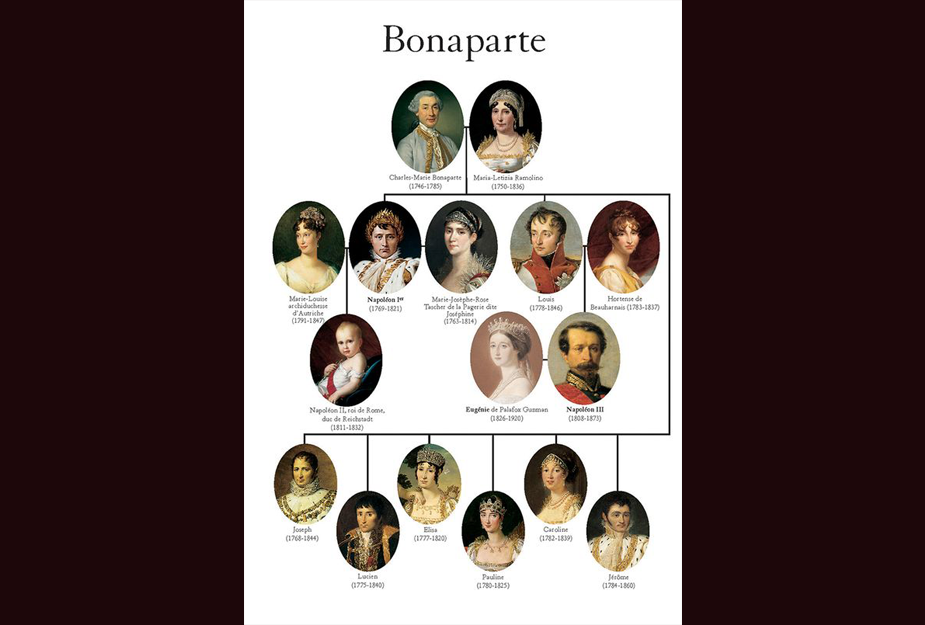
We start with the French Kings’ Borbon Line… .. These are rulers with “royal blood” carried from generation to generation. They would rule France until the French Revolution when France was restructured into Republic and Empire.
They were all almost obsessed with fashion as a statement of power, rank, & nobility, & expected their queens, children, & all the nobles of the country to follow suit
(literally.. “suit”.. “robe”… etc.)
(painting: The Borbon family tree)
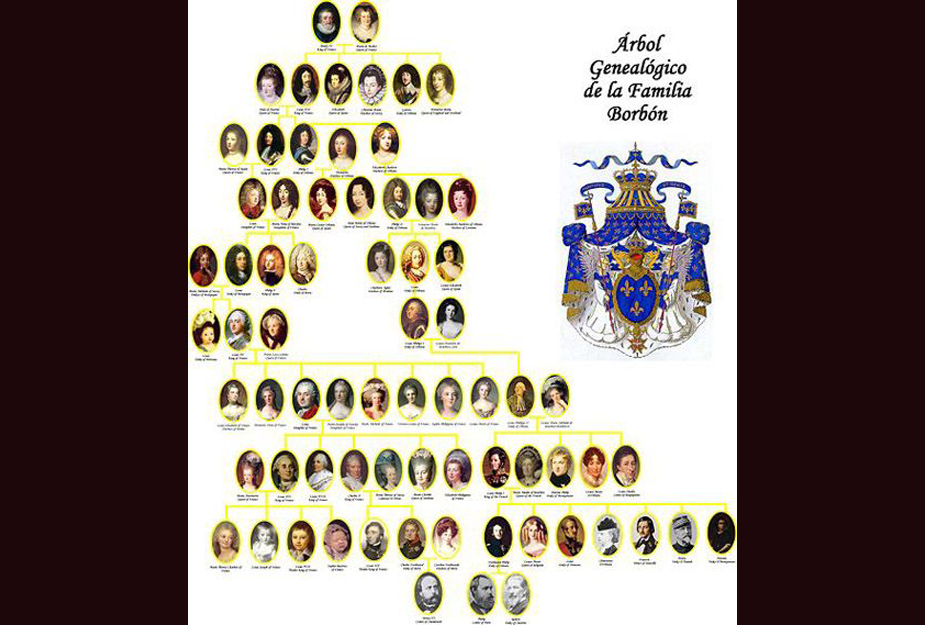
Our 1st Fashion Mogul, King Louis XIV (14th) ruled France 1642 to 1715… .. during the time of Alexandre Dumas’ tales of “The Three Musketeers”, tensions between England, France, & Spain, & the development of naval & army power.
This Louis, taking power as a child at the assassination of his father, was almost childlike in his obsession for fun & interesting fashion. He kept his Queen Anne of Spain in what he dictated was the top fashion of the day.
(portraits: Louis XIV in coronation robes, & his official portrait)
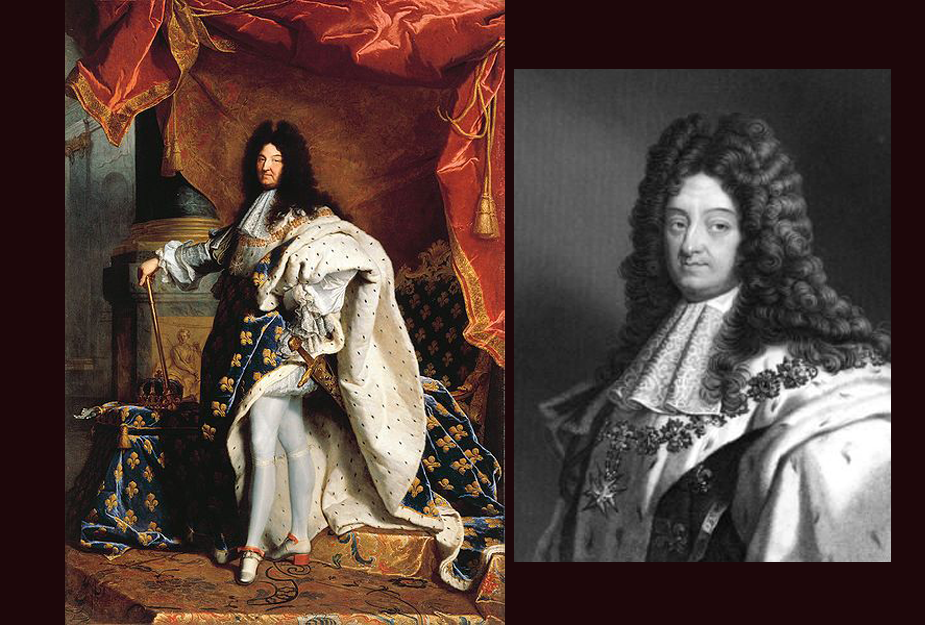
King Louis XV (15th) ruled France 1715 to 1774… .. was another child king who succeeded his grandfather to the thrown at the age of 5. History shows that he was a most beloved king “la roi bien”, but was attributed with the disintegration of the strength of France, as his continuing internal struggles with Parliament, religious feuds, & wars with other European countries led to financial trouble, dissent & eventual revolution 15 years after his reign.
Married by arrangement at the age 13 to the “Infanta Maria” of Spain in attempt to create alliance, he did build a highway system & infrastructure.
It was his mistress, Madame Pompador, who would bring France to the height of fashion – literally, as she established the concept of the huge panniered Court dress with outrageous hairstyles, ornamentation, & flamboyant lifestyle that other women emulated.
(Portrait: Louis XV in coronation robes; Official portrait)
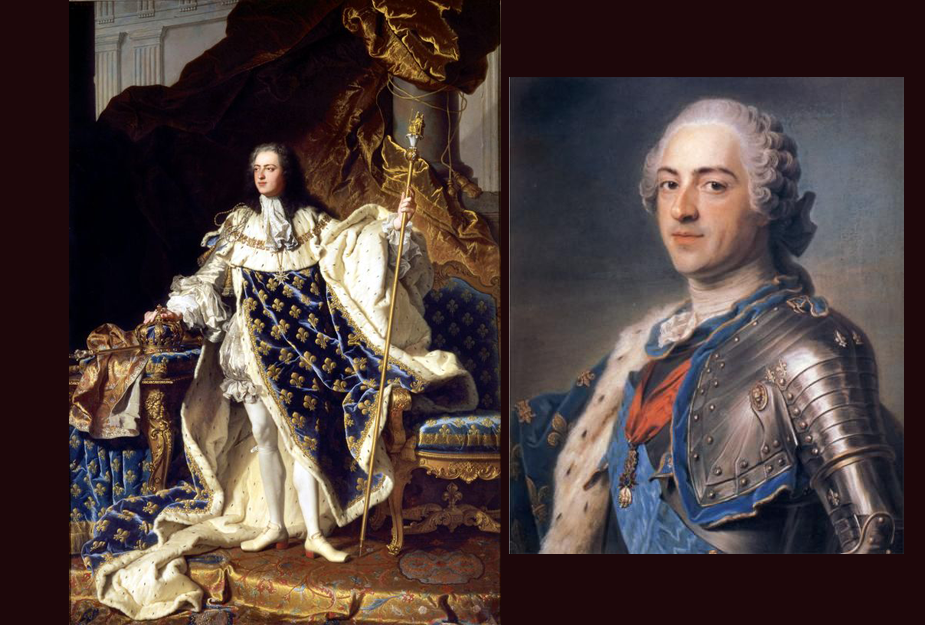
Madame Pompadour was King Louis XV’s mistress… .. and his very good friend & counsel until his death, long after their sexual relations had ended. Born Jean Antoinette Poisson (poissonade was a demeaning nickname the aristocracy gave her as means “little fish” in French), she was a commoner, who had noble patrons who brought her high into society.
Her support of the arts, & innovation of fashion brought her high into the aristocracy and almost single handedly developed the porcelain industry of Sevres, as well as built “l’ecole militaire” military academy.
(paintings: feature sample below of Madame Pompadours extremely ornate fashion. The last is the wife of Madame Pompadours’ key patrons. One has to wonder what kind of a man would leave such a wife to take a mistress..)
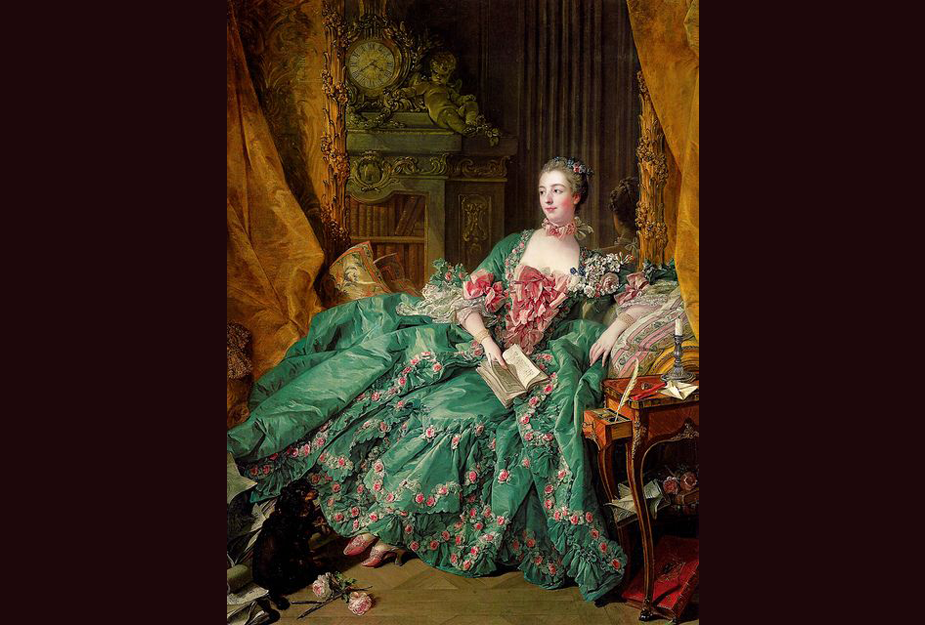
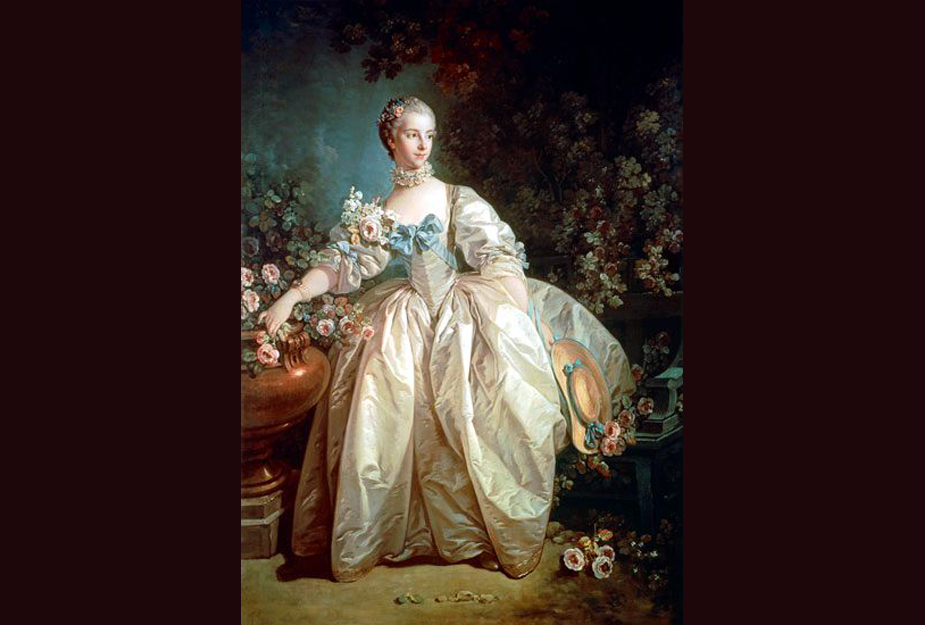
“Little Fish” Pompadour made the HUGE paniers famous… Madame Pompadour (not lovingly nicknamed “Poissonade” or “Little Fish”), was a mistress of several men of nobility, but most notably, King Louis XV. She was later his best friend & advisor.
Visitors can to this day see the lovely little apartments Louis kept for her, as it was the one place the king could go to escape the stresses of being a king. She loaned money to the King at times, yet was criticized for her own lavish lifestyle.
The huge pannier dress styles with extreme ornamentation can be attributed to Madame Pompadour. (Her contributions will be discussed in detail when we write about the Colonial eras of the 1770’s in a later blog)
(portraits: feature and below: artists & the fashionable loved the sensuality they thought just oozed out of Madame. Known for extreme hairstyles, ornamentation, decoration, & accessorization, she set fashion extremes in the 18th century that no one has been able to replicate except in the performing arts today. She was technically – a performer in her own right)
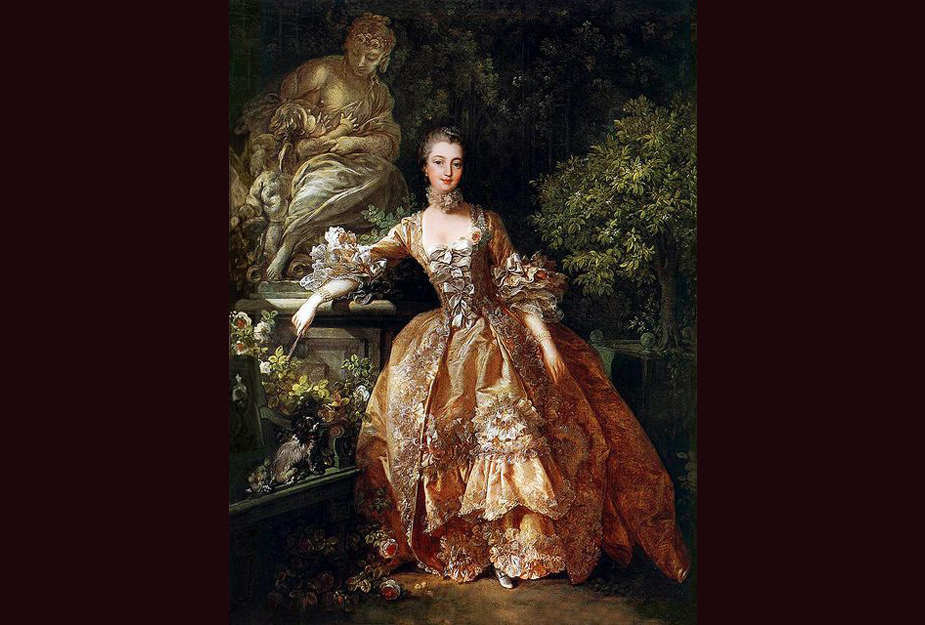
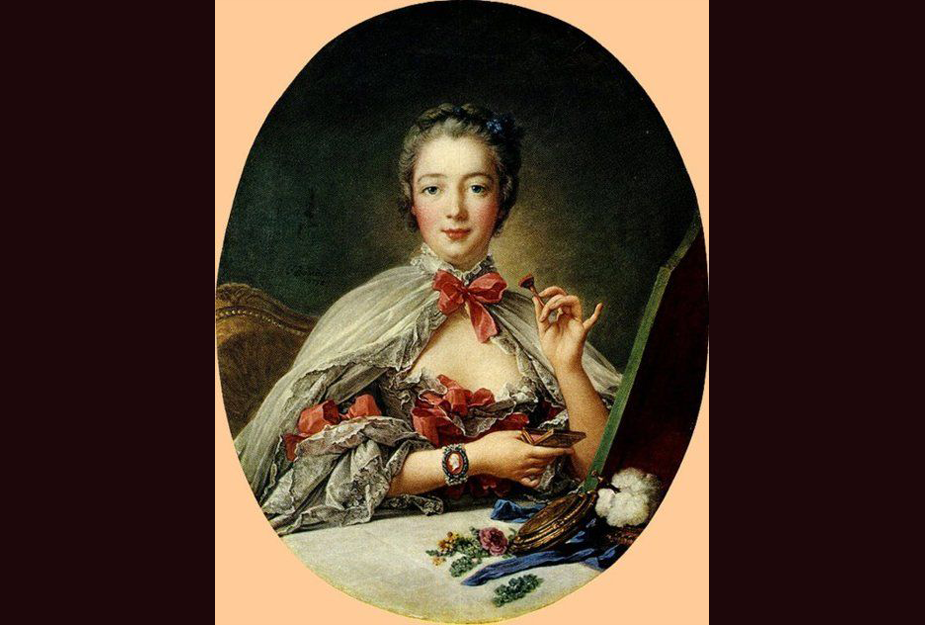
King Louis XVI (16th) ruled France 1774 to his death… .. by guillotine in the Reign of Terror preceding the French Revolution in 1793. His reign began with the attempt to bring about “The Age of Enlightenment”, which included the elimination of serfdom, the tolerance of non-Catholics, & deregulation of the grain markets.
The ruling class disliked all of his reforms, & when the harvest failed & the people were starving, all factions blamed him for every wrong. His extremely conservative values had him criticized as being a tyrant, and he was accused of tieing himself secretly to political alliances with other countries to save himself.
With the undermining of the monarchy as the established power, a republic was proposed, & real conflict ensued. In the middle of civil unrest, he & his queen were killed.
(portraits: Louis XVI in coronation robes & his official portrait; below: Marie Antoinette with 2 of their children in about 1785)
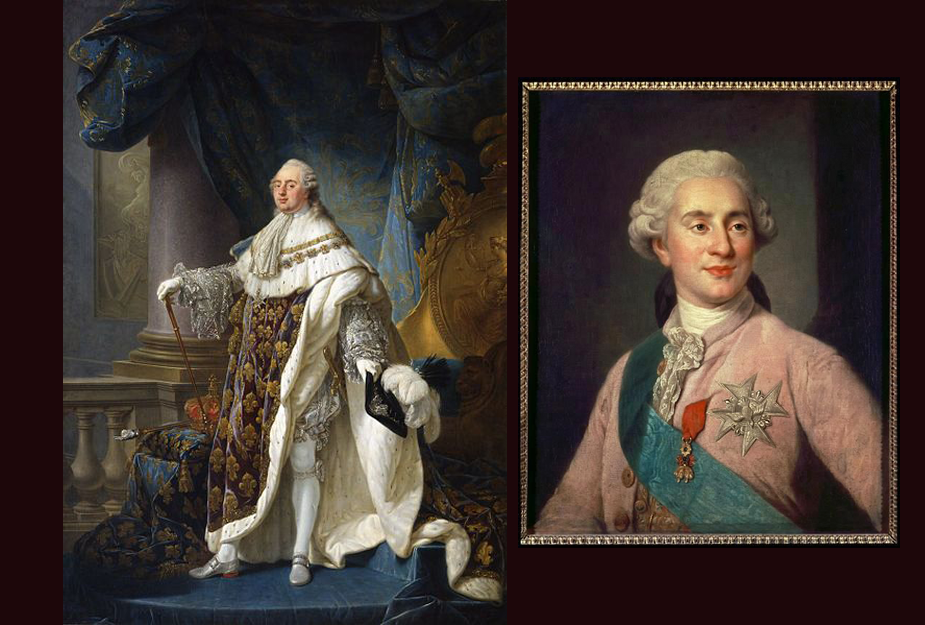

Louis XVI & Marie Antoinette had a Rough Relationship Louis married Marie Antoinette of Austria in a political alliance, but this was also met with suspicion. The common populace felt Marie’s lavish lifestyle was taking bread off their tables, & the nobility & ruling aristocracy suspected her connections with foreign governments were influencing the King.
Marie Antoinette, in escaping the stress of Court life, hid in the country, where she developed new, relaxed fashions.
(portraits: featured – Marie Antoinette’s scandalous portrait by Le Brun showing her wearing “gaulle” & then the paint over; below – Marie in “chemise a la reign”)

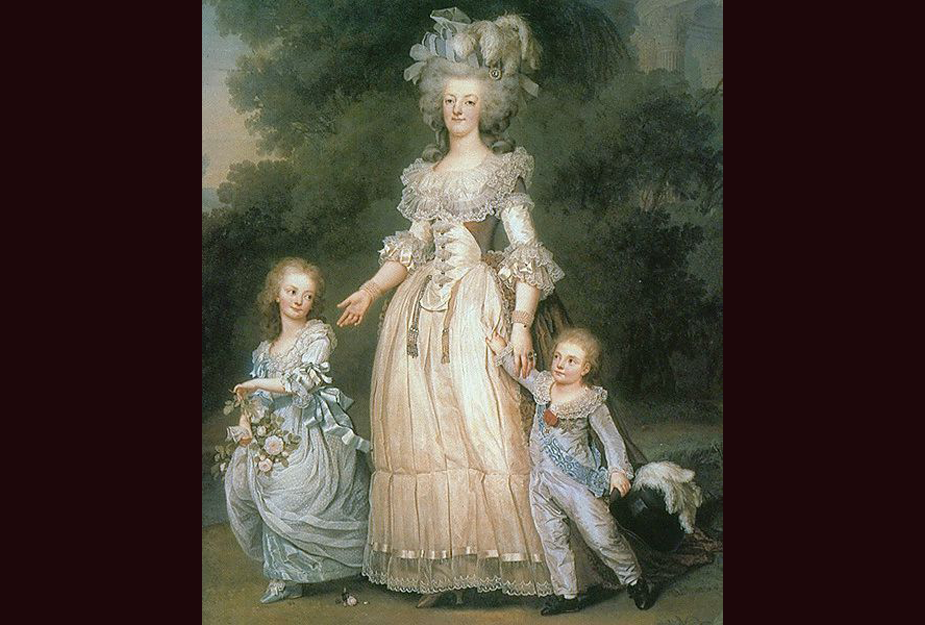
Yet Marie Antoinette was probably the one most influential person in fashion history …King Louis XVI demanded Marie keep up appearances in court, & her elaborate, structured Court dress which was based on the prior Madame Pompadour concepts. Marie’s “gaulle” & “chemise a la reign” soft, cotton garments had fashion take a complete 180 degree turn in the 1790’s as she too approached the guillotine
(read our past “Regency” blogs which go into Marie Antoinette’s influence in detail)
(portraits: feature – Marie en “gaulle”; below – the “shepherdess look” embraced by the populace, & in full court dress as ordered by the King)
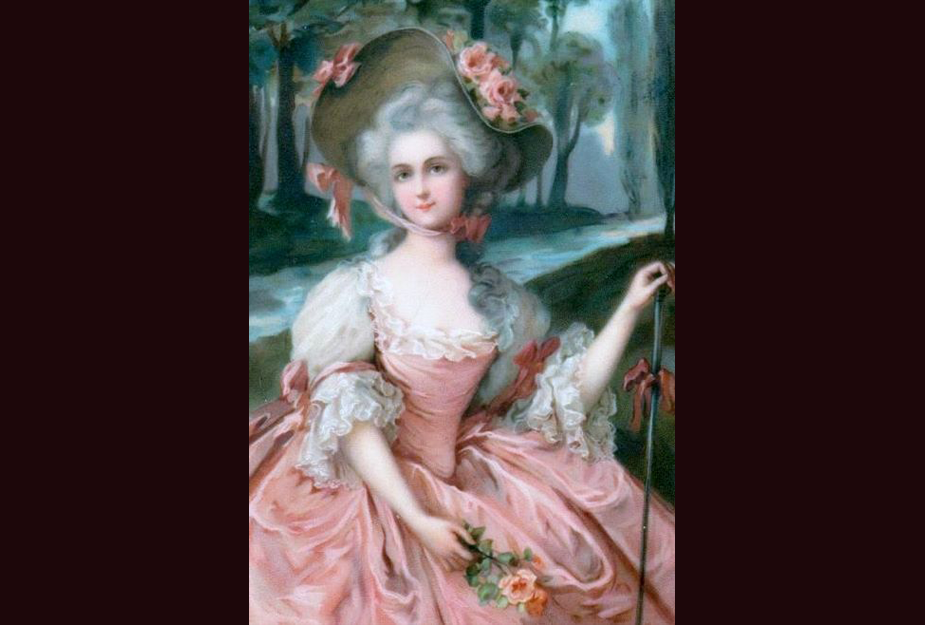
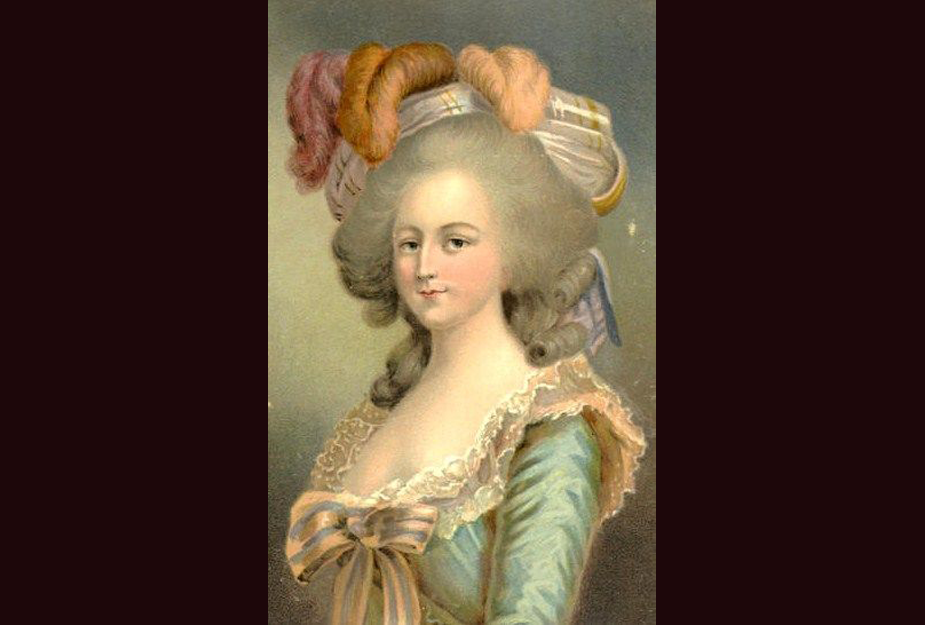
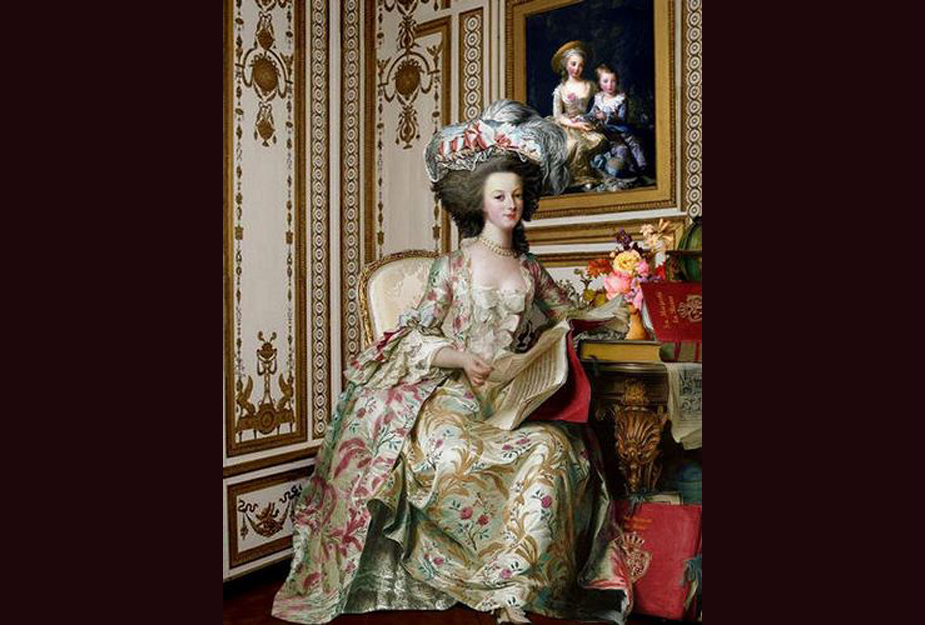
The 5th key player in French fashion was Marie Antoinette… .. Marie was a foreigner in France, & largely disliked from the start by the populace. It did not help her public image when Louis required her to set the trends of the huge & elaborate fashions of the 1780’s, which made her look wasteful while people were hungry.
By 1790, Marie was rebelling as best a queen could, by retreating to her country farm, where she would dress in versions of her white underwear.
Condemned to the guillotine alongside her husband because of her supposed excesses, her executioners did so while wearing the simple, inexpensive & completely “non-excessive” Regency style that she had introduced.
(portraits: Marie Antoinette in summer Court dress; (below) softer “gaulle” stages of her fashion. Painter Le Brun had painted her in Gaulle, but it was so scandalous, she was required to remake the portrait to have Marie more covered up as was befitting a queen.)
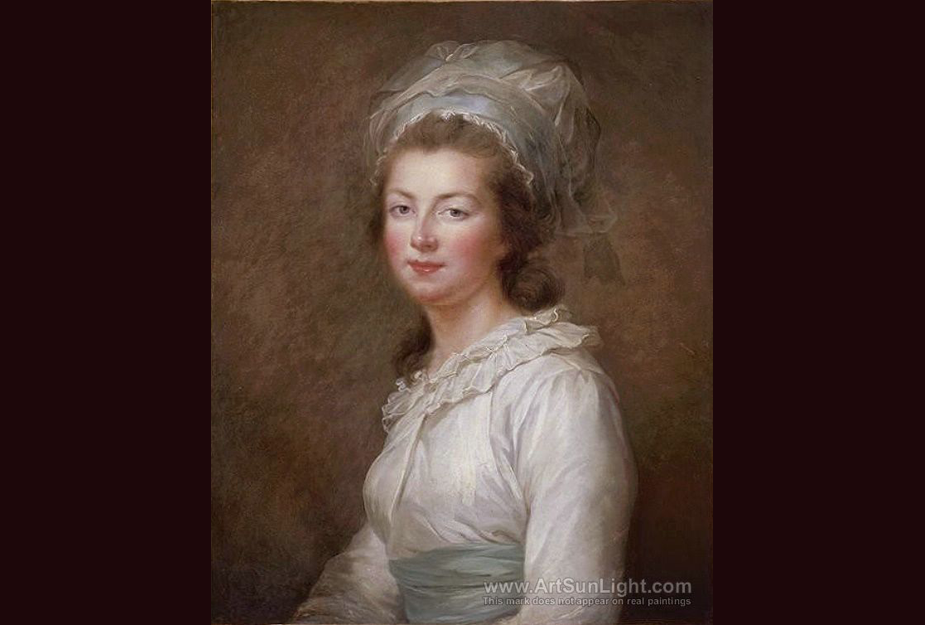

We skip through a whole Revolution to get to the 6th Frenchman… .. Napoleon Bonaparte I. Actually, he was rather an integral part of the French Revolution, as he started it.
Napoleon crowned himself Emperor of France in 1804. He held tight control of every facet of French society, including fashion, culture, & social norms.
Napoleon enjoyed displaying his power through fashion. Because the “Regency” simple gowns & ensembles were in full force during his reign, he counterattacked the fashion world by forcing women to wear more.. more fabric.. more luxurious fabric… more layers… more ornamentation.. and more frills (sound familiar?).
The many military conflicts by the French during Napoleon’s reign influenced style & decoration, but most importantly, utilized mass production of textiles & garments, which took France & its followers into a new Industrial Revolution that would change society forever.
(painting: Napoleon on his horse)
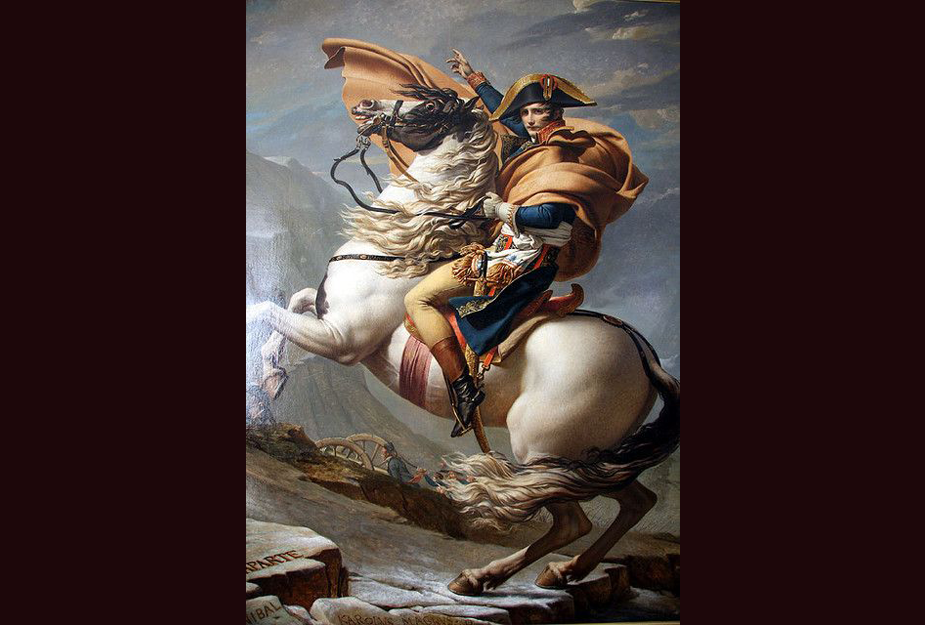
Napoleon crowned himself in 1804… … with Josephine as Empress
(painting: Marie Louise at Coronation)
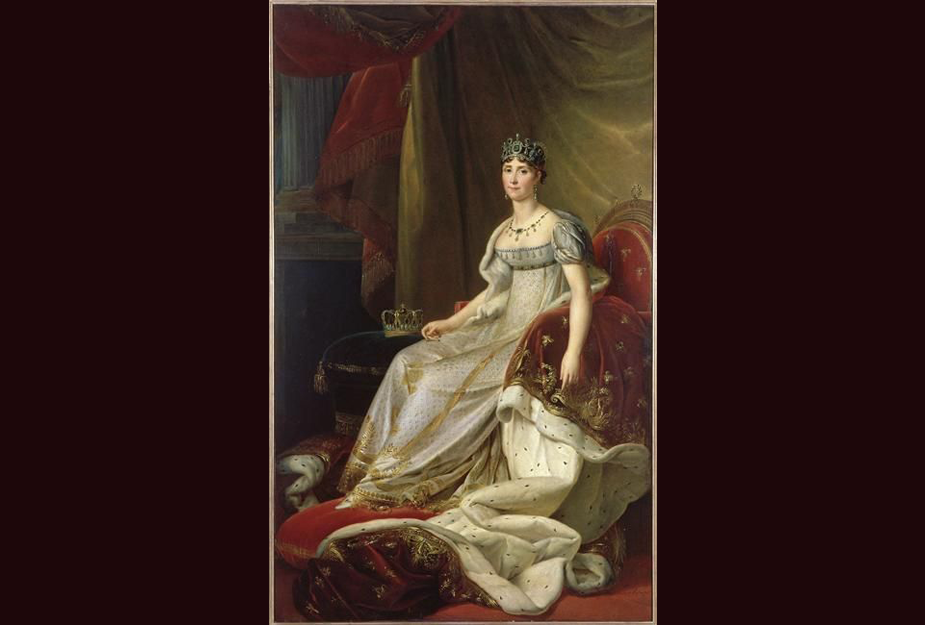
(This is Luise Queen of Prussia meeting Napoleon and Marie Louise)
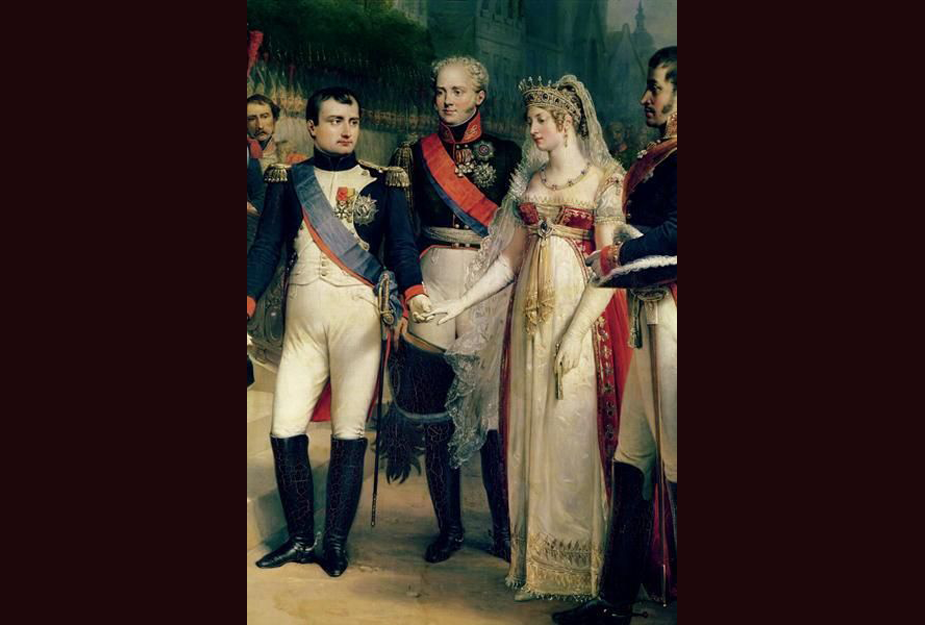
Napoleon I (1st) considered himself very fashionable… As you can see from Napoleon’s coronation ensemble which included gold & ermine, he thought highly of himself. He was also trying to boost the economy of a country that was war-weary, by making nobility follow his lead of fashion extravagance wearing costly court apparel.
(Painting: Napoleon I on coronation day 1804)
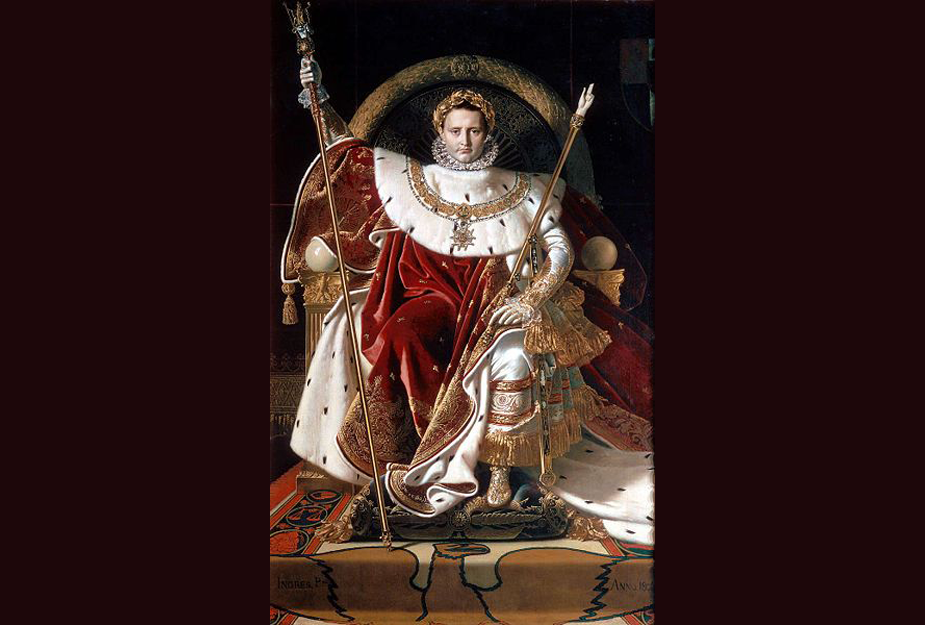
Our 7th French fashion key was Josephine… … Napoleon married Josephine with specific intent to get an heir. Josephine was the widow of a French General, & came to the marriage with 2 children. She never gave Napoleon his own heir, so he divorced her. Her daughter, Hortense, would carry on the Bonaparte line.
Reigning houses of Sweden, Denmark, Belgium, Norway, & Luxembourg came from Josephine’s children.
(portrait: Empress Josephine in her coronation gown, 1804-5)
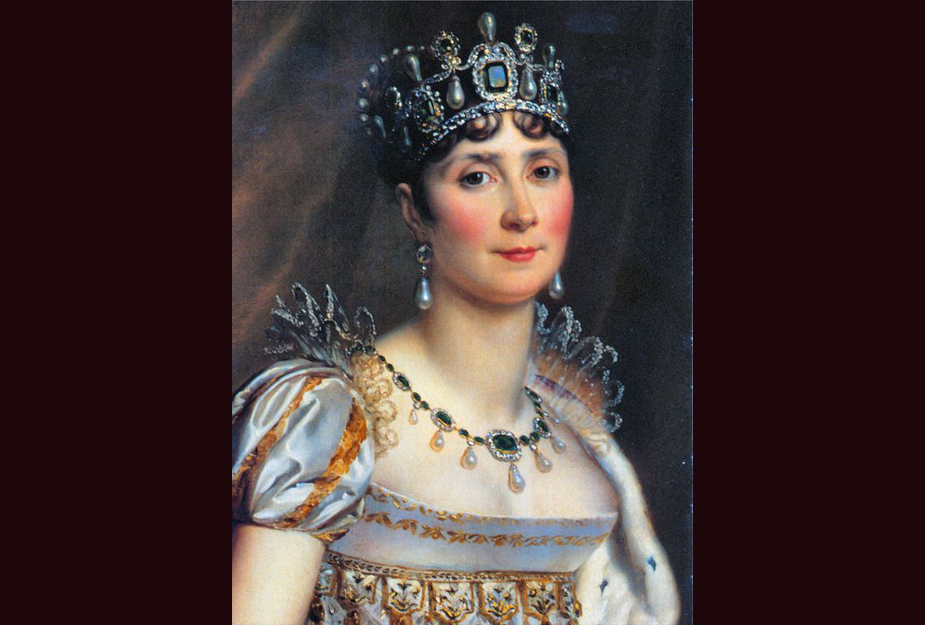
osephine made the “Little White Empire Dress” into something fabulous Josephine came from the “Marveilleuse et Incroyables” movement of “Le Directoire”, & came to the throne already a fashion icon with strong influence on nobility & commoners alike. She wanted to continue the simple, classical Greek & Roman inspired “Regency” fashion, as she loved its sensuality, freedom, & comfort.
(portrait: Not Josephine, but her “Marveilleuse” partner Juliette Recamier in the most basic “Little White Dress” of the Regency era. Josephine would take this dress to the next level.. tomorrow…)
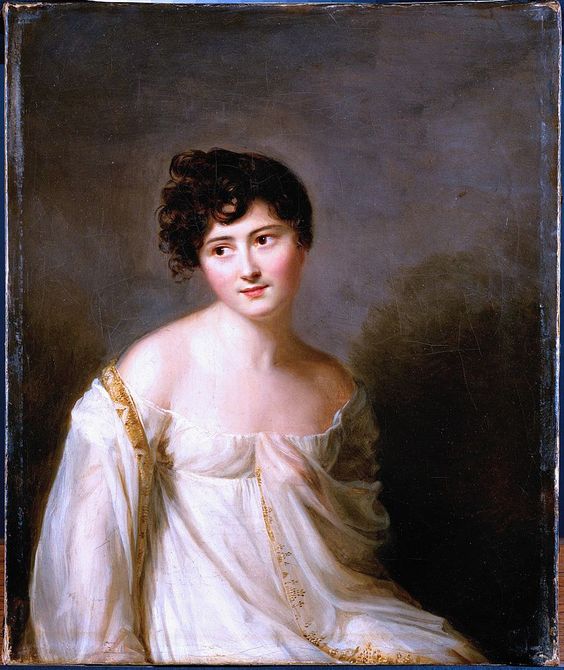
The simple Regency gown took on new meaning under Josephine Respecting the dictates of her husband to “wear more”, under Josephine’s inspiration, came the same “Empire” waistline (named for her), but now made from luxurious fabrics with real gold threads, ermine capes, & elaborate ornamentation that would lead into the next more complex fashion eras of the late Regency.
(portrait: also not Josephine, but the Queen of Sweden in 1810 in black.. wearing Josephine’s fashion. Below is Josephine in Court Dress at about the same time)
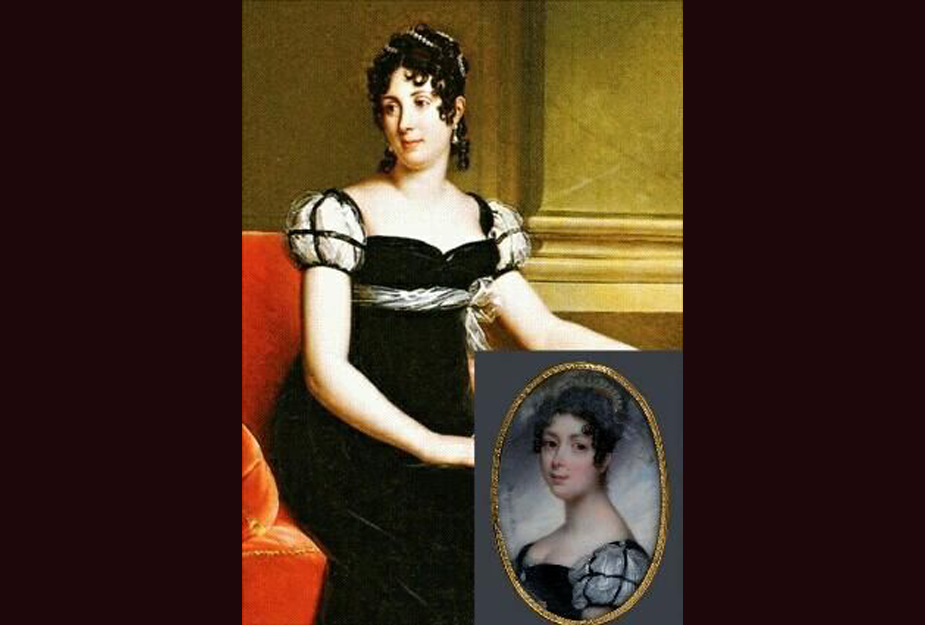
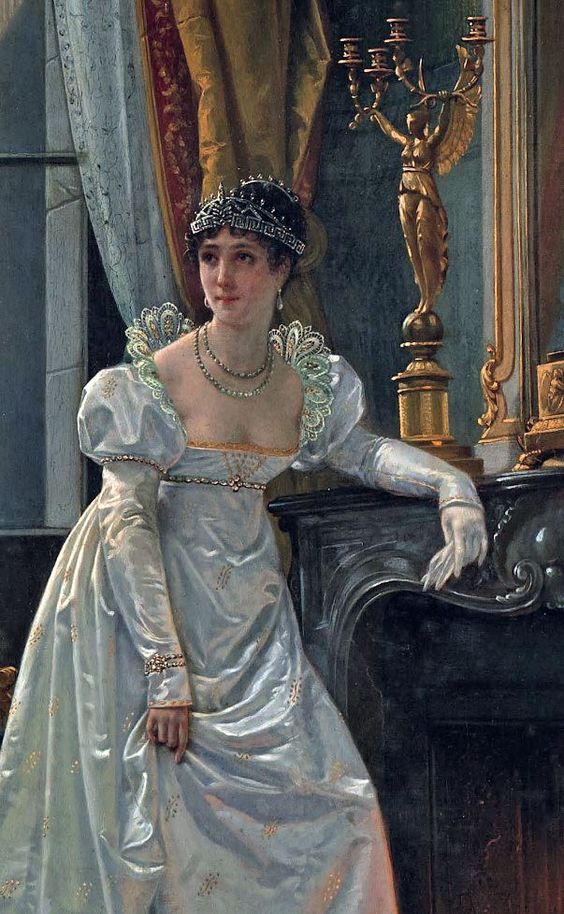
After Napoleon dumped Josephine, he found our 8th key player, Marie Louise… .. in 1810. Marie gave him an heir right away who was the King of Rome at birth, & briefly succeeded as Napoleon II at a time when boundaries & countries were changing.
(portrait: Marie Louise in her Coronation Ensemble of complete French design & construction in 1810)
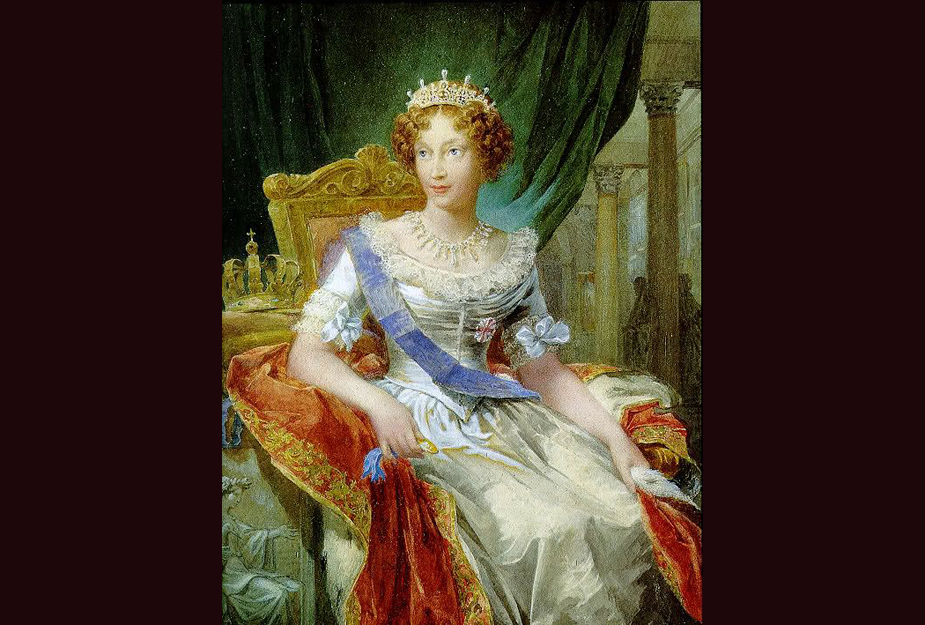
Marie was a “Quiet & Obedient Wife” Napoleon I loved Marie Louise; she was known as being a quiet & obedient wife, unlike his first wife Josephine who was political & got angry when he took mistresses.
(portrait: “Sweet” Marie Louise in about 1810)
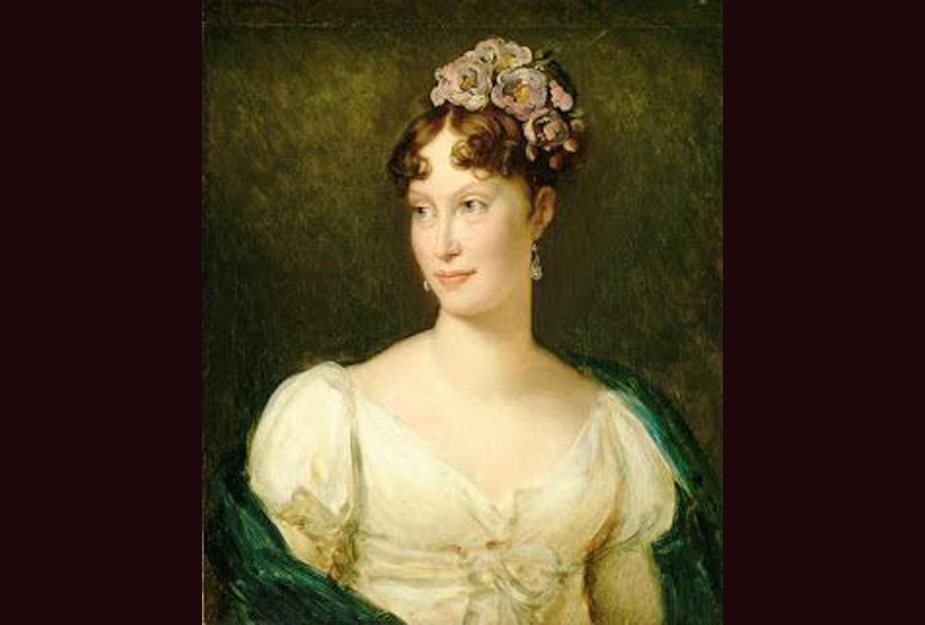
Marie Louise, the “Womb” Napoleon had divorced Josephine claiming she could give him no heirs, yet of his 2nd wife, Marie Louise, he said “I have married a womb.”
(portrait: Marie Louise with their son in about 1812. Below the wedding of Marie Louise of Austria & Napoleon I in 1810)
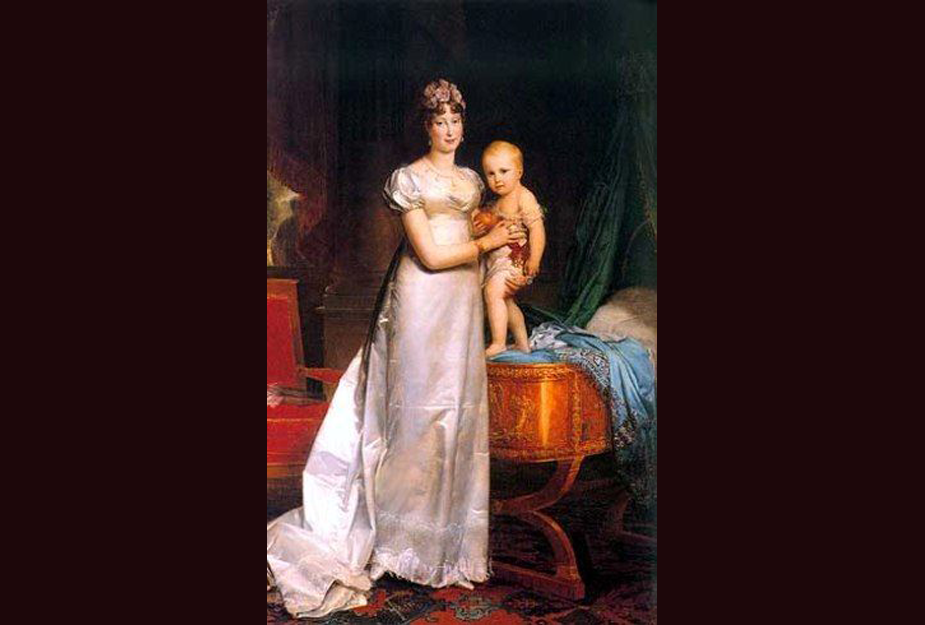
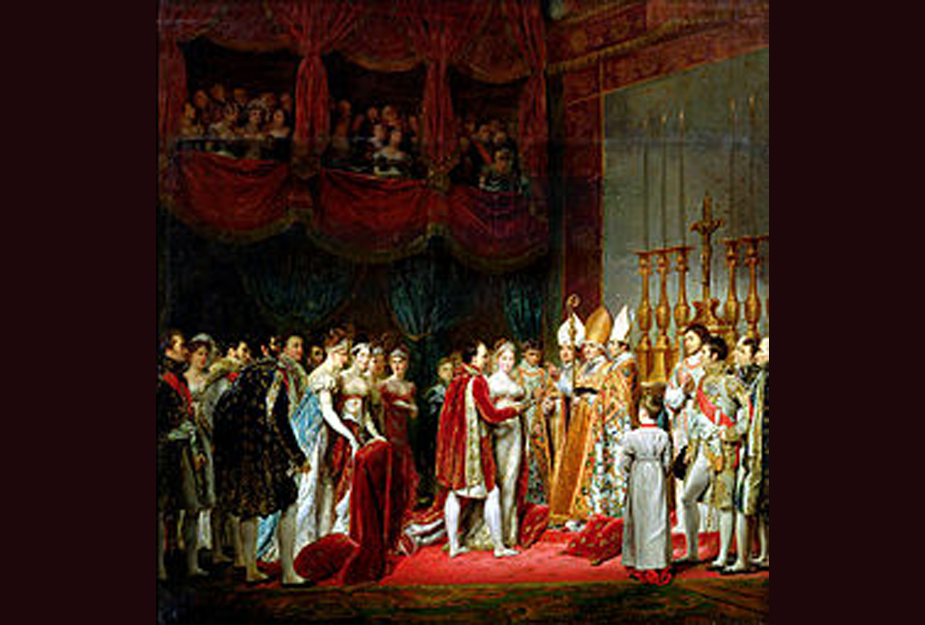
Marie was not really interested in fashion… In great contrast to Josephine who preceded her, Empress Marie of France’s clothes, including her wedding gown, were often chosen by others.
(Portrait: Dripping with pearls, ermine, & gold, Marie was dressed by others to look like royalty)
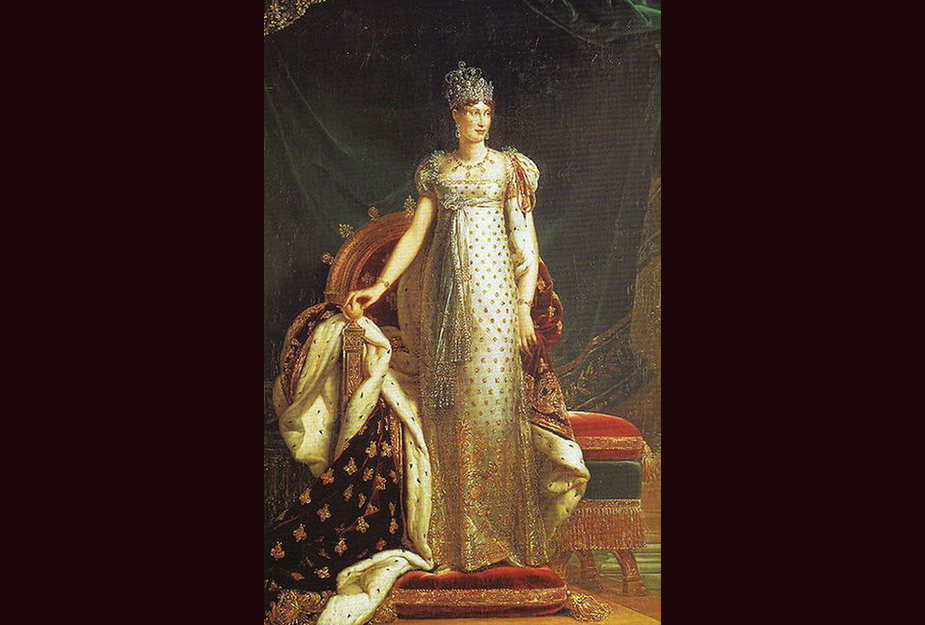
Marie Louise was a good French Connection… Coming from Austria at a time of conflict between Austria & France, Napoleon also enjoyed the relative peace between the countries, & was glad to have Marie Louise’s Austrian noble lineage after his last wife.
(painting: Marie Louise of Austria is welcomed to France)
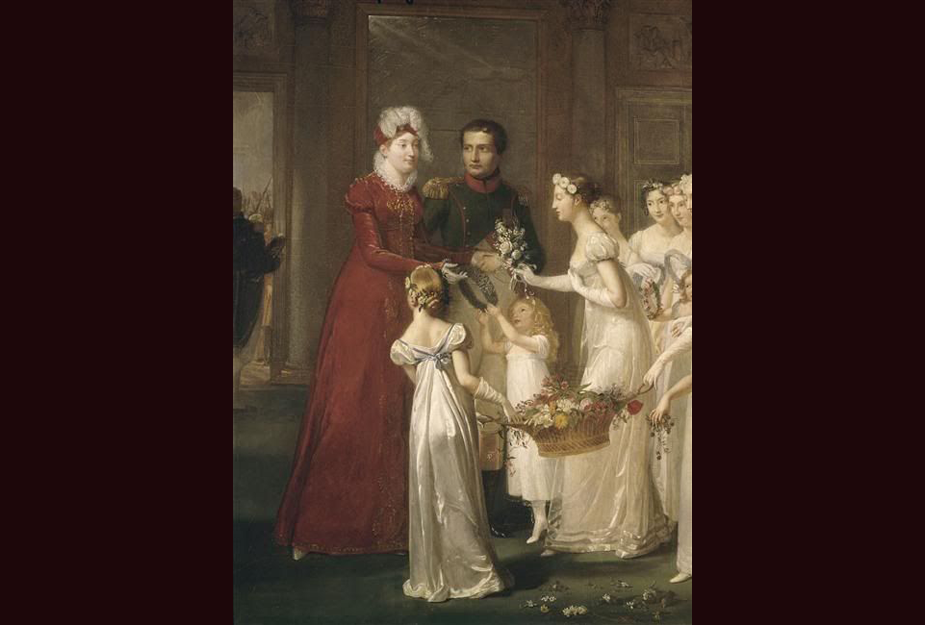
A Smile cannot stop a War… Marie, being softspoken in public, was accused of being “haughty”. Trying to avoid war between France & Prussia, , & thinking she could charm the Prussians into peace, Marie convinced Napoleon to invite the Queen of Prussia to visit.
It didn’t work. Napoleon took off for war against Prussia shortly after the visit.
(painting: Napoleon & Marie Louise greet the Queen of Prussia, Luise who was married to Frederick)
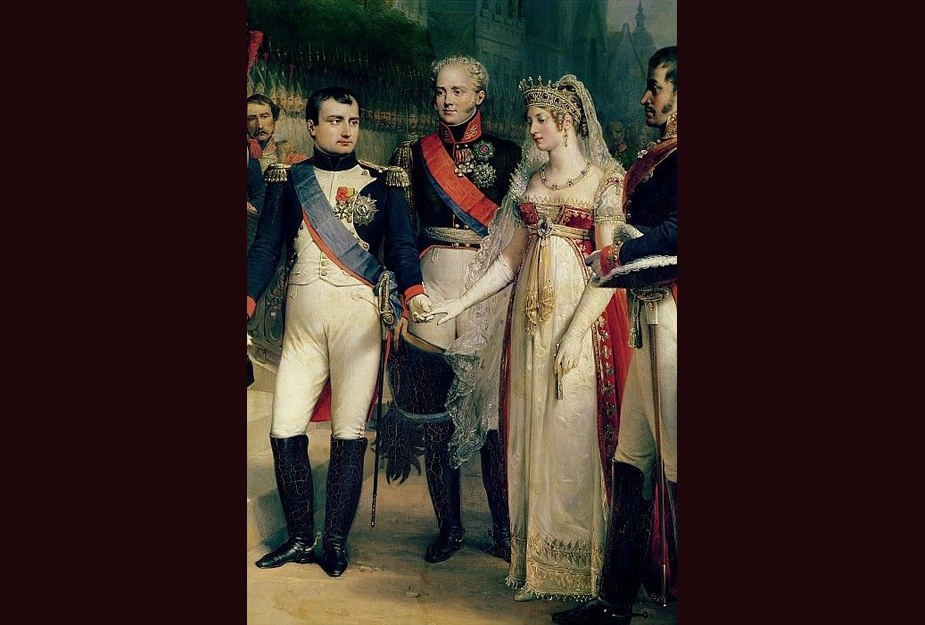
Commuting was not fun in 1814… Marie Louise, 2nd wife of Napoleon I Emperor of France, formed fast friendships with her ladys-in-waiting & others of the Court, but was often sent back & forth between countries of safety & France during conflict & war.
Being a mother & somewhat of a “homebody”, she missed her friends in Paris because of the transient lifestyle.
(painting: Marie & Napoleon walk with their son Corbin)
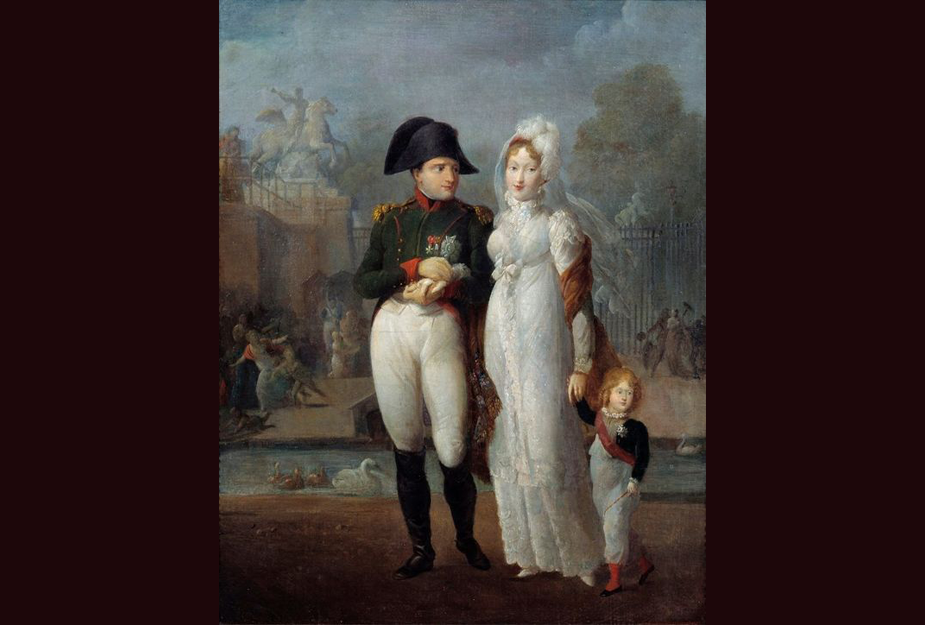
Reluctantly fashionable, Marie Louise let them dress her up… Louise was not known for introducing fashion, nor influencing it directly, although she continued the “Regency” styles as were already in place. It was the people around her, designing for her, dressing her, & putting her out to show that influenced fashion of the day.
(Portraits featured (1816) & below (1814): Formal wear as modeled by Marie Louise)
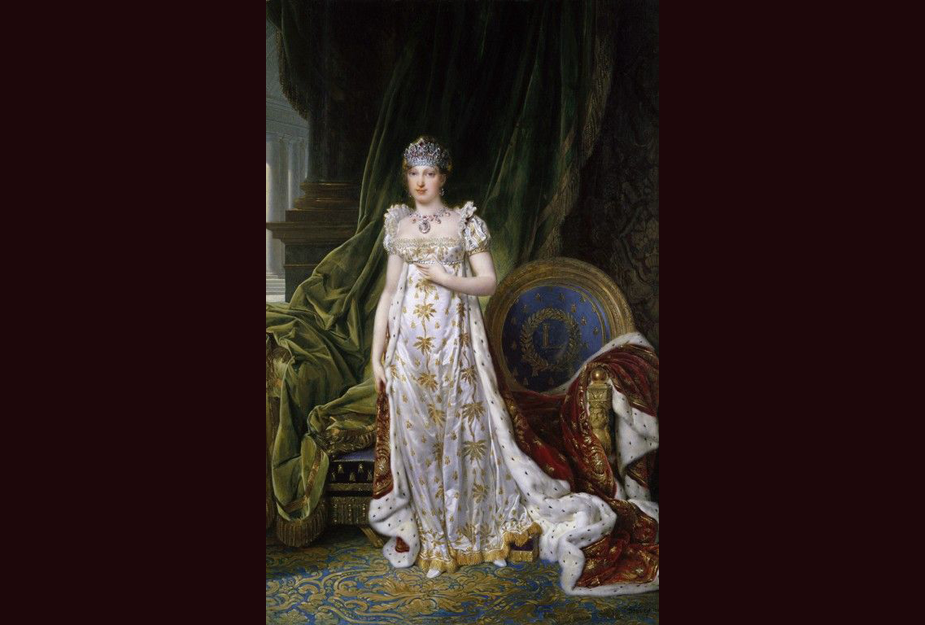
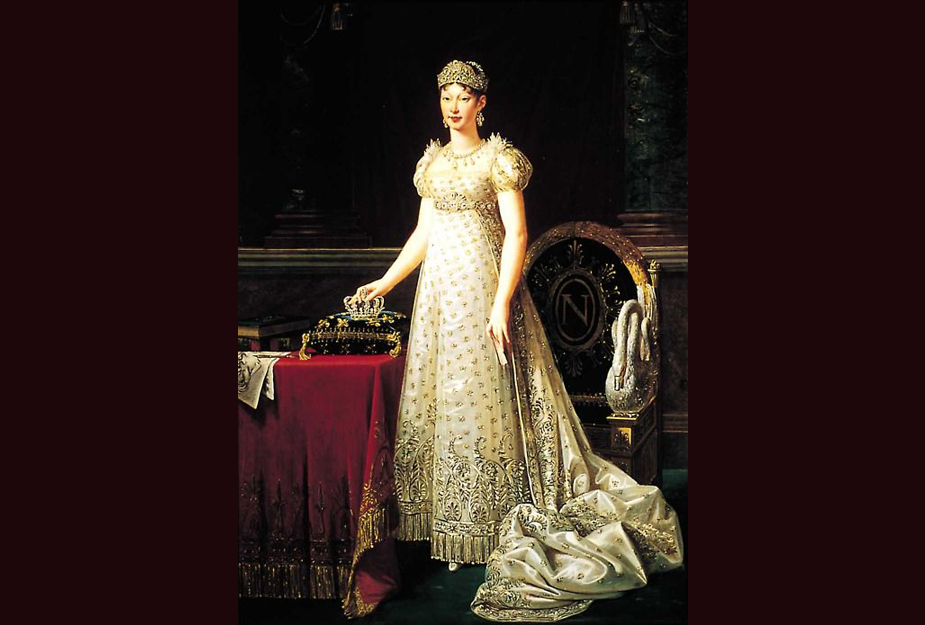
A fashionable, frothy, filly for show… Napoleon made sure Marie wore the finest, French fabrics, laces, & notions, including the lighter gauze silks with the furs & jewels befitting royalty.
(portrait: Marie Louise at home in her French made laces & silks)
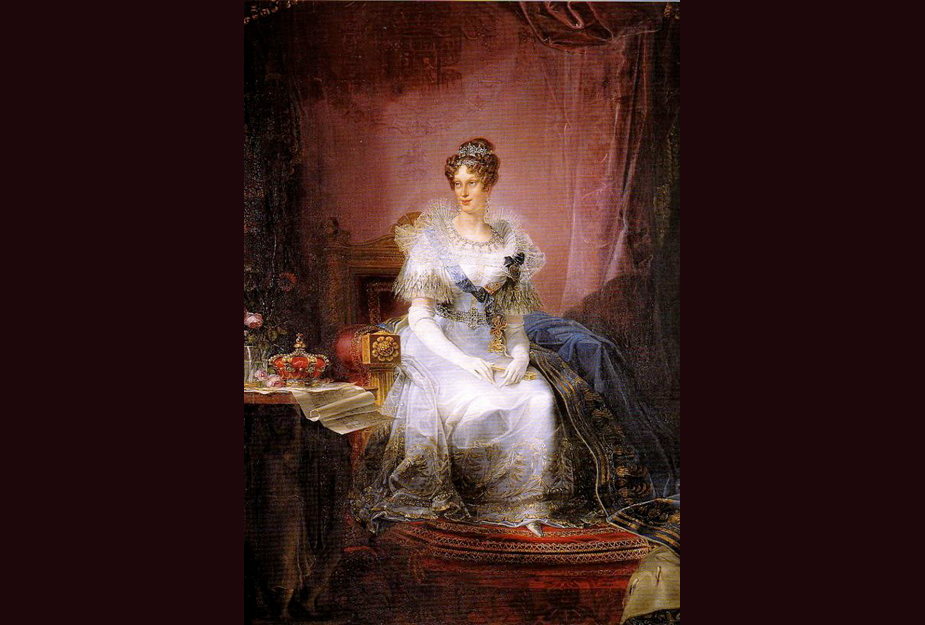
Marie Louise, Empress of France, ruled Parma in the end After Napoleon’s exile to Waterloo in 1814 & his eventual death, Marie ruled Parma, where she would have two more husbands.
(portrait: Marie Louise’s friend, Maria Amalia of Naples, later the Duchesse of Orleans models the 1809 Spanish & military influenced style that Marie Louise of France would have worn)
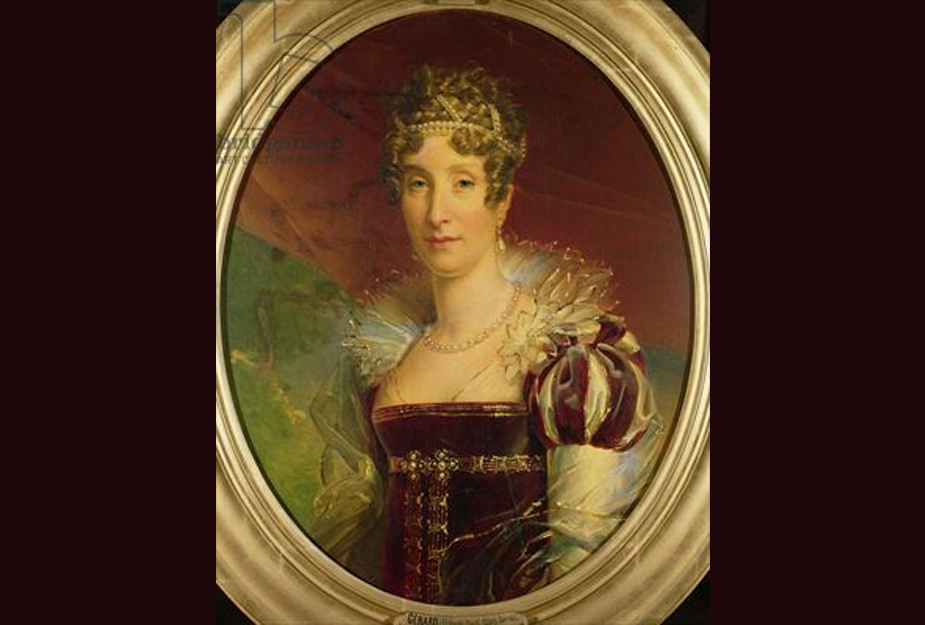
The 9th key Frenchman was Napoleon Ist little sister, Caroline… … of 7 siblings, with Napolen the eldest. The Bonaparte family had moved to France from Corsica in 1793.
Caroline wanted to marry one of her brother’s top military officers, but he said “non” under the influence of his then wife, Josephine, because she was only 17 years old. She did end up marrying General Murat any way in 1800.
To get back at Josephine, Caroline spread the rumor that Josephine was sterile & could not give an heir, a point of contention that led to Napoleon & Josephine’s eventual divorce, although both of them having torrid extra-marital affairs with ladies-in-waiting & officers (respectively) most likely had a lot to do with it too.
(portrait: Caroline, Queen of Naples, in 1809 with some of her 7 children)
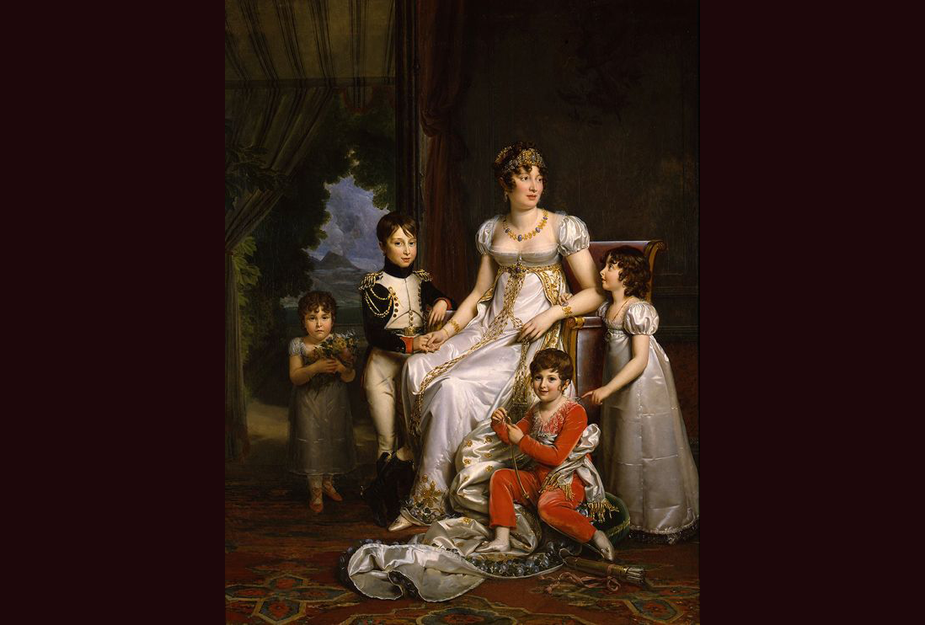
Caroline & Marie Louise ousted Josephine from France… Caroline, little sister of Napoleon influenced her brother into having an affair. Openly flaunting it, Napoleon had a son with his mistress, & thoroughly angered his wife at the time Josephine. They divorced soon after.
Caroline then convinced Napoleon to marry Marie Louise, whom she liked.
Caroline helped Marie Louise come safely from Austria to France, & convinced her to leave every trace of her life behind including her dog, so that she might fully assimilate in her new country, & not offend the French people, so that the marriage would “stick”.
It worked out well. Marie Louise & Napoleon had a good relationship with many children produced, & Caroline & Marie became fast friends.
(portrait: Caroline Bonaparte in French formal wear about 1809. Note how the “little white dress” of Regency prevails underneath its ornamentation!)
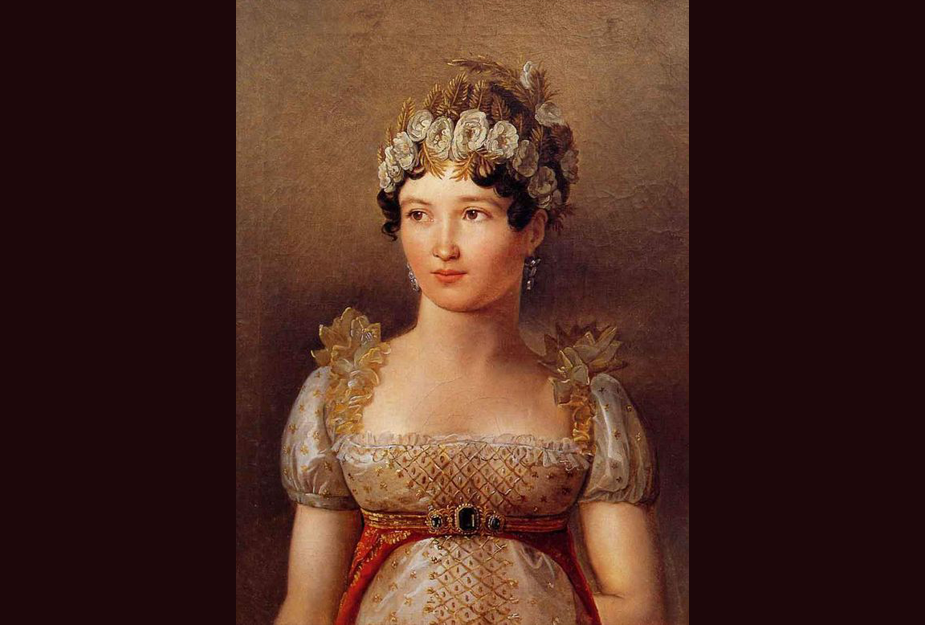
Caroline was in fashion competition with Josephine… Caroline, little sister of Napoleon I, although extremely well educated, was also very jealous of her sister in law Josephine. She also resented that part of her family including several of her brothers whom she felt got all the royal attention.
In attempt to separate herself from them, she devoted herself entirely to supporting her husband, the King of Naples.
Often in competition with Josephine for attention, she developed her own somewhat elaborate styles (having not the funds of the empress for many of the fine materials), & influenced women of France & Naples.
(portrait: Caroline’s dashing fashion sense in fashionable black in 1810)
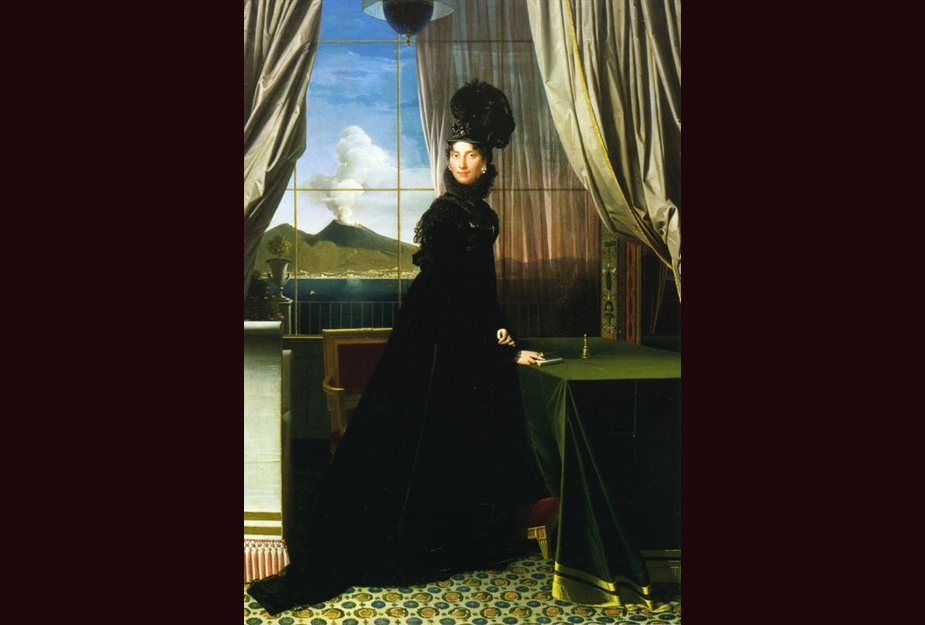
Hortense, the daughter of Napoleon I’s Josephine is our 10th Frenchman to study… … among our French fashion influences of the Regency era. Hortense was the step-daughter of Napoleon I, & the child that would carry the Bonaparte blood forward.
Hortense was said to have been a beautiful & cheerful child with pale golden hair & blue eyes. An accomplished composer & musician, she entertained Napoleon’s troops with her marching compositions. She attended school with the daughter of America’s president James Monroe, Eliza, & had a relationship with Americans.
(Portrait: Hortense with Napoleon III in 1807 just before the child’s death)
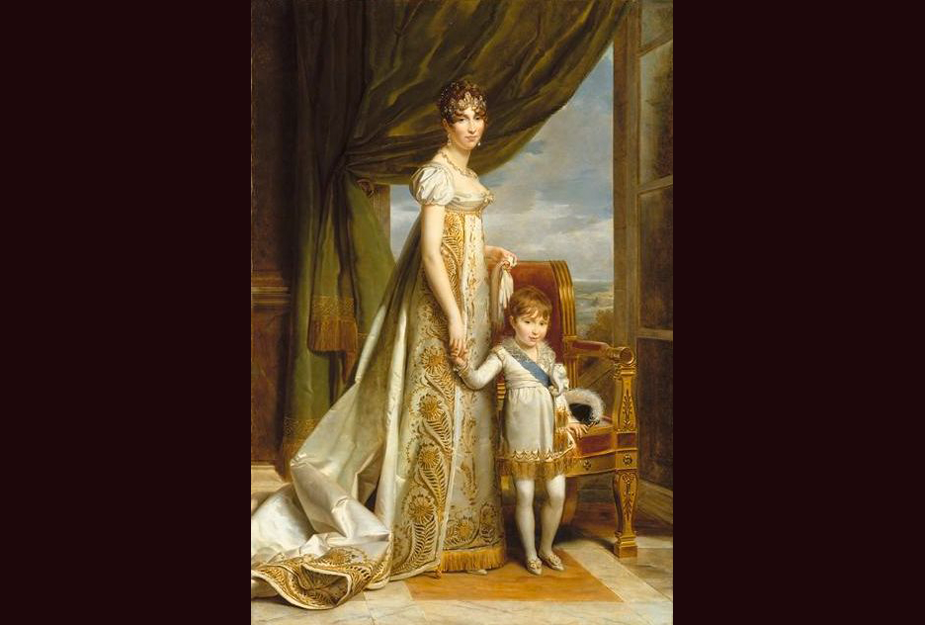
Hortense, Step Daughter of Napoleon 1st… … married Napoleon’s little brother, Louis under Napoleon’s directive. Being happily ensconced & loved by Parisian society, she did not want to move to Holland when Louis became King of Holland.
They did not get along, & spent their time avoiding each other in the large castle.
(portrait: Hortense in the height of fashion for 1808)
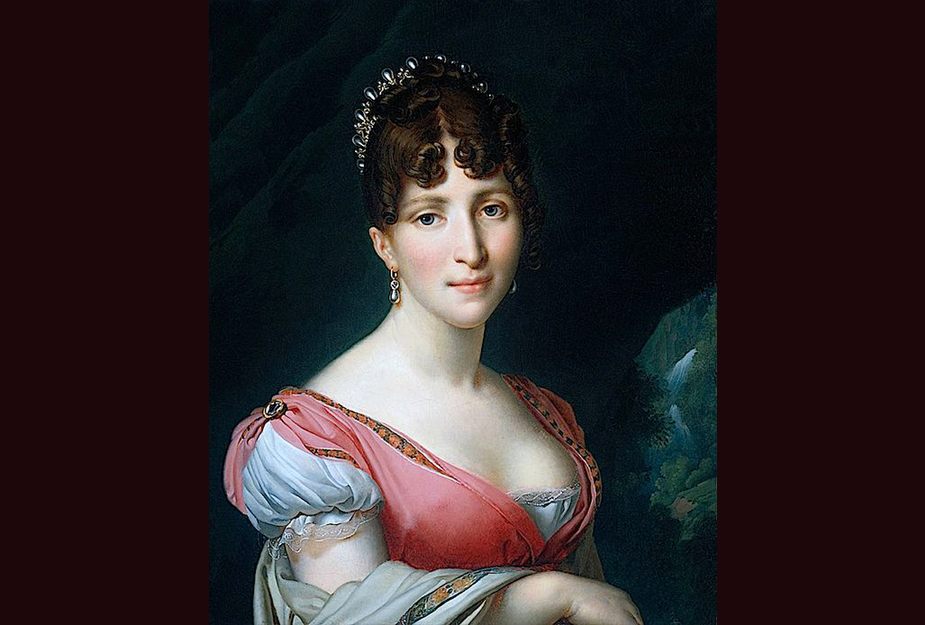
Hortense gave birth to Napoleon III… She ended up loving the country & all who lived there, & when her son, Napoleon III died as a child in 1807, she returned to France, where she was embraced back into the culture.
(portrait: Hortense daughter of Josephine who was wife then ex of Napoleon Bonaparte I. Hortense married Napoleon’s brother Louis in an unhappy marriage. She was quite the society & fashion mogul)
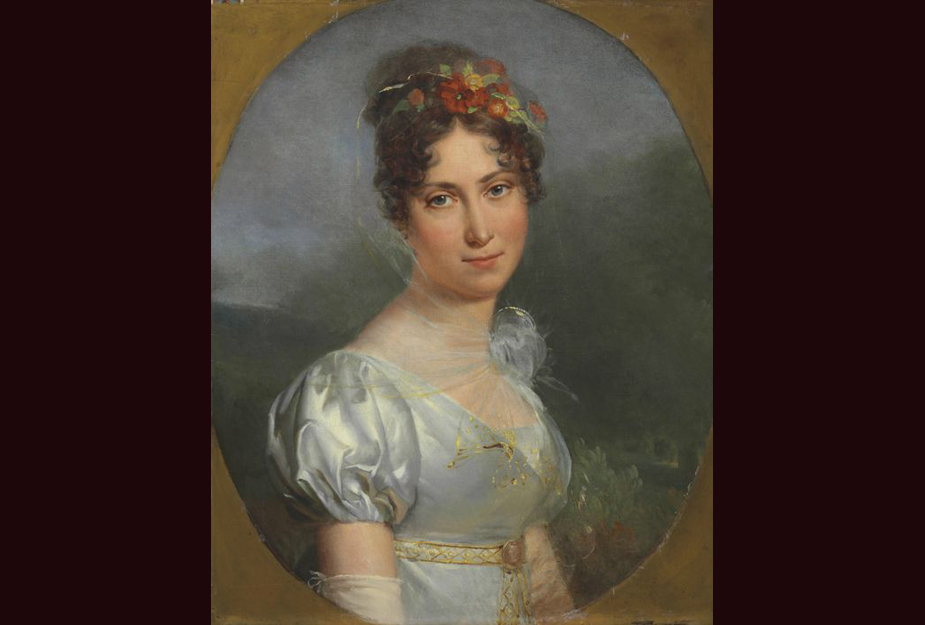
Hortense lived with Napoleon… Napoleon made her return to Holland because he did not feel it was appropriate for a step-daughter to be living with him. Instead of returning to Louis, she moved in with a count & had an illegitimate son.
At the end of Napoleon’s reign in 1814, she was given a title by the newly establish Borbon King Louis XVIII, but continued to support Napoleon’s cause until her retirement in Switzerland.
(portrait: Hortense in 1815)
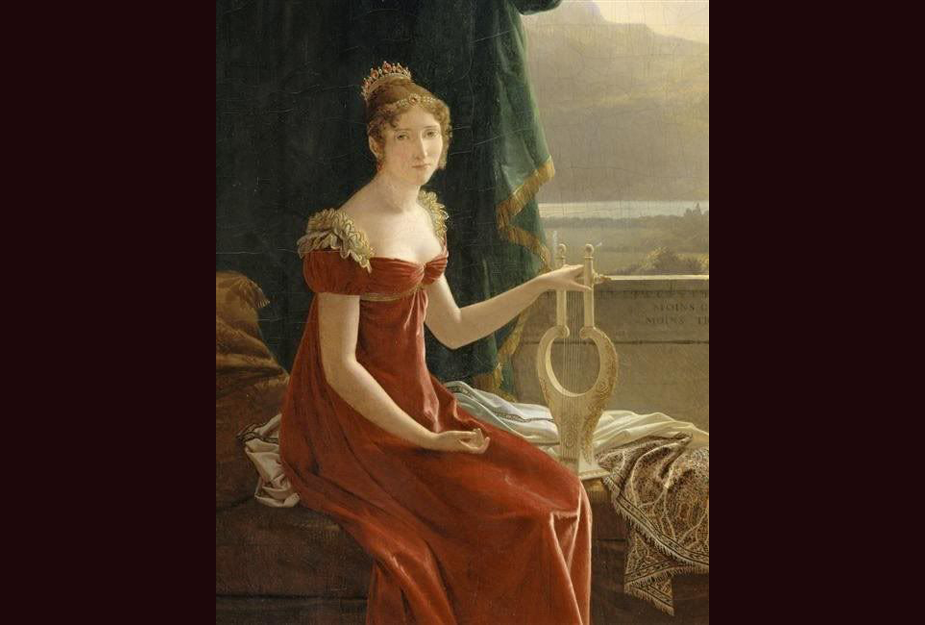
Hortense, Napoleon’s step-daughter’s fashion influence spread far… Hortense’s life crossed countries & political changes. The daughter of a somewhat “radical” fashion icon, she continued many of her mother’s fashionable ideas, while keeping them updated and new. Her influence was in the 1810’s, where her legacy was to carry high Parisienne fashion into the countries of Holland, Sweden, & Switzerland.
(portrait: Hortense the fashionable in 1818)
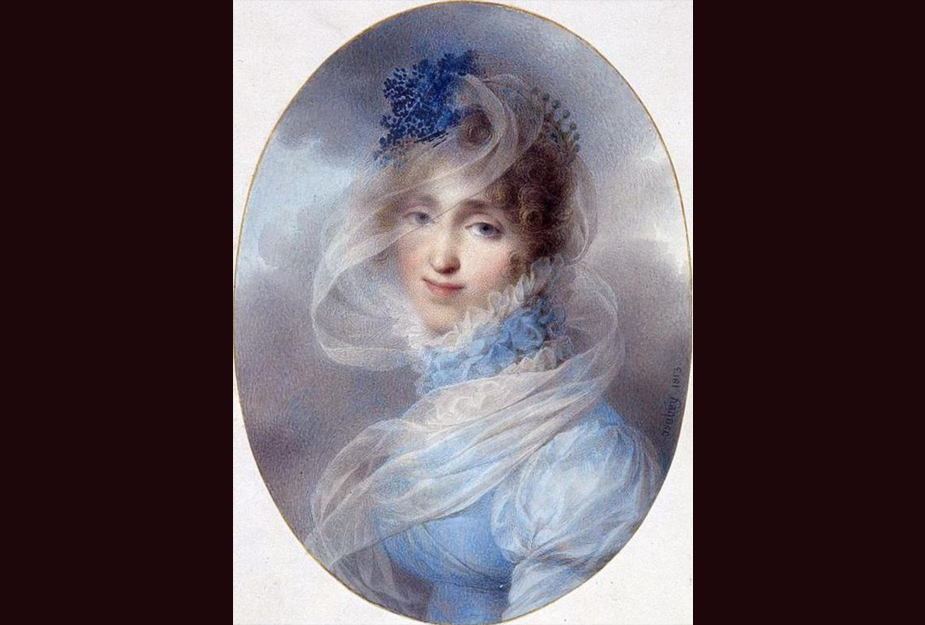
We have been discussing French Royalty for some time because… … France, led by the example or direct policy of their rulers, has guided fashion directly or indirectly for almost 200 years; much of that during the 1740-1914 eras for which we build costumes.
While America has had it’s influences on worldwide fashion, until about 1899, America was still very strongly following the French.. or the English who followed the French.. or the French who followed the Asians & Turks…
By 1900, everyone was drawing inspiration from anywhere.
(Photo: Ballet Russe costume inspires designers such as Callot Soeurs and Poiret of La Belle Epoque in France in 1910)
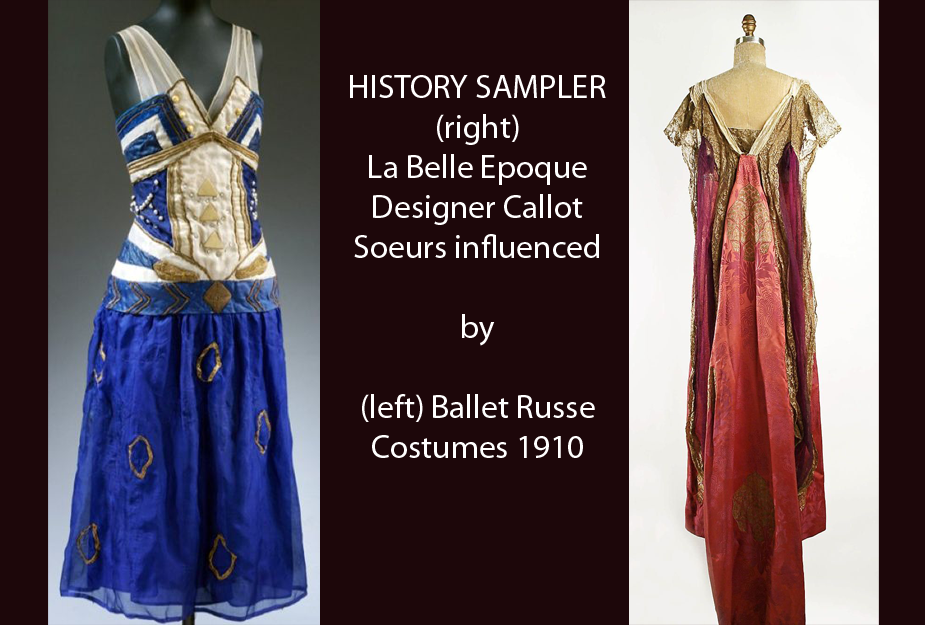
Back in France… we jump ahead of the Borbon Royalty to 1852 and a new type of Regime… … and the return of the Napoleonic era with Napoleon III. Louis-Napoleon Bonapart was the only President (1848-52) of the French Second Republic, and as Napoleon III Emperor (1852-70). He was the nephew & heir of Napoleon I. He was the first in France to be elected by popular vote.
(Real photos from the 1850’s! Napoleon III in full military dress)(Right below: Eugenie, Louis-Napoleon, & Napoleon III)
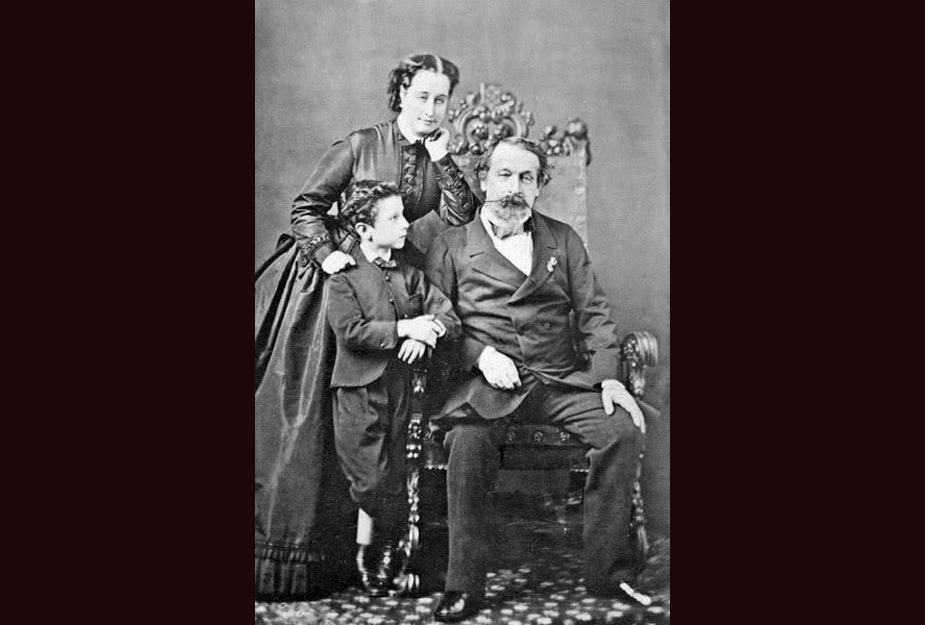
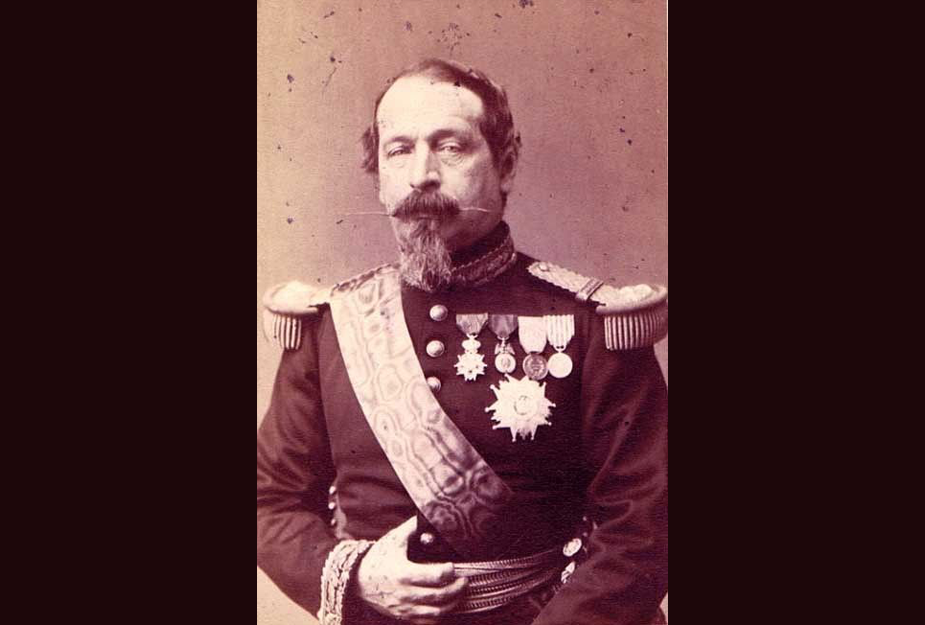
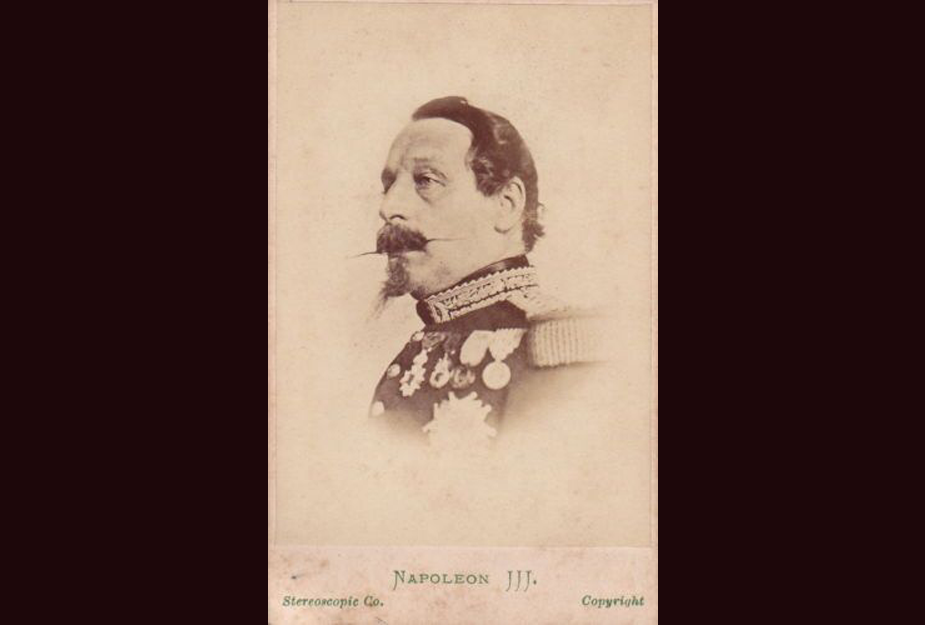
Eugenie became Napoleon III’s Empress in 1852 While Eugenie was crowned Empress in the beginning, France’s political structure went through 3 changes during her “reign”, eventually becoming a republic, with the title of “Emperess” replaced by “President’s Wife”.
(Photo: Empress Eugenie on coronation day 1852)
(Notice the dropped shoulders with fringe on her dress – a style she introduced & made popular. Check out the 1852-1867 pages on our website for fashion details from this time)
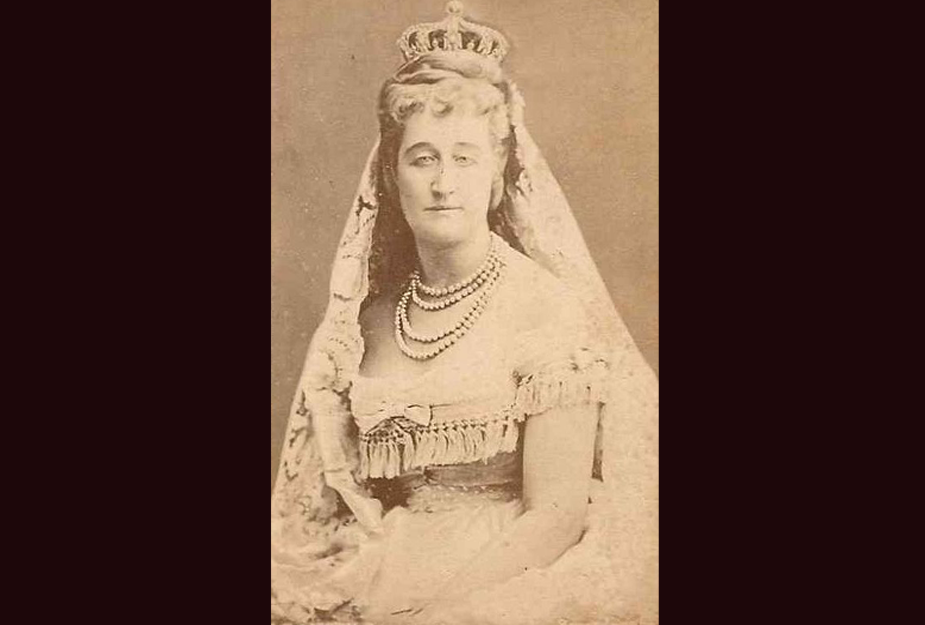
Let’s step back to get the French Bonaparte family figured out… The Bonaparte family of France continues to influence politics & fashion worldwide. We need to sort out whom is whom, because there were many with same or similar names through the generations. We’ve been discussing the ones from the first Napoleonic era, and we’re going to review them again so you can figure out who the ones we’re introducing in the 2nd Napoleonic era.
Review: Jacques-Luis David Napoleon was the first to arrive in history. The Bourbon Monarchy under King Louis XVI & Marie Antoinette had been dethroned in the French Revolution (which started in about 1793 with the Reign of Terror).
Jacques crowned himself emperor in 1804, and called himself Napoleon I. That same year he married his first wife, the quite fashionable Josephine de Beauharnais (who was part of the Marveilleuse fashion & cultural movement from 1793-1805 & had been married before with children).
To put it into perspective, Queen Victoria of England was not even born yet.
(Portraits: left to right – Napoleon 1st 1812, Josephine 1808, & Princess Victoria in 1819 who would become Queen Victoria of England much later in 1837)
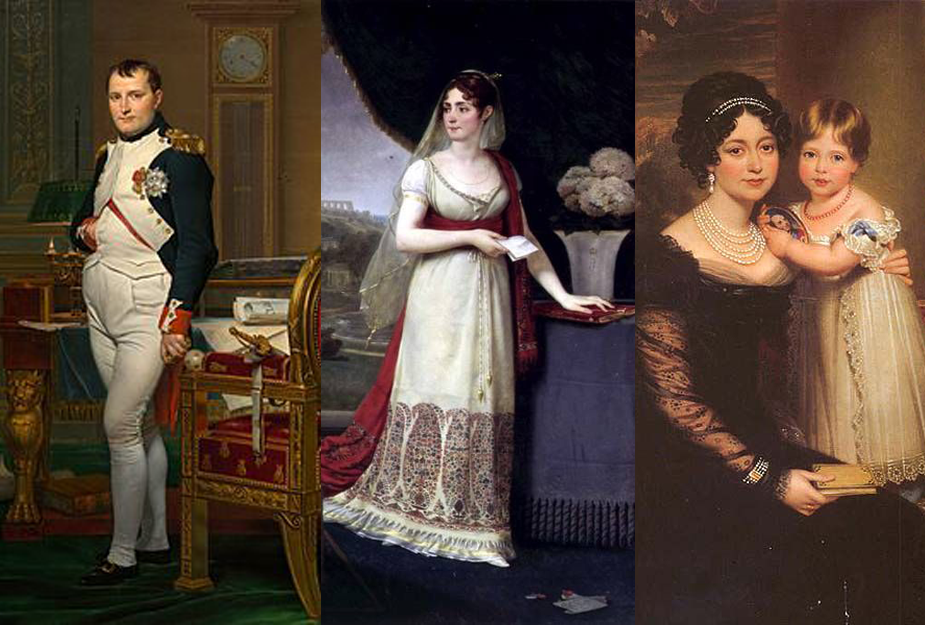
Royalty Review.. the Napoleon wives… Continuing review of names, faces, and style.. Napoleon’s little sister Caroline, convinced him to divorce his first wife Josephine, in favor of bringing in Marie Louise.
As you can see, they all liked coral tiaras. Perhaps Napoleon gave Josephine’s tiara to Marie Louise?
(Portraits 1808-1810: left – Caroline (nee Bonaparte) Murat, center – Josephine (de Beauharnais) – right Marie Louise)
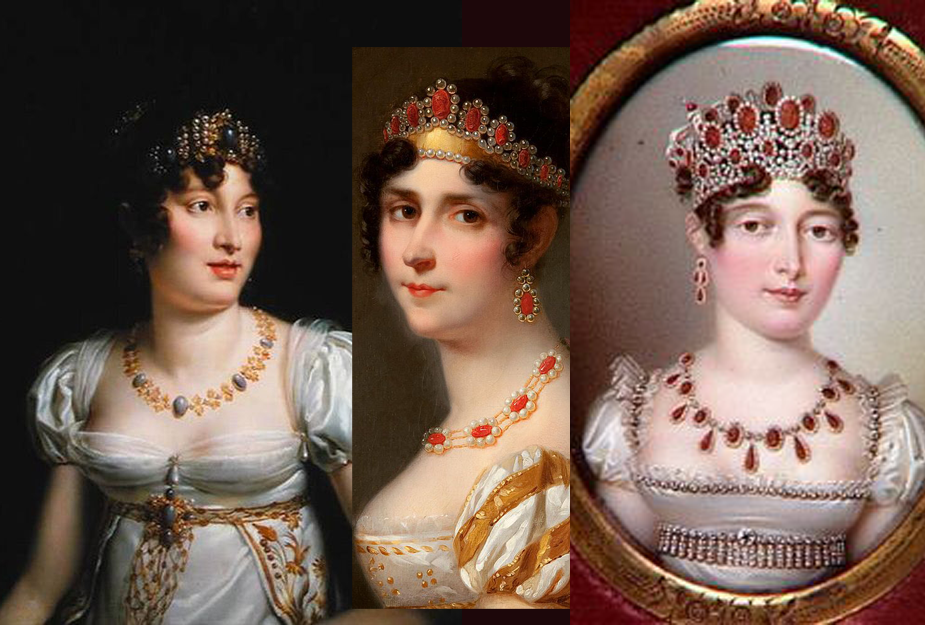
Interesting Side Note on French Royalty… FYI: Here’s a picture of Josephine’s coral tiara that sold in 2012 for $350,000,ooo. (The one she’s wearing.. the other ones were just “daily wear”).
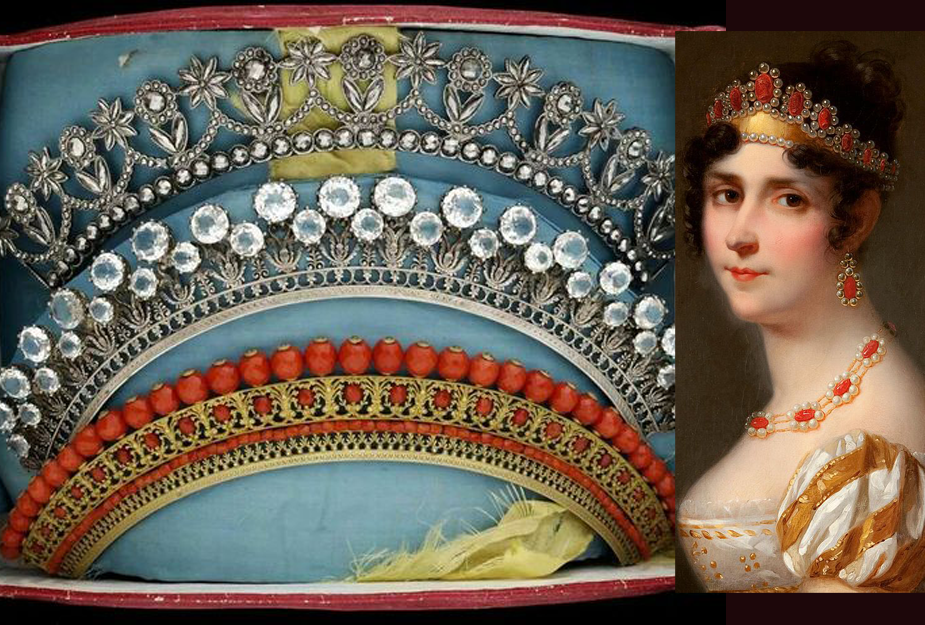
Napoleon family review.. after the wives, there was the daughter… Napoleon’s first wife, Josephine, was sent out of the country after the divorce, but her daughter from a previous marriage, Hortense Eugenie de Beauharnais remained.
(portrait: Hortense, Josephine’s daughter in about 1805, the time of Napoleon & Josephine’s coronation)
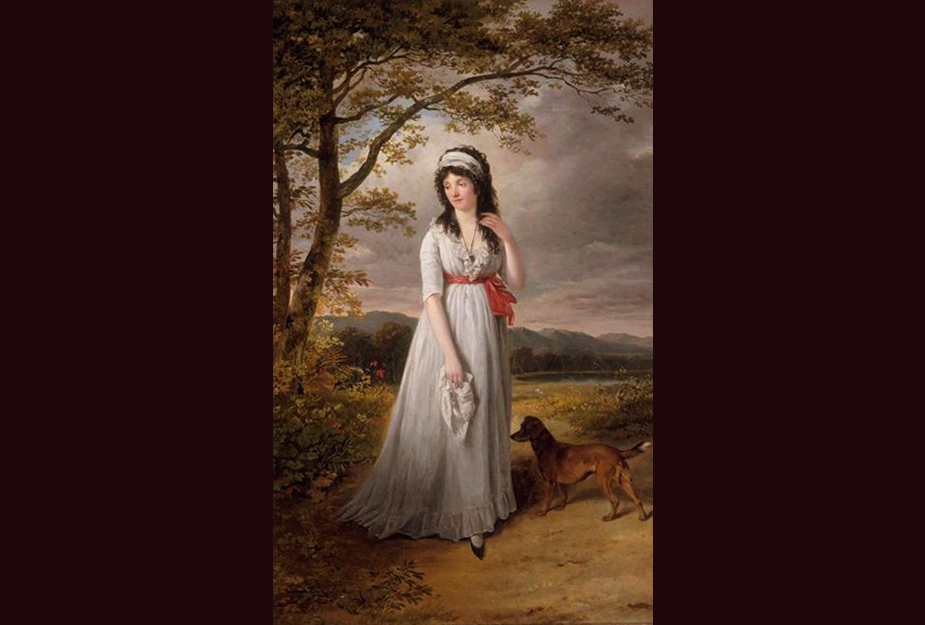
Enter Napoleon 1st’s brother, Louis Bonaparte… Napoleon was very uncomfortable with Hortense, a strong & politically charged woman, hanging around Versailles, so he arranged a marriage for her with his brother, Louis Bonaparte.
(portraits featured & below: Louis Bonaparte, Napoleon’s brother, the King of Holland, husband of Hortense)
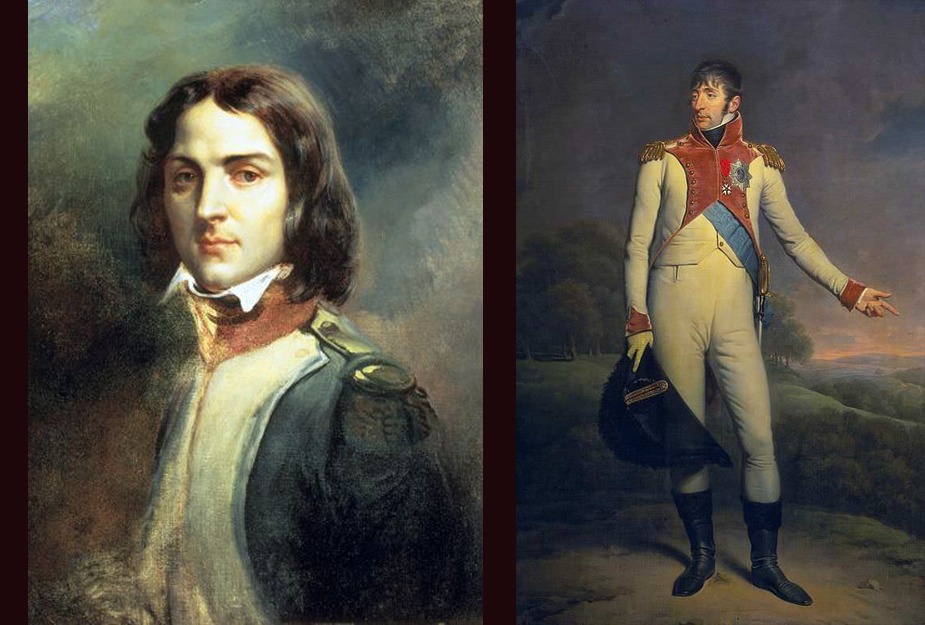
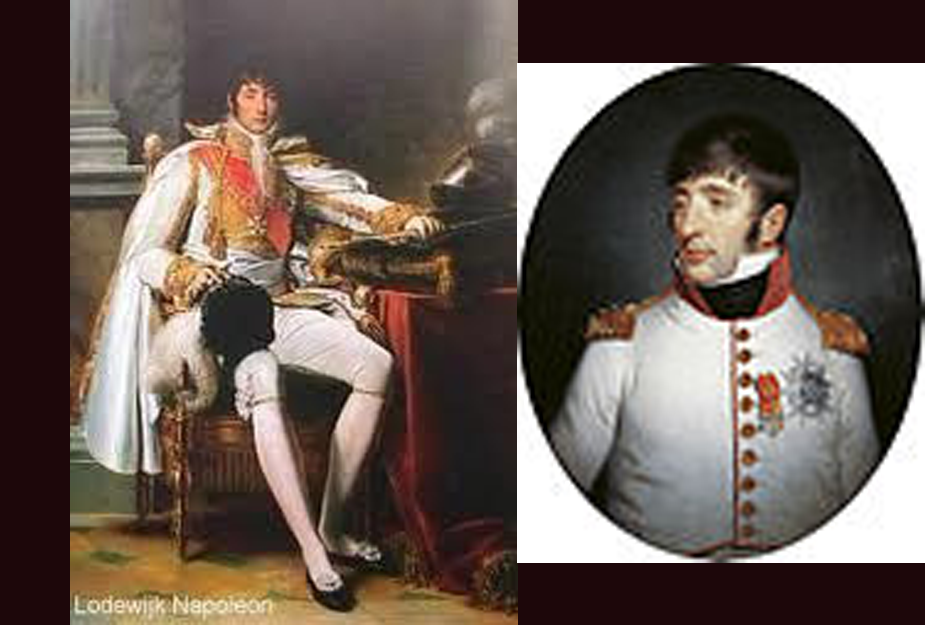
Louis, brother of Napoleon I & husband of Hortense… … was made King of Holland 1806-1810, after which Napoleon stripped him of his title because he felt he was doing a terrible job.
Louis was 24 when he married 19 year old Hortense, and they had a “difficult” marriage. They had a son who died in 1807 as a child. When she gave birth to a second son 2 months early, rumors had it the father was not Louis, but he accepted the child as his own heir without question.
The son was named Charles-Louis Napoleon Bonaparte.
(portrait: Hortense, wife of Louis Bonaparte, Napoleon’s brother, with her son Charles-Louis Bonaparte & daughter in about 1809)
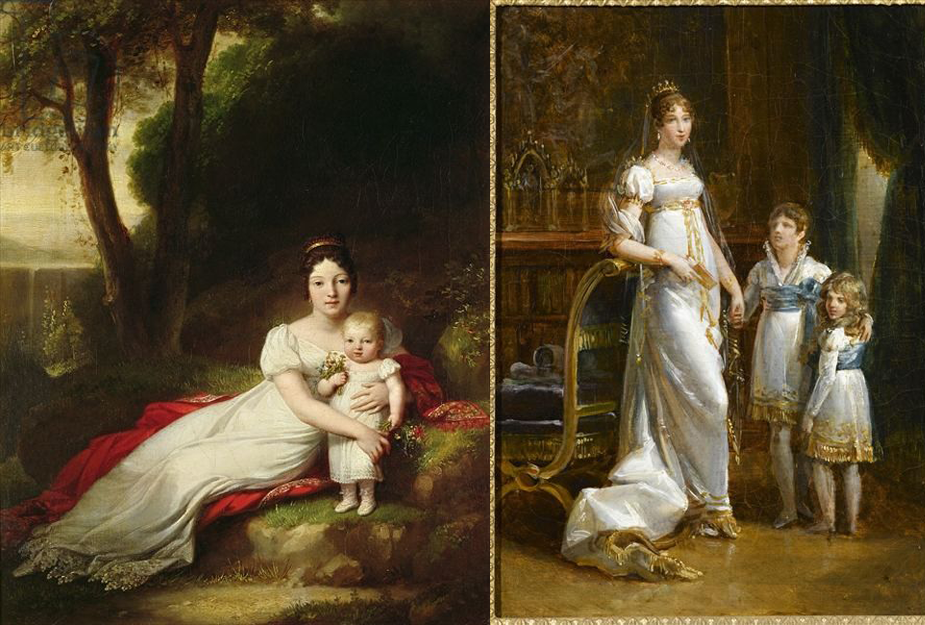
Before continuing down the Hortense family line, let’s look at her brother, Eugene… …Eugene de Beauharnais was Josephine’s other child by a previous marriage, Hortense’s brother, & the step-son of Napoleon I. His father had been guiotined in the Reign of Terror.
In 1797 & at age 15, with the country still in unrest, Eugene asked for his father’s sword. Napoleon was so impressed by his courage he took Eugene as an aide de camp to Egypt. By age 22 de Beauharnais was promoted to Colonel of the Italian army, & a general at age 24. In 1805 he was made Viceroy of Italy. He led the Italian army in the Russian campaign of 1812.
Note the military fashion which would be copied through these same years in women’s gowns.
(portraits: below: Eugene 1812 Italian general; below: featured in about 1809 in full French Empire officer’s dress)
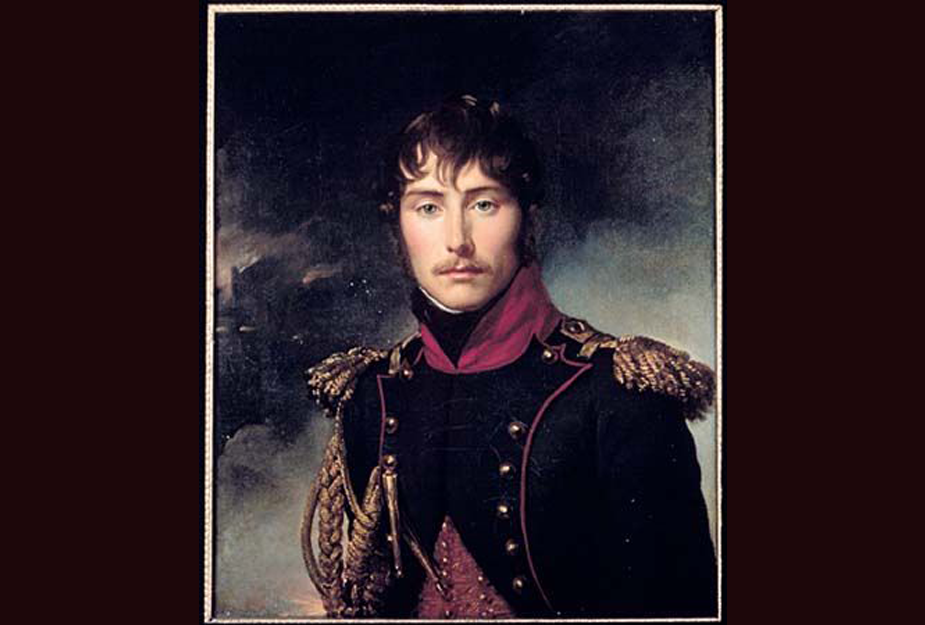
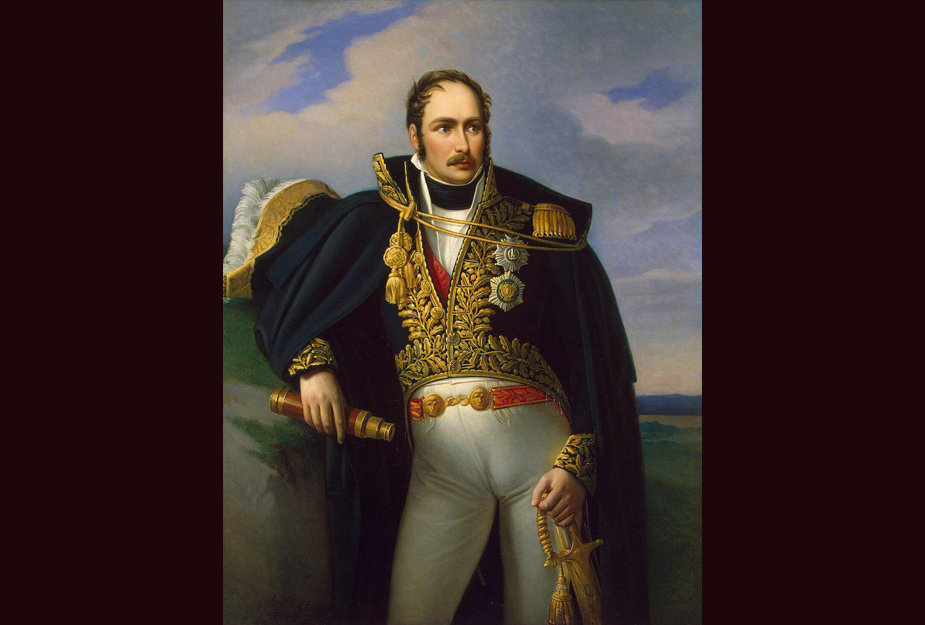
We’re still on the Napoleons.. studying his step-son Eugene… … who was the son of Empress Josephine, Napoleon 1st’s 1st wife. Napoleon matched Eugene in a political marriage with Princess Augusta Amalia Ludovika Georgia of Bavaria. (remember all these names as they’ll show up through the family tree for centuries to come).
Augusta (using the name “Amalia” often in history books) was the eldest daughter of Napoleon’s great ally, Maximillian.
(Portrait: about 1806, Augusta Amalia de Beauharnais nee Ludovika Georgia of Bavaria, wife of Napoleon I’s step-son Eugene)
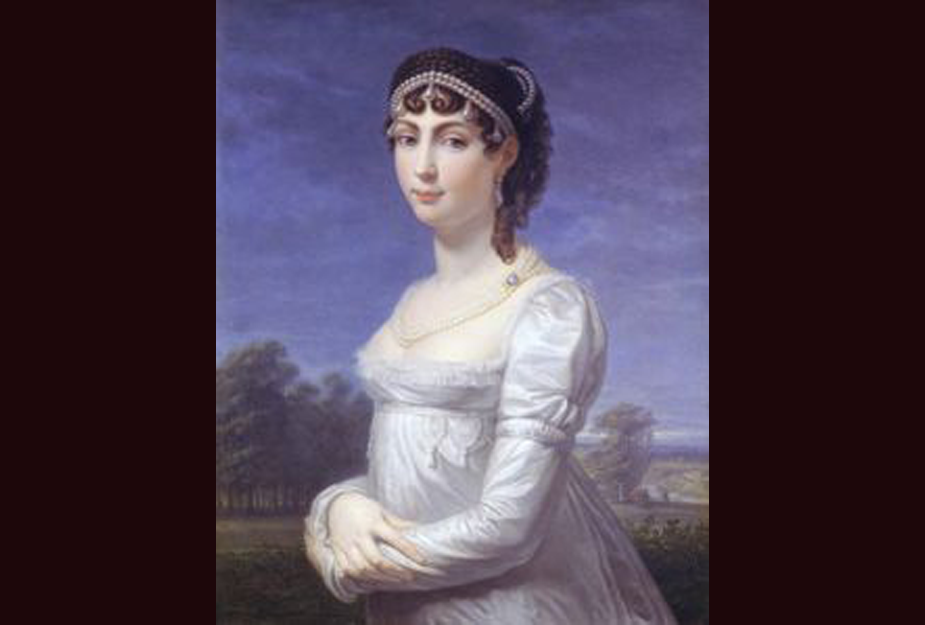
Newlyweds Eugene & Augusta Amalia de Beauharnais didn’t like each other… … at first because it was an arranged marriage, but they soon fell in love and had 7 children. 6 of those would become influential world leaders (next…). (Eugene was Napoleon Ist’s step-son)
(portrait: The lovely Augusta Amalia’s equivalent of an engagement portrait in 1806)
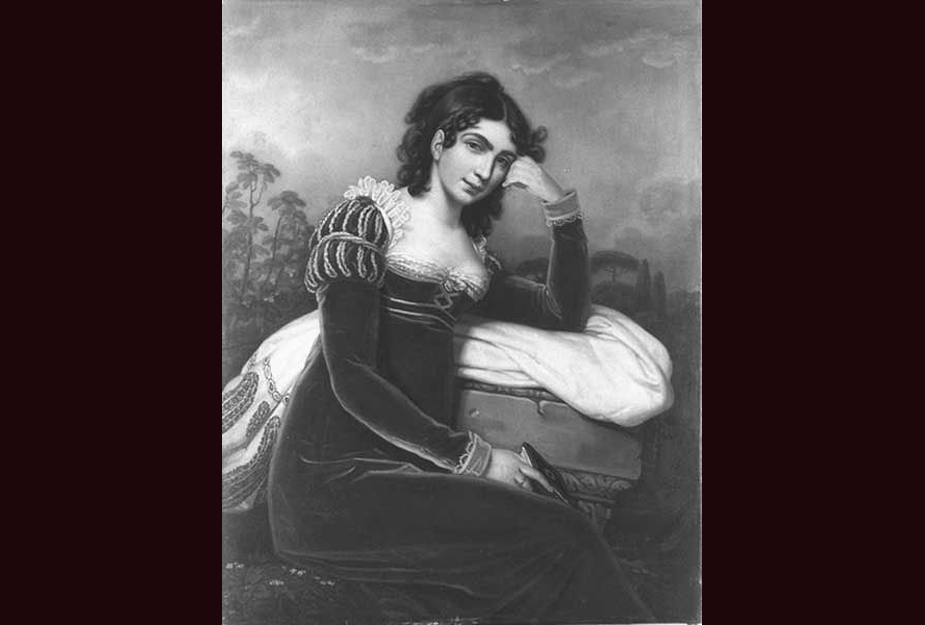
Eugene was gone a lot, fighting alongside or for Napoleon Ist… … Eugene de Beauharnais, Napoleon’s stepson, was a Colonel in Italy at age 22, and a general by 24. He led the Italian army in the 1812 Russian campaign, and was the Viceroy of Italy. He married Augusta Amalia of Bavaria.
Of his most notable accomplishments, however, was having 7 children (& grandchildren) who would become key political influences for the next 100 years.
(Portrait: Augusta Amalia in 1808 and 1817 – note that late Regency fashion!)
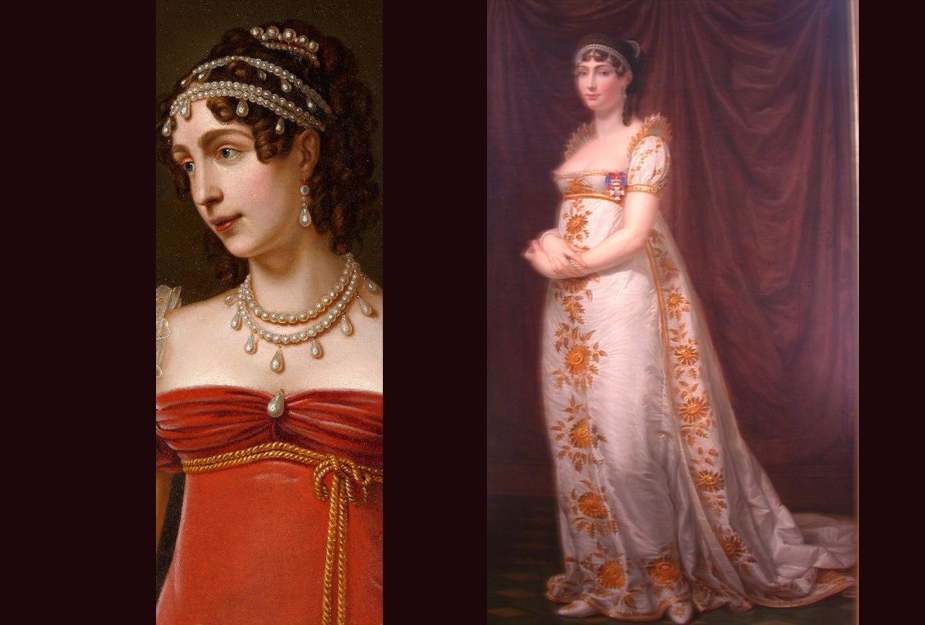
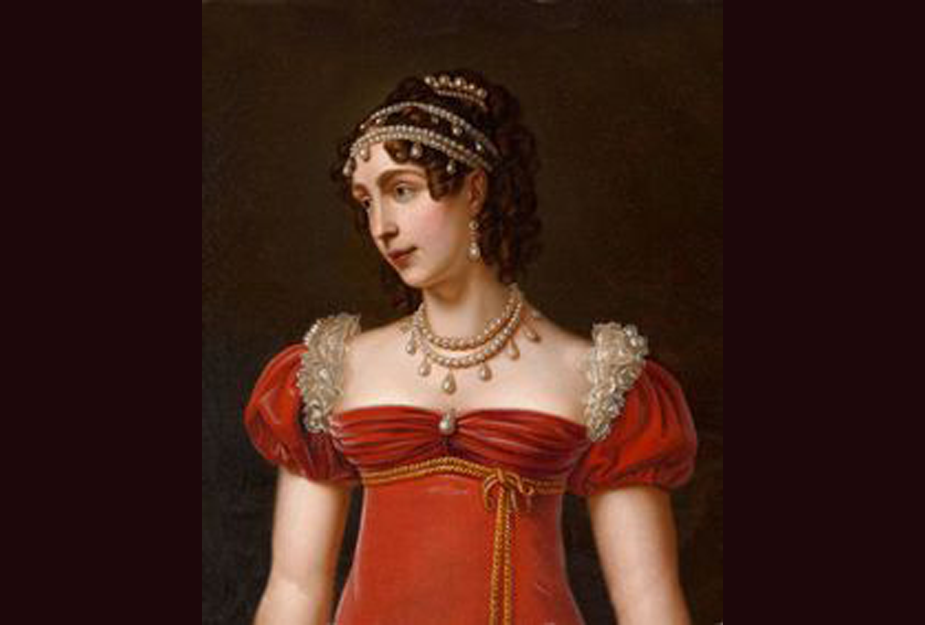
As we tell the Royal story.. watch their fashions… .. The history of fashion is told in the history books by the Royals and Notables, and in world of mouth and stories by those who were not Royal.
As these Royals would be the height of fashion in official court portraits, you can see the trends from “top down”. Because everyone was named similarly, you can tell the generations apart by their clothing.
(Example of High Fashion: 1850 Charlotte of Belgium)
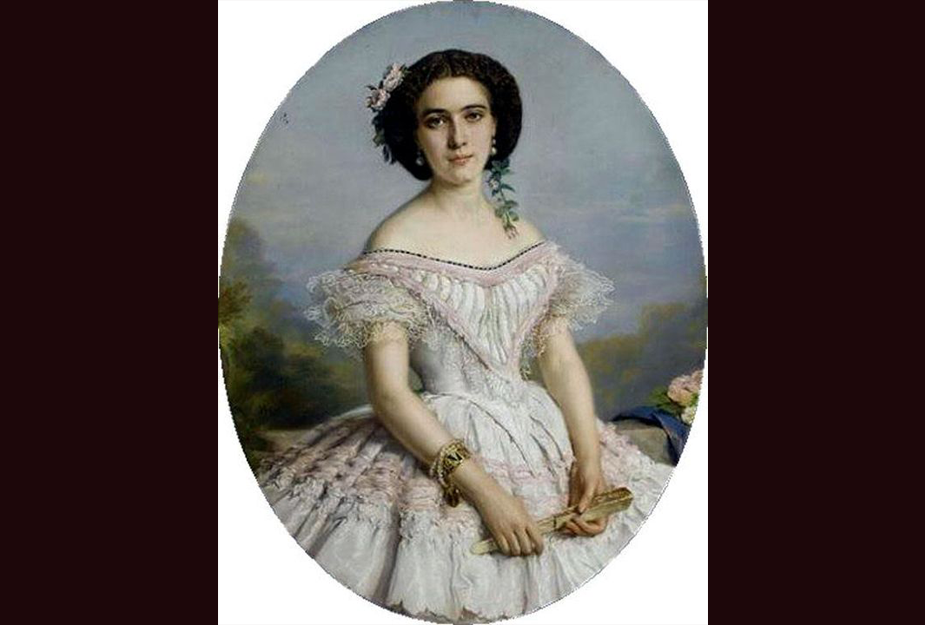
The Eugene & Augusta de Beauharnais children.. Josephine.. Eugene, step-son of Napoleon I and son of Josephine, had 7 children with wife Augusta Amalia of Bavaria.
Their first was a daughter, Josephine Maximilian (named after her maternal grandfather) Eugenie Napoleonine de Beauharnais.
She became Queen of Sweden and Norway when she married King Oscar of Sweden. Napoleon I was THRILLED with this union, because not only was King Maximilian her grandfather his best buddy, but King Oscar was the illegitimate son of Napoleon and his mistress Desiree Clary!
(portrait: Josephine, called Josefin, Queen of Sweden and Norway in the 1830’s)
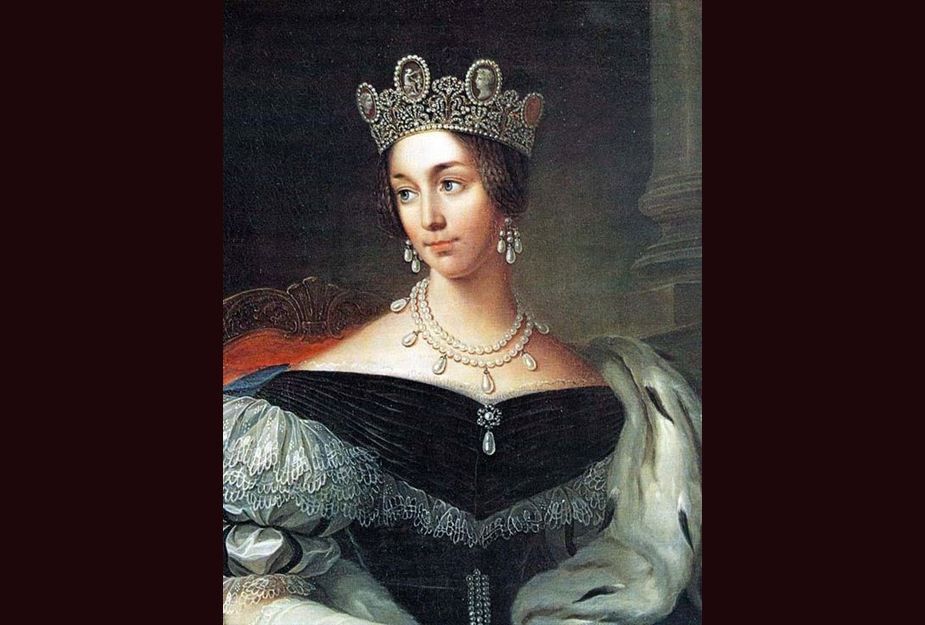
Josephine (Josefin) Queen of Sweden.. .. was always very serious about her clothing, and was beautiful & fashionable throughout her life. She was very close to her father in law, and played an active role in politics of Sweden. The Swedish people loved her (she had learned Swedish between the time she was engaged and the time she was married).
(This is a part of our study of French Royalty.. the Napoleon family. Josephine was the 1st child of Eugene de Beauharnais – son of Josephine & step-son of Napoleon I – & his wife Augusta Amalia of Bavaria – daughter of Napoleon’s buddy Maximillian)
(portrait: Queen Josefina of Sweden in the 1830’s)
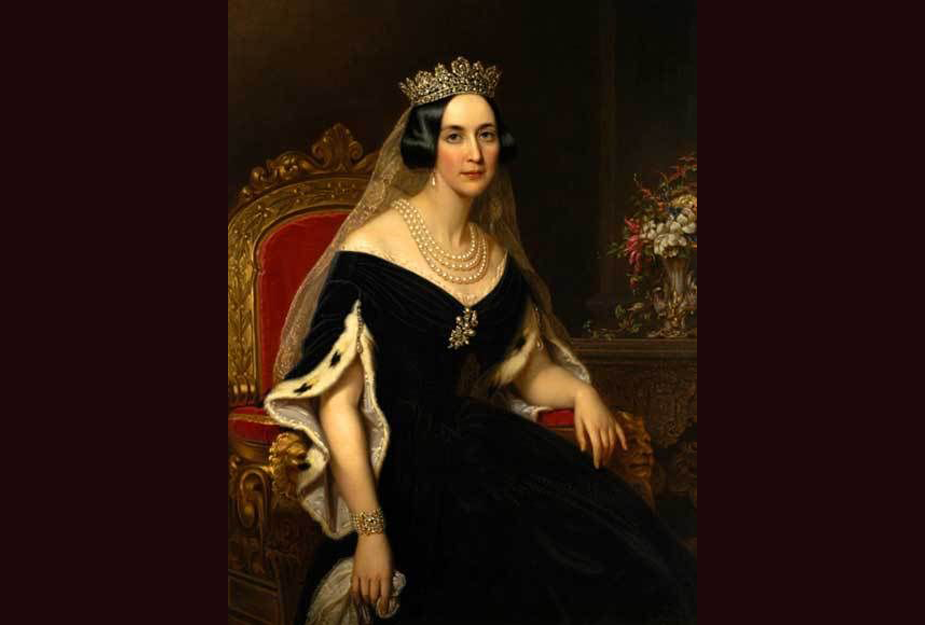
Josefina & Oscar, Queen & King of Sweden & Norway had 7 children.. .. even though they were in love in the beginning, he openly had many extramarital affairs.
(Josefina (Josephine) was the first born and first daughter of Eugene & Augusta de Beauharnais, step-son of Napoleon I in this study of the Napoleon family of fashion)
(portrait: 1827 the Royal Swedish family with Josefin in white)
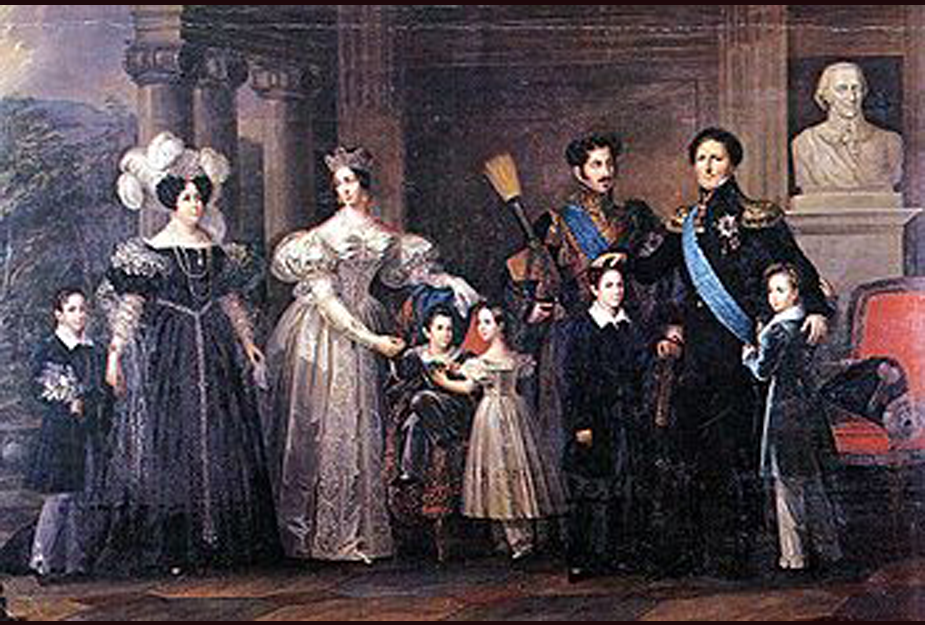
Josephine, step-daughter of Napoleon 1st, Queen of Sweden… . was a patron of painters, and was part of the political struggles in Norway and Sweden regarding Catholicism vs Protestantism. Because Sweden fought against France, the “Napoleonine” part of her name was removed forever.
When her husband, King Oscar died in 1858, she became the Dowager Queen, and no longer could participate in politics, so she spent her years as a patron of the arts and sciences.
(portraits: featured: Queen Josefin in the 1860’s; below 1874)
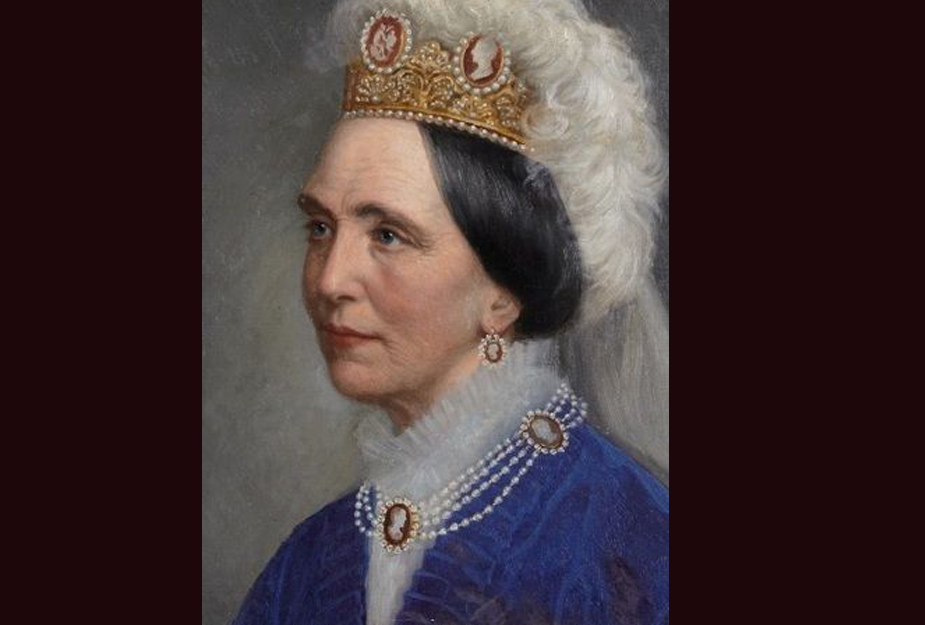
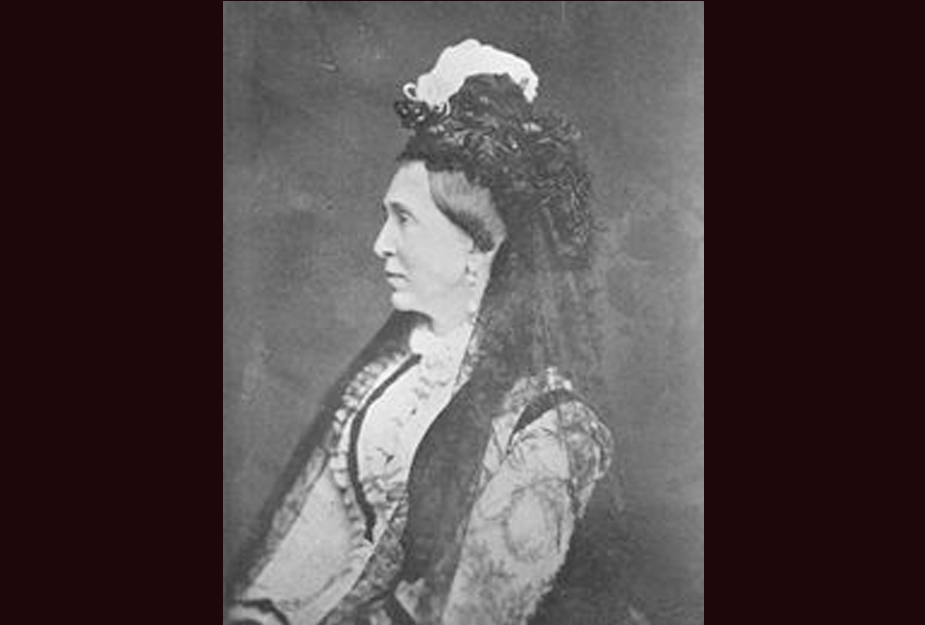
The 2nd child & 2nd Daughter of Eugene & Augusta (son-law of Napoleon I).. … was Eugenie Hortense Auguste de Beauharnais. She married the Prince of Prussia, Constantine Hohenxollern-Hechinger to become Princess of Prussia.
They built the lovely Villa Eugenia for her in Hechingen. In 1843, Eugenie was well known for her patronage of music & musicians. Hechingen had a lovely vocal choir, and she would often invite composer Franz Liszt to perform at the Villa.
Constantine & Eugenie had no children, so Eugenie became increasingly pious through the years & spent her time building a home for the elderly and a “little town” for children that was basically the predecessor of today’s daycare for working parents.
She helped her father-in-law through his war injuries & illness, & herself contracted tuberculosis, from which she eventually died. The doctors tried to save her by burning manure chips on her chest, & isolating her from all people.
(Feature: Eugenie, 2nd child of Eugene & Auguste (son-law of Napoleon I); below: a bust of Eugenie in Hechingen, and her beloved Villa Eugenia)
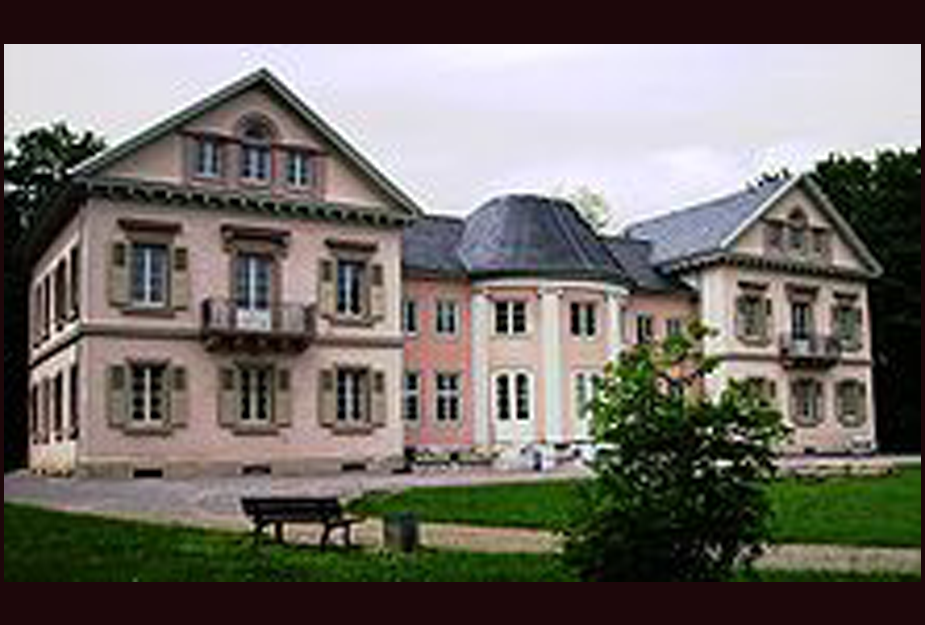
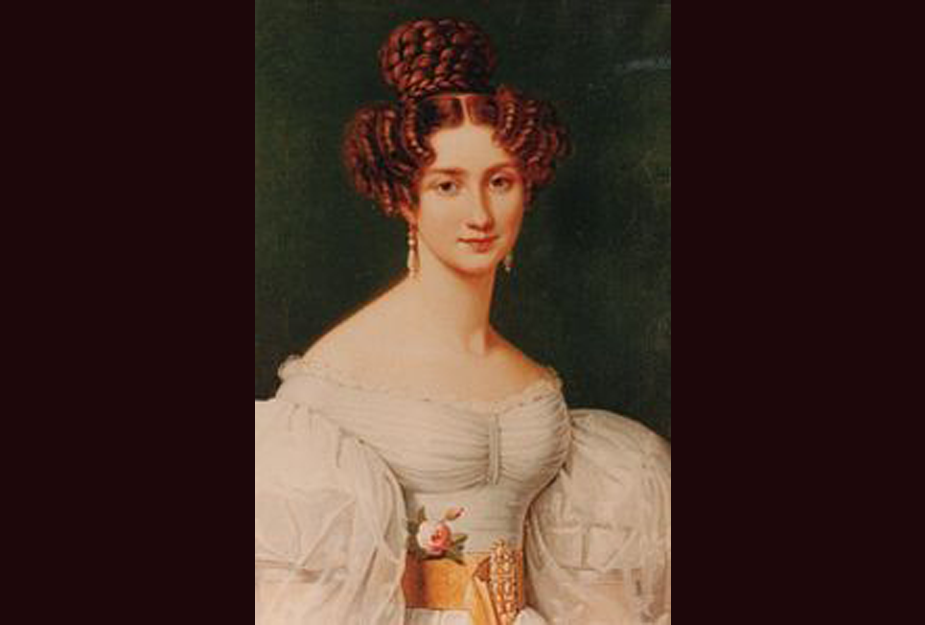
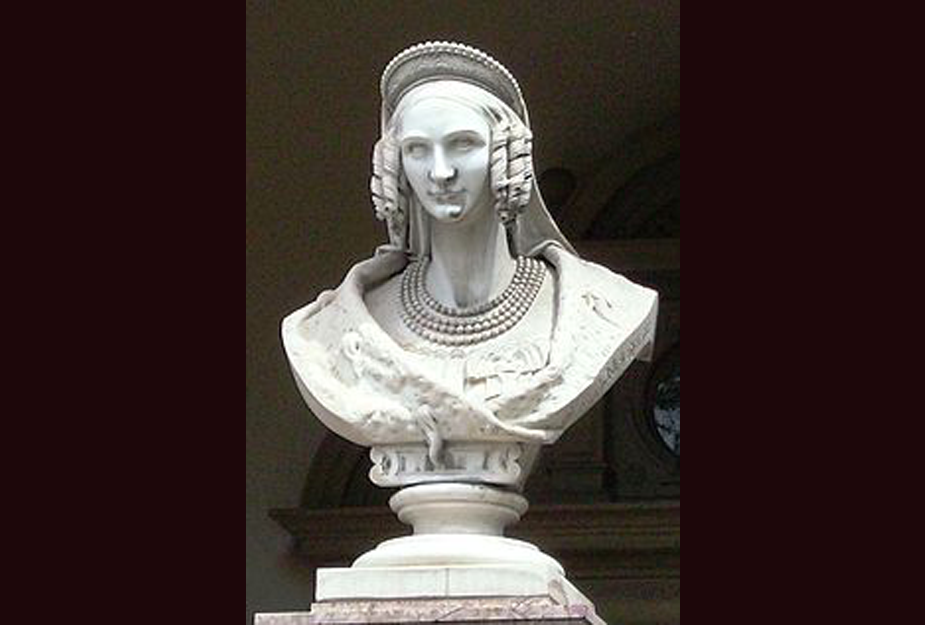
Amelie Auguste was trained by her mother, Augusta Amalia… .. to be the perfect stepmother to the children of her husband Pedro of Brazil. Her mother taught her not to be “timid”. They had a good marriage.
She educated his children herself, including his eldest daughter Maria II who would become Queen of Brazil and a match for Amelie’s big brother, Auguste Charles. At the time Amelie came over on a ship to Brazil, Maria II was only 10 years old.
Amelie would also be asked to raise the illegitimate children of her husband, and to share her pension with them after his death.
(portraits: Amelie Auguste, Princess of Leuchtenberg who became Duchess of Bragenza and Consort to the King of Brazil in about 1840; below their wedding ceremony)
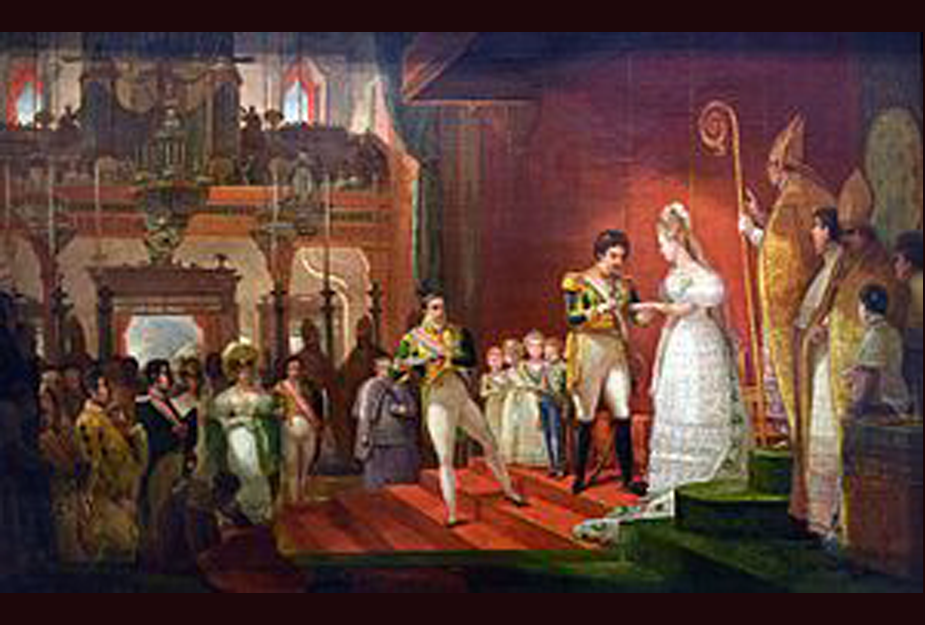
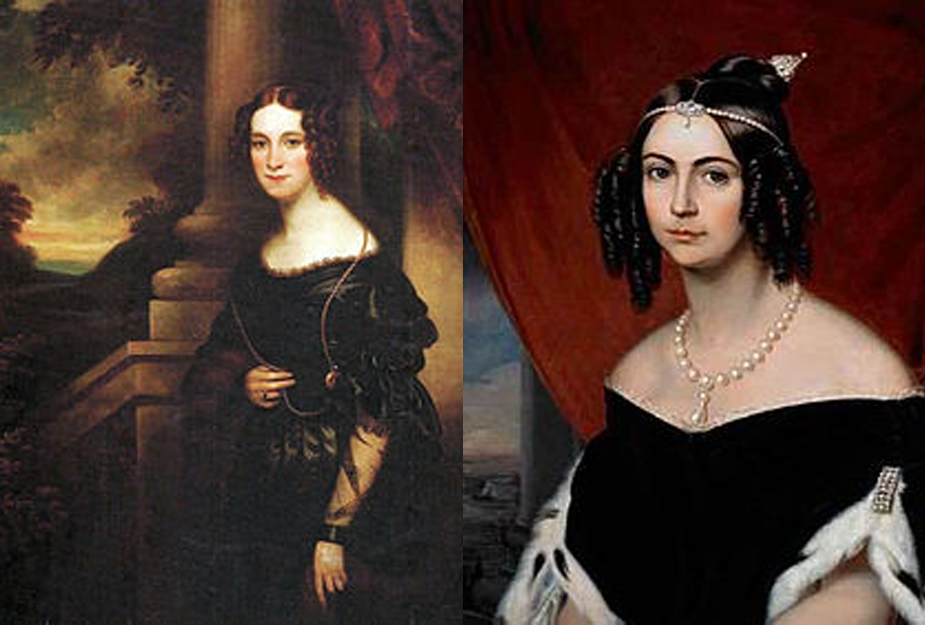
Prince Auguste Charles Eugene Napoleon I was the 3rd child… … and first son and heir to Eugene de Beauharnais & Augusta Amalia of Bavaria (Napoloen’s step-son). Napoleon I had adopted & made his father the “heir presumptive” to the French throne. Both were named Dukes of Leuchtenberg.
Auguste suceeded his father as Duke of Leuchtenberg & Prince of Eichstatt in 1824. When his little sister Amelie (next in line) married by proxy Pedro, the King of Brazil, Auguste accompanied her to that country to watch her become Pedro’s 2nd wife.
Auguste & Pedro became good friends, and Pedro mad him the Duke of Santa Cruz in 1820. He also arranged a marriage between Auguste & his first daughter, Maria.
Maria was 15 years old, & Auguste was 24 when they were married. She became Queen Maria II of Portugal, but he never became king. He died just 2 months after their wedding, childless.
Because there was no heir, Auguste’s youngest brother Maximillian took over as heir presumptive & the Dukedom. Maria remarried, & her 2nd husband became King.
(Feature: Auguste & Maria II Queen of Portugal; below, Auguste & Maria)
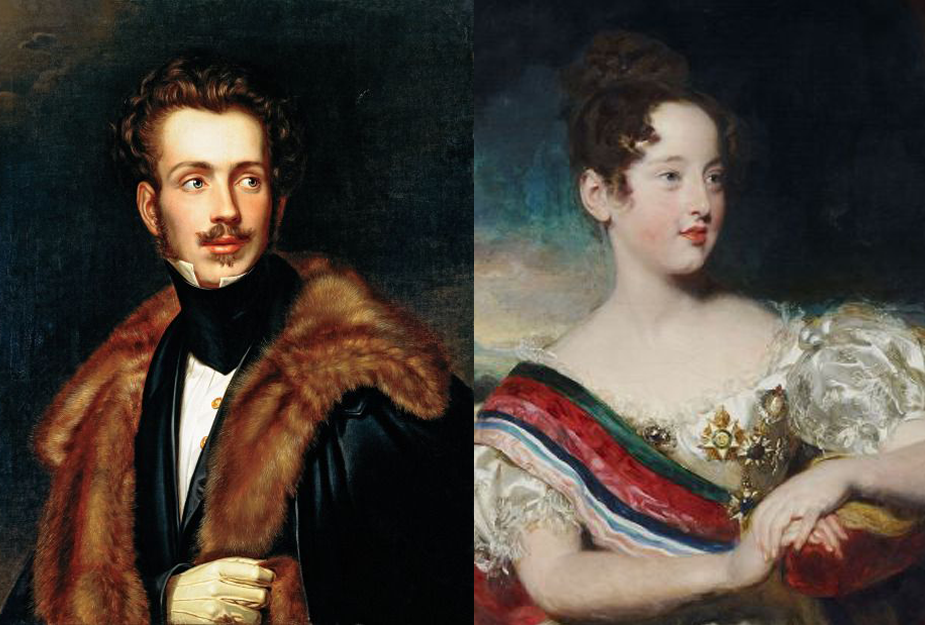
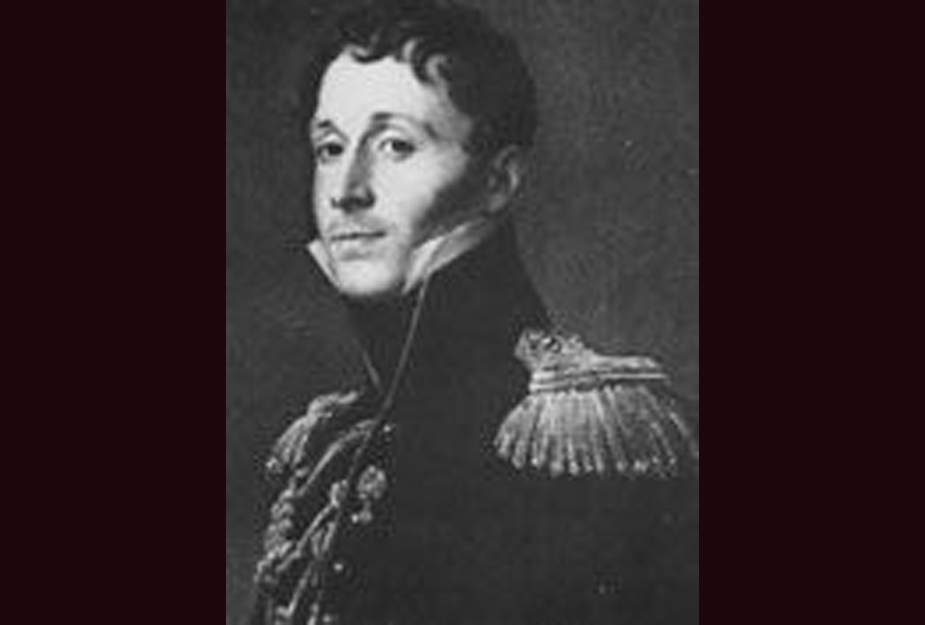
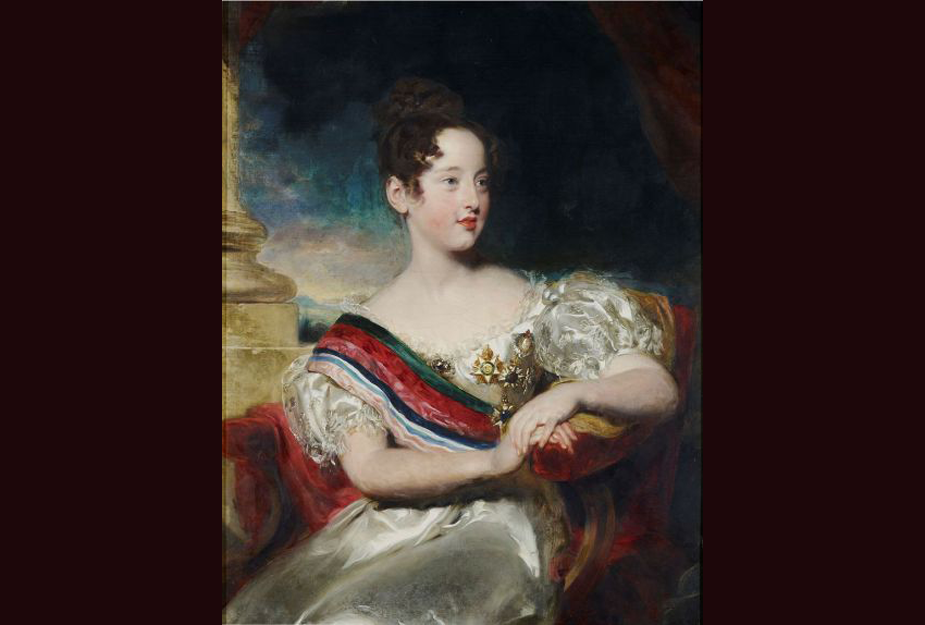
In our discussion of French Royalty; family of Napoleon… … we are in the 1820’s-1830’s going chronologically through the 7 children of Eugene de Beauharnais & Augusta Amalia of Bavaria, Napoleon 1’st’s adopted stepson & son of his 1st wife Josephine.
These portraits are 1810.. so out of style from what we will see their children wearing.
Note how all the royals remain at the HEIGHT of current fashion, especially wearing formal – what used to be “court” – dress.
(Portraits: Eugene & Augusta Amalia of Bavaria, parents of those we are discussion)
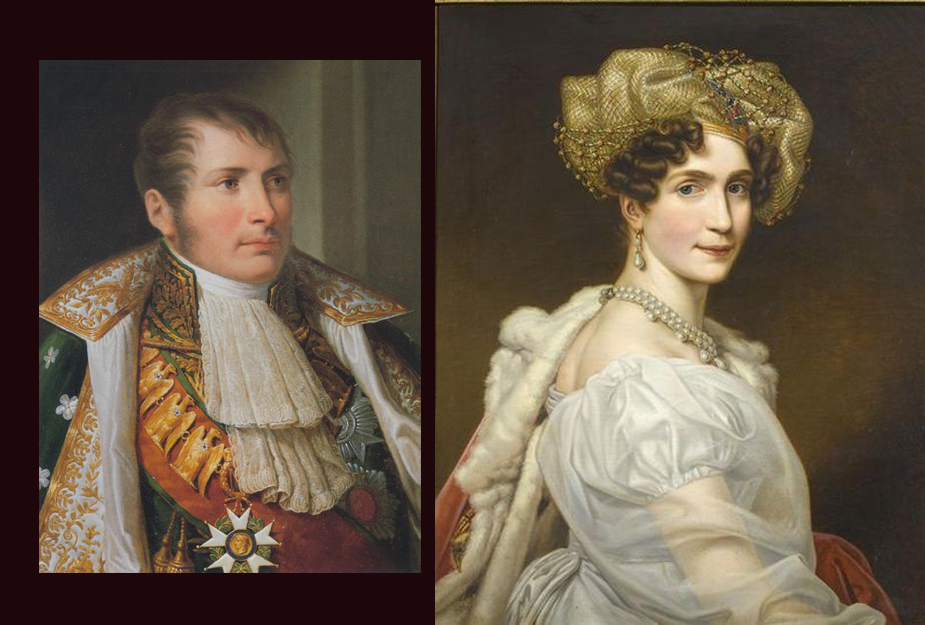
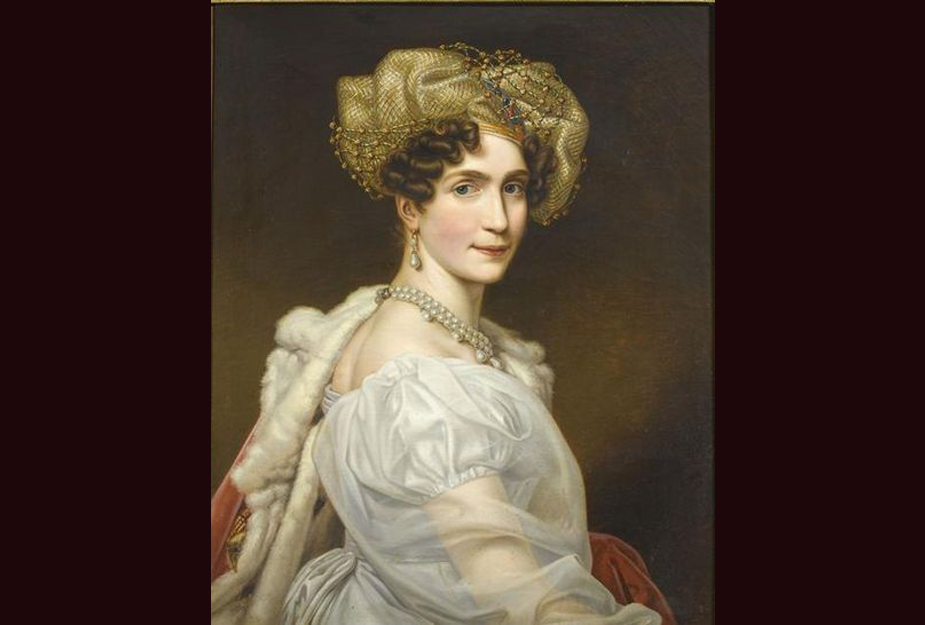
A few more portraits of the parents, Eugene & Augusta… … Amalia who came from Bavaria to marry. The stepson of Napoleon Bonaparte, Eugene was the “heir apparent” to the French throne, but never made it because of Napoleon’s defeat at Waterloo, after which all were stripped of their titles & forced into real or figurative exile alongside Napoleon I.
(Portraits: 1805-1815, Regency fashion & Italian military uniform)
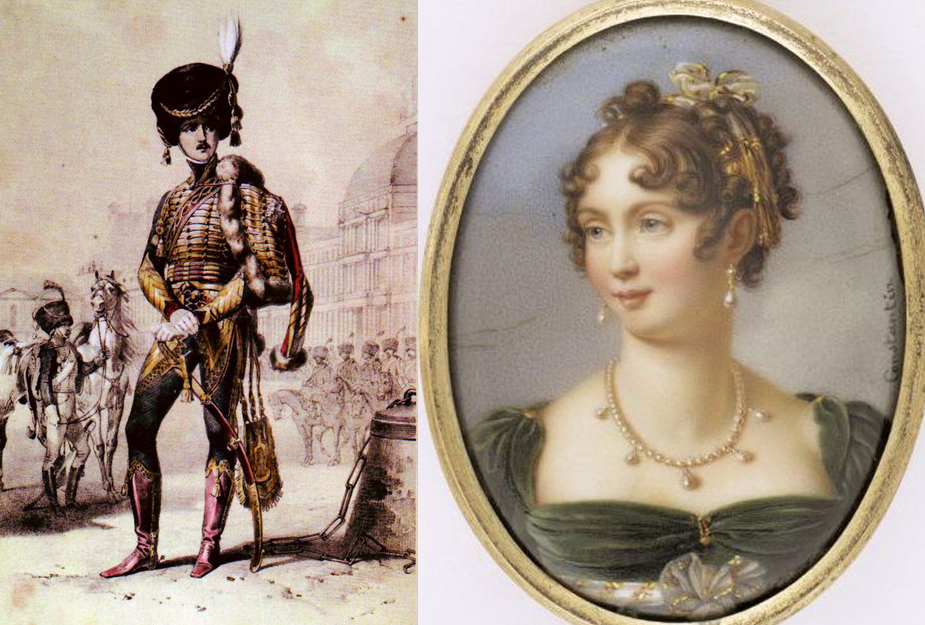
Parents Eugene & Augusta Amalia Eugene was the Viceroy of Italy, & led the Italian army in support of Napoleon. Augusta Amalia came from Bavarian royal heritage.
(Featured portrait: Eugene as the young Italian Colonel at age 22; Augusta (below) in the early 1830’s)
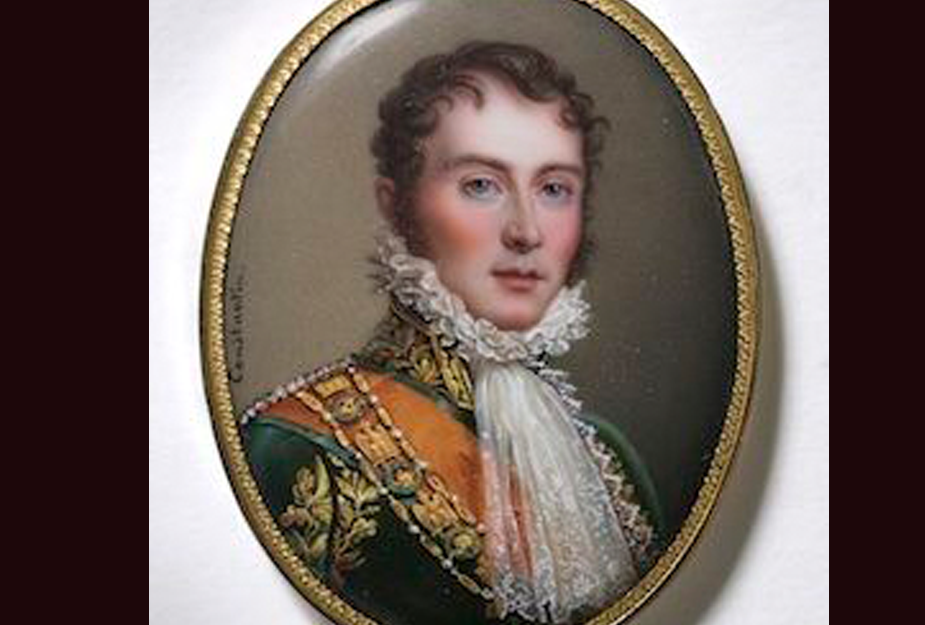
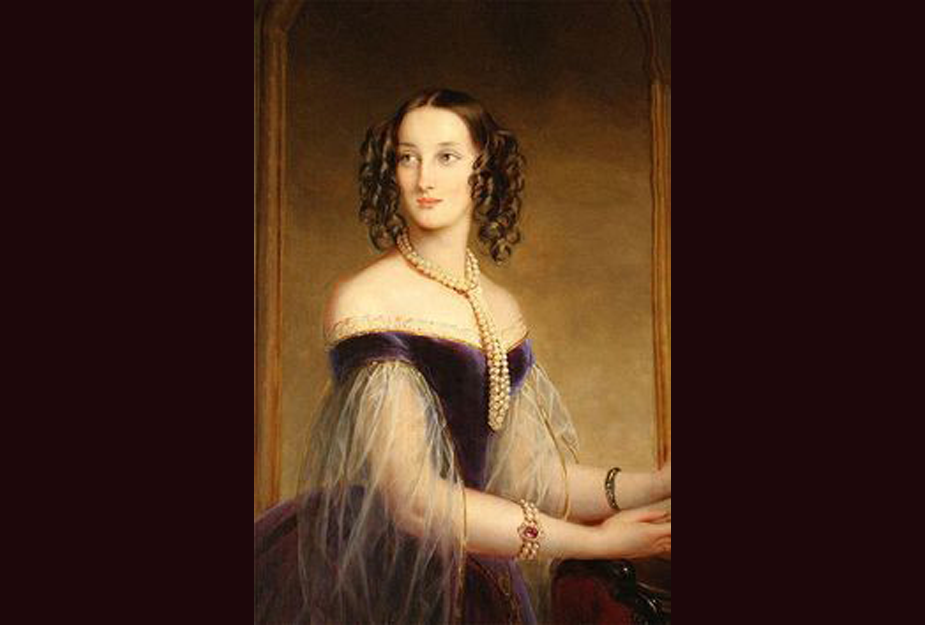
Augusta Amalia of Bavaria again.. .. on top of fashion, her style went through 3 Regency eras into early Victorian. Here she is shown in 1815
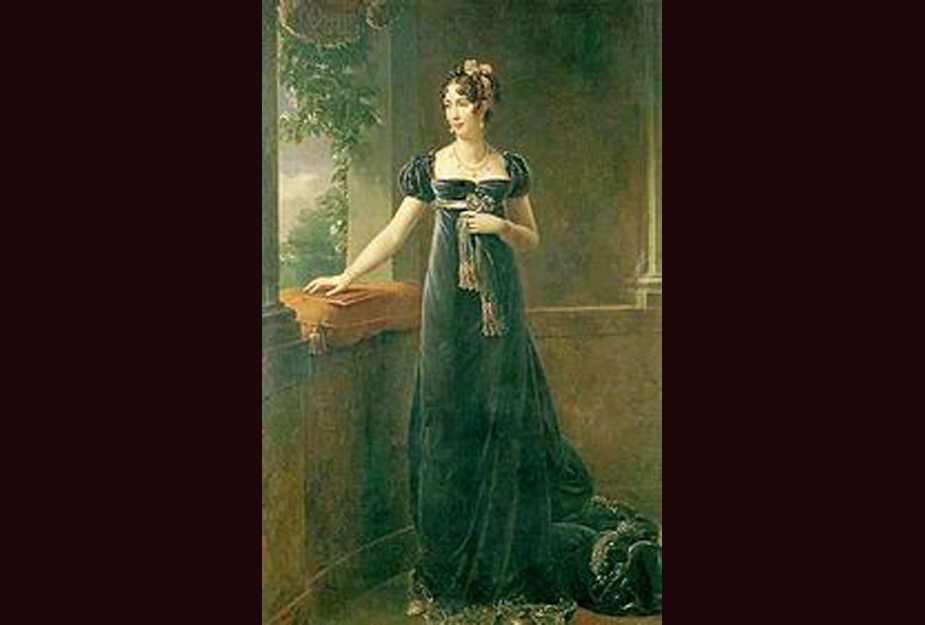
A quick peek at Josephine at the time… Josephine, 1st wife of Napoleon I, was setting the fashion in 1815. She had the empress tiaras that no one else had, though.
(Josephine was discussed last month – scroll through to see the interesting story of she and Napoleon 1st and her amazing fashion)
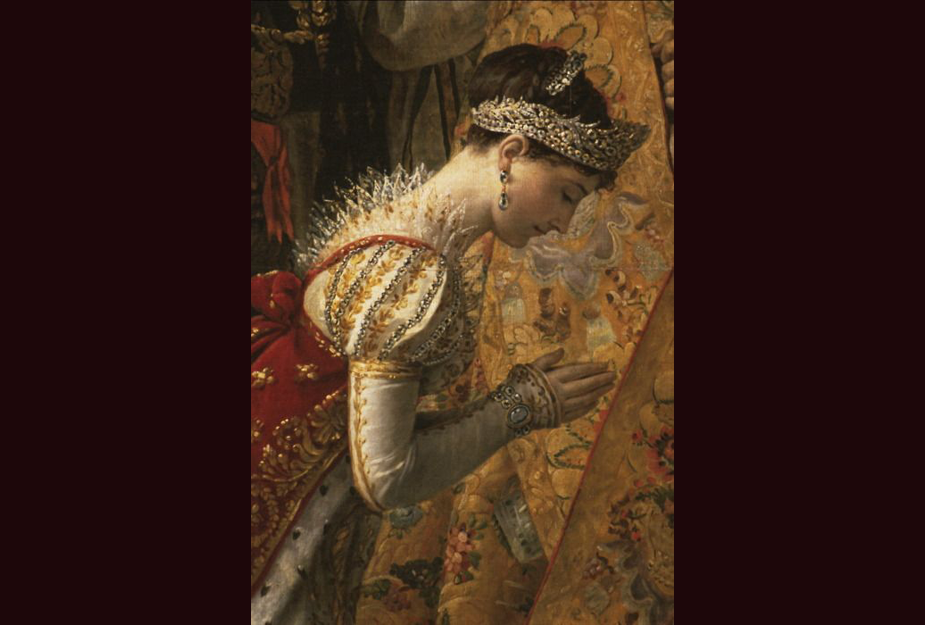
Back to the de Beauharnais children… #4 was daughter… … Amelie Auguste Eugenie Napoleon de Beauharnais (4th child; 3rd daughter of Eugene & Augusta Amalia).
You can see why we’re going carefully through this. The names all seem the same, and the generations get confusing. It’s important to know who these people are, because they all come back together in the future to tie France, England, Prussia (Russia), & many other countries. Within 3 generations most European and South American royals would be related by blood.
(Portrait: introducing Amelie Auguste… 4th child of Eugene & Augusta.. granddaughter of Napoleon I)
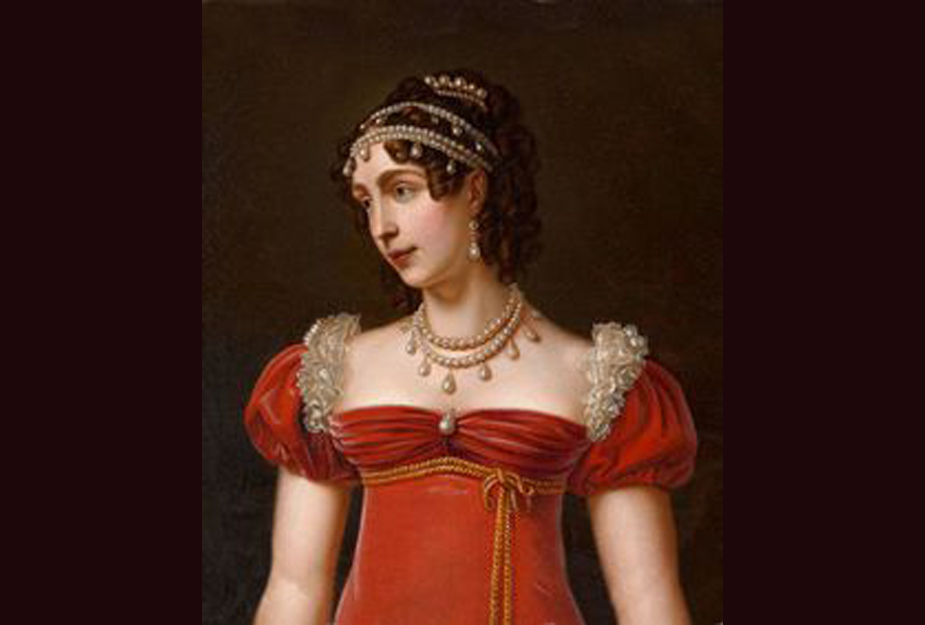
Amelie Auguste Eugenie Napoleon de Beauharnais… … was required to drop the “Napoleon” part of her name after her marriage to Pedro of Brazil at ag3 15. She was the 4th child & 3rd daughter of Eugene (stepson of Napoleon I) and Augusta Amalia of Bavaria.
Her mother, being of royal blood, trained her carefully to be a princess and queen. King Pedro was hesitant to marry her, because her father came from “just” a military man, but overlooked it eventually because he found her “tall, beautifully proportioned, with a delicate face.”
He claimed she had a “physical air like a painter.”
(Portrait: Amelie Auguste was only 15 when she became the 2nd wife of Pedro of Brazil. This portrait in 1849)
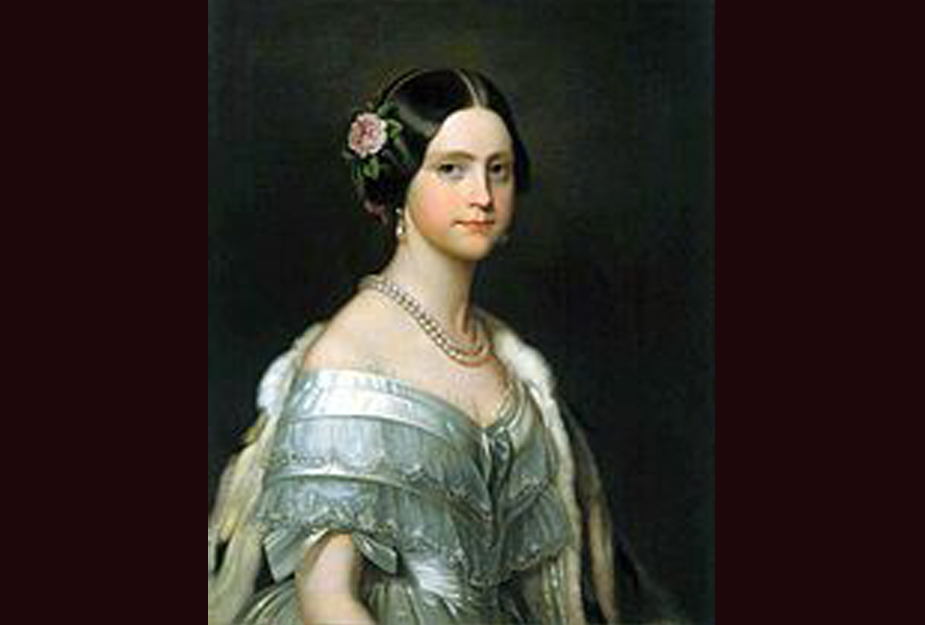
Amelie Auguste & Pedro of Brazil had 1 daughter.. .. of their own legitimately, although Amelie adopted his daughter Maria as her own, & raised and educated her personally. They had a happy marriage.
They had only the one child, Maria Amelia, before King Pedro died of tuberculosis after fighting his brother for title and rights. Maria Amelia became a great musician, but unfortunately also died of TB at the age of 22 without having married or had children.
(Portrait: Amelie Auguste, granddaughter of Josephine, daughter of Augusta Amalia & Eugene with her daughter Maria Amelia in 1840)
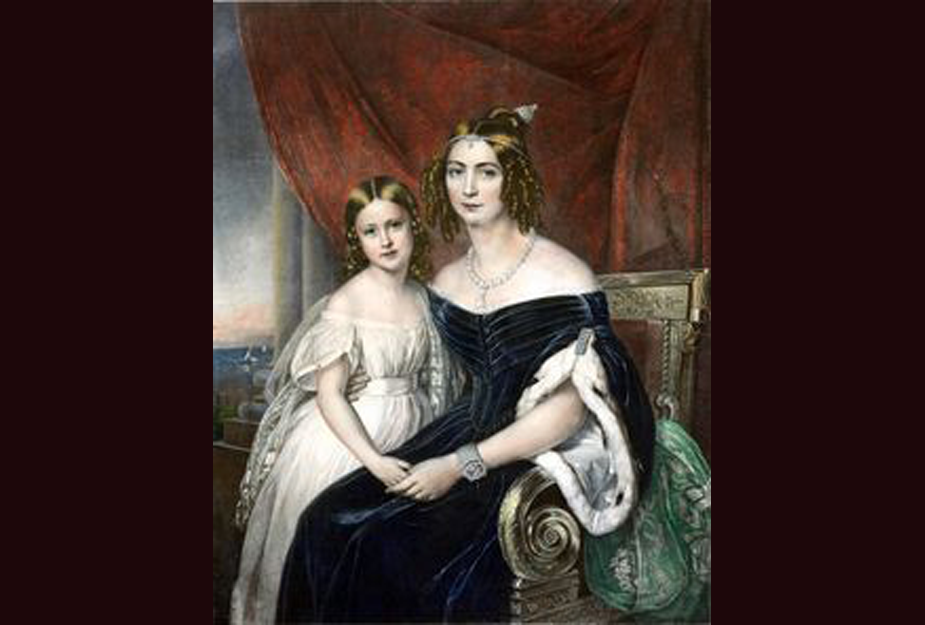
Amelie Auguste was very popular in Brazil.. … her mother, Augusta Amalia of Bavaria had prepared her well. She advised Emile to do everything necessary to promote the welfare of the people of her new country.
Amelie set up a household back in France, but returned to Brazil to live. She found the country in chaos, and helped her husband develop a court system modeled on that of France. She is credited for reorganizing the Brazilian government, and was very popular in both countries.
(Portrait: Amelie seems to like black.. and the formal shoulder structure of the 1830-40’s)
NOTE: We’re discussing French nobility who influenced fashion.. this a series about Napoleon 1’s family – Amelie Auguste being his step-granddaughter – the daughter of his first wife Josephine’s son, Eugene de Beauharnais. Hopefully, you’re drawing the family tree to keep these guys straight as you’ll need it when we get to the 1850s’.
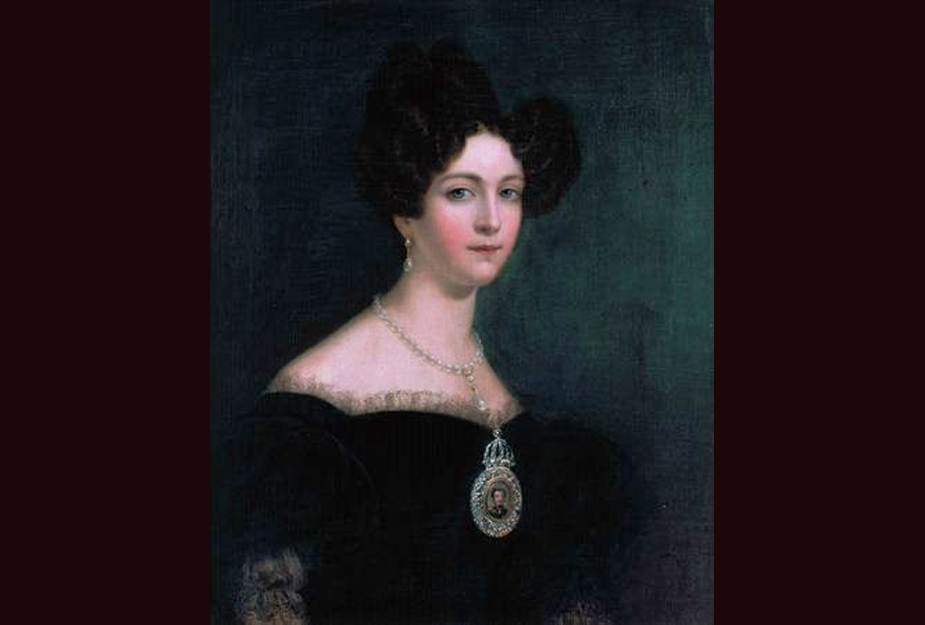
Amelie died without an heir… … as her daughter was dead, and her adopted daughter was not eligible for the crown. Her oldest sister Josephine inherited her tiaras, & her legacy lives as having organized the political structures of the country, & been a loving wife & stepmother.
(Portrait: Amelie Auguste died at age 60 – note below in the 1830’s.. and later the crinoline of the 1860’s)
(This is the discussion of French royalty, working through Napoleon 1st’s family – this being his step-granddaughter and granddaughter of his first wife Empress Josephine. Josephine referenced above would have been Empress Josephine’s namesake, her granddaughter)
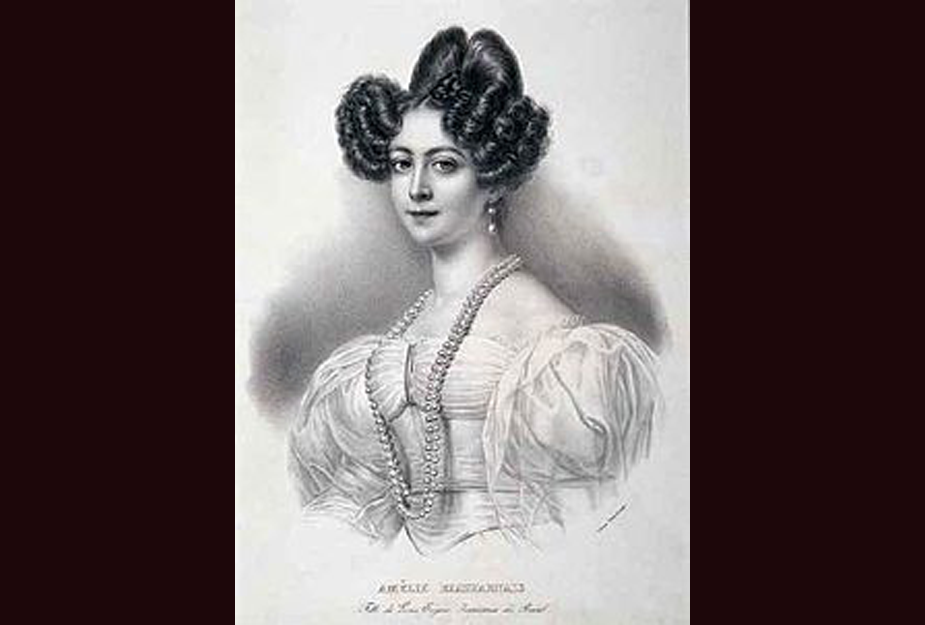
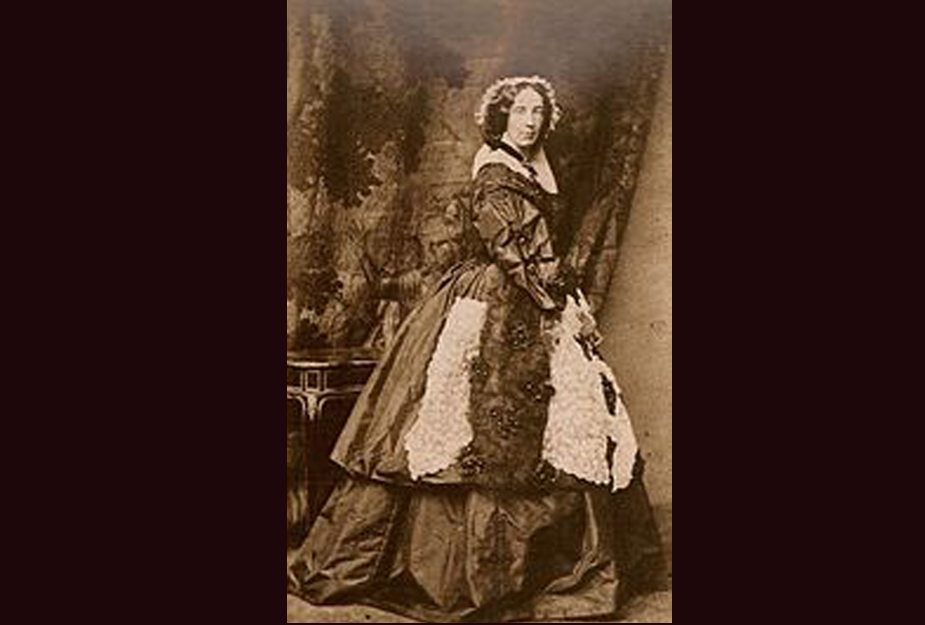
5th child of Eugene, step-son of Napoleon 1st and Augusta Amalia is… …Theodolinde Louise Eugenie Auguste Napoleine de Beauharnais. She was the 5th of 7 children.
Theodolinde became the Countess of Wurttemberg when she married at the age of 26 in 1841, but she died of a ‘short illness’ before her husband became the Duke of Urach.
(portrait: Theodolinde in 1836, 5 years before she married and at age 21 – Eugene & Augusta’s 5th child)
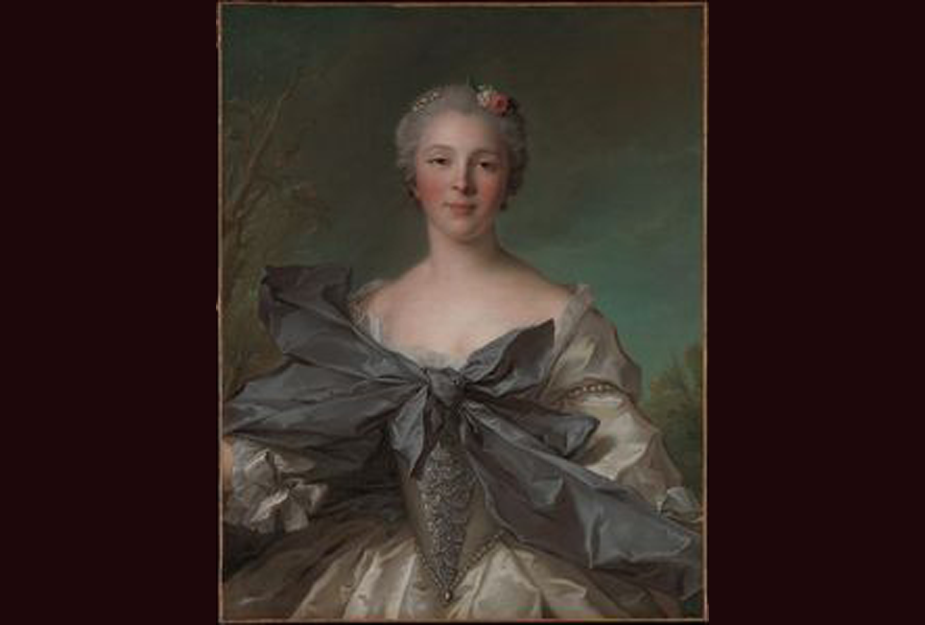
Theodolinde, Countess of Wurttemburg.. .. and Napoleon 1st’s step-granddaughter, died very young, but first had 4 daughters who married well:
- Her firstborn married twice: 1st Count Rudolf von Enzenberg, etc. etc.; 2nd Count Franz von Thurn und Hohenstein, etc. etc. – NOTE: This Thurn line combined with the royal blood of the Taxis line accounts for most of the royal lineage in Europe today!
- Her second was Marie Josephine of Urach
- 3rd Eugenia Amalie of Urach
- 4th Mathilde of Urach, who married Paolo, Prince of Oriolo & Viano
Theodeolinde’s husband remarried soon after her death. The 2nd wife finally produced a boy and heir.
(portrait: Theodolinde shortly after her marriage in 1841 at about age 26. This is one of VERY few images of her available)
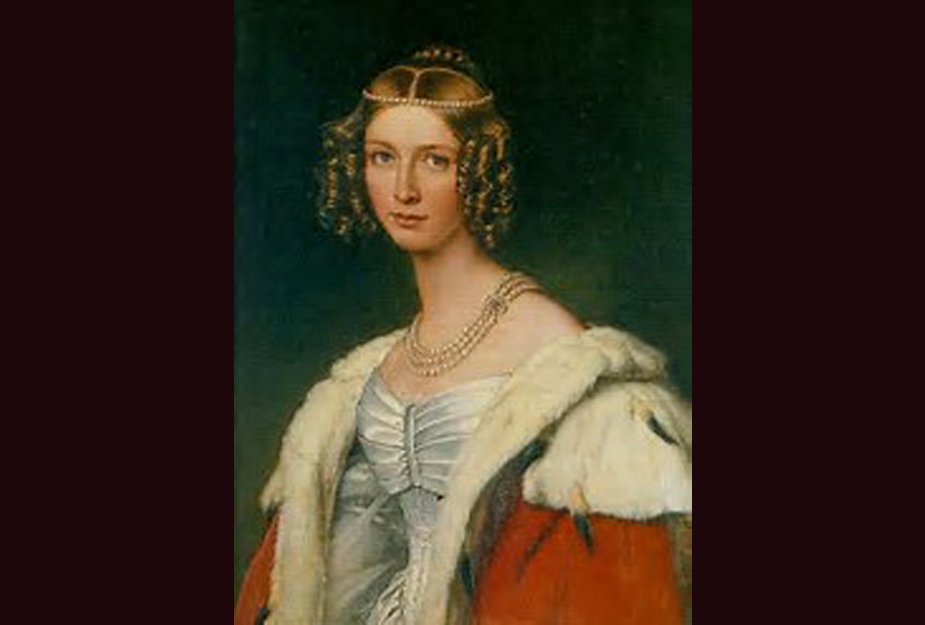
The 6th child of Eugene & Augusta de Beauharnais died at birth.. … so we will entertain you today instead with a painting of Princess Mathilde of Urach. Mathilde was the daughter of Theodolinde (Eugene and Augusta’s 5th born), who married Paolo, Prince of Oriolo and Viano.
This is a portrait of her in 1861 dressed “retro-Elizabethan” for a costume ball.
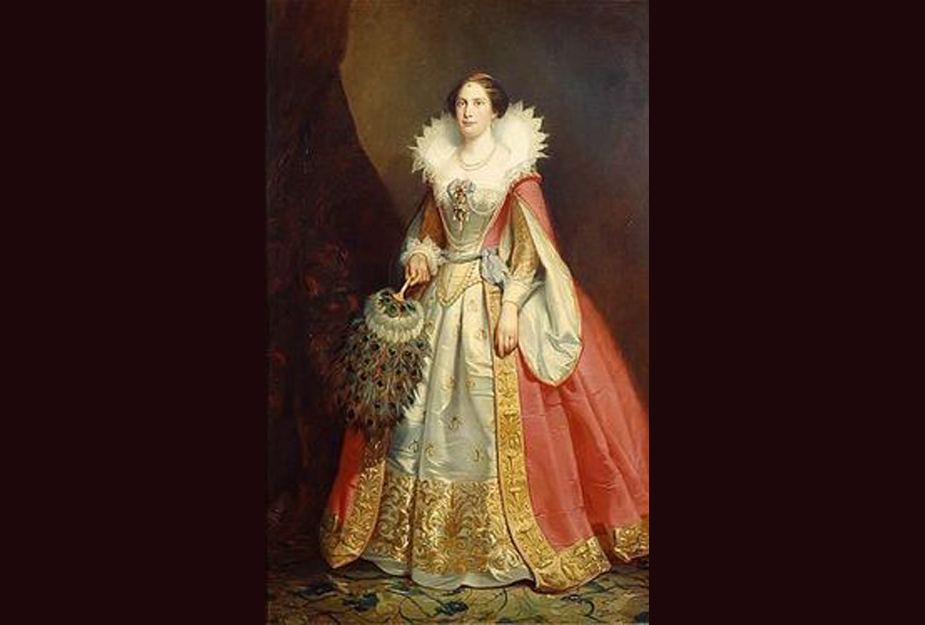
The last & 7th child of Eugene & Augusta Amalia de Beauharnais was Maximillan… … Prince Maximillan Josephe Eugene Auguste Napoleon de Beauharnais to be exact. As the 2nd son, his older brother (Auguste Charles Eugene Napoleon) was named heir to not only his father’s Dukedom, but to Napoleon the 1st’s crown as emperor.
“Max’s” brother Charles died young, leaving him the heir, but unfortunately, Napoleon would be defeated and exiled before he could inherit.
(portrait: “Max”, 7th child of Napoleon 1st’s step-son was in line to inherit.. after Napoleon II and Napoleon III.. but all the fun and French royalty ended with Napoleon’s exile.. except the lineage continued…)
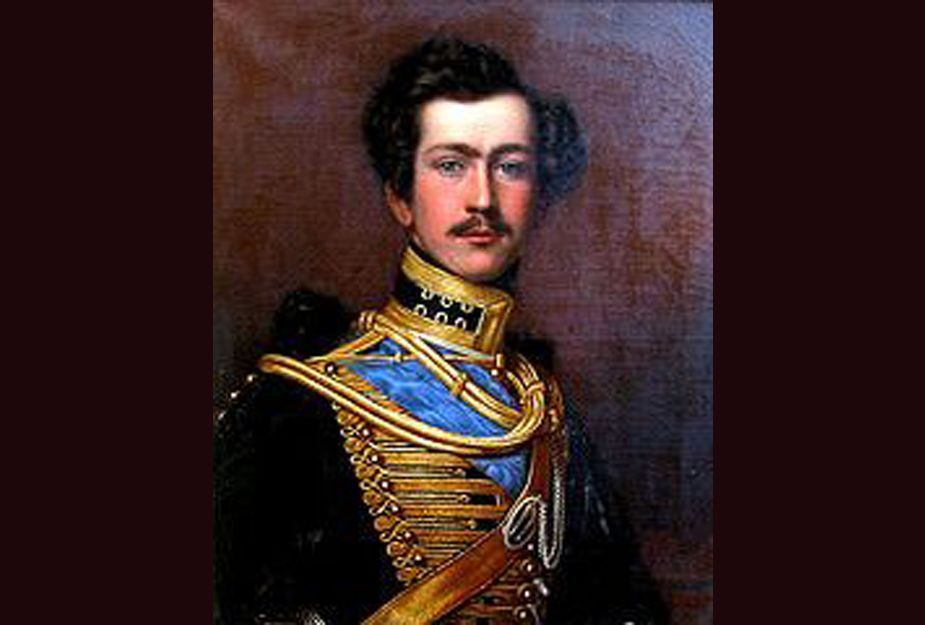
Napoleon’s line continued, because step-grandchild #7 and others married… … into royal families from all over the world. Maximillan was the 7th child of Napoleon’s step-son Eugene, and the 2nd son of that family, but he became the 3rd Duke of Leuchtenberg because his brother died before he did.
His most notable achievement was marrying the eldest daughter of Nicholas I of Russia and Charlotte of Prussia – a huge political match to unite the countries.
Maximillan was granted by Czar Nicholas the title of “His Imperial Highness”.
(photo: Maria Nikolayevna of Russia and Max, step-grandson of Napoleon 1st and heir to the thrown that wouldn’t happen)
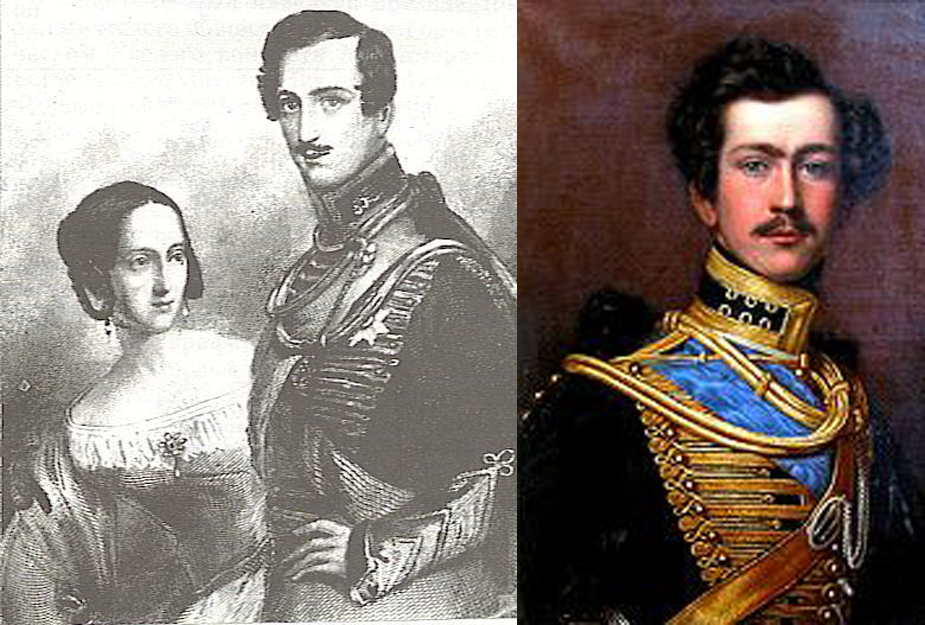
Maximillan, youngest child of Eugene and Augusta, married a very notable woman… … Grand Duchess Maria Nikolayevna of Russia’s childhood and life was well documented in the new medium – photographs! As the eldest daughter of Czar Nicholas I of Russia and Charlotte of Prussia, she carried huge responsibility to politically unite the countries while acting the part of the Imperial
They were married in 1839.
(Portrait: Maria Nikolayevna of Russia in about 1839)
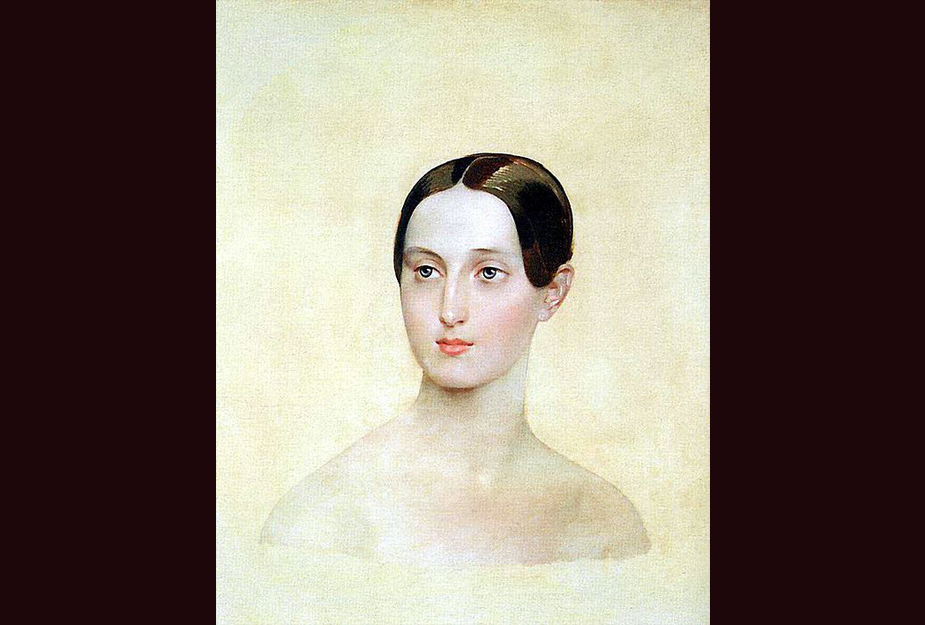
Here is Maximillan de Beauharnais in full military dress… … Max was not only the step-grandson of Napoleon 1st (grandson of Josephine), but also first cousin to Emperor Napoleon III of France and Francis Joseph I of Austria.
His title and lineage was vital to political liasons between all European powers.
(portrait: “Max” in about 1837 before his marriage)
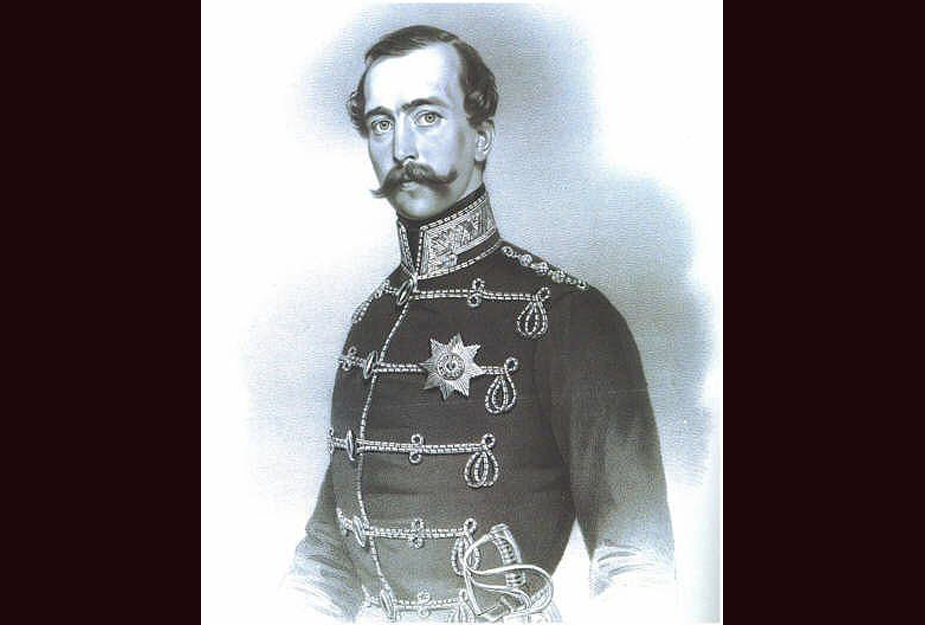
It is said 2 white doves came into the church during the marriage ceremony.. .. to bless the union of Maximillan (Napoleon’s step-grandson) and Maria (daughter of Czar Nicholas I of Russia).
They had a long and fruitful life in Russia. Max would become the grandfather of Prince Maximilian of Baden, who would become the Chancellor of Germany in World War I.
(portrait: an older Maria.. pregnant again and looking none too pleased about it..)
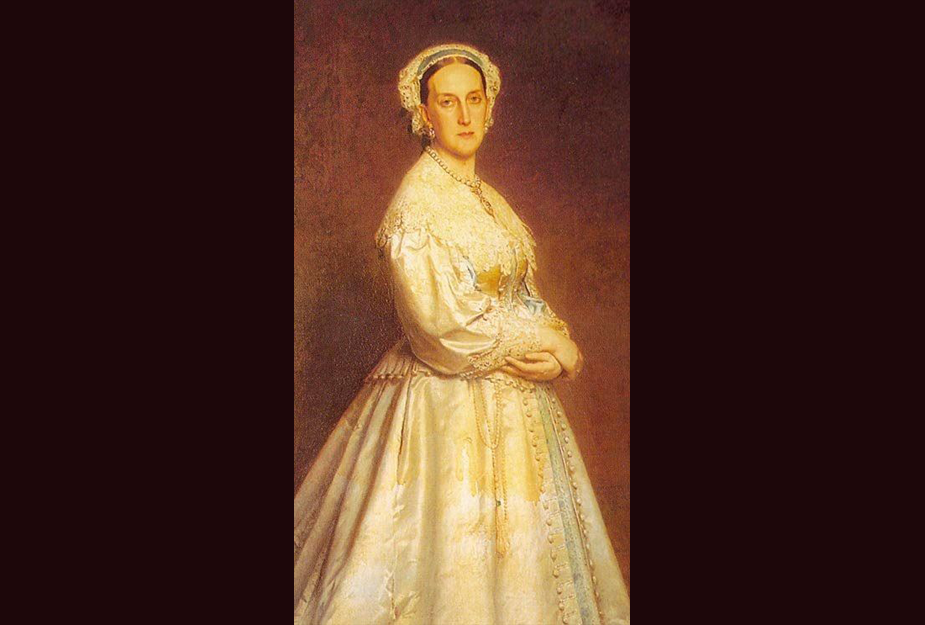
The children of Maximillan de Beauharnais & Maria Nikolayevna… .. would inherit the crown of Russia. They had 7 children:
- Alexandra Maximilianova – died as a child
- Maria Maximilianova – married Wilhelm of Baden
- Nicholas Maximilianovich – became Duke of Leuchtenberg after his father
- Eugenia Maximilianovich – married Duke Alexander Petrovich of Oldenburg – this line carries the lineage to today
- Eugen Maximilianovich – was married twice & was also the Duke of Leuchtenberg
- Sergei Maximilianovich – killed in the Russian-Turk War
- Georgi Maximilianovich – also Duke of Leuchtenberg, married Therese Petrovka of Oldenberg and a 2nd marriage to Anastasia of Montenegro – this line also carries lineage to today
(Portrait – Maria with her two eldest children in 1845)(Max was the youngest child of Eugene adopted son of Napoleon I and Augusta Amalia eldest daughter of the king of Bavaria)
